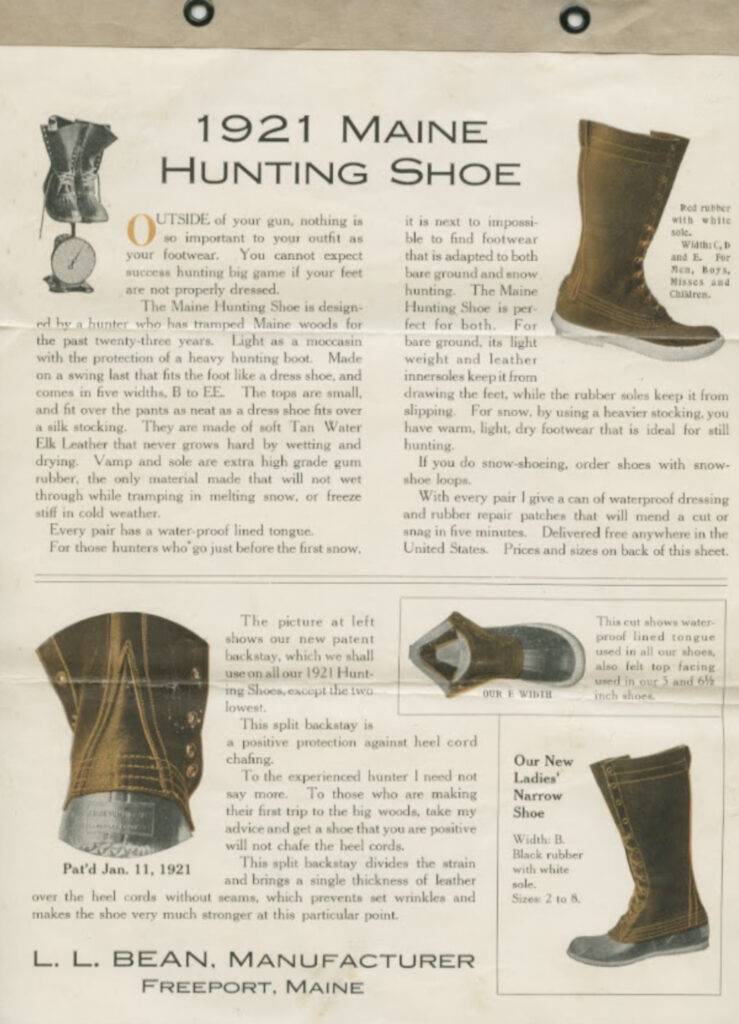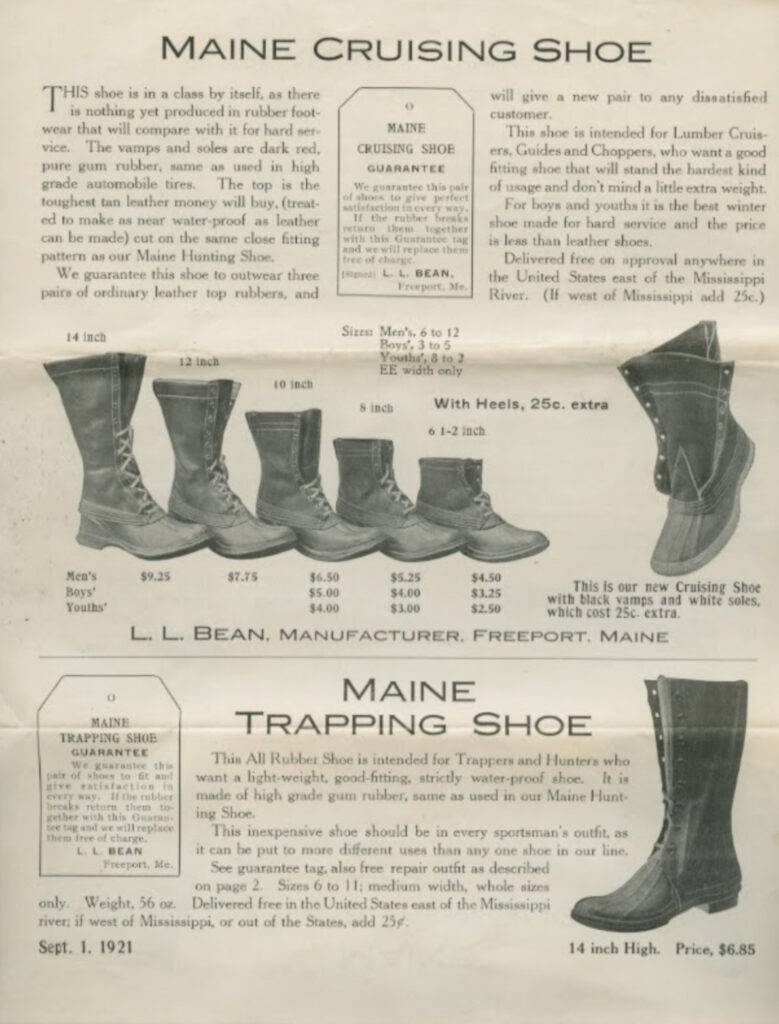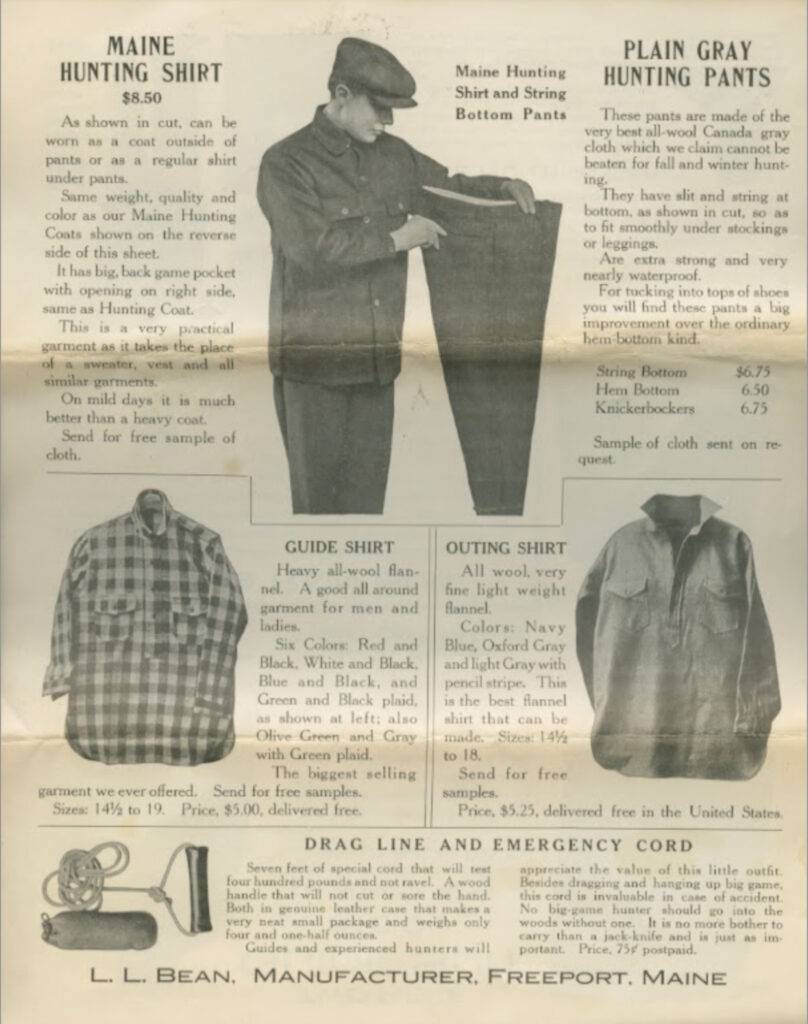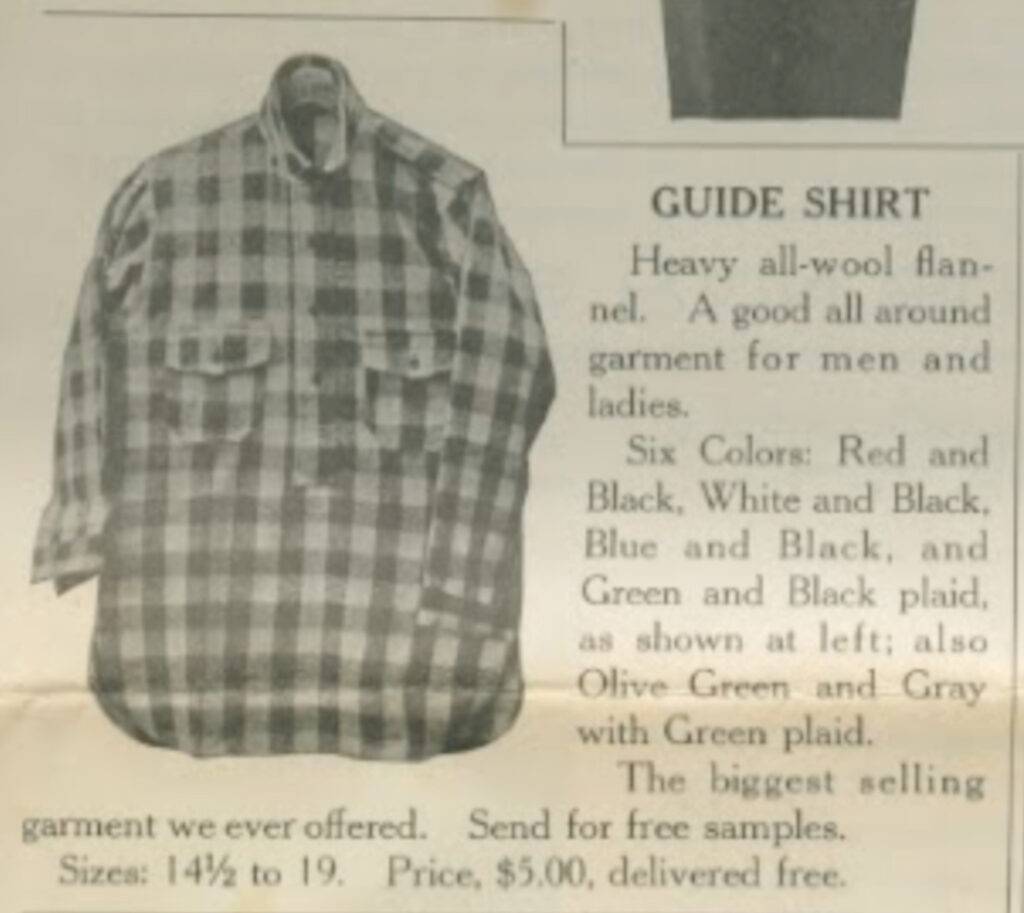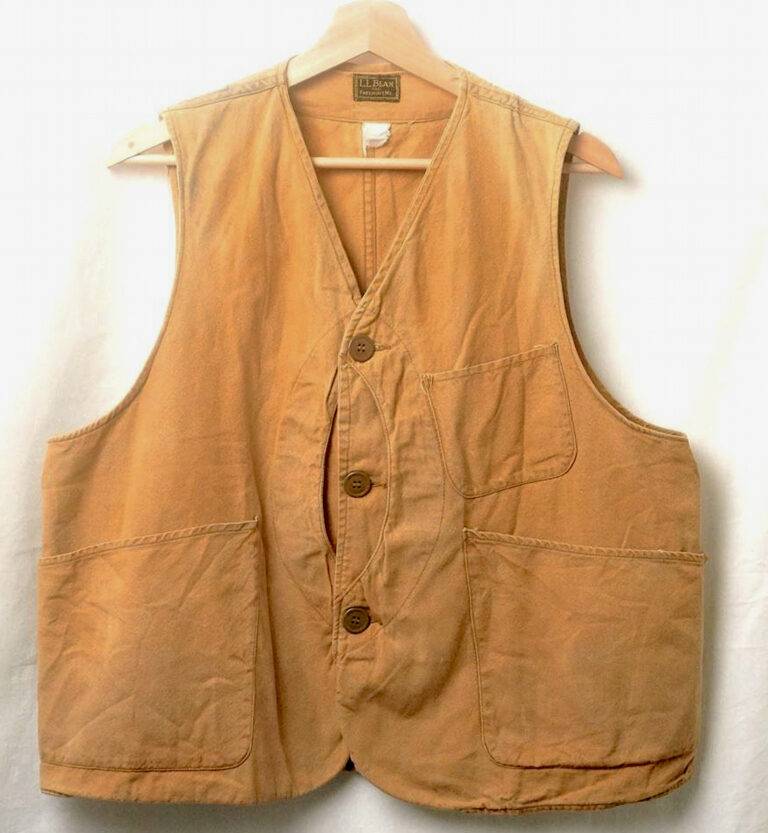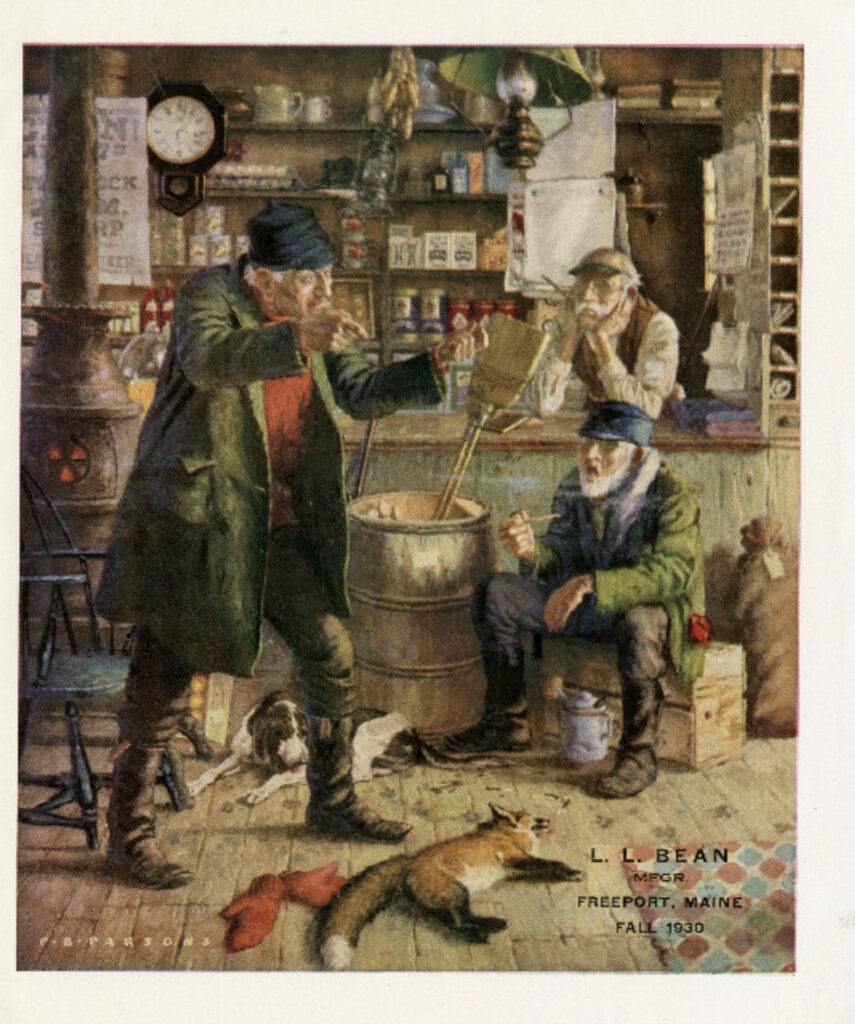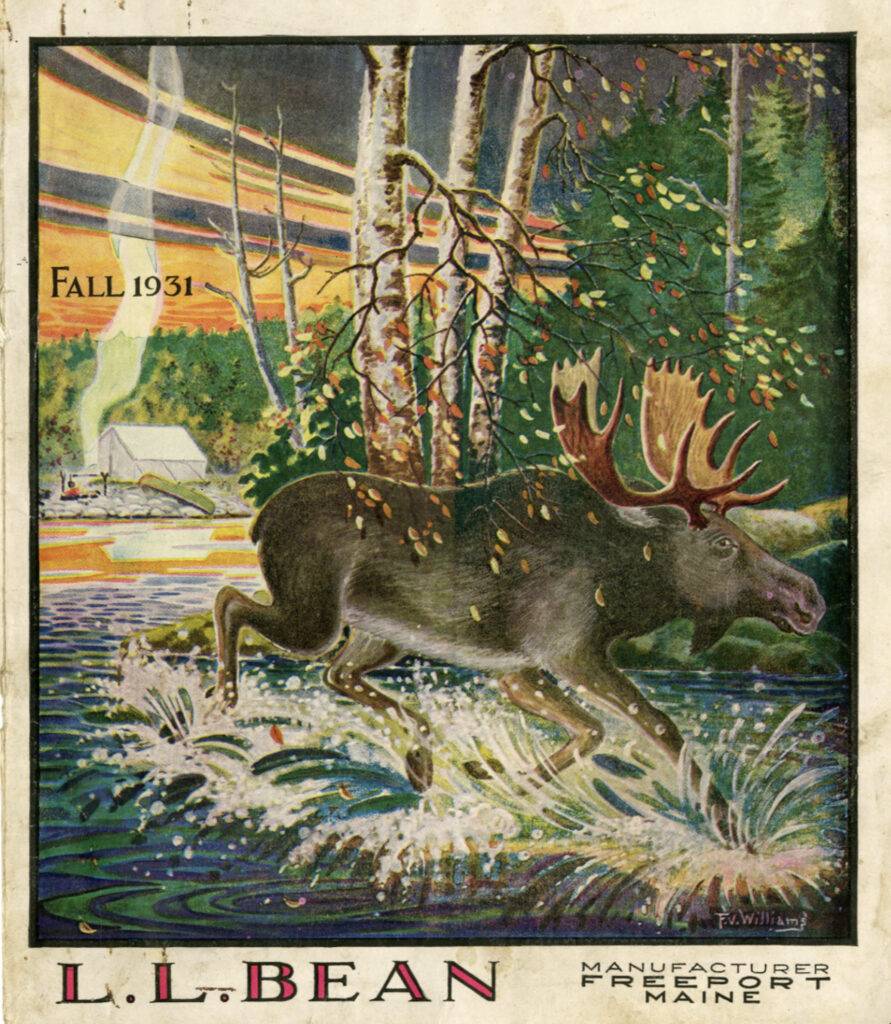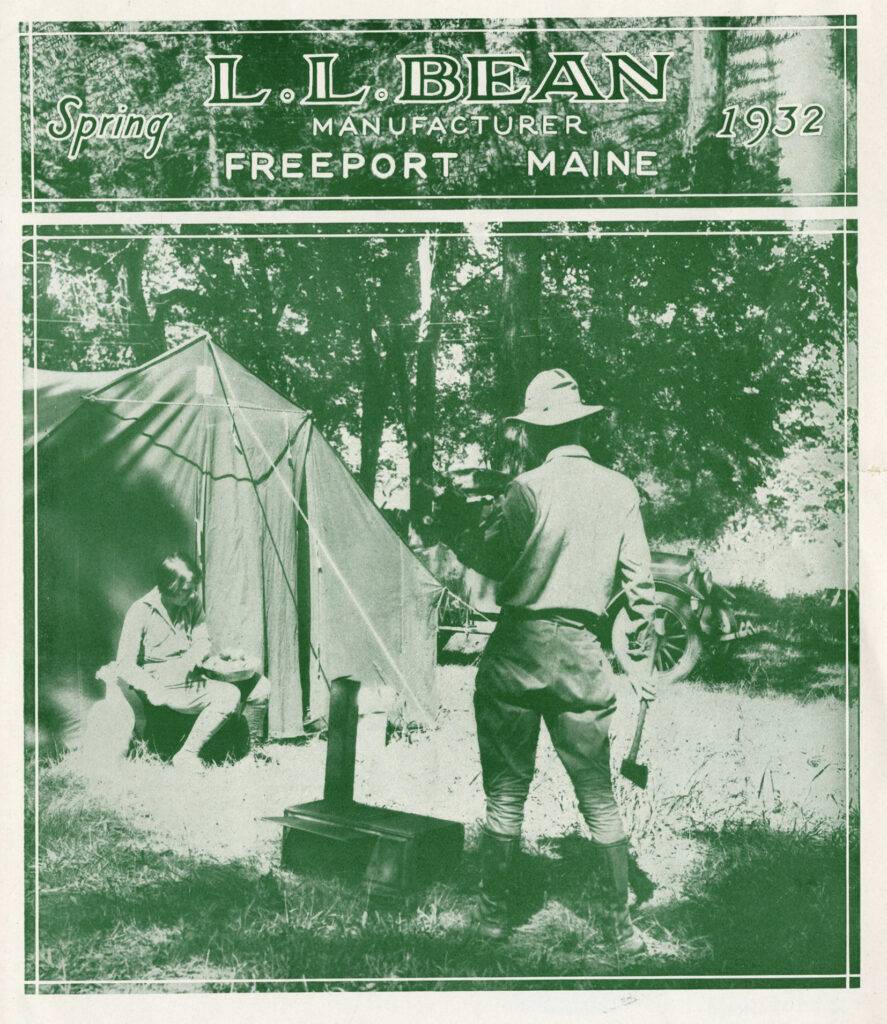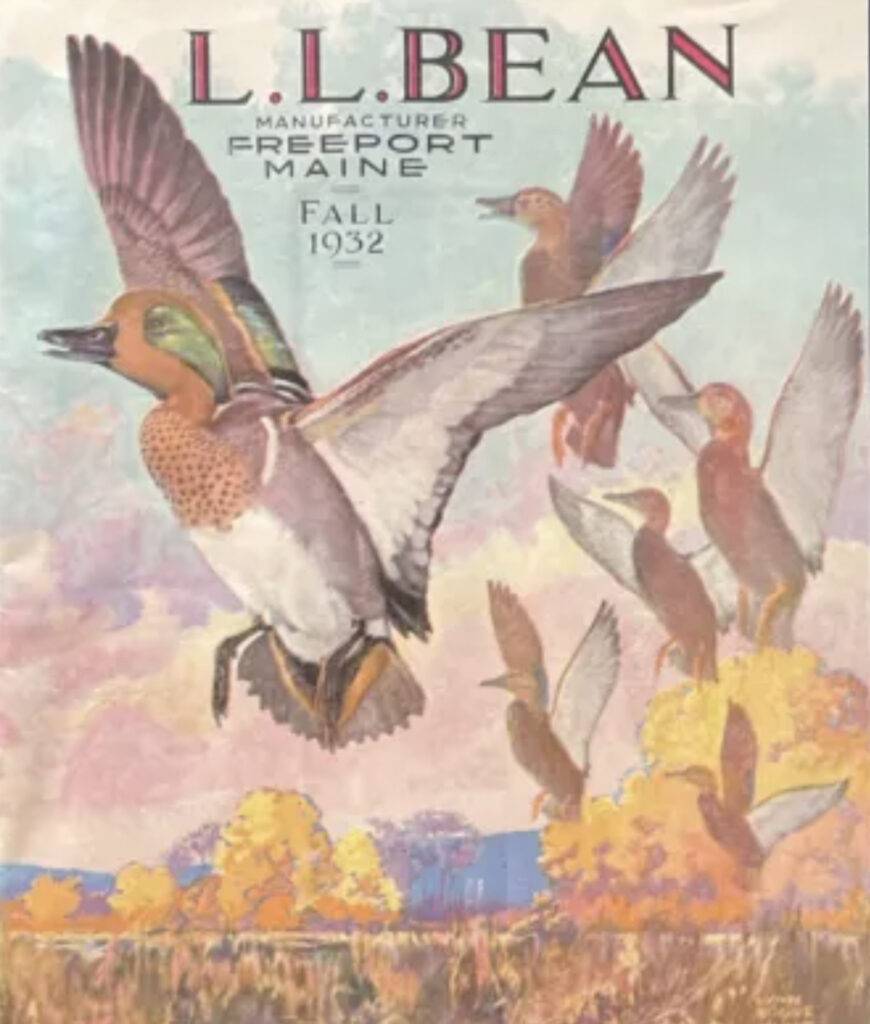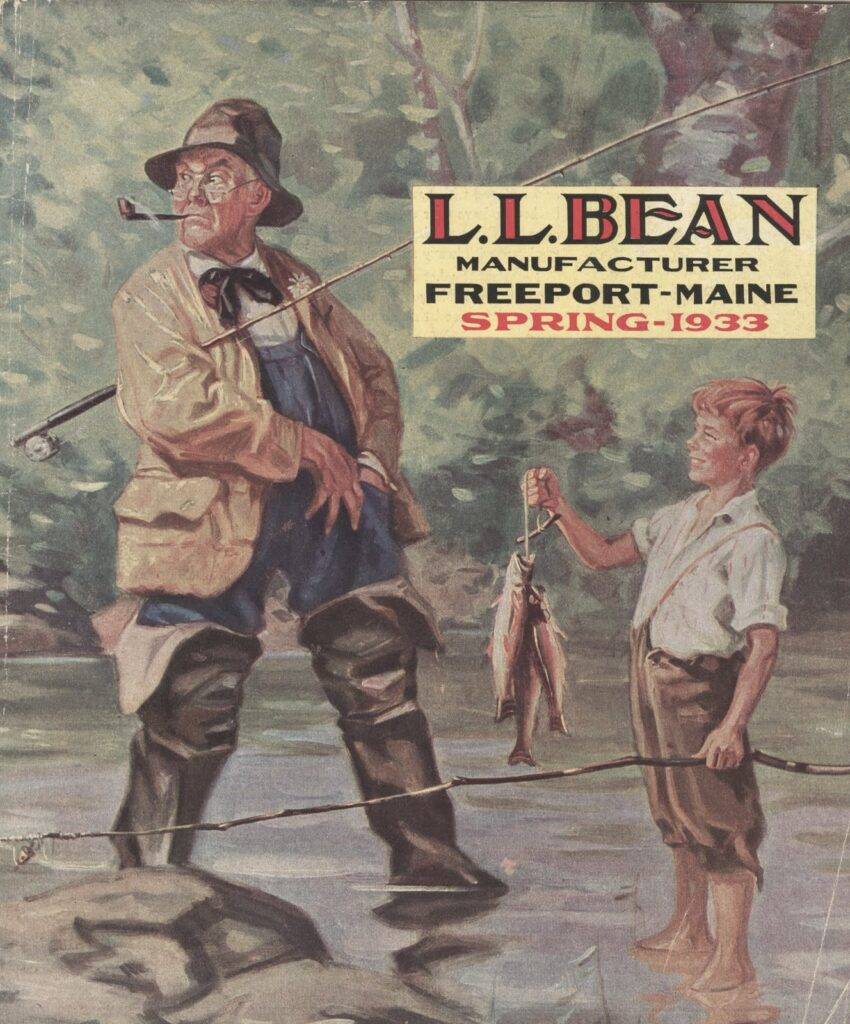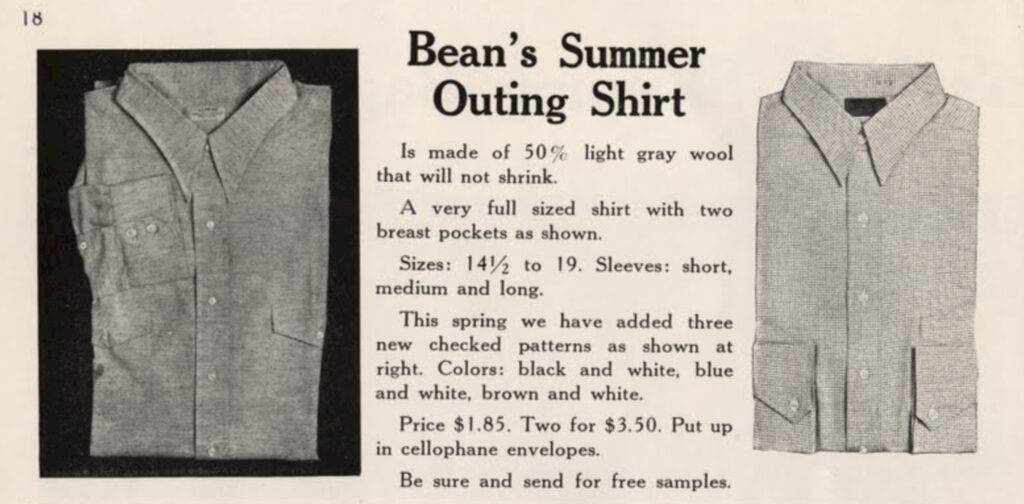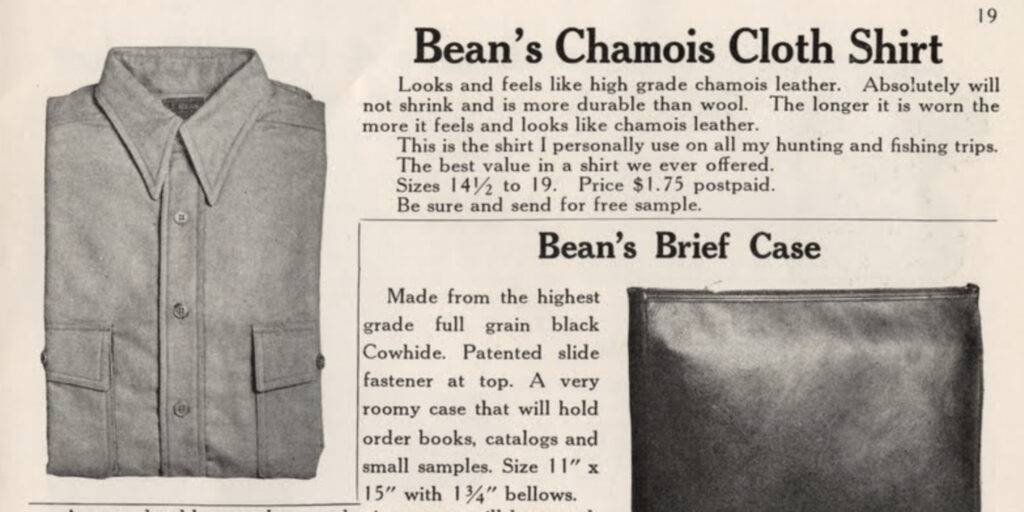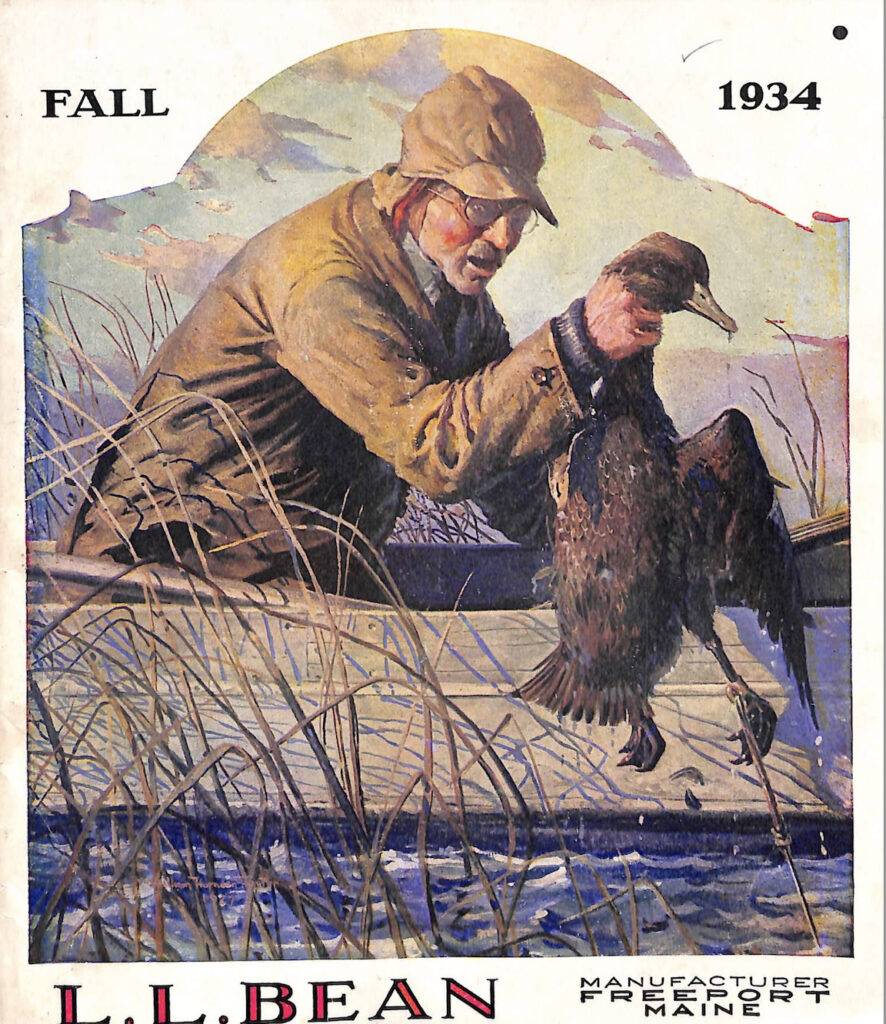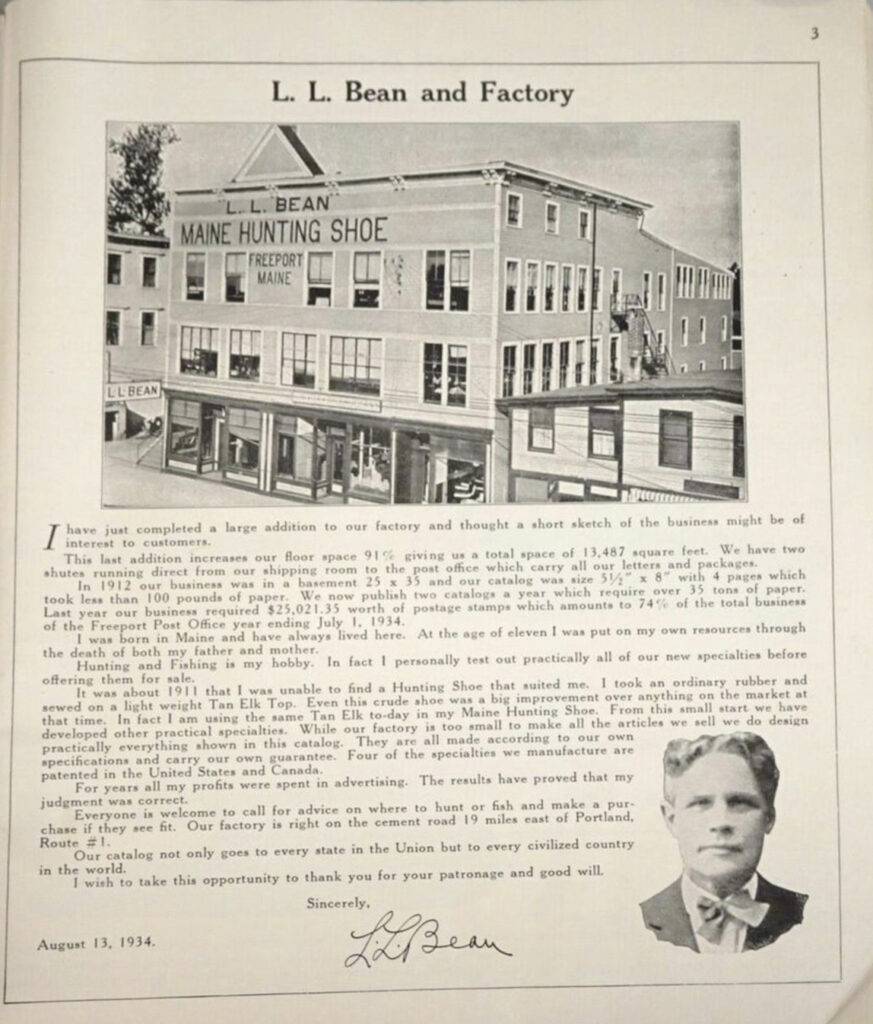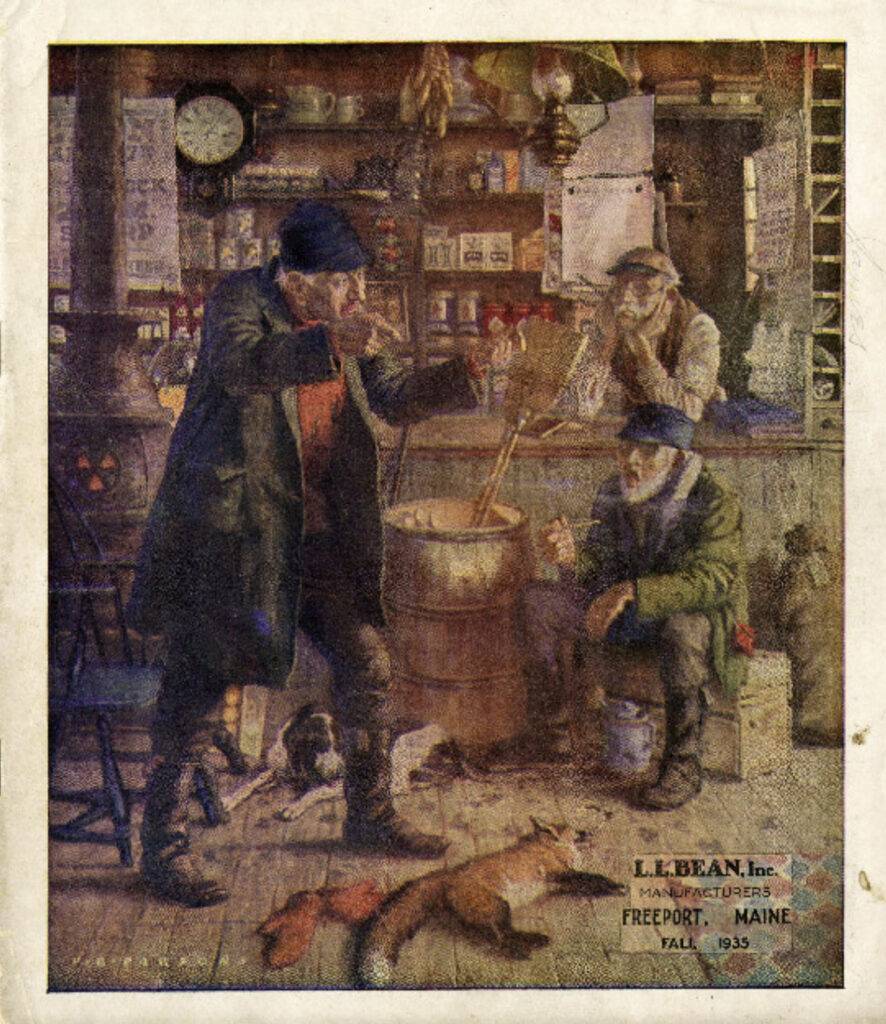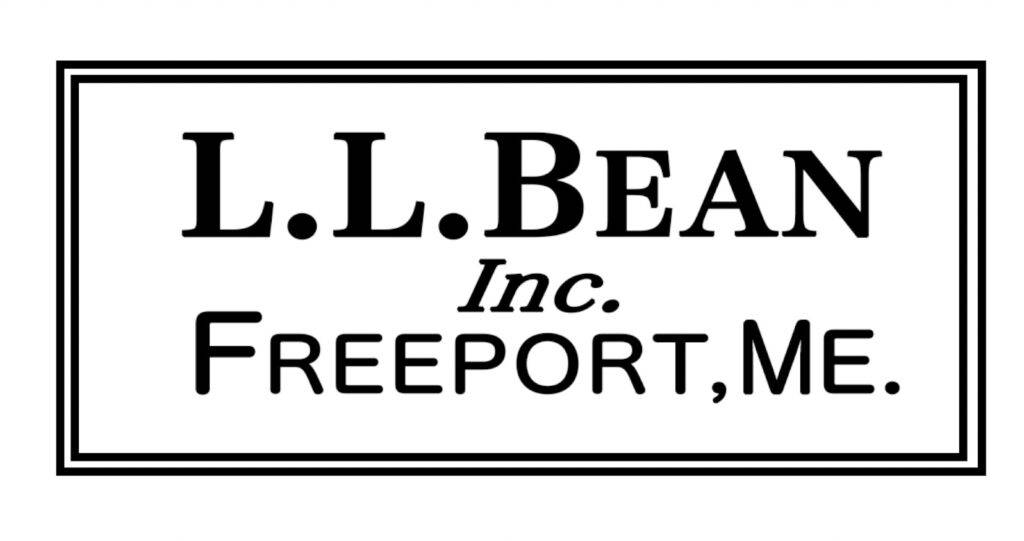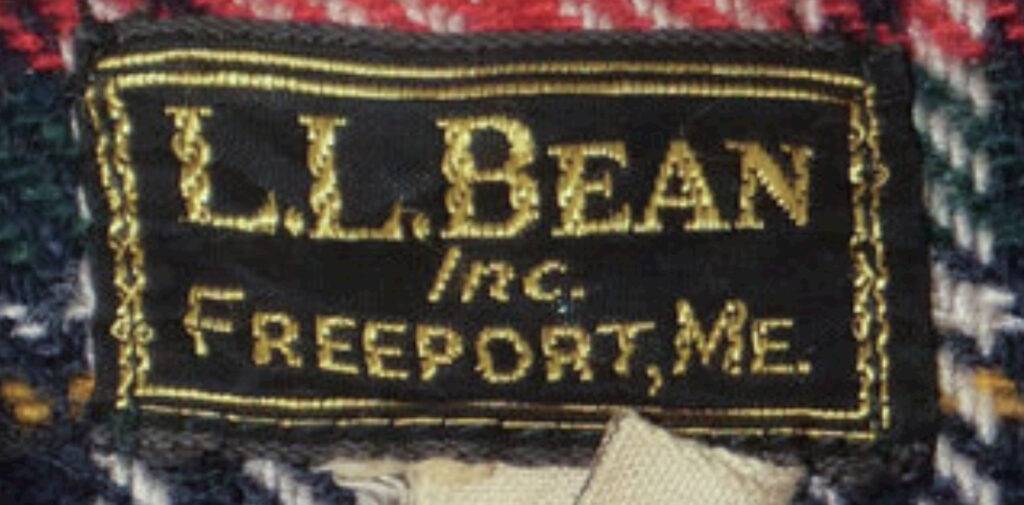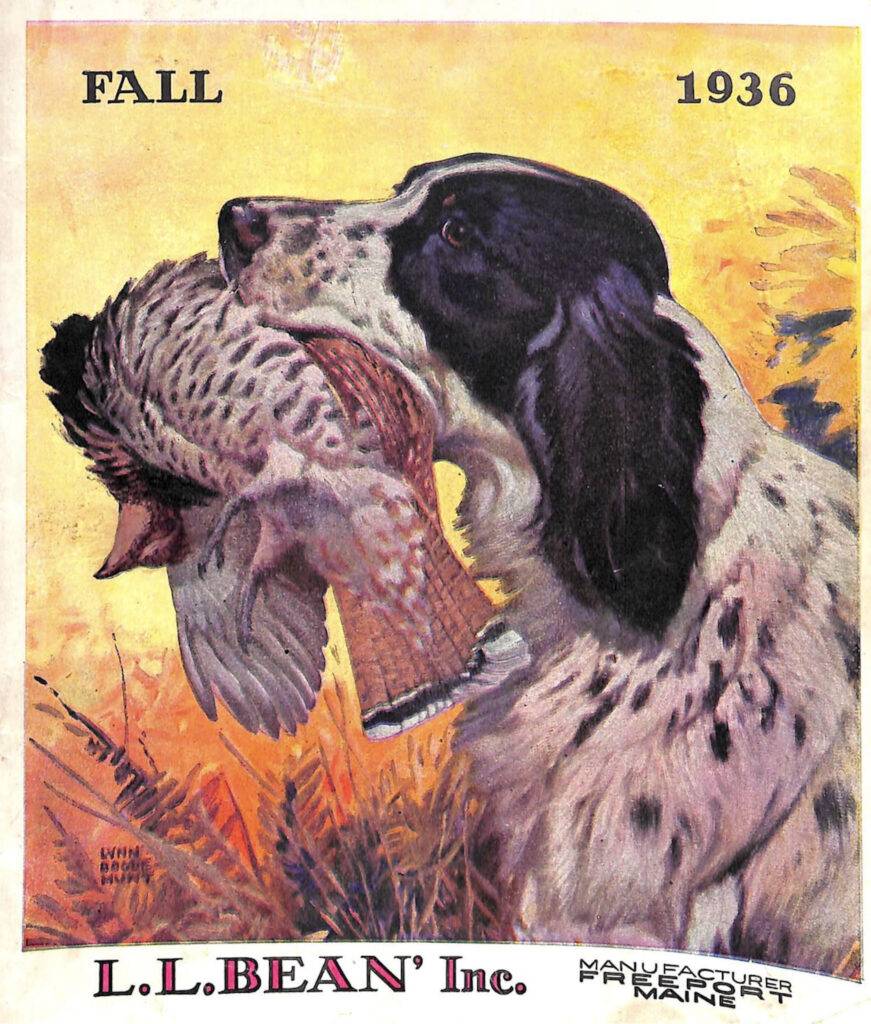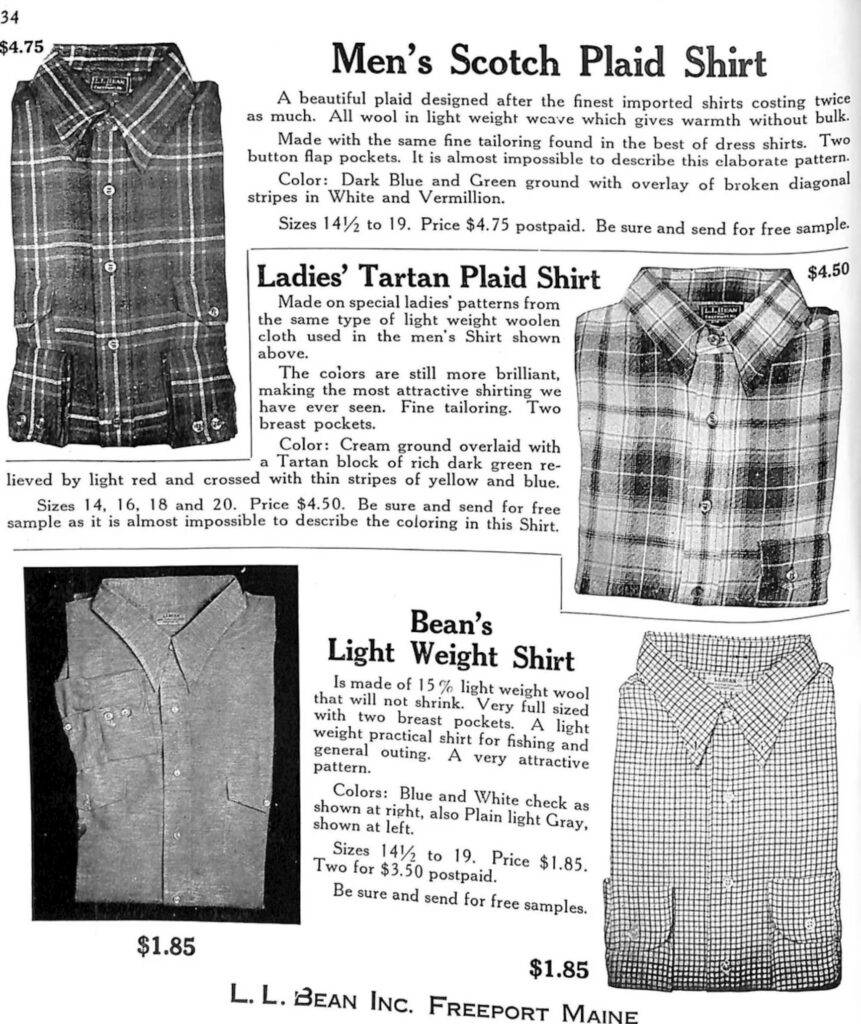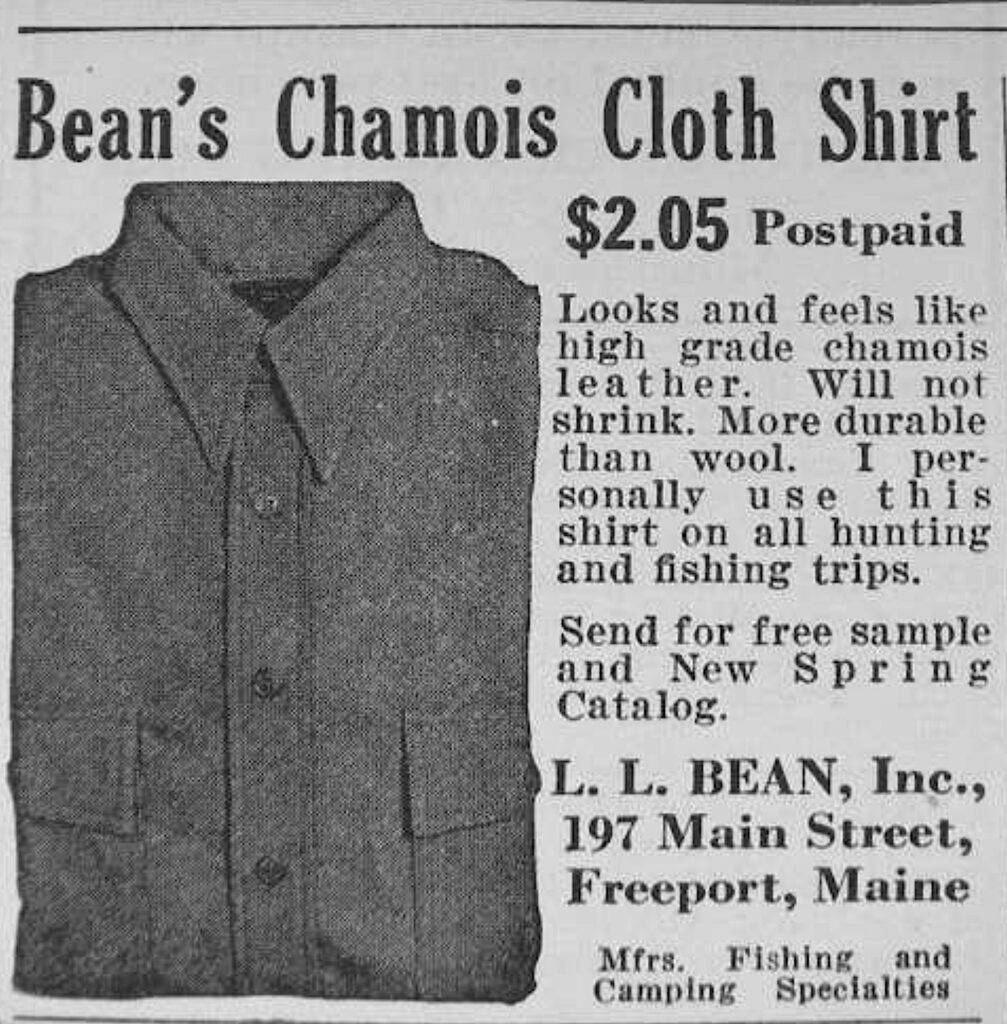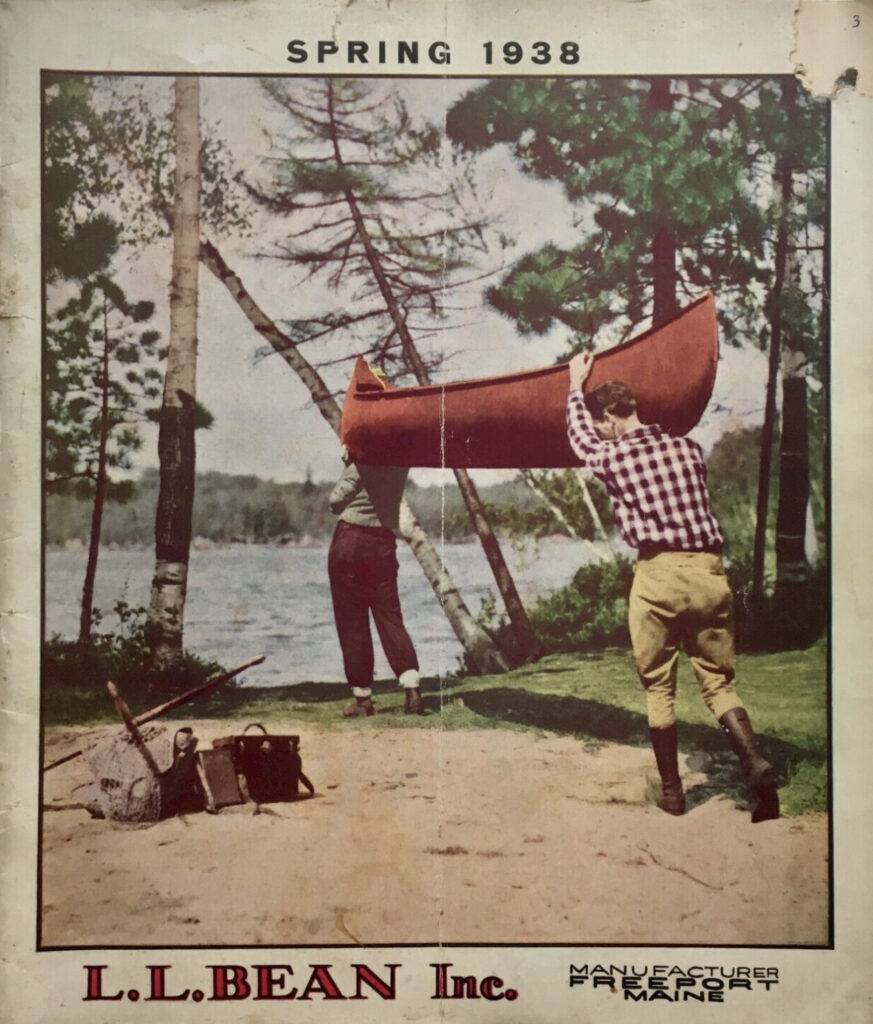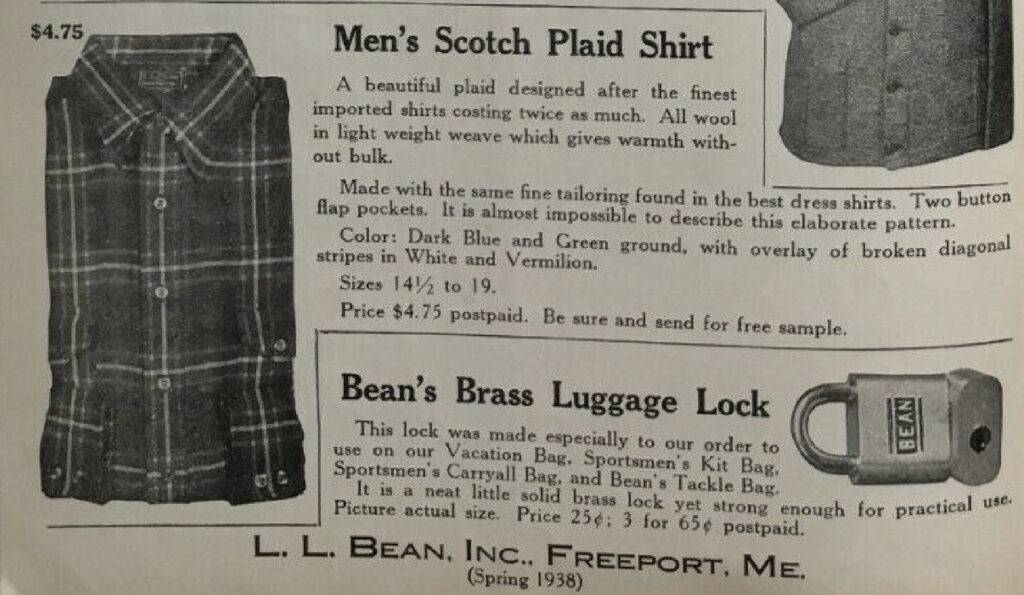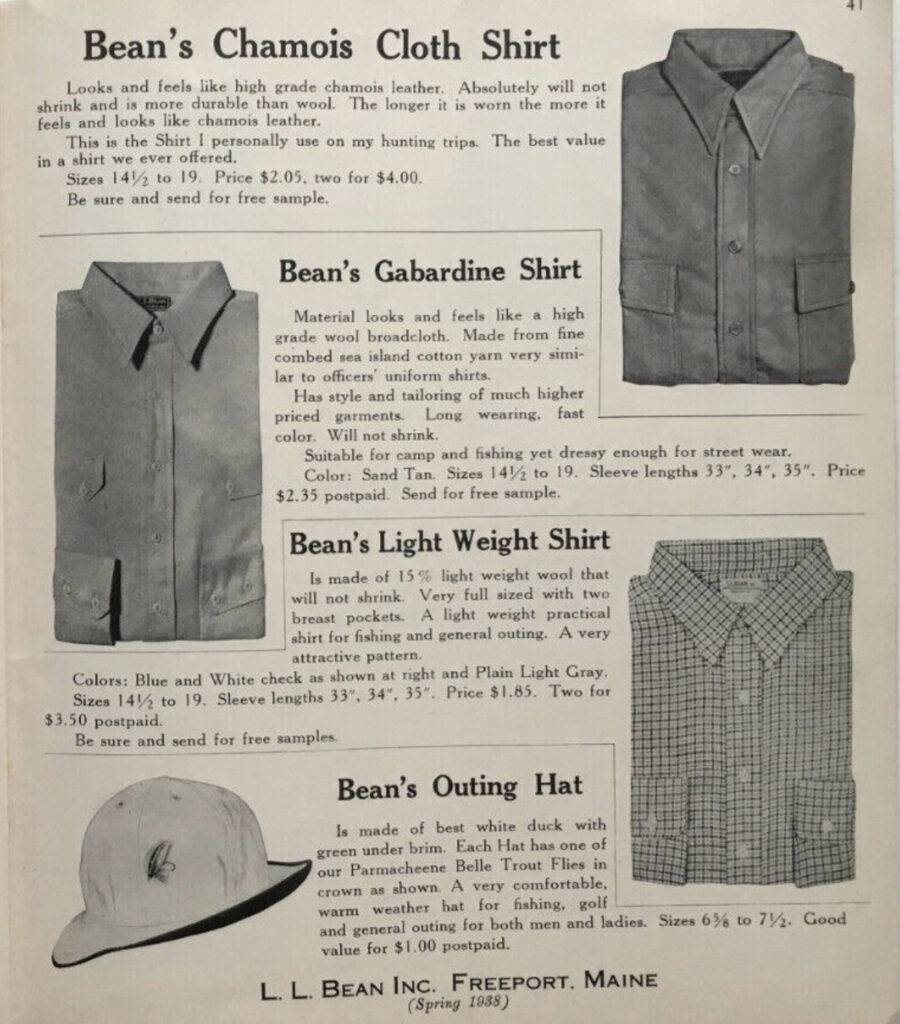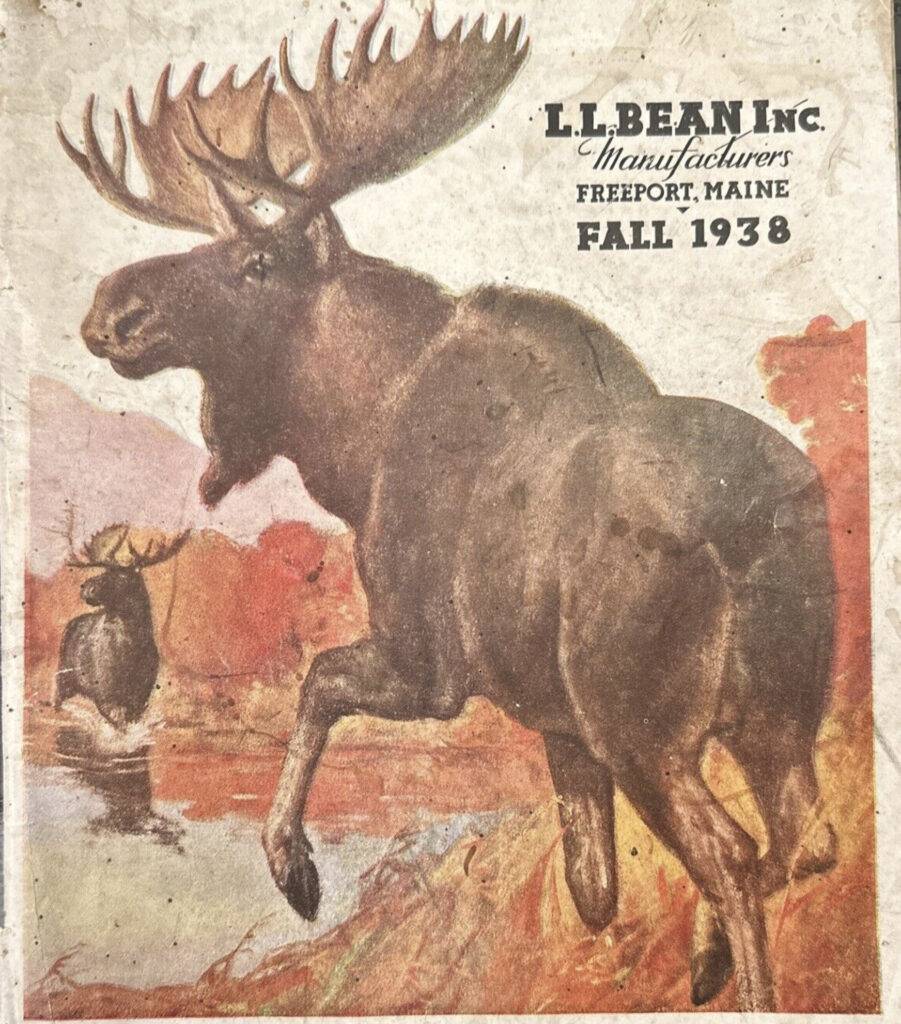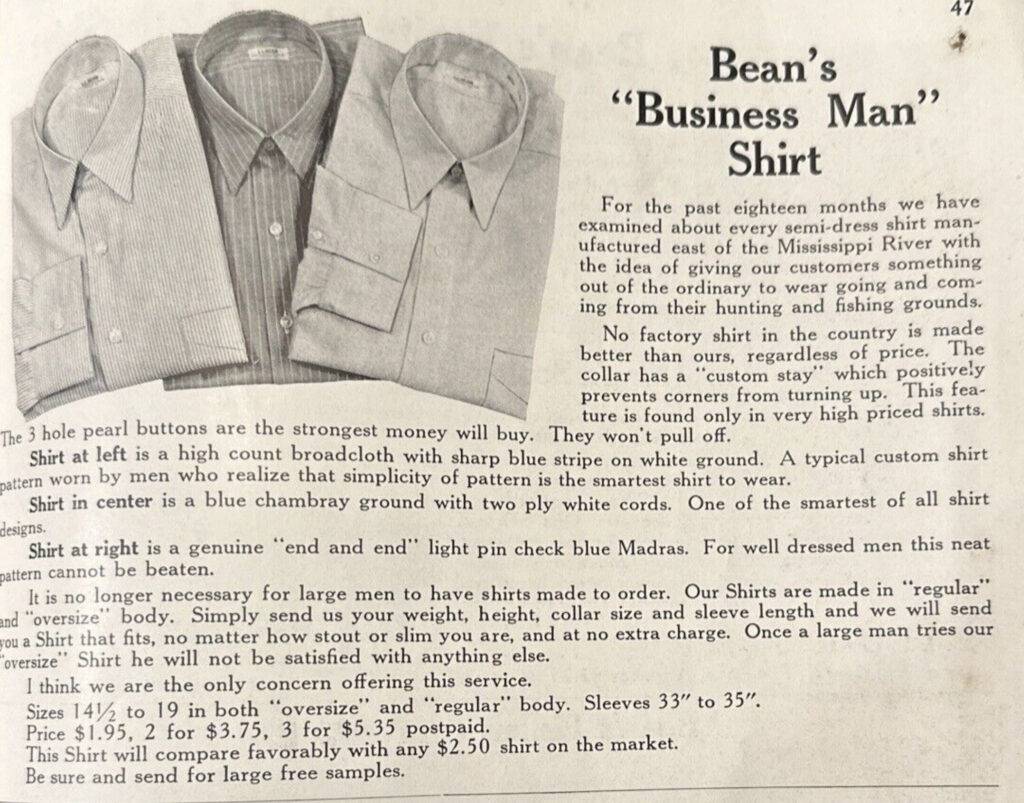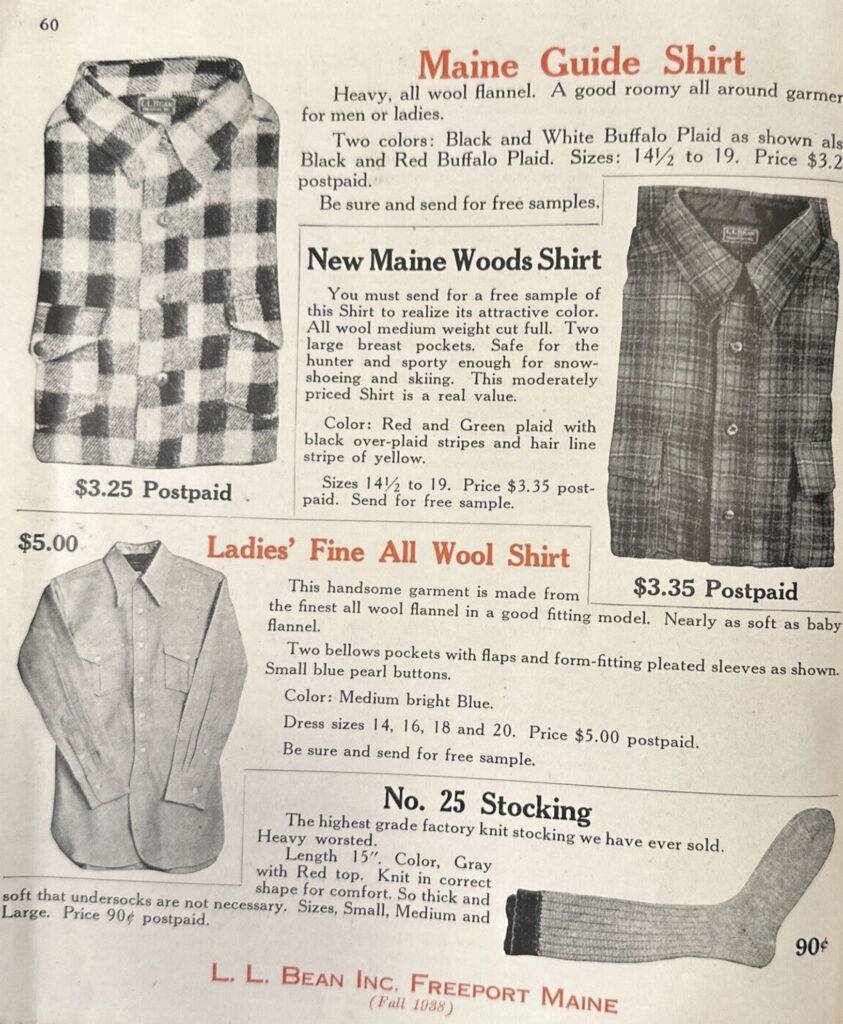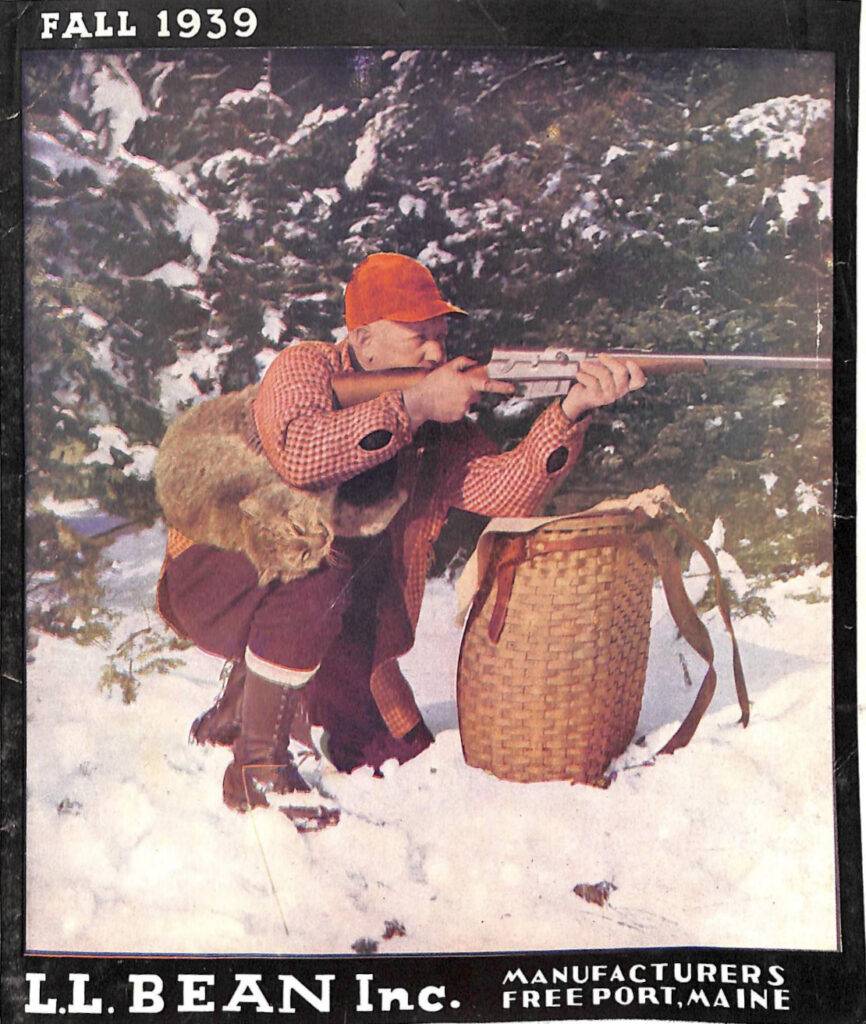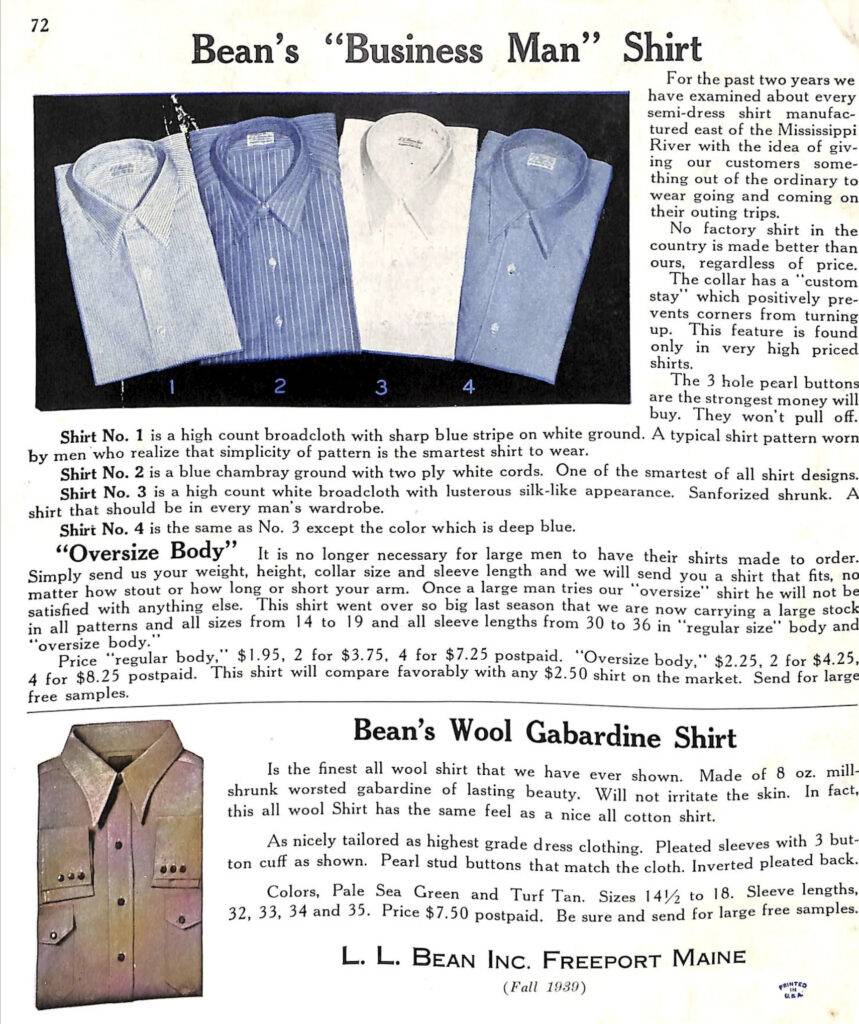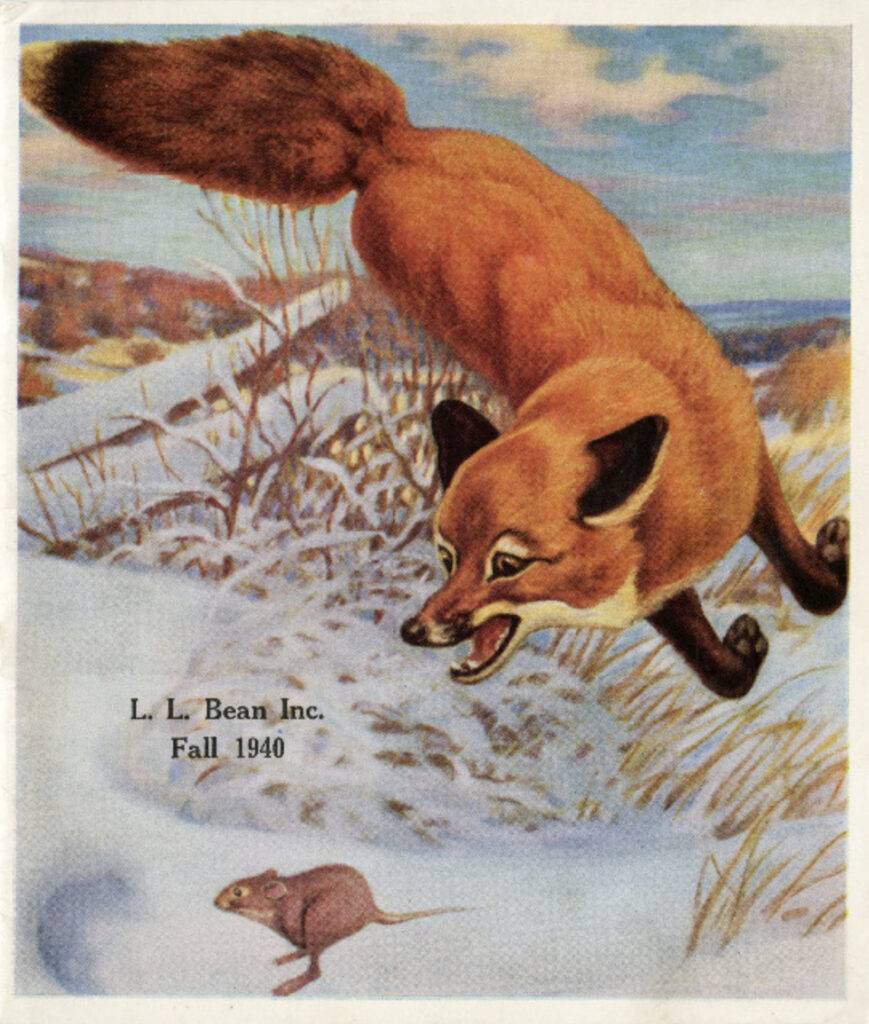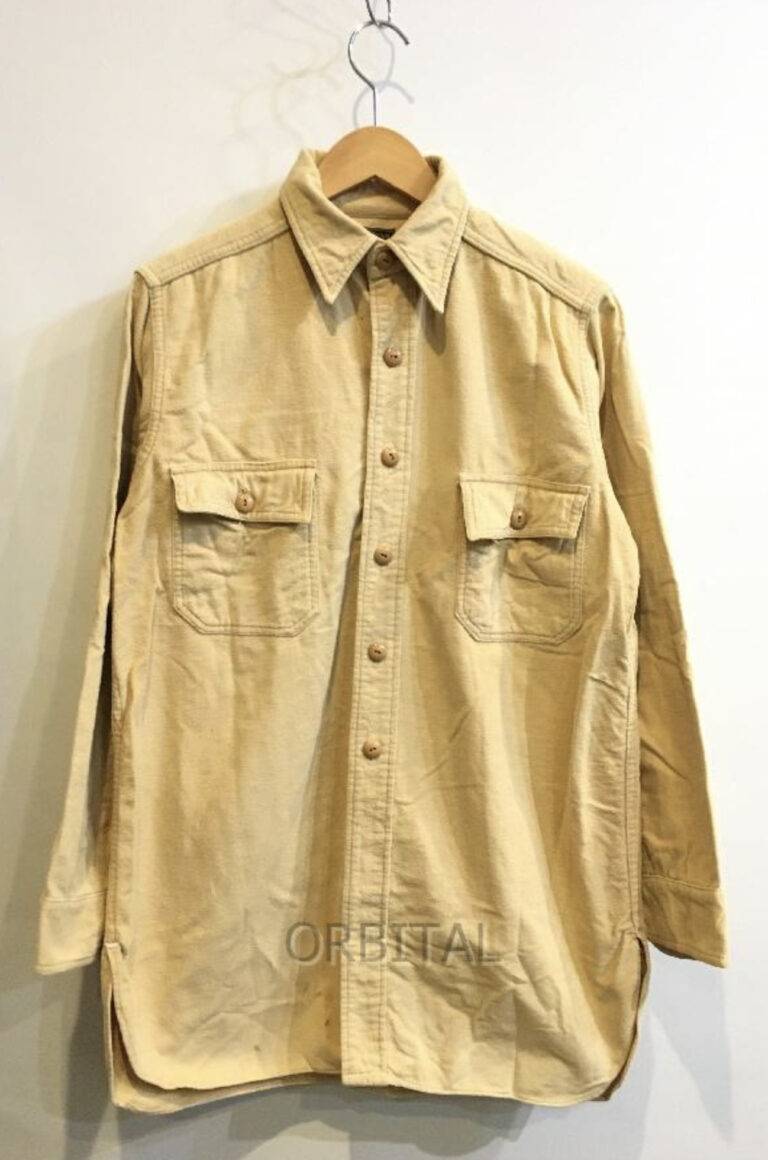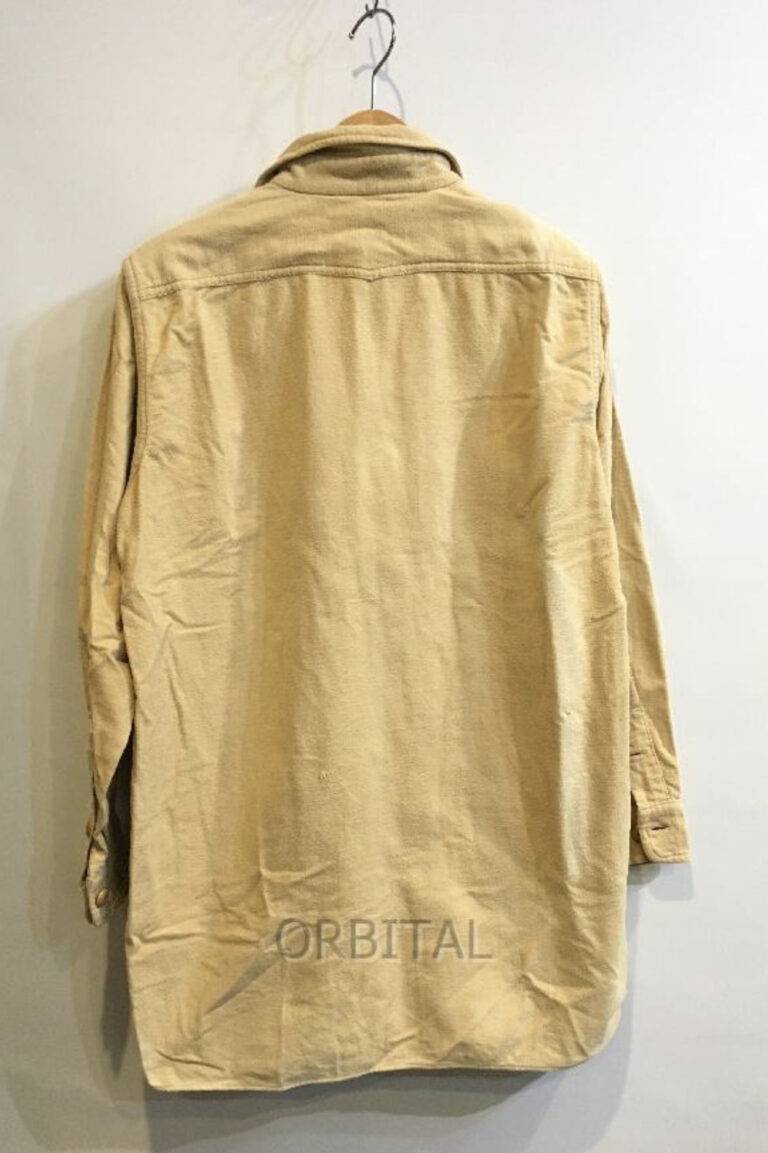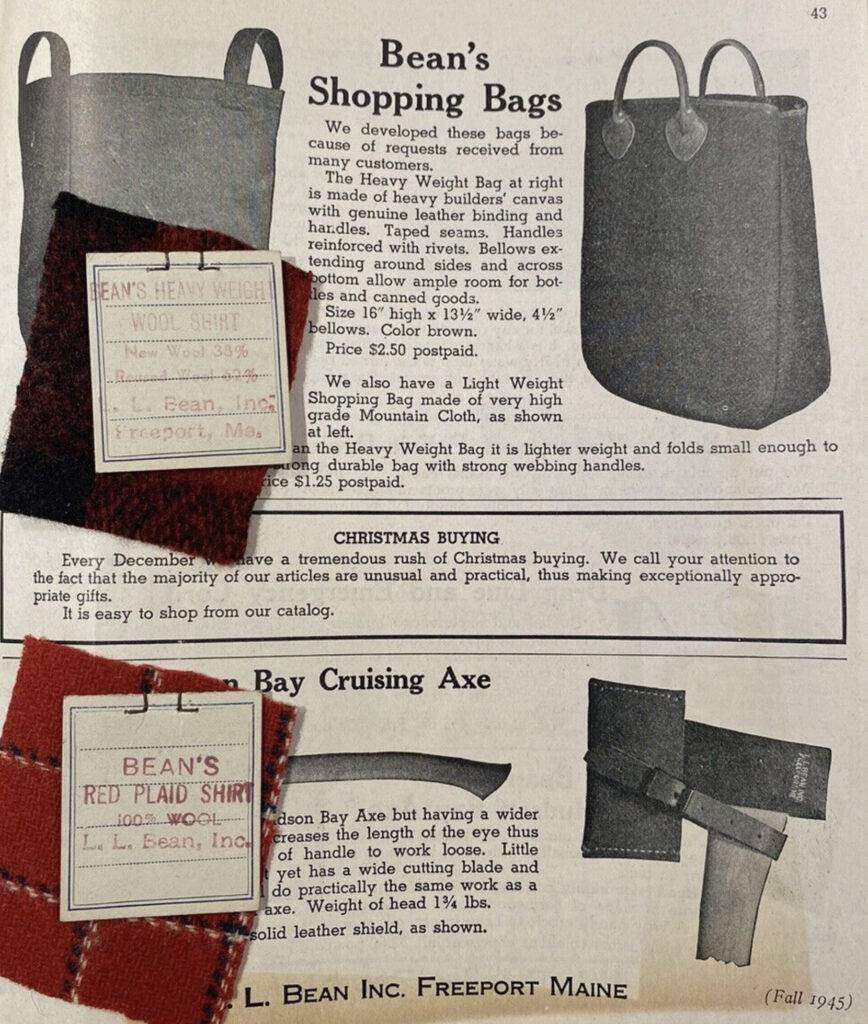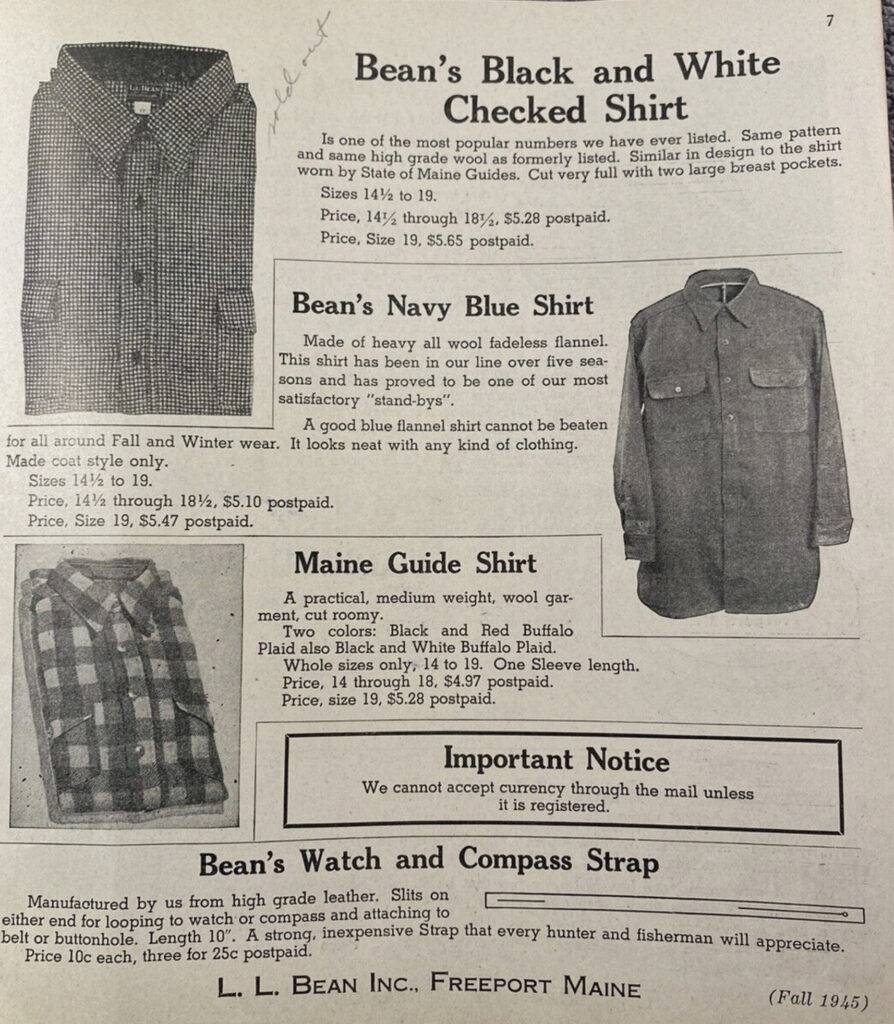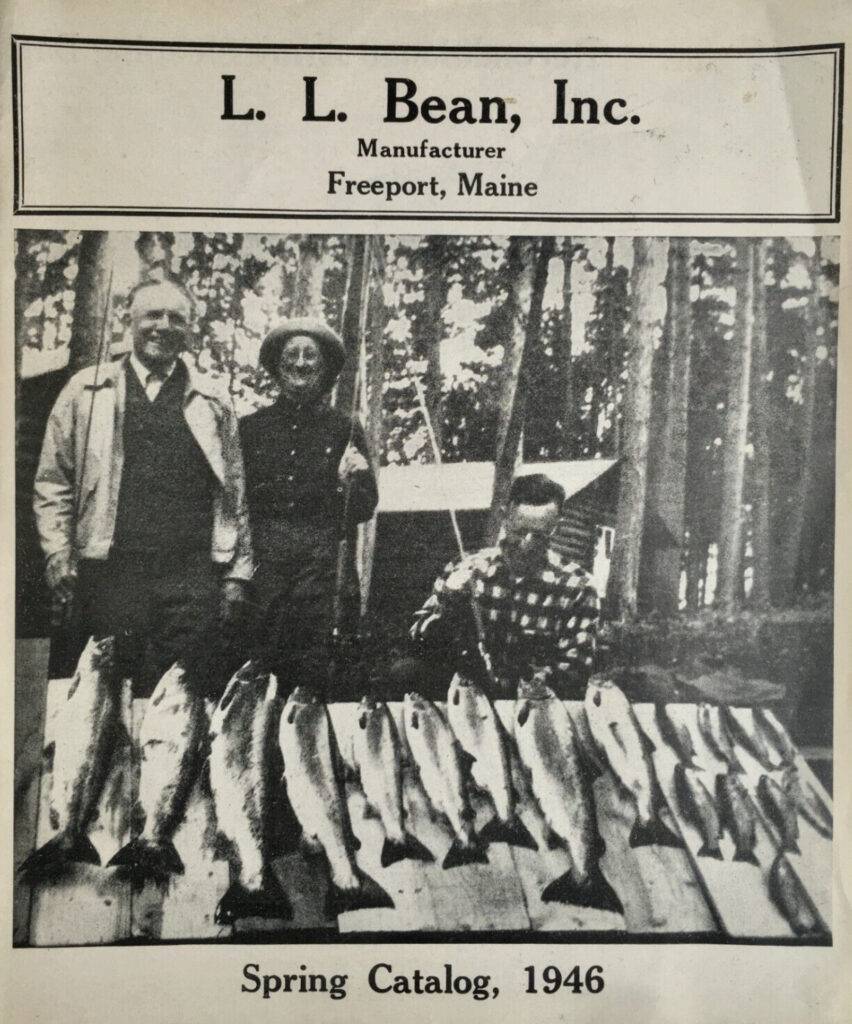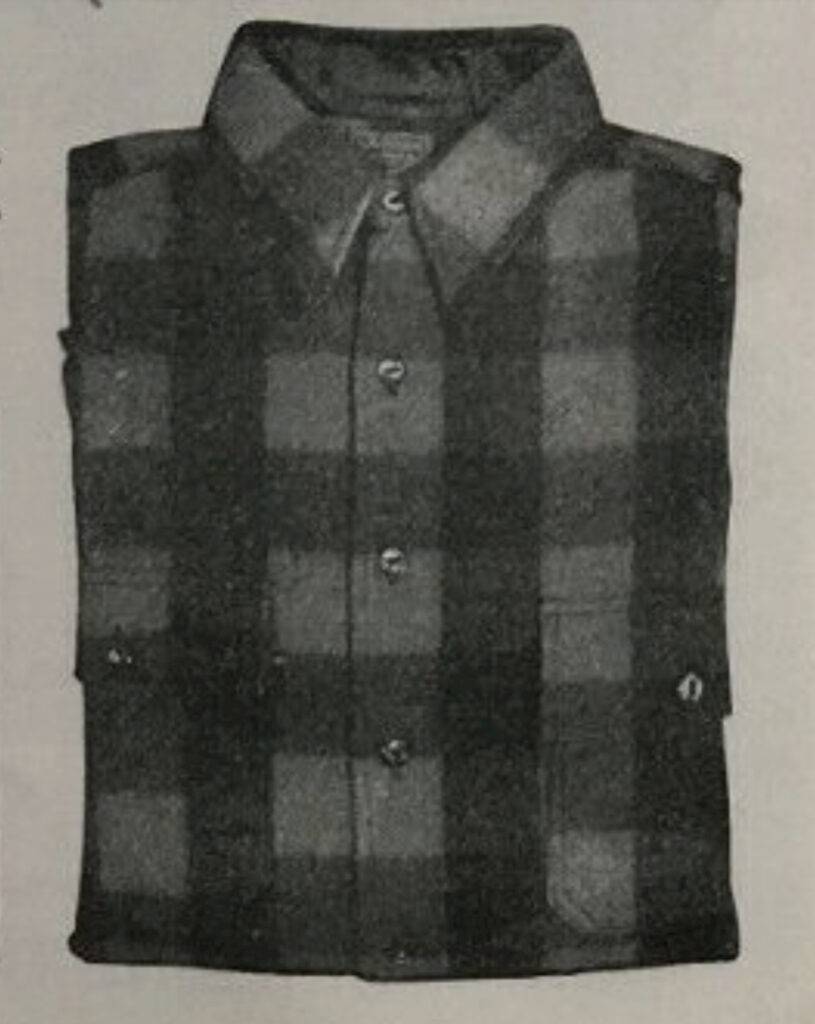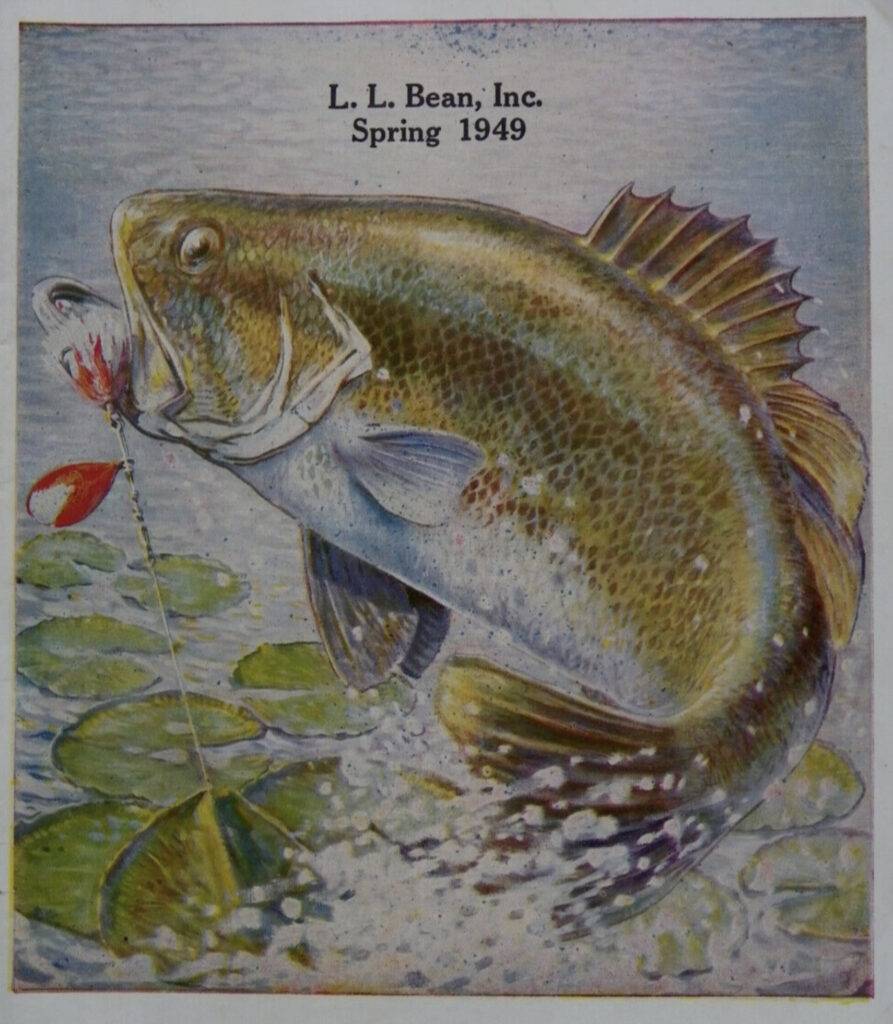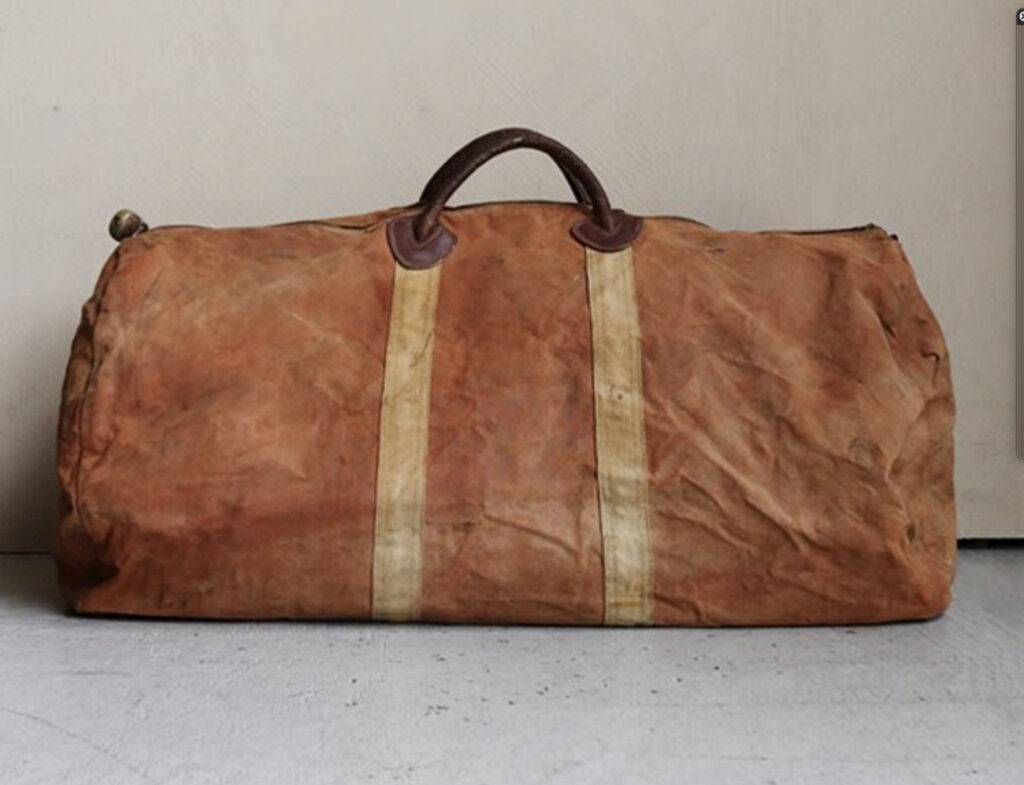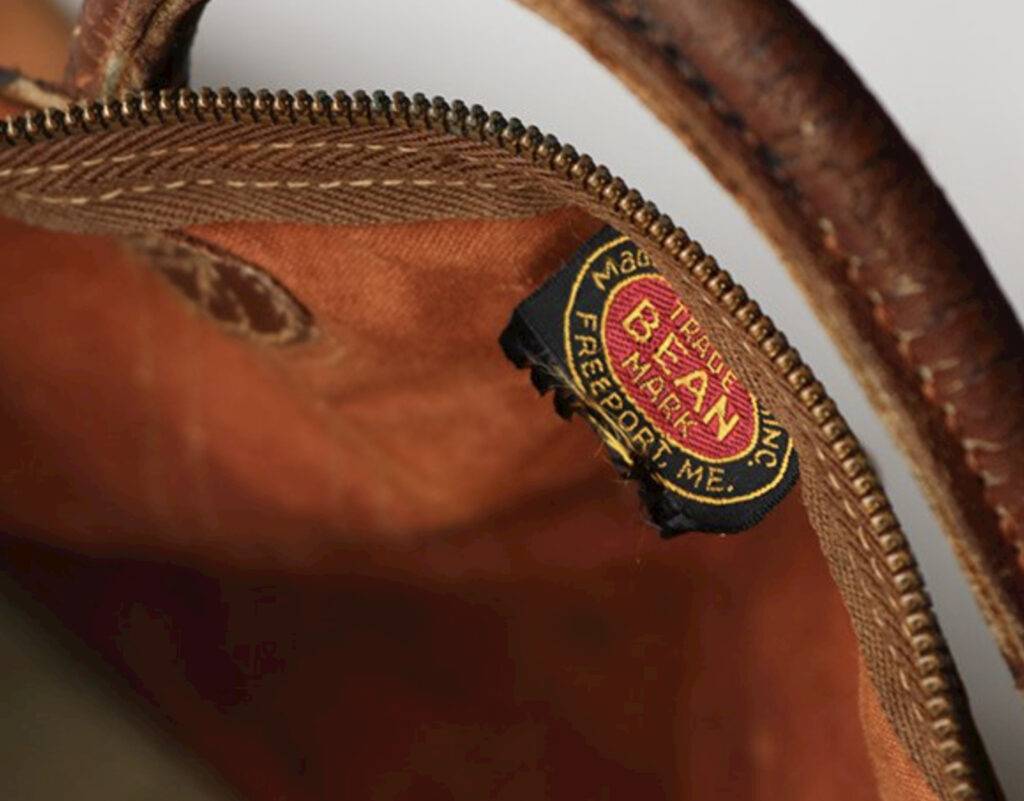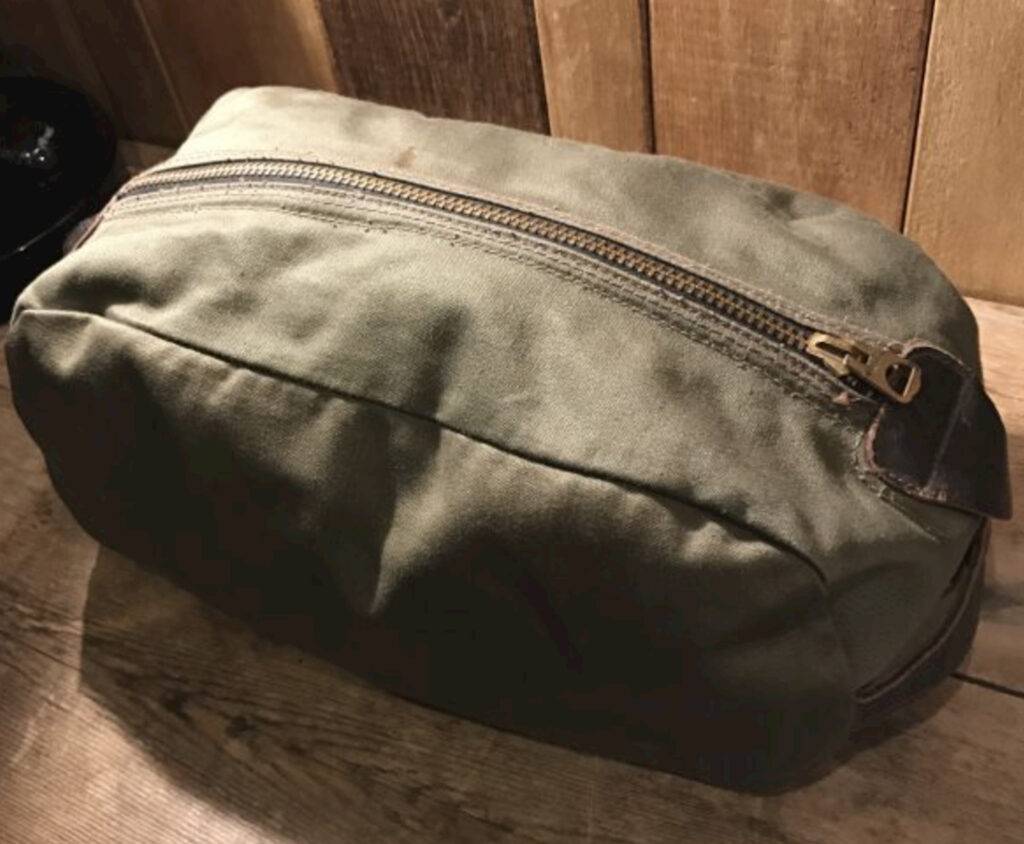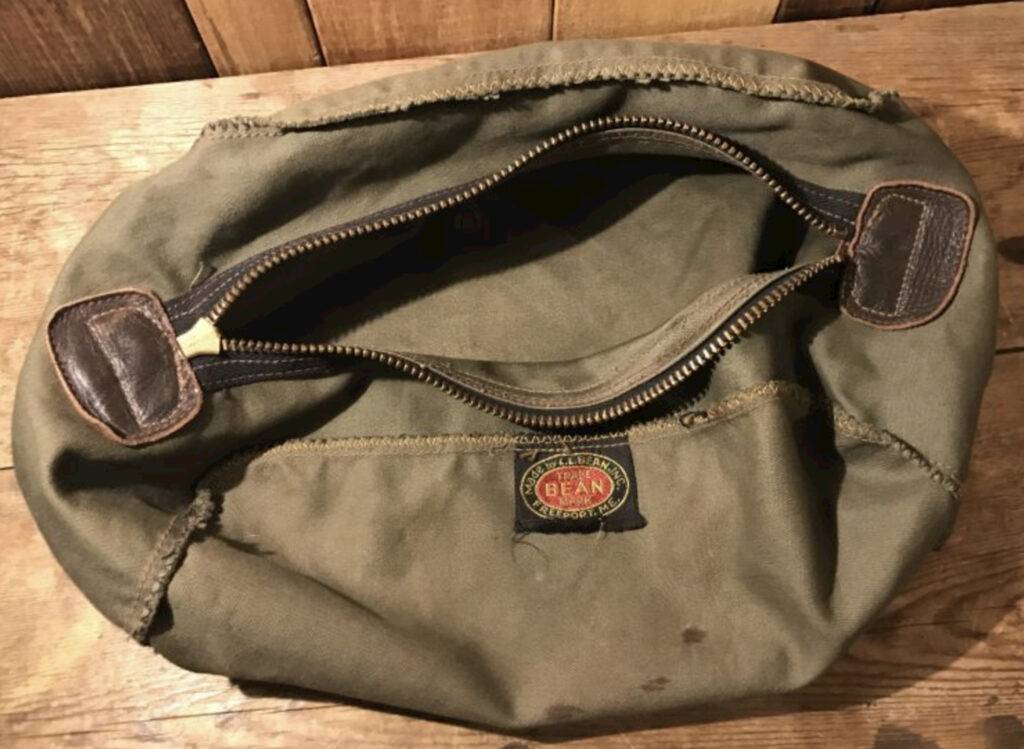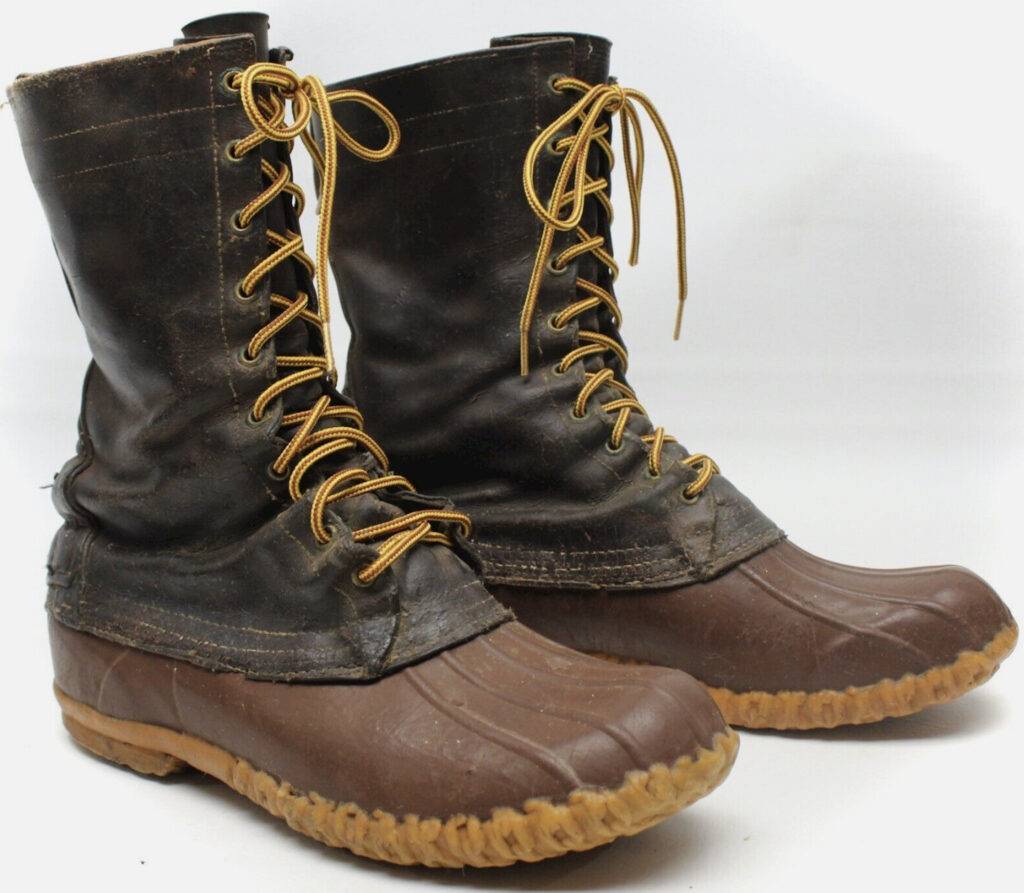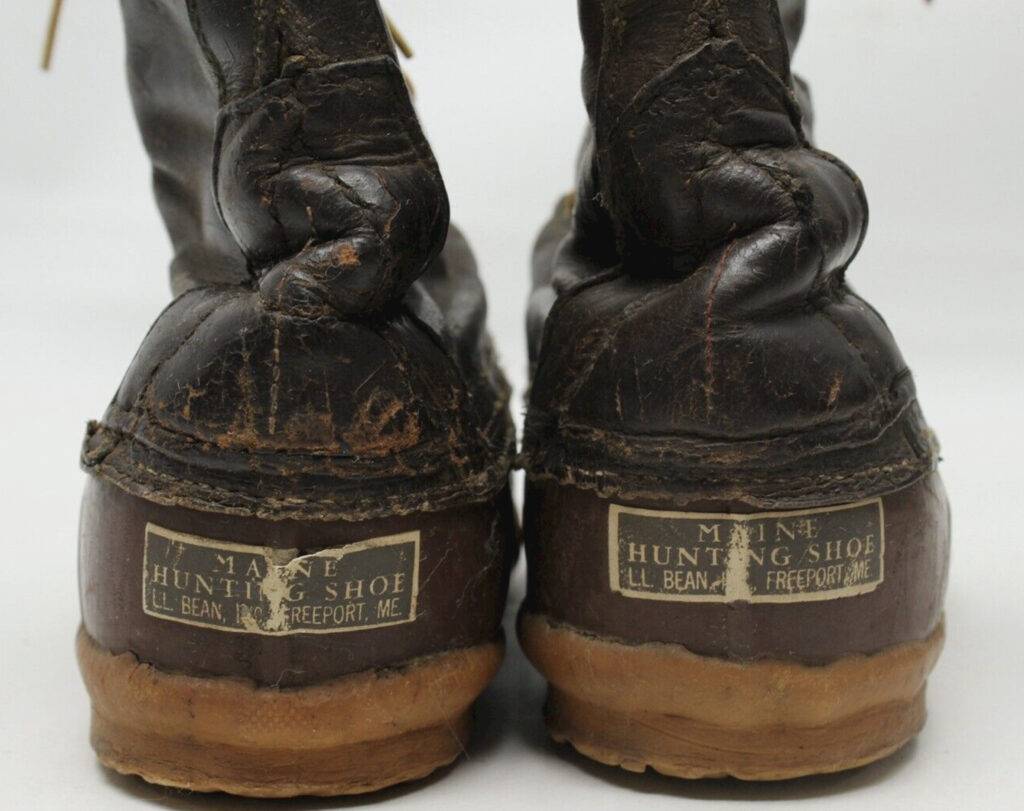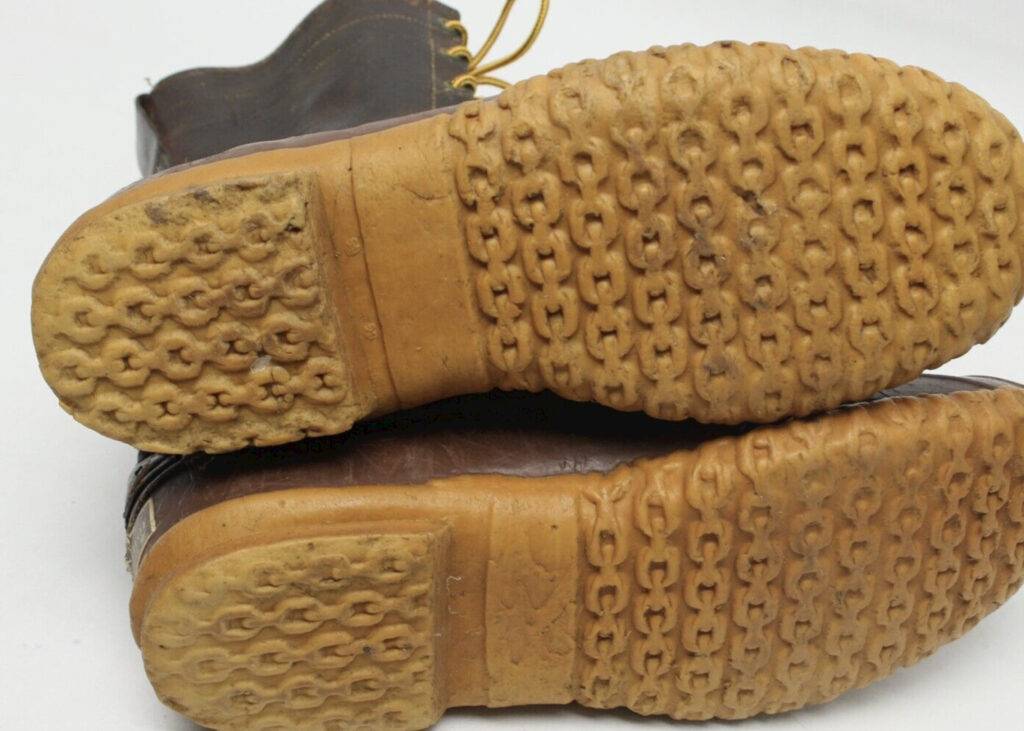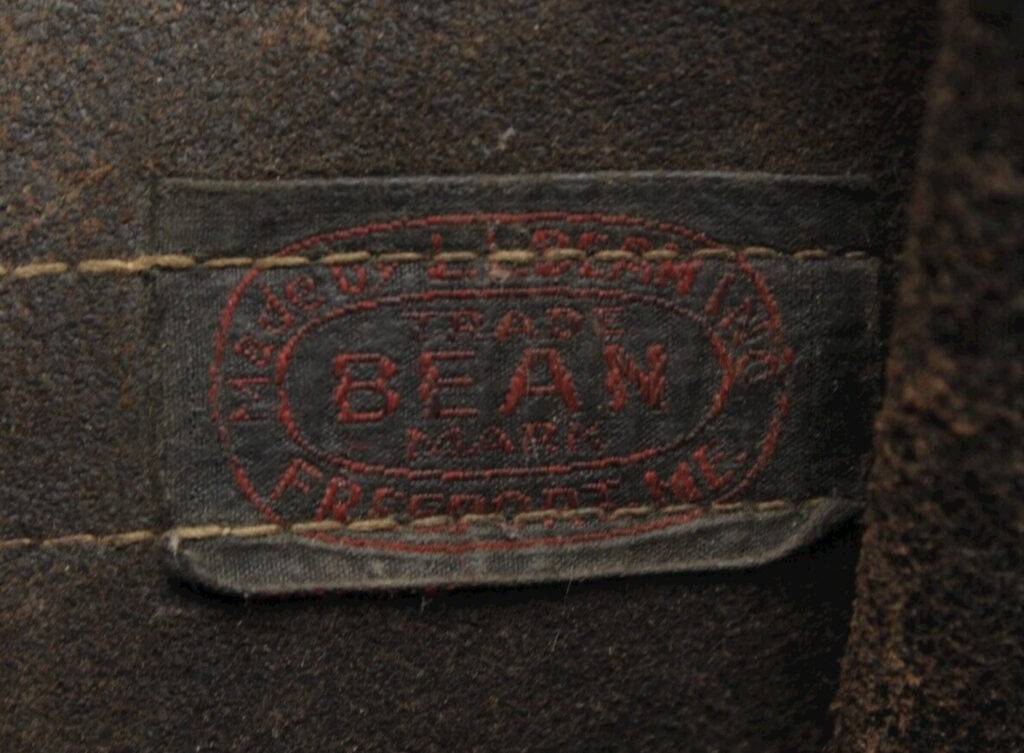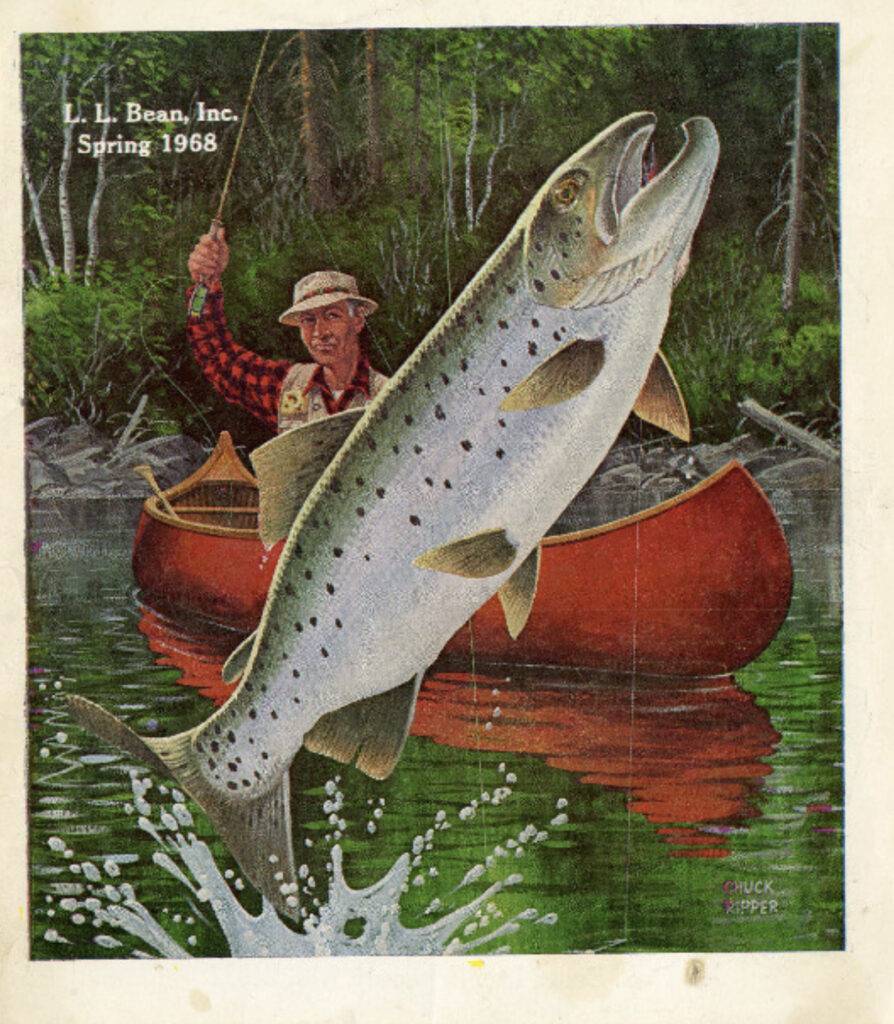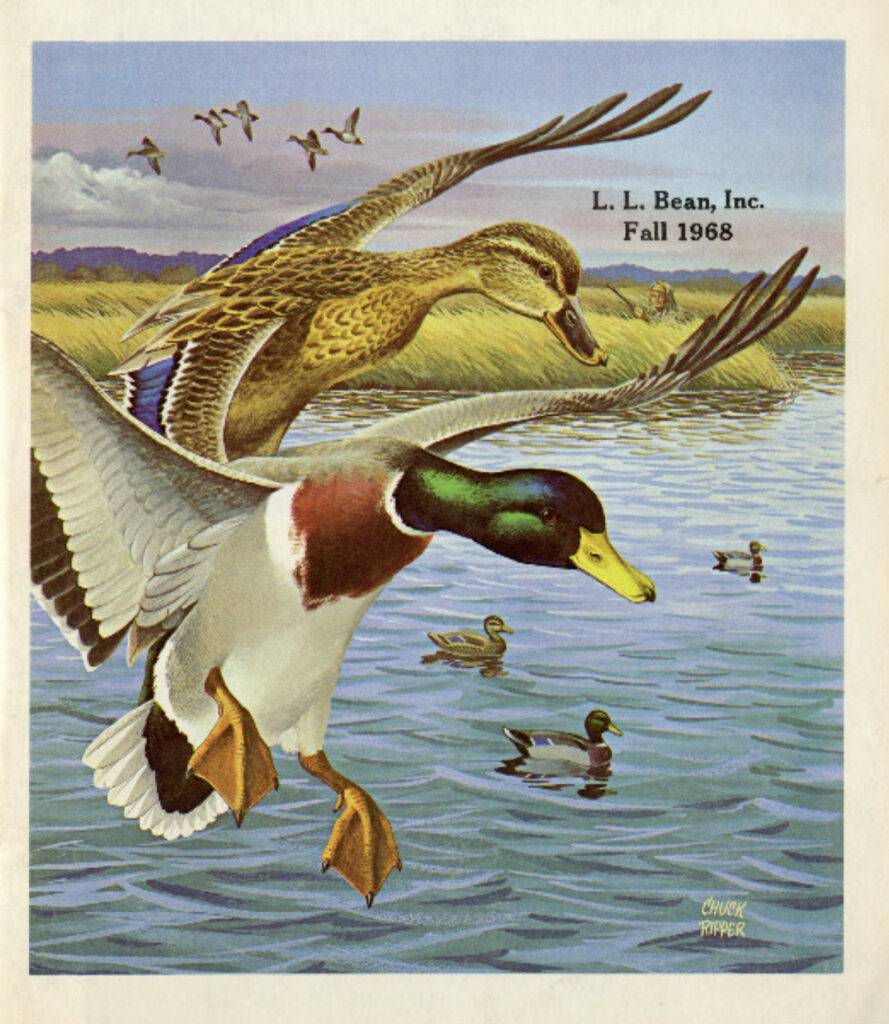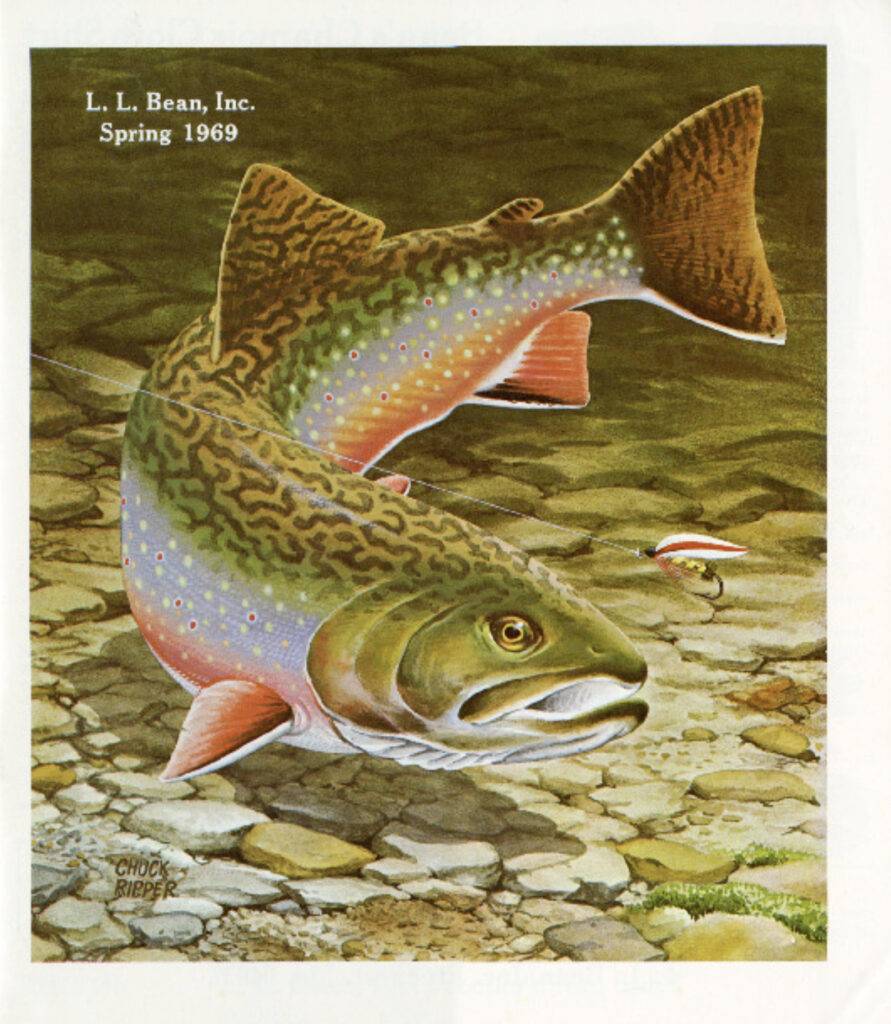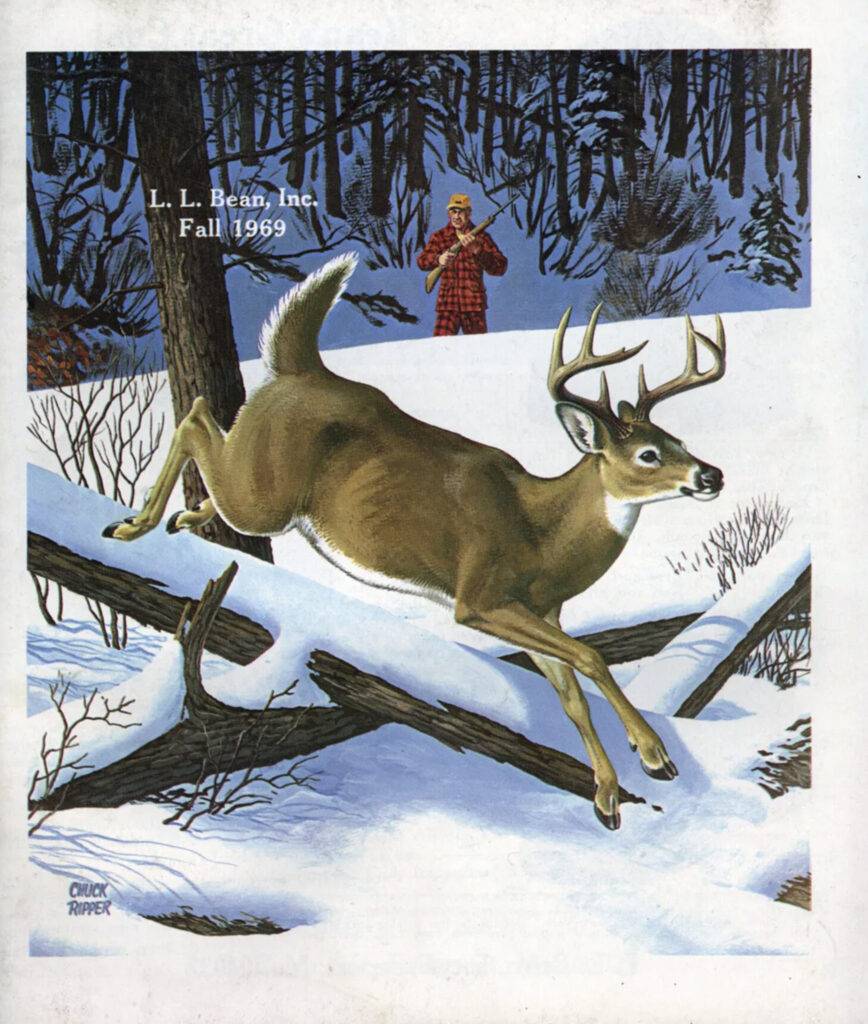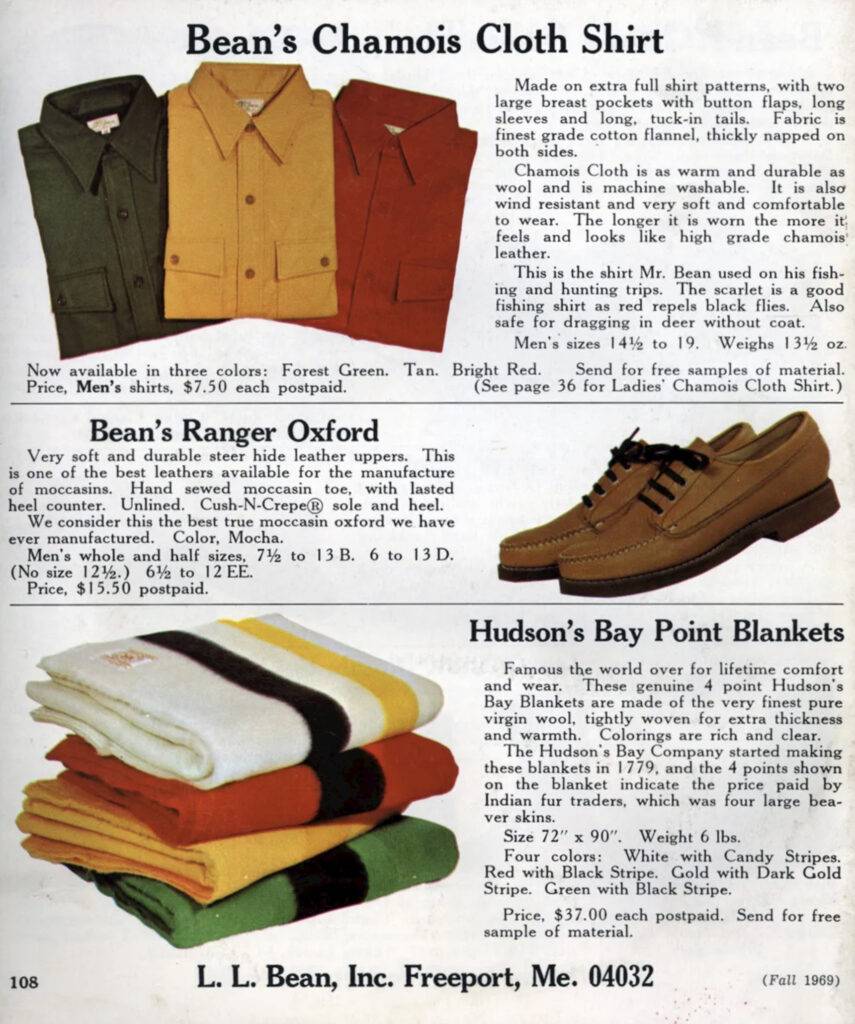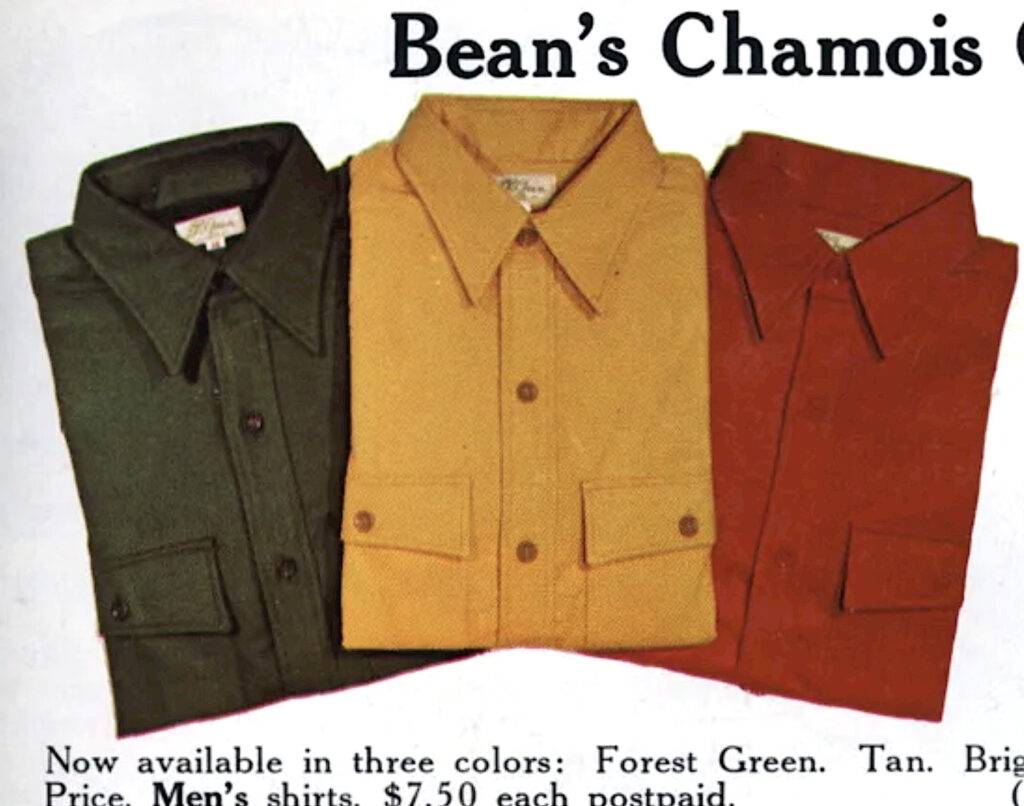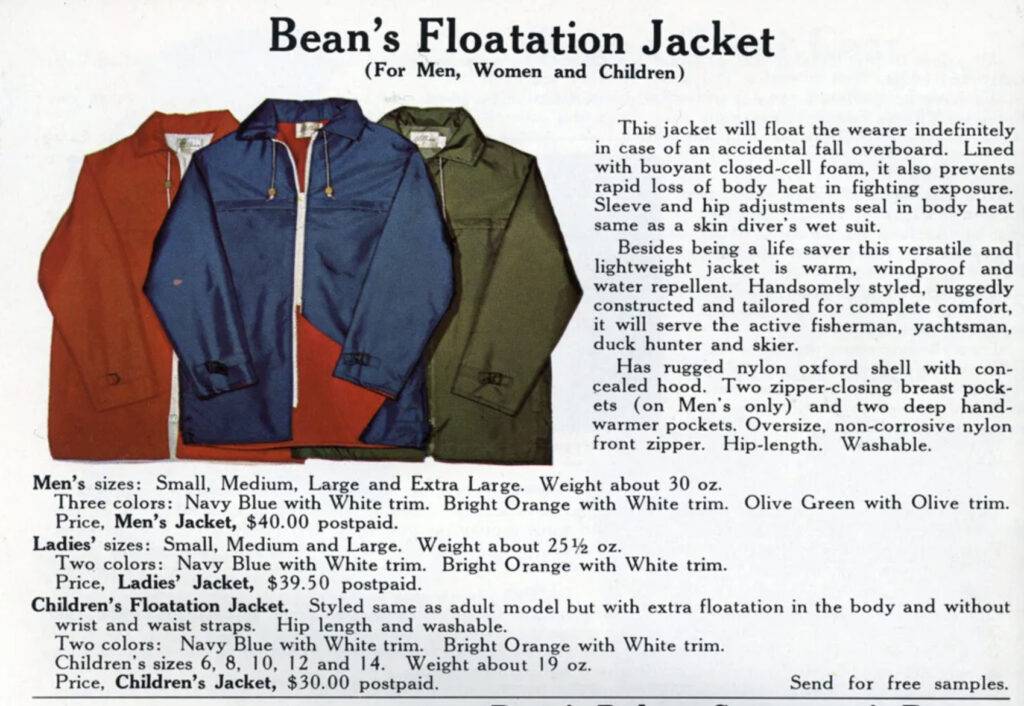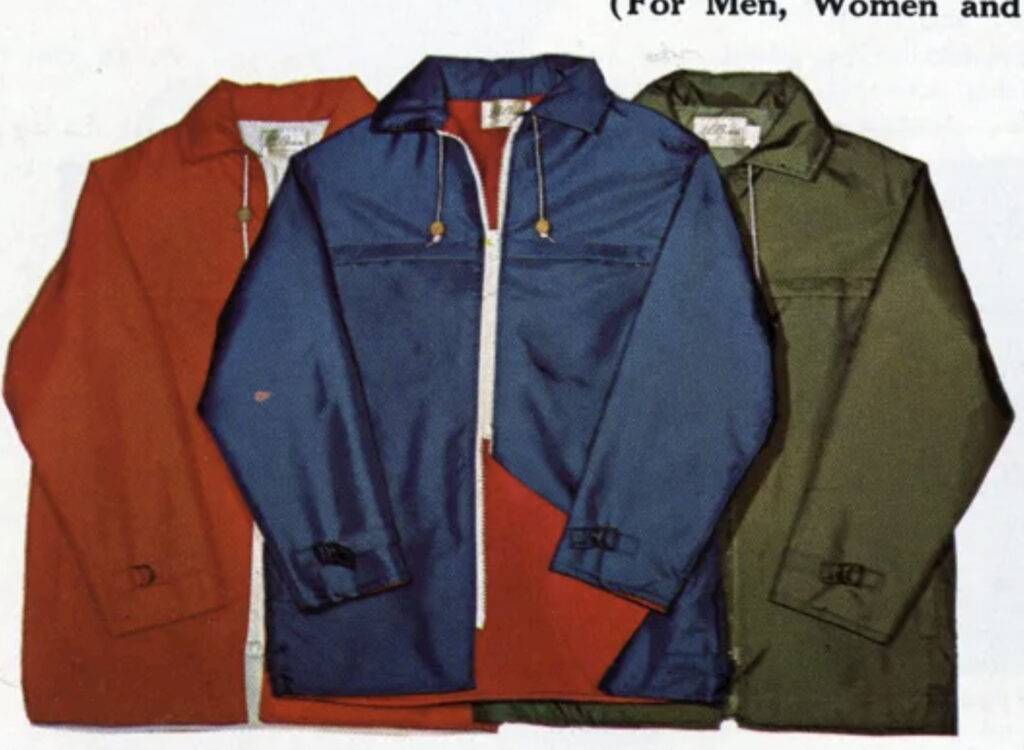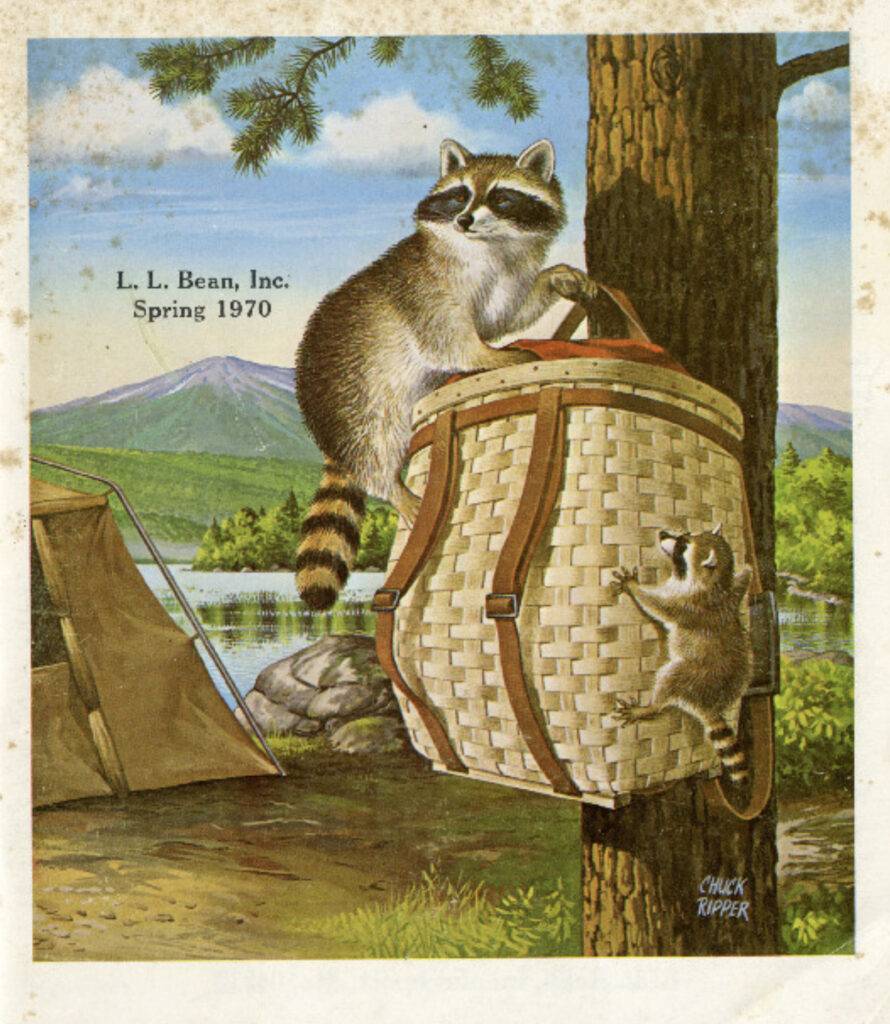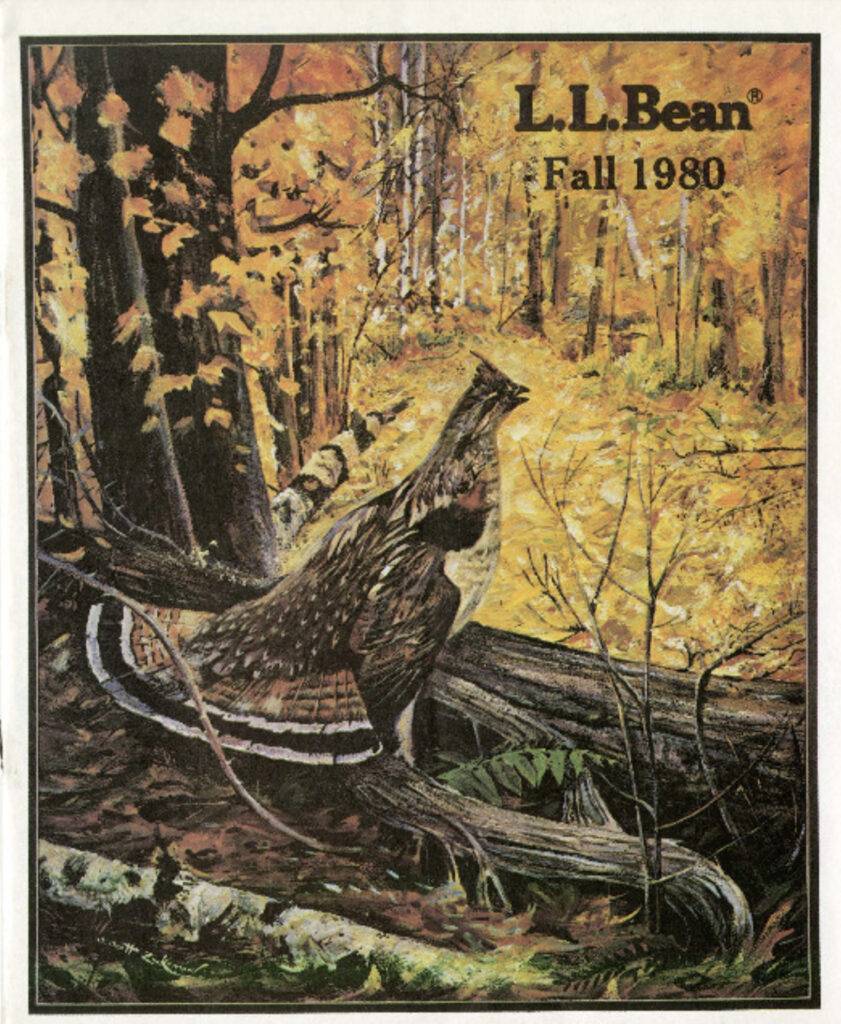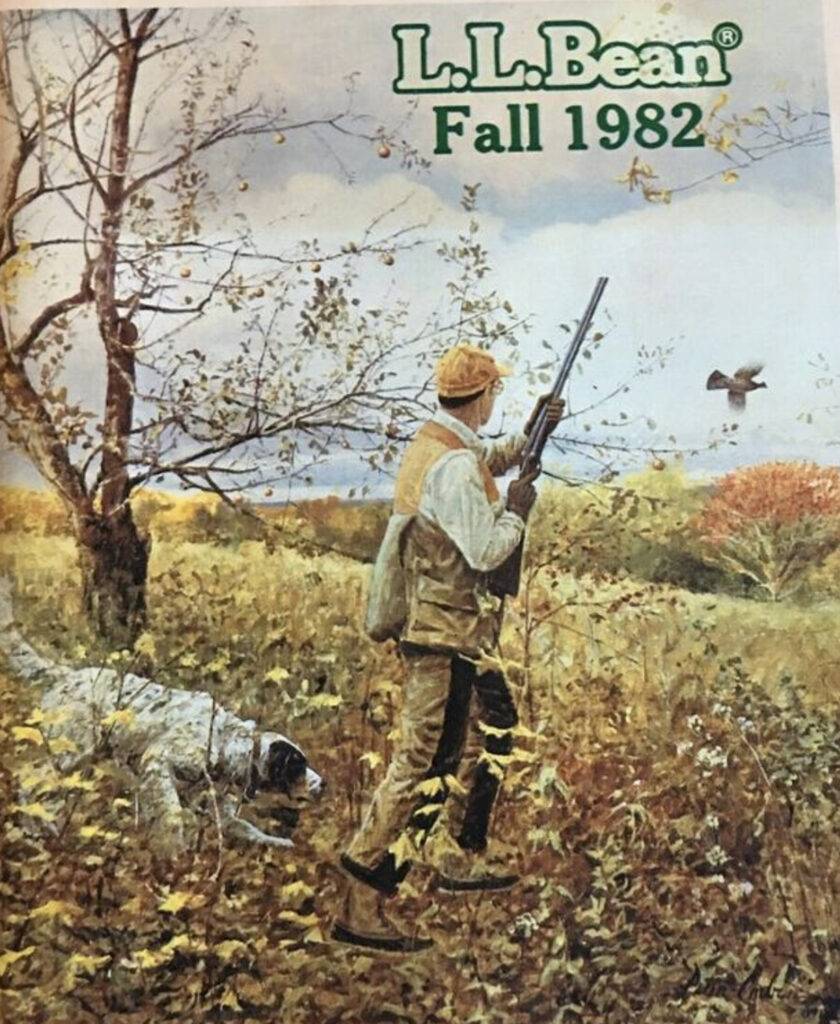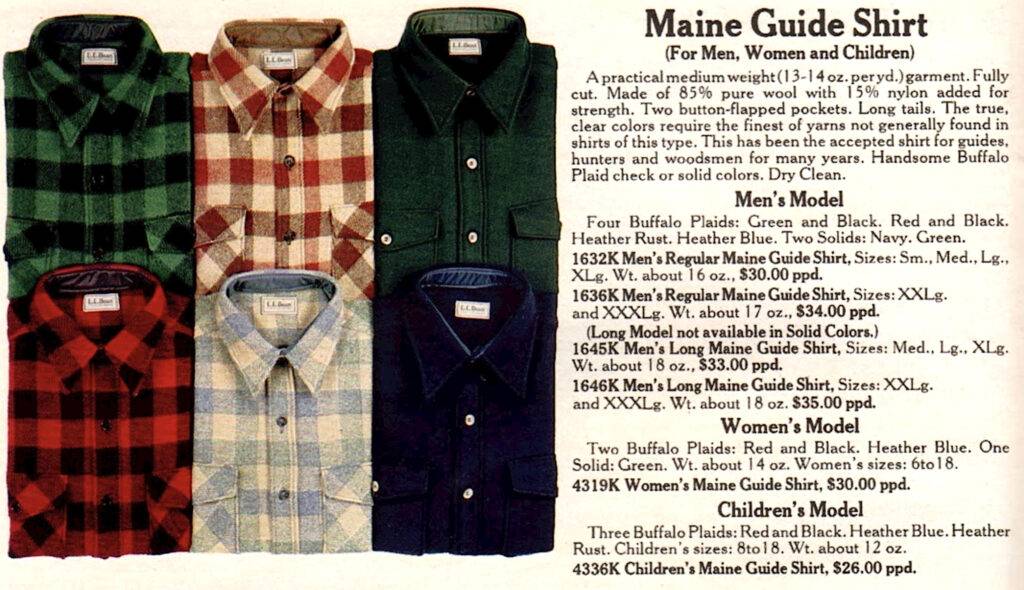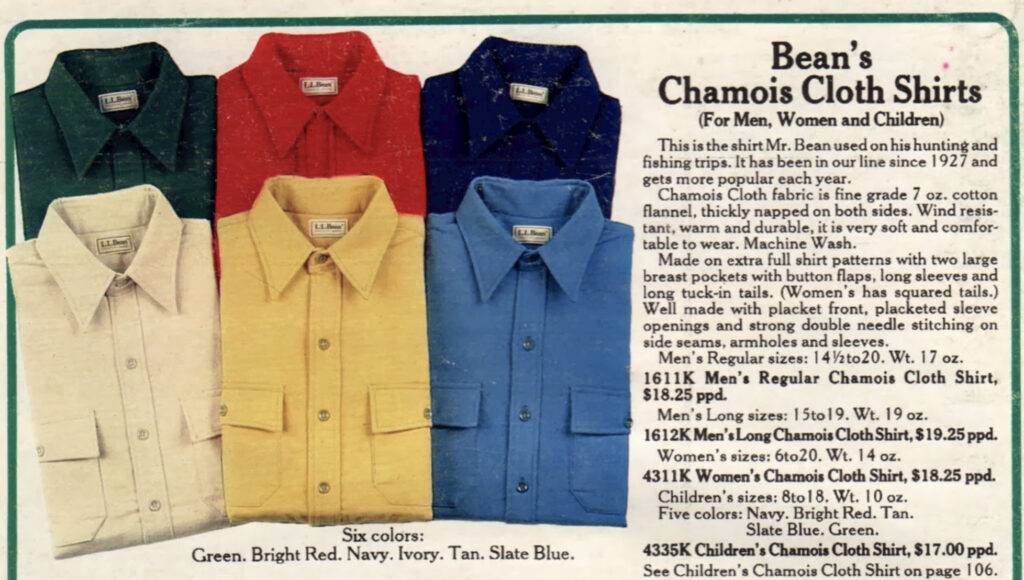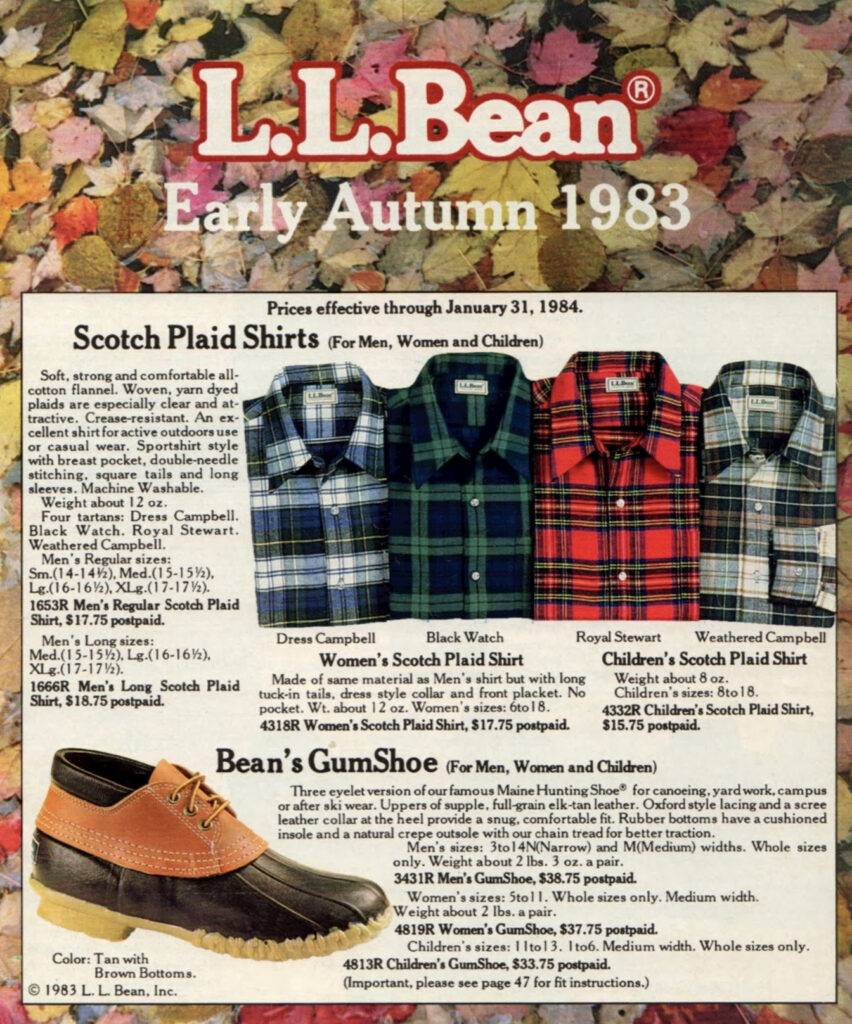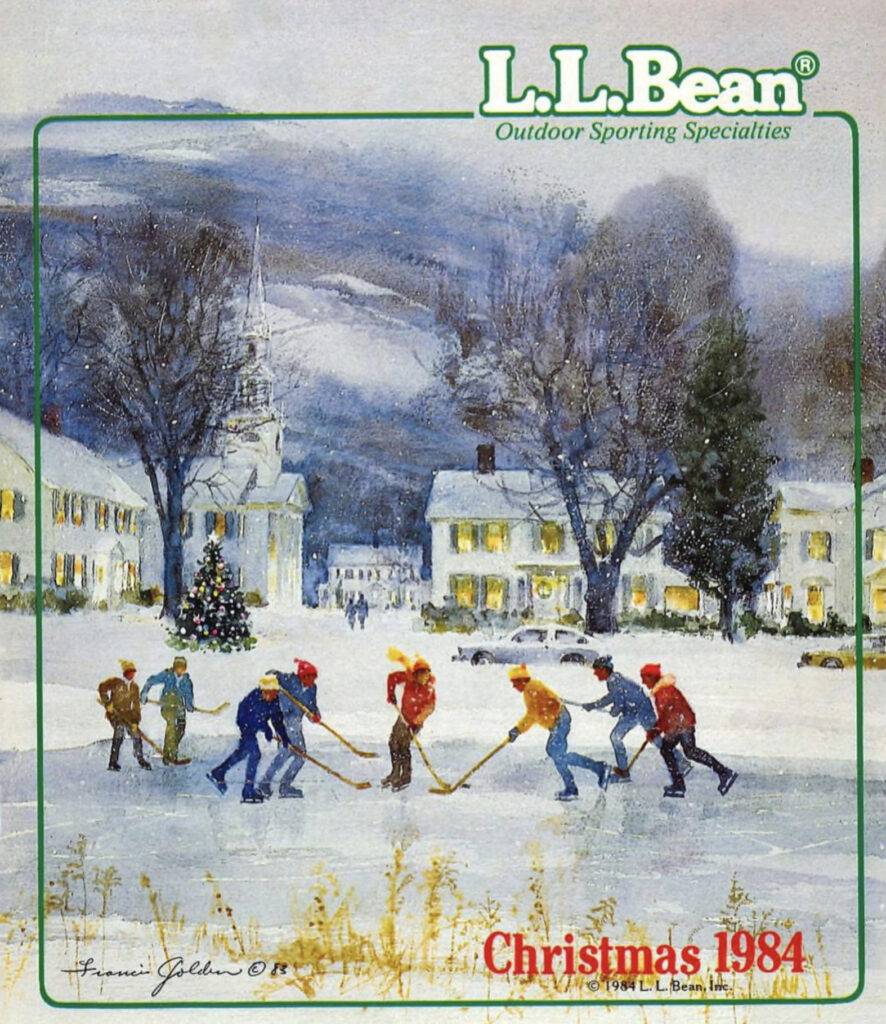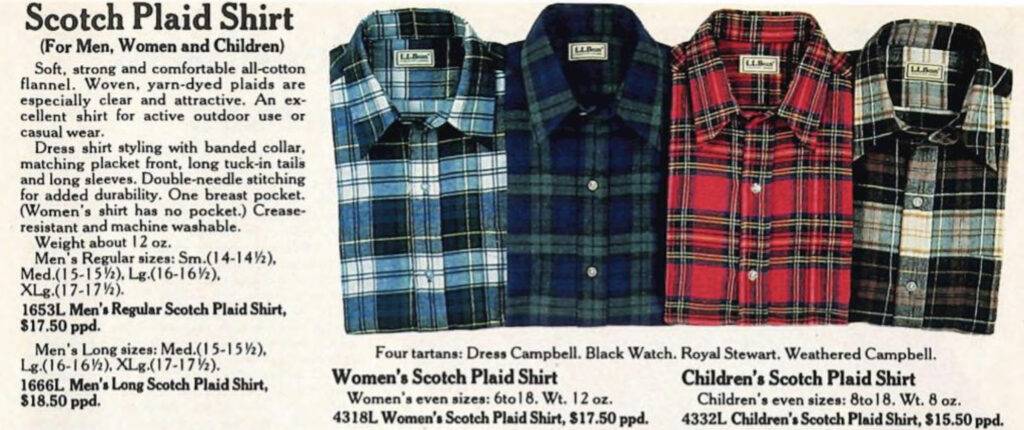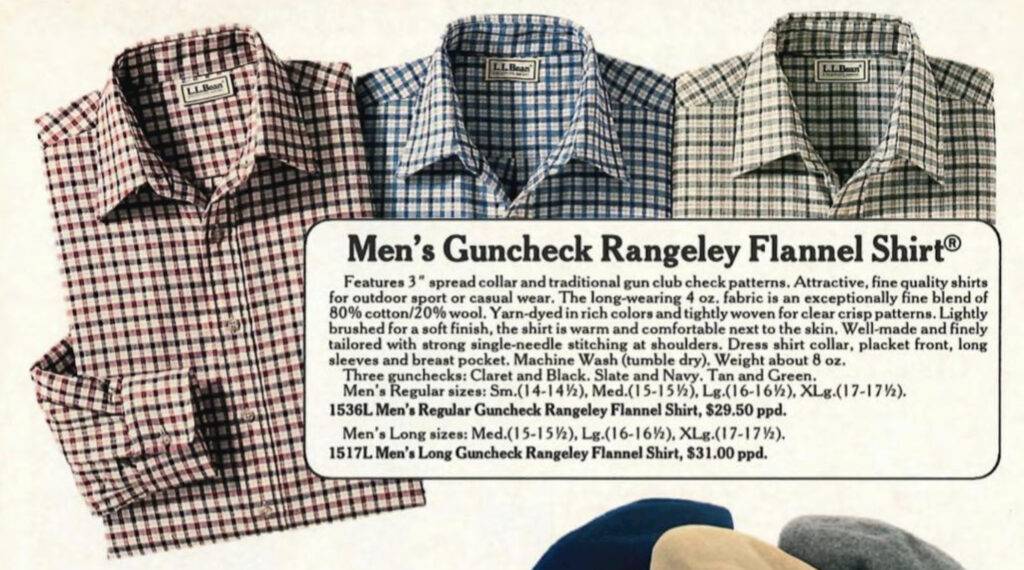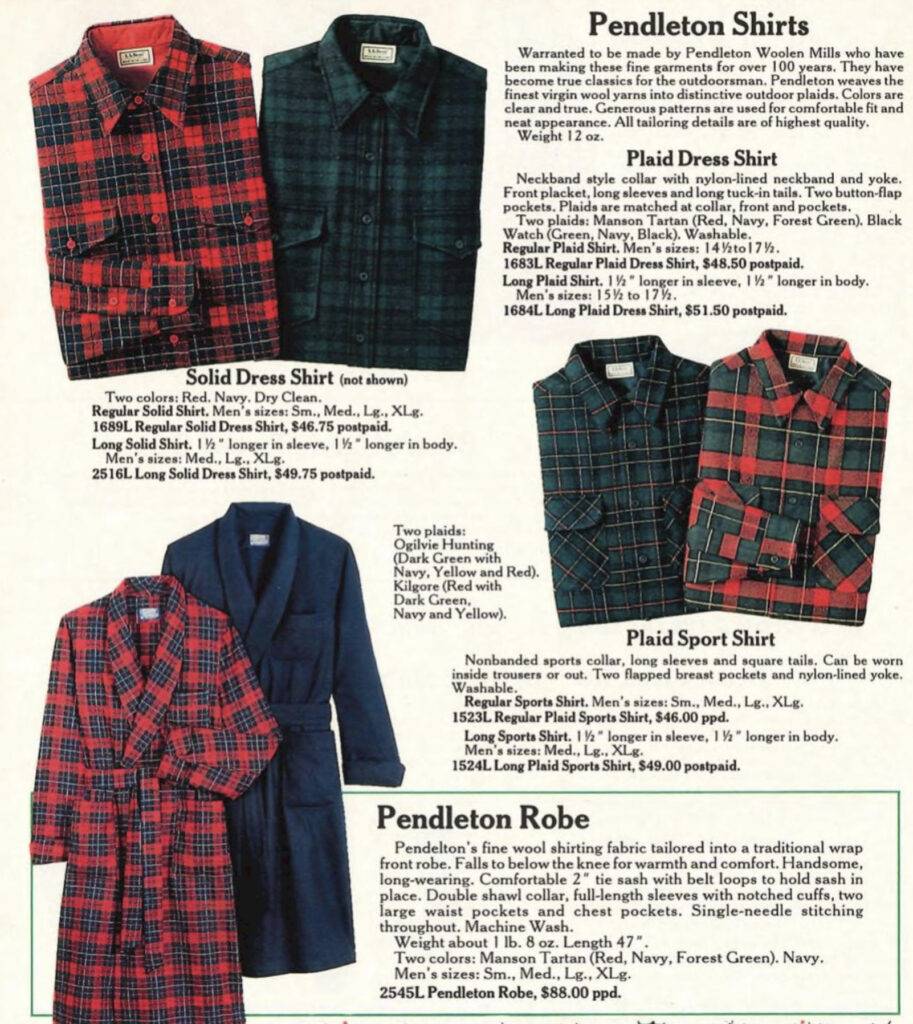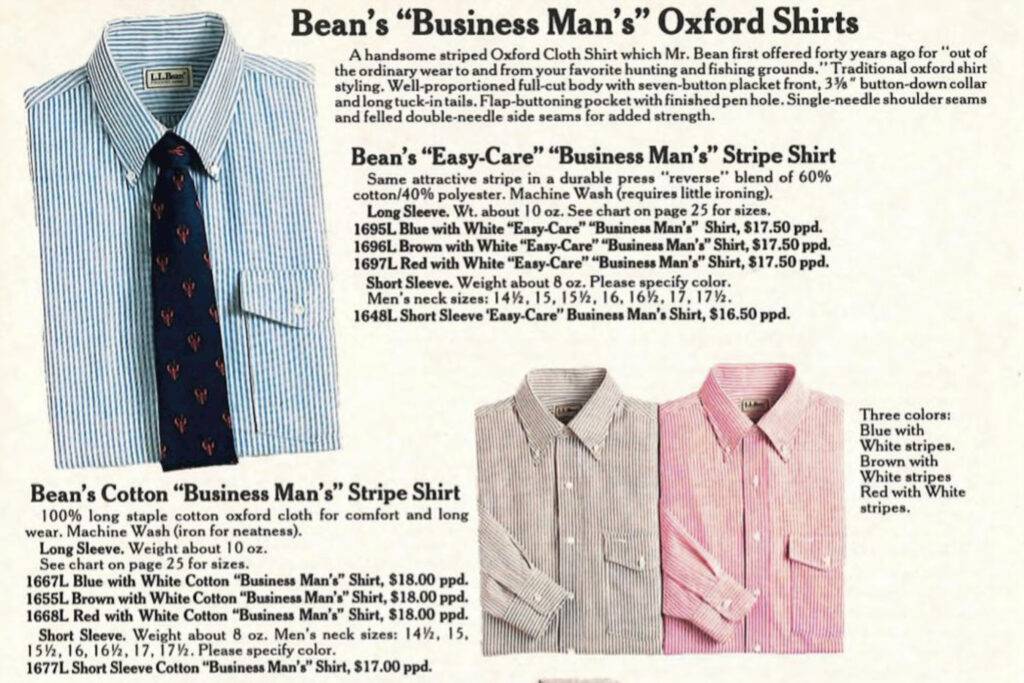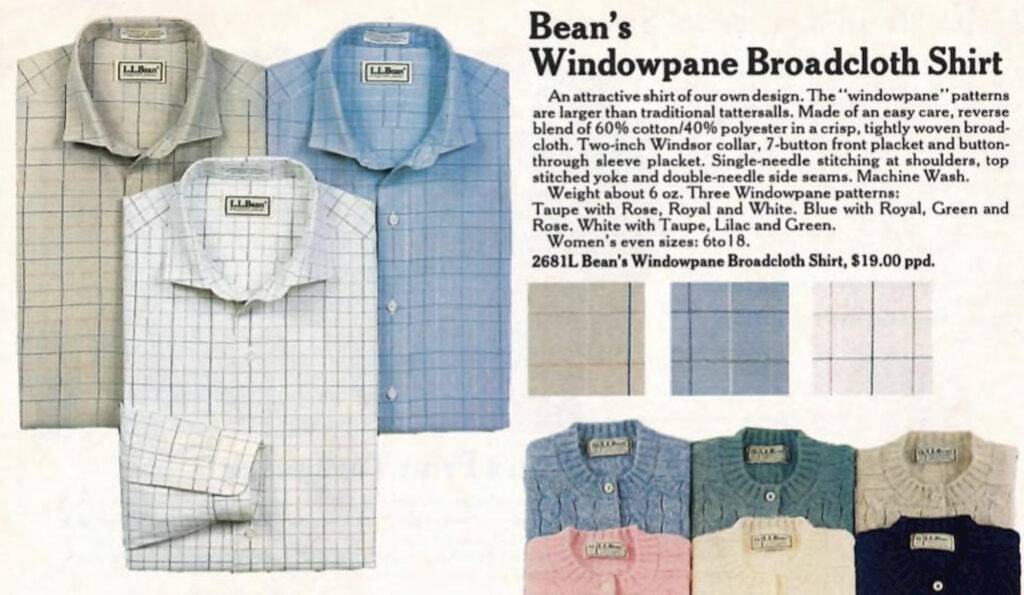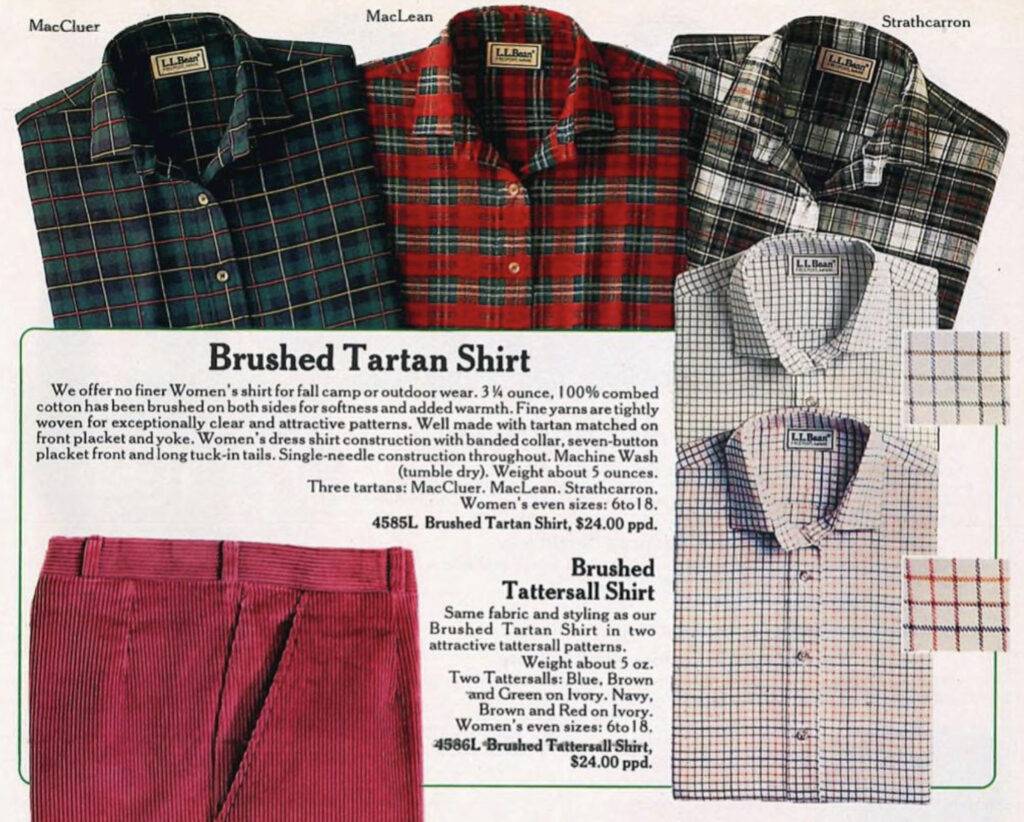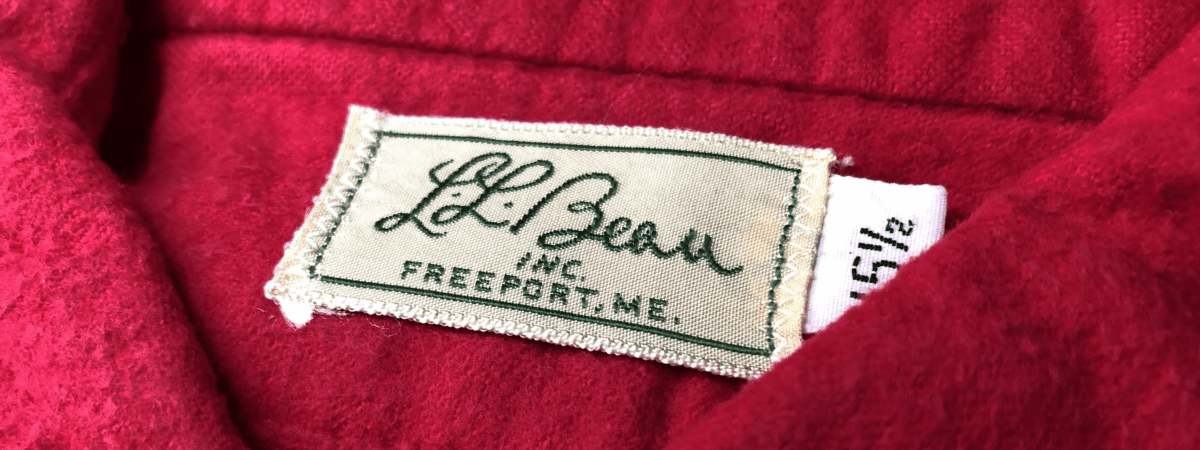
HISTORICAL
L.L.BEAN / VINTAGE TAGS
THE TRUE HISTORY
OCTOBER – 2023 15 MINS READ
“L.L.Bean” is a leading American brand. It is also my favorite brand. It is an integral part of the history of hunting and outdoor activities. The Maine Jacket, the Chamois Shirt and the Maine Hunting Boots are their signature products. But I have my doubts about the brand. Look back in history and study the old tags.
L.L.Beanはアメリカを代表するブランドであり、私のお気に入りのブランドでもあります。狩猟やアウトドア活動の歴史において欠かせない存在です。メインハンティングジャケット、シャモアシャツ、メインハンティングブーツは、彼らの代表的な製品です。しかし、私はこのブランドに疑問を持っています。歴史を振り返り、古いタグを研究し正しい歴史を学びましょう。ただし彼らが素晴らしいブランドであることは変わりはありません。
If you just want to see how to identify a “vintage name tag”…
もしあなたがL.L.BEANの年代別のタグだけの情報が欲しければ下のボタンを押してください。その記事だけにいくことができます。
Leon Leonwood Bean
Leon Leonwood Bean was born in the town of Greenwood, Maine, on October 13, 1872, to Benjamin Warren Bean and Sarah (Swett) Bean, one of six sons. According to a grandson of Leon L. Bean, the latter’s middle name may have been originally “Linwood” and accidentally changed to “Leonwood”. In the Freeport Town Clerk’s Report for the 1898–1899 period, a “Leon Linwood Bean” married a “Bertha Davis Porter” on September 28, 1898.
Bean showed an early interest in business, earning his first money when he was nine years old. He learned that he could either attend the local fair or sell steel traps to his father, so he decided to sell the traps. Bean’s parents died four days apart when Bean was 12 years old. He subsequently moved to South Paris, Maine, to stay with family. When Bean was 13 years old, he killed his first deer, and at 14 sold another that he had shot to two unsuccessful hunters. For two years until he was 18, Bean worked on an uncle’s farm in West Minot, while attending school in the winter. At 18 Bean worked on a farm in East Hebron. At 19, Bean attended a year long business course at Kents Hill School, paying his way by selling soap.
レオン・レオンウッド・ビーンは、1872年10月13日にメイン州グリーンウッドの町で、ベンジャミン・ウォーレン・ビーンとサラ(スウェット)・ビーン夫妻の6人の息子の一人として生まれました。レオン・L・ビーンの孫によると、彼のミドルネームはもともと「リンウッド」だったかもしれませんが、誤って「レオンウッド」に変更されたとのことです。フリーポート市町村書記官の1898年~1899年の報告書によると、「レオン・リンウッド・ビーン」という人物が1898年9月28日に「バーサ・デイビス・ポーター」という人物と結婚しています。
ビーンは幼い頃から商売に興味を示し、9歳の時に初めてお金を稼ぎました。彼は、地元の祭りに行くか、父親に鋼鉄製のわなを売るかを選ぶことができると知ったため、わなを売ることにしました。ビーンの両親は、ビーンが12歳の時に4日違いで亡くなりました。その後、ビーンは家族と一緒に住むためにメイン州サウス・パリに引っ越しました。ビーンが13歳の時、彼は最初の鹿を殺し、14歳の時にもう一匹の鹿を殺して2人の猟師に売りました。ビーンは、18歳になるまでの2年間、冬は学校に通いながら、ウエスト・マイノットの叔父の農場で働きました。18歳でビーンはイースト・ヘブロンの農場で働き、19歳でケント・ヒル・スクールで1年間のビジネス・コースを受講しました。彼は学費を稼ぐために石鹸を売っていました。
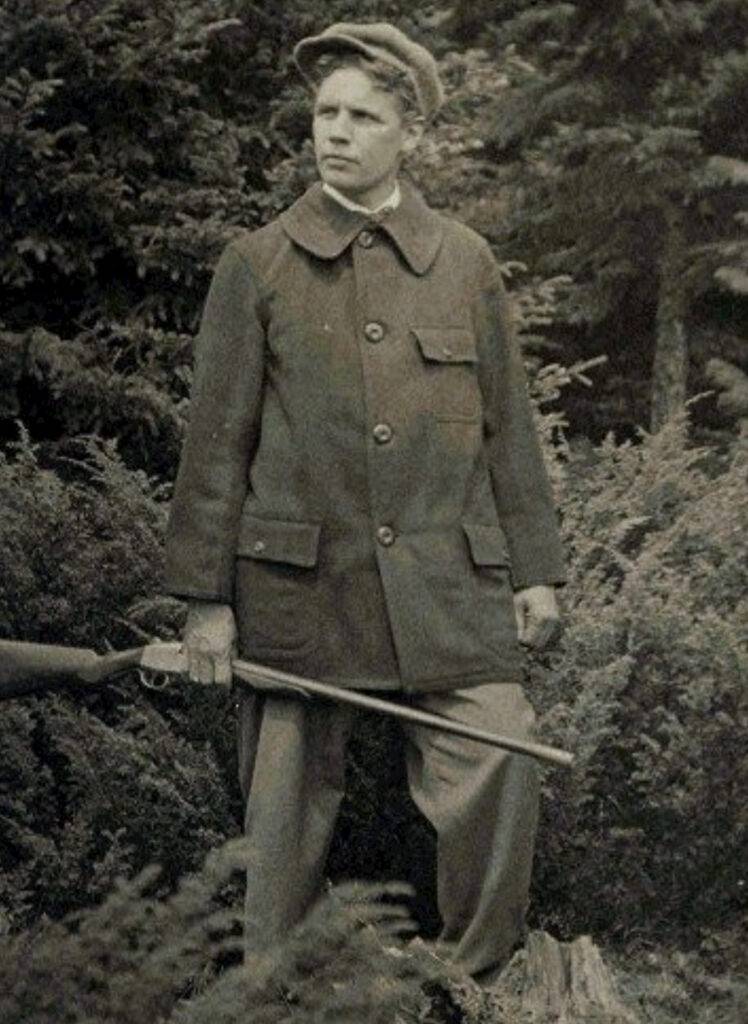
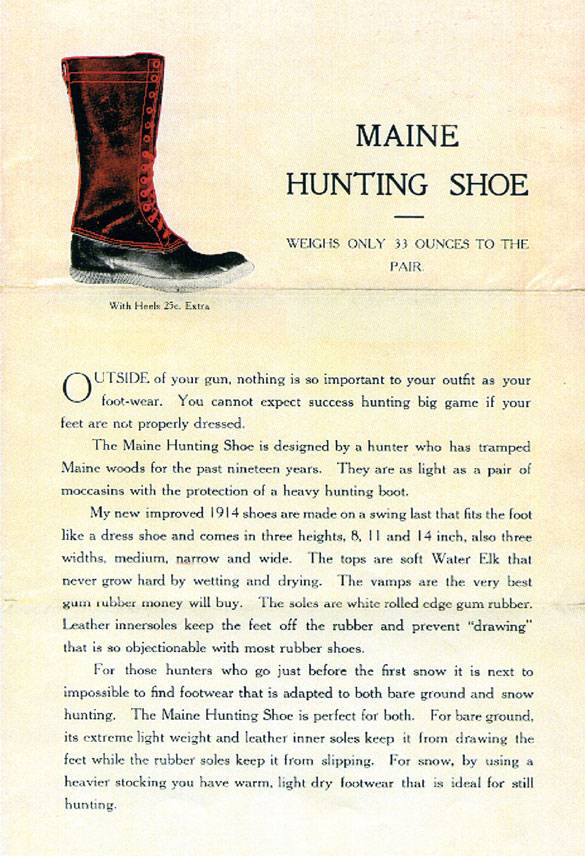
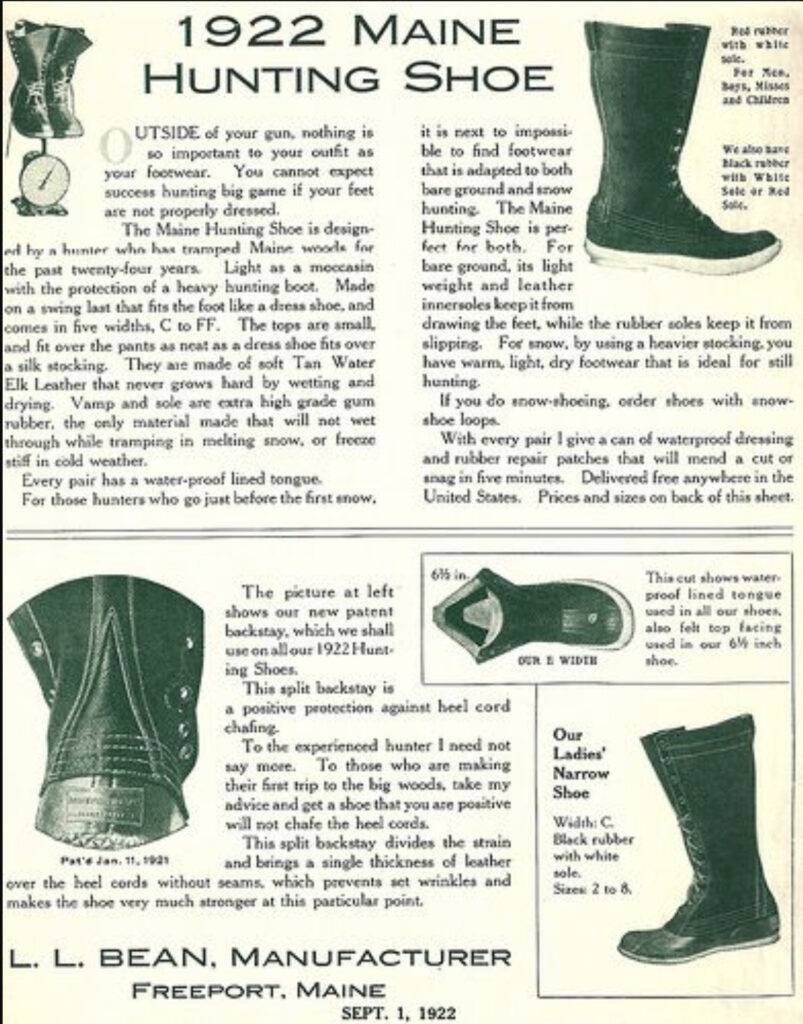

In 1892, Bean worked in a Bangor creamery, followed by a job clerking in an Auburn clothing store. Bean married Bertha Porter in 1898. They moved to Freeport, her hometown, where he worked in his brother Otho’s dry goods and clothing store. They raised three children, Carlton, Warren and Barbara, before Bertha died in May 1939, age 73. Claire became his second wife in 1941
Bean was an avid hunter and fisherman. In his outdoor activities, his boots would become soaked with water, so he set out to resolve this inconvenience and developed plans for a waterproof boot. The boot was a combination of lightweight leather for the upper part and rubber on the bottom. He brought the plans to a cobbler and the first boots were made. Bean felt the boot produced to be of good quality, and obtained a list of non-resident Maine hunting license holders and prepared a descriptive mail order circular. He promised 100% money back for anyone who was unhappy with the boots. Because of this, Bean had to refund 90% of the costs of the first 100 sets of boots made, when the rubber on the bottom developed cracks. He seemed not to mind returning the money, and the popularity of the boots was clear. In 1911, he took out a loan in the amount of US$400 and set off to Boston, where he offered the United States Rubber Company the remainder of his US$400 to produce a better quality boot for him. With the better quality boots available, Bean set up a boot shop in his brother’s basement in Freeport, Maine. His skills and trials as an entrepreneur, along with his promise to return 100% money back on all items, were detailed by many local and national newspapers of the time. By 1917, he had sold enough of his boots to buy a dedicated building for his shop on the main street of Freeport. In 1918, Bean realized the importance of patenting his invention. As the patent was granted, he moved on to inventing and improving more outdoor equipment and expanding his store to what L.L.Bean is today.
According to Bean, “I took a pair of show rubbers from the stock on the shelves and had a shoemaker cut out a pair of size 7 tops. The local cobbler stitched the whole thing together.” Bean sold a pair to Edgar Conant, his first customer. Over the summer of 1912, Bean sold a hundred pairs. According to Montgomery, Bean “…took rubbers out of his store stock, and got two locals, Mr. and Mrs. Ted Goldrup, to cut out tops and stitch them to the rubbers. The soft, pliable rubber simply ripped apart after a few miles of hard going.” Bean paid U.S. Rubber in Boston to make a mold for the rubber bottoms, and then became their biggest customer until the mid-1960s, when Bean switched to the La Crosse Rubber Company in Wisconsin. In 1918, Bean hired the Goldrup’s daughter, Hazel,as a full-time bookkeeper and cashier. In 1918, he moved to a new building across the street, and by 1920, owned
Bean published a book in 1942, called Hunting, Fishing and Camping and an autobiography, in 1960, called My Story: the Autobiography of a Down-East Merchant.
Bean died in Pompano Beach, Florida, on February 5, 1967, at the age of 94. He was buried in Webster Cemetery in Freeport, Maine. At the time of his death, the annual sales of his company were in the hundreds of millions. Company policy of giving 100% money back on returned products applied until February 9, 2018.Maine Medical Center has named one of its wings in his honor. In addition, his portrait hangs in a ground-floor corridor at the hospital.
1892年、ビーンはバンゴーの乳製品工場で働き、その後オーバンの衣料品店で店員として働いた。1898年にバーサ・ポーターと結婚し、彼女の故郷であるフリーポートに転居し、兄のオットーの乾物衣料品店で働いた。彼らは3人の子供、カールトン、ウォーレン、バーバラを育てたが、バーサは1939年5月に73歳で亡くなった。1941年にクレアが2番目の妻となった。
ビーンは熱心なハンターや釣り師だった。アウトドア活動では、彼のブーツは水に濡れてしまうことが多かったので、彼はこの不便さを解消するために、防水ブーツの計画を立てた。このブーツは、上部は軽量な革、下部はゴムでできたものであった。彼はその計画を靴屋に持ち込み、最初のブーツが作られた。ビーンは、作られたブーツの品質が良いと感じ、非居住者のメイン州狩猟ライセンス保持者のリストを入手し、詳しい通信販売のチラシを作成した。彼は、ブーツに不満を持つ人には100%返金することを約束した。このため、最初の100セットのブーツのゴム底にひび割れが発生したとき、ビーンは90%の費用を返金しなければならなかった。彼は返金することを気にせず、ブーツの人気が明らかだった。1911年、彼は400ドルのローンを組んでボストンに向かい、ユナイテッド・ステーツ・ラバー・カンパニーに残り400ドルを提供して、より高品質なブーツを作ってもらった。より高品質なブーツが手に入ると、ビーンはメイン州フリーポートにある兄の地下室にブーツ店を構えた。彼の起業家としてのスキルと試練、そしてすべての商品に100%返金することを約束したことは、当時の多くの地元紙や全国紙で報道された。1917年までに、彼はフリーポートのメイン通りに店舗を構えるための専用ビルを買うのに十分な数のブーツを販売していた。1918年、ビーンは自分の発明を特許を取得することの重要性に気づいた。特許を取得すると、彼はより多くのアウトドア用品を発明・改良し、店舗を現在のL.L.Beanへと拡大していった。
ビーンによると、「私は棚に並べてあるショーラバーを1足取り、靴屋にサイズ7のトップを切り取ってもらった。地元の靴屋がすべてを縫い合わせてくれた」という。ビーンは最初の顧客であるエドガー・コナントに1足売った。1912年の夏、ビーンは100足を販売した。モントゴメリーによると、ビーンは「店に置いていたラバーを取り出して、地元の夫妻であるテッド・ゴールドルップ氏と夫人に頼んで、トップを切り取ってラバーに縫い合わせてもらった。柔らかいゴムは、数マイルのハードな使用の後には簡単に裂けてしまった」という。ビーンはボストンのU.S.ラバー社にゴム底の金型を作ってもらい、1960年代半ばにラ・クロス・ラバー・カンパニーに切り替えるまで、同社の最大の顧客となった。1918年、ビーンはゴールドルップ夫妻の娘であるヘイゼルを、フルタイムの簿記係兼レジ係として雇った。1918年、彼は向かい側に新しいビルに移転し、1920年までにビルの所有者となった。
Bean published a book in 1942, called Hunting, Fishing and Camping and an autobiography, in 1960, called My Story: the Autobiography of a Down-East Merchant.
Bean died in Pompano Beach, Florida, on February 5, 1967, at the age of 94. He was buried in Webster Cemetery in Freeport, Maine. At the time of his death, the annual sales of his company were in the hundreds of millions. Company policy of giving 100% money back on returned products applied until February 9, 2018.Maine Medical Center has named one of its wings in his honor. In addition, his portrait hangs in a ground-floor corridor at the hospital.
ビーンは1942年に『Hunting, Fishing and Camping』、1960年に『My Story: the Autobiography of a Down-East Merchant』という自伝を出版した。ビーンは1967年2月5日、フロリダ州ポンパノビーチで94歳で亡くなった。彼はメイン州フリーポートのウェブスター墓地に埋葬された。彼の死当時、彼の会社の年間売上は億単位にのぼっていた。返品商品に対する100%返金という会社方針は、2018年2月9日まで適用されていた。メイン州立医療センターは、その一棟に彼の名を冠している。また、彼の肖像画は病院の1階の廊下に飾られている。
TRUE STORY ABOUT “HUNTING BOOT”, The inventor is not L.L.bean.
1899
William E. Barker, of 207 Congress street, Boston, is the originator of the Barker hunting shoe, illustrated herewith. Mr. Barker is a highly enthusiatsic sportsman, besides being well up in the rubber boot and shoe business, so that by virtue of the dual accomplishments he is well qualified to have “fathered” the new shoe.
Speaking in reference to this shoe the originator says: “Compare with
any similar shoe in the market and note quality of rubber, workmanship and grade of leather used. From the box calf to the silk stitching I use the best, for experience has taught me the higher grade shoe is the only one to be depended upon tor service, ease and comfort when in the woods. This top is soft and pliable, even after having been used in water continuously, no dressing or greasing necessary. While this shoe was designed originally for my own use, and intended for a hunting shoe, I have received many calls from woodsmen and lumbermen, who pronounce it the best shoe for the woods they have ever used.”
Shoe retailer and boots and shoes weekly. v. 54 (1905)
ボストンのコングレス ストリート 207 に住むウィリアム E. バーカーは、ここに示されているバーカー ハンティング シューズの創始者です。バーカー氏は非常に熱心なスポーツマンであり、さらにラバーブーツと靴のビジネスで成功しており、その二重の功績により、新しい靴を「生みの親」とする資格は十分にあります。
この靴について、創始者は次のように述べています。「
市場にある類似の靴と比較して、使用されているゴムの品質、仕上がり、革のグレードに注目してください。ボックスカーフからシルクステッチまで、私は最高のものを使用しています。経験上、森の中でのサービス、履きやすさ、快適さのために信頼できるのは高級靴だけであることがわかりました。このトップは柔らかくてしなやかで、水中で継続的に使用した後でも、ドレッシングやグリースを塗る必要はありません。この靴はもともと私自身の使用のためにデザインされ、狩猟用の靴として設計されたものですが、木工や製材業者から多くの電話を受け、彼らはこれがこれまで使用した森に最適な靴であると宣言しました。」 靴小売業者とブーツと靴の週刊
誌. 54 節 (1905 年)。
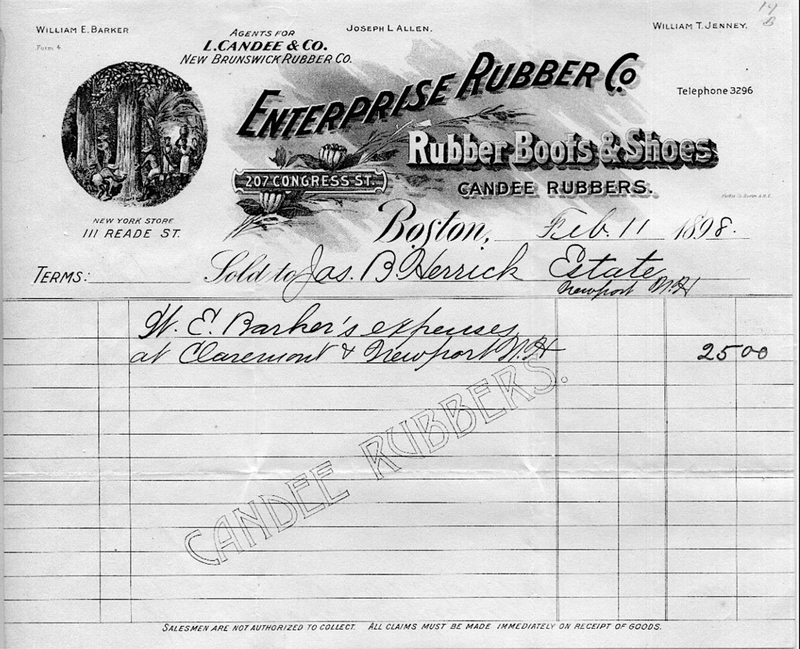
TURE HISTORY OF 1905 BAKER HUNTING BOOT (THE ORGIN)
William E. Barker, of 207 Congress street, Boston, is the originator of the Barker hunting shoe, illustrated herewith. Mr. Barker is a highly enthusiatsic sportsman, besides being well up in the rubber boot and shoe business, so that by virtue of the dual accomplishments he is well qualified to have “fathered” the new shoe.
Speaking in reference to this shoe the originator says: “Compare with
any similar shoe in the market and note quality of rubber, workmanship and grade of leather used. From the box calf to the silk stitching I use the best, for experience has taught me the higher grade shoe is the only one to be depended upon tor service, ease and comfort when in the woods. This top is soft and pliable, even after having been used in water continuously, no dressing or greasing necessary. While this shoe was designed originally for my own use, and intended for a hunting shoe, I have received many calls from woodsmen and lumbermen, who pronounce it the best shoe for the woods they have ever used.”
Shoe retailer and boots and shoes weekly. v. 54 (1905)
ボストンのコングレス ストリート 207 に住むウィリアム E. バーカーは、ここに示されているバーカー ハンティング シューズの創始者です。バーカー氏は非常に熱心なスポーツマンであり、さらにラバーブーツと靴のビジネスで成功しており、その二重の功績により、新しい靴を「生みの親」とする資格は十分にあります。
この靴について、創始者は次のように述べています。「
市場にある類似の靴と比較して、使用されているゴムの品質、仕上がり、革のグレードに注目してください。ボックスカーフからシルクステッチまで、私は最高のものを使用しています。経験上、森の中でのサービス、履きやすさ、快適さのために信頼できるのは高級靴だけであることがわかりました。このトップは柔らかくてしなやかで、水中で継続的に使用した後でも、ドレッシングやグリースを塗る必要はありません。この靴はもともと私自身の使用のためにデザインされ、狩猟用の靴として設計されたものですが、木工や製材業者から多くの電話を受け、彼らはこれがこれまで使用した森に最適な靴であると宣言しました。」 靴小売業者とブーツと靴の週刊
誌. 54 節 (1905 年)。
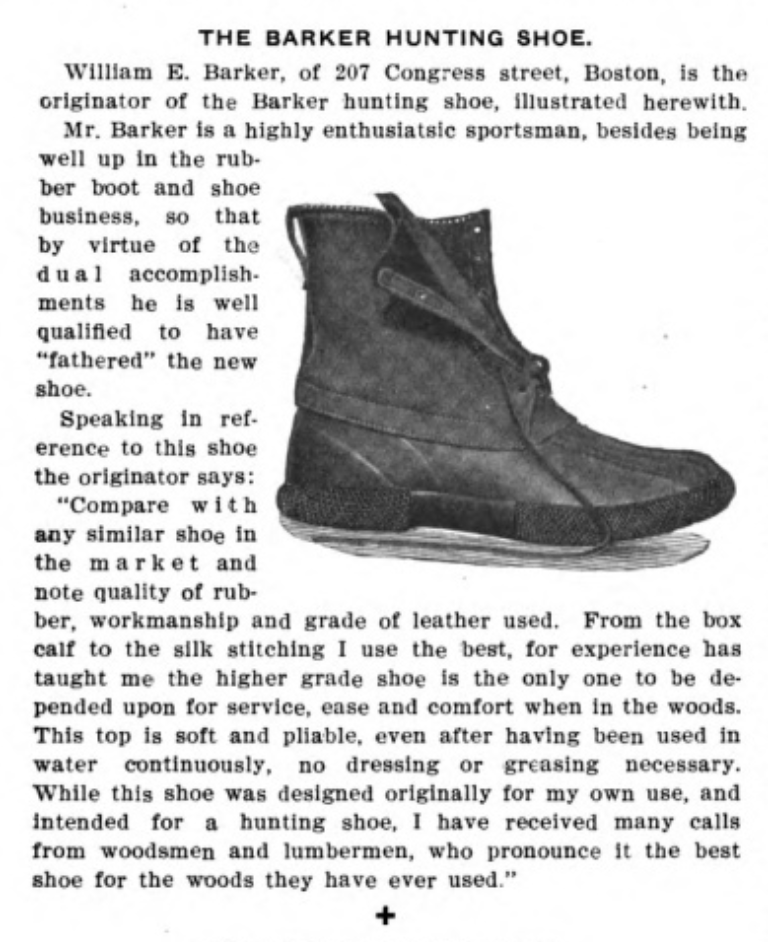
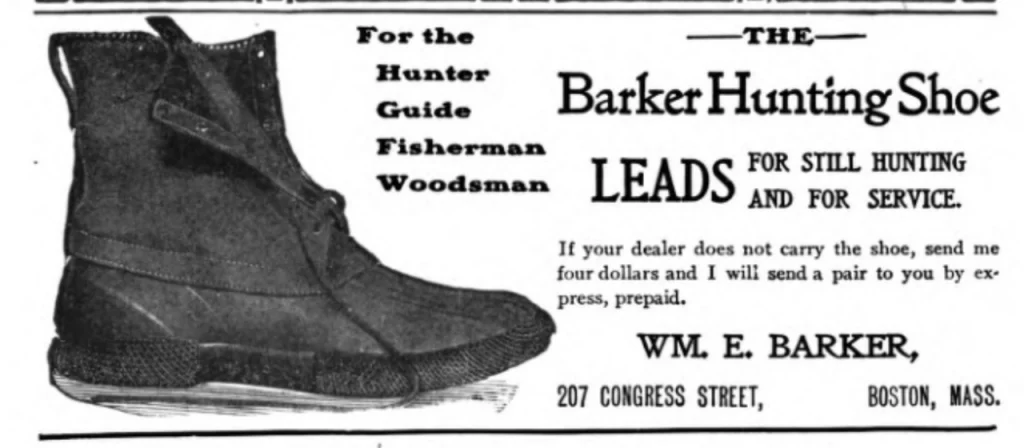
1899:The world’s first ‘Barker Hunting shoe’ with a rubber bottom and leather upper is sold.

The footgear for the tripIs of great Importance . A difference at opinion exists among experienced September campers between the Buck double bottom waterproof moccasin and tho Barker hunting shoe. The latter has much to commend It for wet weather, being a heavy rubber shoe, to which is attached a flexible elkskin upper. The result is a comfortable and practical foot piece well adapted to long cruises, changeable weather and still hunting.
Brooklyn NY Daily Eagle Sep/17/1905
旅の足元は非常に重要す。経験豊富なセプテンバー・キャンパーたちの間では、バック・ダブルボトム防水モカシンとバーカー・ハンティング・シューズの間に意見の相違があります。後者は雨天用で、重厚なラバーシューズに柔軟なエルクスキンのアッパーが取り付けられている。その結果、快適で実用的なフットウェアができあがり、長期のクルーズや変わりやすい天候、そして狩猟に適していると主張している。
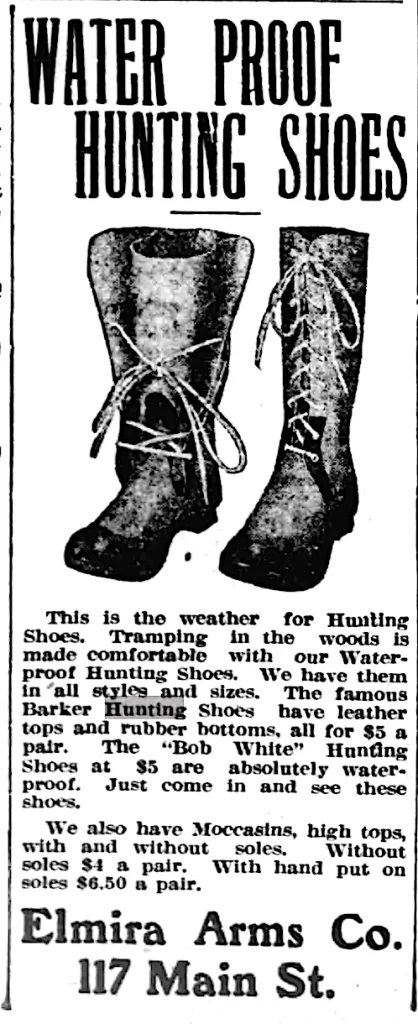
Shoe retailer and boots and shoes weekly. v. 54 (1905)
1911 BAKER HUNTING BOOT
The Barker Hunting Shoe, which has stood the test of more than eleven years of satisfactory service to the hunters, guides, lumbermen and fishermen who have worn it, has all the merits of the soft tanned mocassin, and is waterproof in addition. One decided advantage that will appeal to those who have been using moccasins, is the fact that no greasing or dressing is necessary.even if the shoe has been used in water continuously. This feature will be promptly recognized by all those who have endeavored to use the moccasin under all conditions of wet and dry traveling. No one, with experience in woods travel, can deny the many advantages of the moccasin, as originally designed by our red brothers, and improved upon in many ways since, by the white man. But the moccasin has its limitations, and these do not adequately provide for wet traveling, no matter how much time and care is expended in dressing it with oil or grease preparations. It is at this point of utility that the Barker shoe enters, because of its all- round protection in wet or dry footings. And, for still hunting, where lightness and pliability are essential for quietness, or to secure a firm foot grip on rock or other slippery surfaces, the Barker Hunting Shoe again demonstrates its claim as a favorite shoe for hunting. The uppers of the Barker shoe are made of the finest tan box calf, specially prepared, those tops are silk stitched on pure Para rubber bottoms, which are absolutely waterproof, |ight, warm and noiseless. We suggest that our readers address the manufacturer, William E. Barker, 112 Federal St. Boston, Mass., for a copy of their “What They Say” booklet.
Field and stream. v.15 1910-1911.
バーカー ハンティング シューズは、これを履いたハンター、ガイド、材木業者、漁師に 11 年以上満足のいくサービスを提供するという試練に耐え、柔らかいなめしモカシンの利点をすべて備えており、さらに防水性もあります。モカシンを使用している人にとって魅力的な決定的な利点の 1 つは、靴が水中で継続的に使用された場合でも、グリースを塗ったり、ドレッシングを必要としないという事実です。
この特徴は、濡れた走行や乾燥した走行のあらゆる条件下でモカシンを使用しようと努めたすべての人によってすぐに認識されるでしょう。
森の旅の経験のある人は、モカシンの多くの利点を否定することはできません。モカシンはもともと赤人の兄弟によってデザインされ、その後白人によってさまざまな方法で改良されました。しかし、モカシンには限界があり、オイルやグリースを塗ってどれだけ時間と注意を払っても、濡れた旅行には十分に対応できません。
濡れた足場や乾いた足場でも万能に保護できるバーカー シューズが実用性を発揮するのはこの時点です
。そして、静粛性のために軽さと柔軟性が不可欠な狩猟や、岩やその他の滑りやすい表面でしっかりとした足のグリップを確保するために、バーカー ハンティング シューズは狩猟用のお気に入りの靴としての主張を再び示します。Barker シューズのアッパーは、特別に準備された最高級のタン ボックス カーフで作られており、これらのトップは純粋なパラ ラバーの底にシルク ステッチされており、完全な防水性、耐寒性、暖かさ、そしてノイズレスです。私たちは、読者の皆様に、マサチューセッツ州フェデラル・セント・ボストン 112 にある製造業者 William E. Barker に連絡して、「What They Say」小冊子のコピーを入手することをお勧めします。
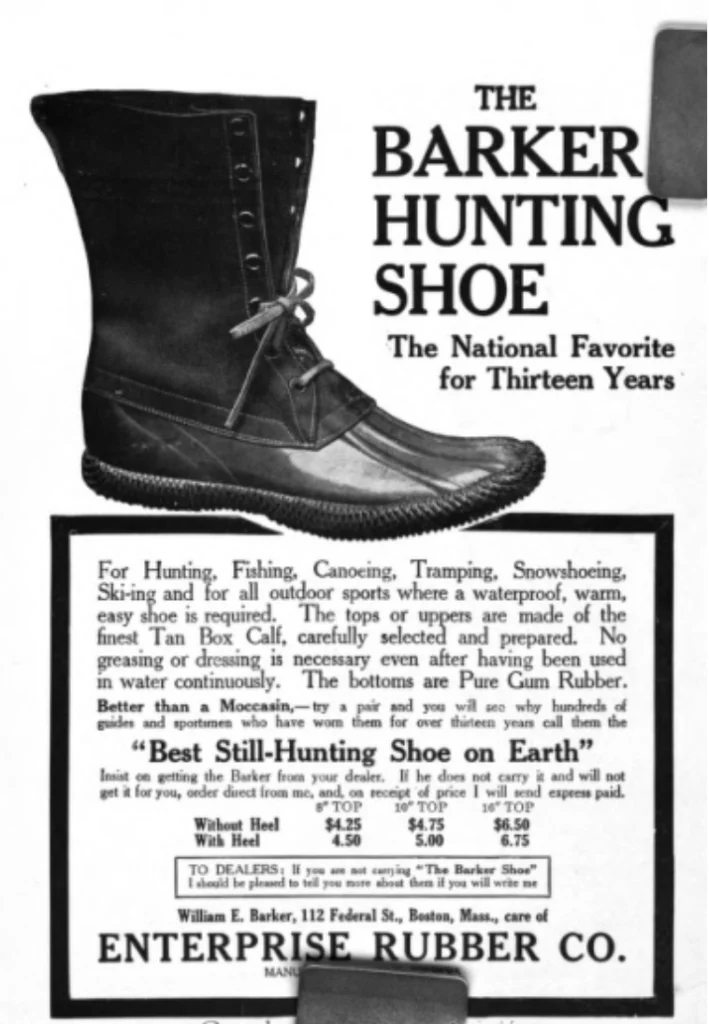
1914 Blaze a New Trail
When the “red gods” call you to the stately pincs to test your wits, skill and physical strength~see that you go well prepared. The tangled underbrush, fallen trees with their short, sharp branches and the strenuous going over
rocky stretches will tax your reserve energy. Watch your feet! You can blaze your trail with greater certainty and with perfect foot-comfort with The BARKER Hunting Shoe
You can be “on the goH from sunrise until sundown with maximum foot comfort—when you wear this perfect still Hunting Shoe. The strong and sturdy uppers of Tan Box Calf support and protect the ankles—the bottoms of pure Para Rubber are long-lived and made for noireless going—silent and as sure-footed as a burro. Light-weight and perfect fitting. Without them your kit is incomplete, your outing more hazardous and your sport not so enjoyable. For men there are two styles in three lengths to choose from—heel and no heel. Women’s are made only with heel and 12inch. top.
8″ Top! 10′ Tops 16′ Tops
Men’s, without Heel, $4.25 $4.75 $6.50
Men’s, with Heel, – 4.50 5.00 6.75
Women’s, with Heel and 12′ Top, – 3.75
If your dealer cannot supply you, I will send a pair Parcel Post upon receipt of check or money order.
WILLIAM E. BARKER
“112 assesses, MASS.Please Mention OUTING When Corresponding With Advertisers “
Outing : sport, adventure, travel, fiction. v.64 1914:Apr.-Sept
バーカー ハンティング シューズは、これを履いたハンター、ガイド、材木業者、漁師に 11 年以上満足のいくサービスを提供するという試練に耐え、柔らかいなめしモカシンの利点をすべて備えており、さらに防水性もあります。モカシンを使用している人にとって魅力的な決定的な利点の 1 つは、靴が水中で継続的に使用された場合でも、グリースを塗ったり、ドレッシングを必要としないという事実です。
この特徴は、濡れた走行や乾燥した走行のあらゆる条件下でモカシンを使用しようと努めたすべての人によってすぐに認識されるでしょう。
森の旅の経験のある人は、モカシンの多くの利点を否定することはできません。モカシンはもともと赤人の兄弟によってデザインされ、その後白人によってさまざまな方法で改良されました。しかし、モカシンには限界があり、オイルやグリースを塗ってどれだけ時間と注意を払っても、濡れた旅行には十分に対応できません。
濡れた足場や乾いた足場でも万能に保護できるバーカー シューズが実用性を発揮するのはこの時点です
。そして、静粛性のために軽さと柔軟性が不可欠な狩猟や、岩やその他の滑りやすい表面でしっかりとした足のグリップを確保するために、バーカー ハンティング シューズは狩猟用のお気に入りの靴としての主張を再び示します。Barker シューズのアッパーは、特別に準備された最高級のタン ボックス カーフで作られており、これらのトップは純粋なパラ ラバーの底にシルク ステッチされており、完全な防水性、耐寒性、暖かさ、そしてノイズレスです。私たちは、読者の皆様に、マサチューセッツ州フェデラル・セント・ボストン 112 にある製造業者 William E. Barker に連絡して、「What They Say」小冊子のコピーを入手することをお勧めします。
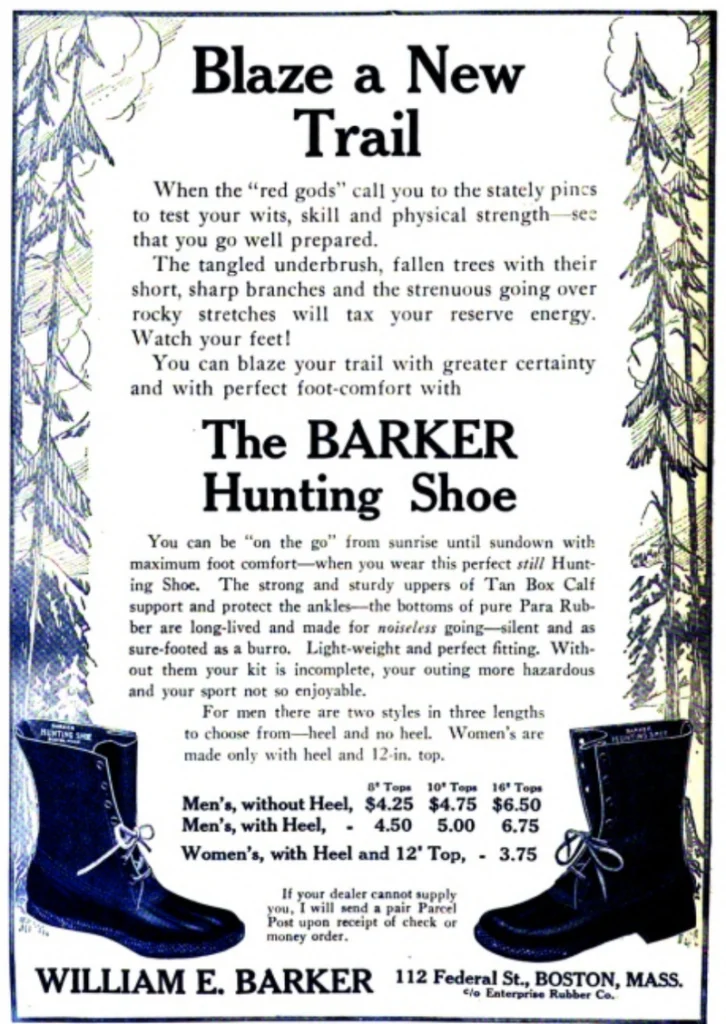
We must be aware that we are only seeing the history of the winners. However, it is worth respecting that they still continue to manufacture it in the USA and remain a great American brand. Unfortunately, the number of products made in the USA is extremely low, but we can only hope that it will continue for as long as possible.
私たちはあくまでも勝者の歴史を目にしているだけであることを認識しておかなければならない。ただし彼らがいまだにそれをアメリカで製造を続けており、偉大なアメリカのブランドであり続けているのことは尊敬に値する。残念ながらアメリカ製の商品は極端に減っているが少しでも長くそれが続くことを我々は願ってやまない。
SHIRT TAG FROM 1920s
1912-20s
1912
1912: Leon Leonwood Bean begins selling the Maine Hunting Shoe through direct mail.Tired of returning from hunting trips with cold, wet feet, Leon Leonwood (“L.L.”) Bean (1872–1967) designed a new type of boot that combined lightweight leather tops with waterproof bottoms. In 1912, the success of his practical footwear launched a company with annual sales that reached more than $1 billion by the end of the twentieth century.
1917
Undaunted by this failure, Bean went to Boston. With a $400 loan, he persuaded the United States Rubber Company to help him improve the quality and usefulness of the shoe. Bean then began selling the product with confidence. He sold enough shoes that by 1917, he was able to move his business to the main street of Freeport, Maine. He employed people to cut and stitch the shoes. The following year, he applied for and received patents on his product from both the United States and Canada. In a happy coincidence, Bean began selling his product at the same time the United States Post Office launched it parcel post service. When Bean’s brother became postmaster in Freeport, Maine, Bean opened his factory on the floor above the post office.
1920
Bean’s name spread during the 1920s, due to word-of-mouth as well as print advertising and the founder’s continuing innovations. In 1920 Bean opened a showroom store adjacent to his workshop, in accession to the demands of visitors. In 1922 Bean reengineered the Maine Hunting Shoe by adding a split backstay to help eliminate chafing. Within two years, sales rose to $135,000 annually. In 1923 the company received welcome publicity when its boots were used to outfit the Macmillan Arctic Expedition. Two years later, the first full-sized catalog was mailed, featuring nonshoe apparel and sporting gear for the first time In 1920 he constructed a store located on Main Street in Freeport.
1922
In 1922 Bean reengineered the Maine Hunting Shoe by adding a split backstay to help eliminate chafing.
1924
By the 1920s, L.L. Bean was earning a reputation among sportsmen as the best outfitter for camping, hiking, hunting, and fishing. In addition to a wide range of sturdy apparel, the company also began selling equipment, including canoes, tents, and fishing rods. The items were sold through the L.L. bean catalog or in the company store, which opened on Main Street in 1920. Bean’s little mail-order company was a hit in Freeport and beyond, and the firm employed two dozen full-time workers by 1924.The success of Bean’s business strategy is reflected in the increase in profits between 1924 and the 1960s. In 1924, the company had been operating for 12 years, had twenty-four employees on its payroll, and posted $135,000 in sales for the year. In 1937, sales of $1 million were recorded. By 1950, the company had more than 100 employees and achieved sales of nearly $2 million. By 1964, sales reached $3 million and profits were $70,000. However, despite the considerable profits, Bean was opposed to expansion, fearing that his customers would dislike change and its implied loss of personal customer service.Bean had a knack for creating items that became iconic. This has remained a strange and consistent hallmark for such a particularly “unfashion” brand. 1924 saw the release of its iconic canvas field coat, originally marketed as a “Maine Duck Coat” to accompany the boots. In the late ’20s, the Chamois shirt—L.L. Bean’s signature shirt—was rolled out. In 1934, the company would release the leather duffle bag that would become standard issue for collegiate and young adult travelers across America. In 1944, L.L. Bean produced an “ice bag” which later became known as a “tote,” and launched an enduring item into the wider American wardrobe. These items all remain iconic symbols of L.L. Bean to this day.
1925
First full-sized catalog is mailed out, featuring nonshoe apparel and sporting gear. By 1925, with hand knit stockings and other associated items (such as shoelaces) added to his product line, Bean employed 25 people in his operation, and yearly sales had reached $135,000.
1927
The catalog expanded again in 1927, adding fishing and camping equipment to the Bean line.

LL Bean Catalog FALL 1926

LL Bean Catalog FALL 1927

LL Bean Catalog FALL 1928
1930s
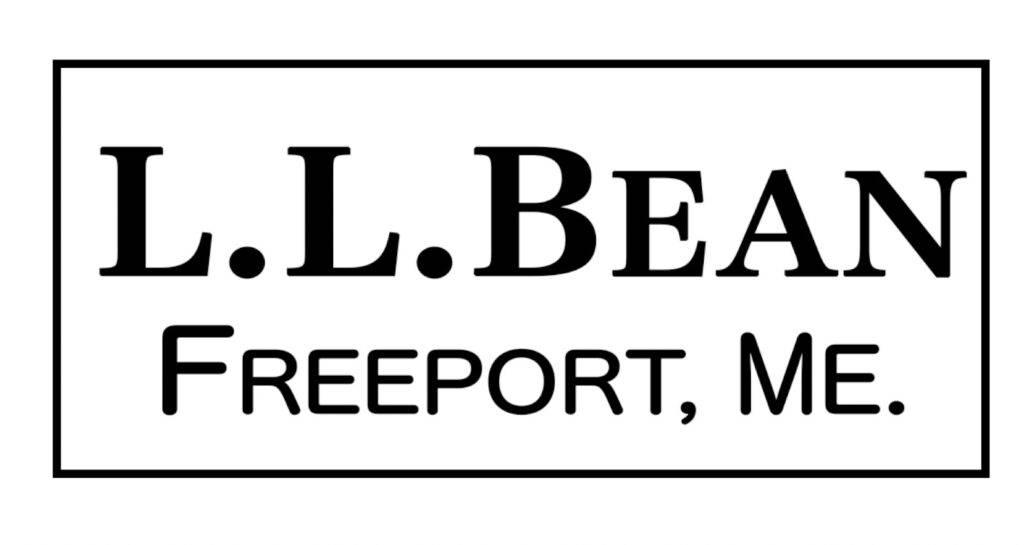
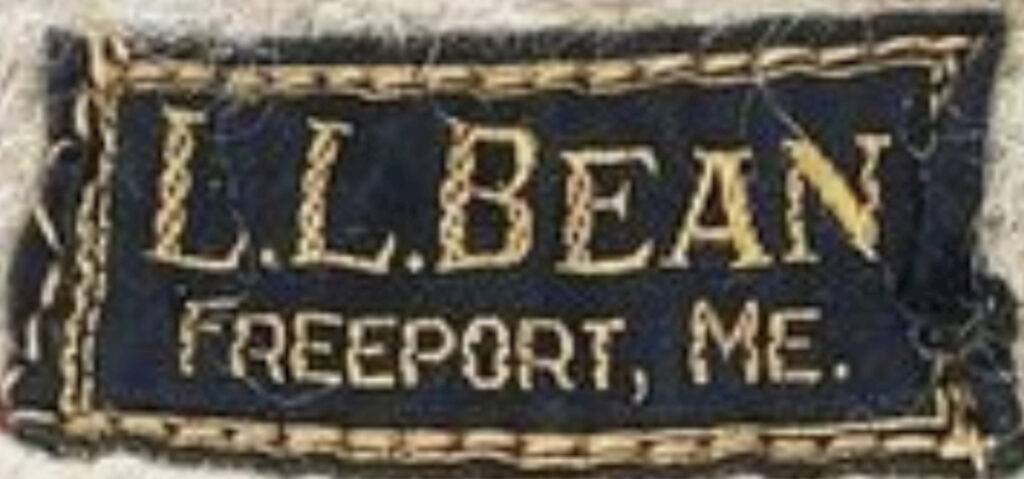
To be precise, there is no proof that this name tag is the oldest tag. It is only a guess. This is because the word “inc(incorporated”)”, which appears later in the catalogue, only appeared from 1936, and until then it was only “l.l.bean.MFG(Manufacture)”. However, the waistcoats with this tag are not that old, and in fact it is unclear whether this tag was really used in the early days of the company. It should be added that the later name tag tags with “INC.” on them were certainly used from the 1930s onwards, so they may have been used in parallel in the 1930s, depending on what was being manufactured.
このネームタグが最古であるという確証は残念ながらありません。単なる推測になります。というのもカタログに出てくる「inc(incorporated)」という単語は1936年以降にしか登場せず、それまでは”l.l.bean.MFG(Manufacture)”だけだったからです。しかし私の確認した限りこのタグの付いたハンティングベストはそれほど古くな異様に感じられ実際にはこのタグが創業期に実際に使用されていたかどうかは明らかではありません。また、1936年のネームタグにはカタログにも確かに「INC.」が付いており、1930年代には製造品目によっては併用されていた可能性があります。
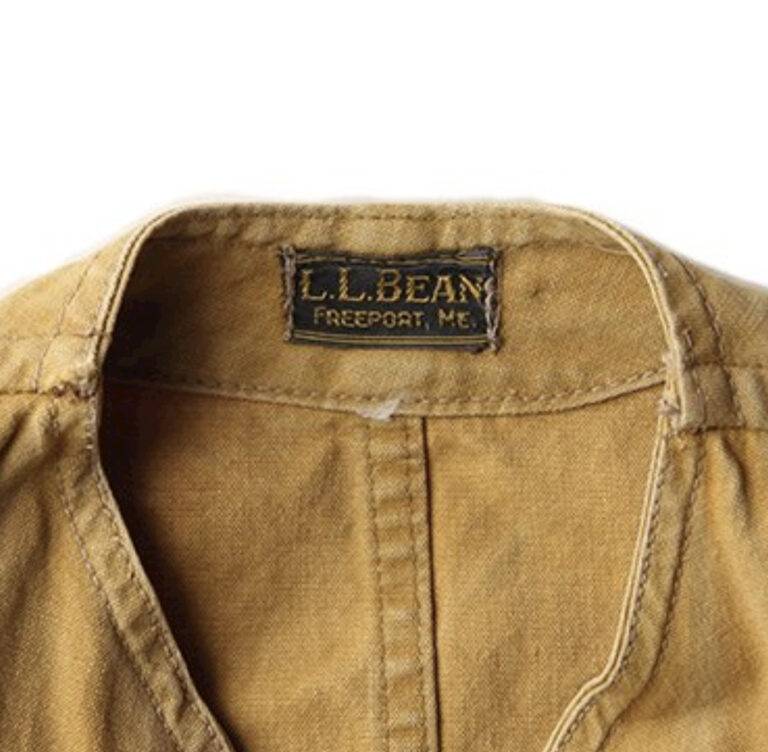

1933
Eleanor Roosevelt made a surprise visit to the L.L.Bean store in Freeport, Maine. The First Lady was a tough sell, resisting the temptation to buy fishing boots for her husband, President Franklin D. Roosevelt. However, L.L.Bean wouldn’t let her leave empty-handed, and presented her with a trout knife for the President.
1934
Bean had a knack for creating items that became iconic. This has remained a strange and consistent hallmark for such a particularly “unfashion” brand. 1924 saw the release of its iconic canvas field coat, originally marketed as a “Maine Duck Coat” to accompany the boots. In the late ’20s, the Chamois shirt—L.L. Bean’s signature shirt—was rolled out. In 1934, the company would release the leather duffle bag that would become standard issue for collegiate and young adult travelers across America. In 1944, L.L. Bean produced an “ice bag” which later became known as a “tote,” and launched an enduring item into the wider American wardrobe. These items all remain iconic symbols of L.L. Bean to this day.
1930s
The oldest currently identifiable name tag for shirts is made up entirely of uppercase letters, although it is similar to later non-written letters. Another significant feature is the gold lettering on a black background. However, it was also used for other items, such as hunting coats, in addition to shirts, so it is assumed that this was the standard tag of the time. (However, other tags for shirts can also be identified).
PS : No INC is listed on the Maine guide shirt, which basically confirms that it is first without INC and later with INC. (This can be confirmed in the 1933-38 catalogue).
現在確認できる最古のシャツ用ネームタグは、後の筆記体以降のものに似ているものの、すべて大文字で構成されています。もう一つの重要な特徴は、黒い背景に金色の文字が施されていることです。しかし、シャツ以外にもハンティングコートなどのアイテムにも使用されていたため、これが当時の標準的なタグだったと考えられています。(ただし、他のシャツ用タグも確認することができます)。
追記 : メインガイドシャツには「INC」が記載されていないため、最初は「INC」なしで、後に「INC」が付いていたことが確認されます。これは、1933年から1938年のカタログで確認できます。
1937
Despite the Great Depression, L.L.Bean sales topped $1 million. In fact, L.L.Bean didn’t just survive the Depression, it thrived. The company’s success was due in part to its focus on durability, as well as the growing popularity of paid vacations and outdoor recreation.
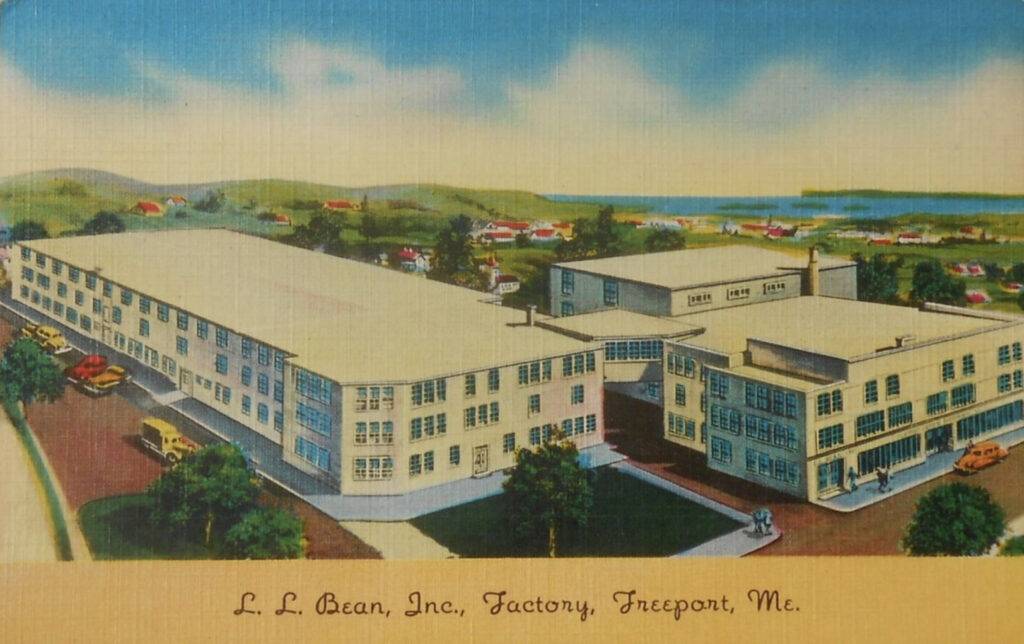
1930s POST CARD FACTORY FREEPORT ME
1930s-40s


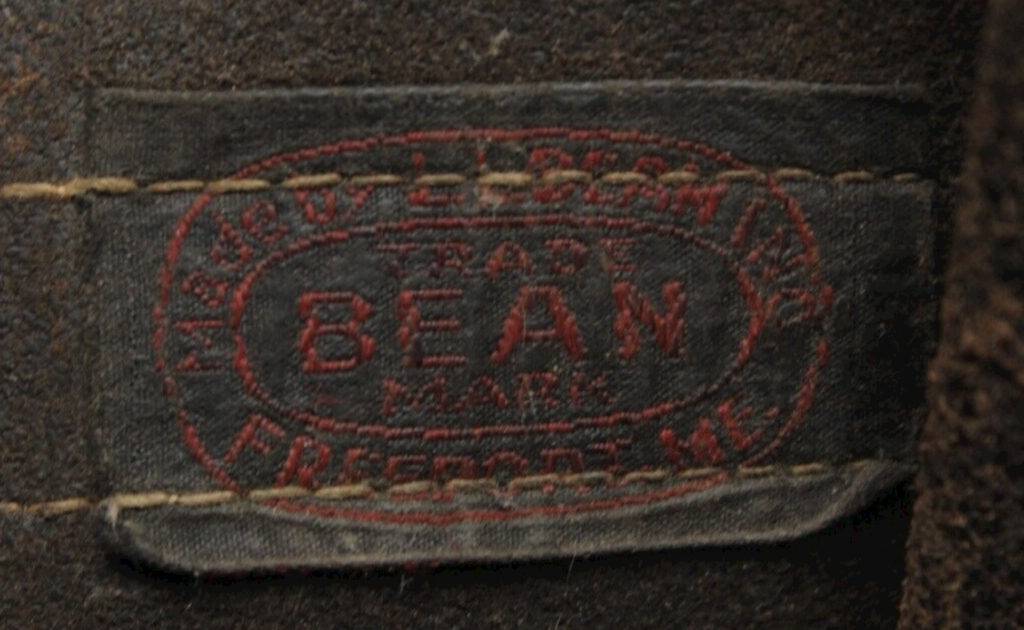
Leather goods have their own name tags, such as Maine hunting boots, bags, and pouches. Shirts and other clothing continue to use tags with gold embroidered text on a black background.
革製品のメインハンティングブーツ、バッグ、ポーチなど、独自のネームタグがあります。シャツやその他の衣類は、黒い背景に金色の刺繍文字のタグを使用し続けています。
1944
Bean had a knack for creating items that became iconic. This has remained a strange and consistent hallmark for such a particularly “unfashion” brand. 1924 saw the release of its iconic canvas field coat, originally marketed as a “Maine Duck Coat” to accompany the boots. In the late ’20s, the Chamois shirt—L.L. Bean’s signature shirt—was rolled out. In 1934, the company would release the leather duffle bag that would become standard issue for collegiate and young adult travelers across America. In 1944, L.L. Bean produced an “ice bag” which later became known as a “tote,” and launched an enduring item into the wider American wardrobe. These items all remain iconic symbols of L.L. Bean to this day.
1945
With the United States embroiled in World War II (1939-45), L.L. Bean contributed to the war effort by designing and manufacturing boots for the country’s servicemen overseas. Different boot models, all based on the company’s original waterproof Maine Hunting Shoe, were shipped to military posts. After the victorious end of the war in 1945, America was a happy, prosperous place, with growing families spending more than ever on recreational goods.
1950
The success of Bean’s business strategy is reflected in the increase in profits between 1924 and the 1960s. In 1924, the company had been operating for 12 years, had twenty-four employees on its payroll, and posted $135,000 in sales for the year. In 1937, sales of $1 million were recorded. By 1950, the company had more than 100 employees and achieved sales of nearly $2 million. By 1964, sales reached $3 million and profits were $70,000. However, despite the considerable profits, Bean was opposed to expansion, fearing that his customers would dislike change and its implied loss of personal customer service.
How the L.L.Bean Boat and Tote Became America’s Bag
The success of Bean’s business strategy is reflected in the increase in profits between 1924 and the 1960s. In 1924, the company had been operating for 12 years, had twenty-four employees on its payroll, and posted $135,000 in sales for the year. In 1937, sales of $1 million were recorded. By 1950, the company had more than 100 employees and achieved sales of nearly $2 million. By 1964, sales reached $3 million and profits were $70,000. However, despite the considerable profits, Bean was opposed to expansion, fearing that his customers would dislike change and its implied loss of personal customer service.
L.L.Beanボート・アンド・トートは、世界中の人々に愛される、時代を超越した万能なバッグです。1944年に、ブロック状の氷を販売店から家庭用の氷箱に運ぶための丈夫なバッグとして、L.L.Beanアイス・キャリアとして最初に発売されました。
20年間カタログから姿を消した後、1965年にL.L.Beanボート・アンド・トートとして復活しました。航海をイメージした赤と青の色使い、背が高くスリムなデザインは、すぐにニューイングランドの海辺の生活の象徴となりました。時を経て、ボート・アンド・トートはL.L.Beanのトップセラーアクセサリーとなり、さまざまな色、サイズ、モデル(オープン・トップとジップ・トップ)が用意されています。耐久性、汎用性、そして時代を超越したスタイルで知られています。今日でも、ボート・アンド・トートは、L.L.Beanのメイン州にある自社工場で熟練の縫製工によって製造されています。本物のL.L.Beanトートの特徴は、底面に施されたV字型の留め具です。これは、特徴的なデザインディテールであり、バッグの補強にもなっています。L.L.Beanボート・アンド・トートは、75年以上にわたってアメリカ文化の一部であり、真にアイコニックなバッグです。食料品の買い物からビーチグッズの運搬まで、あらゆる用途に使用できる汎用性と耐久性を備えています。また、ドレスアップにもダウンにも使えるスタイリッシュなバッグです。
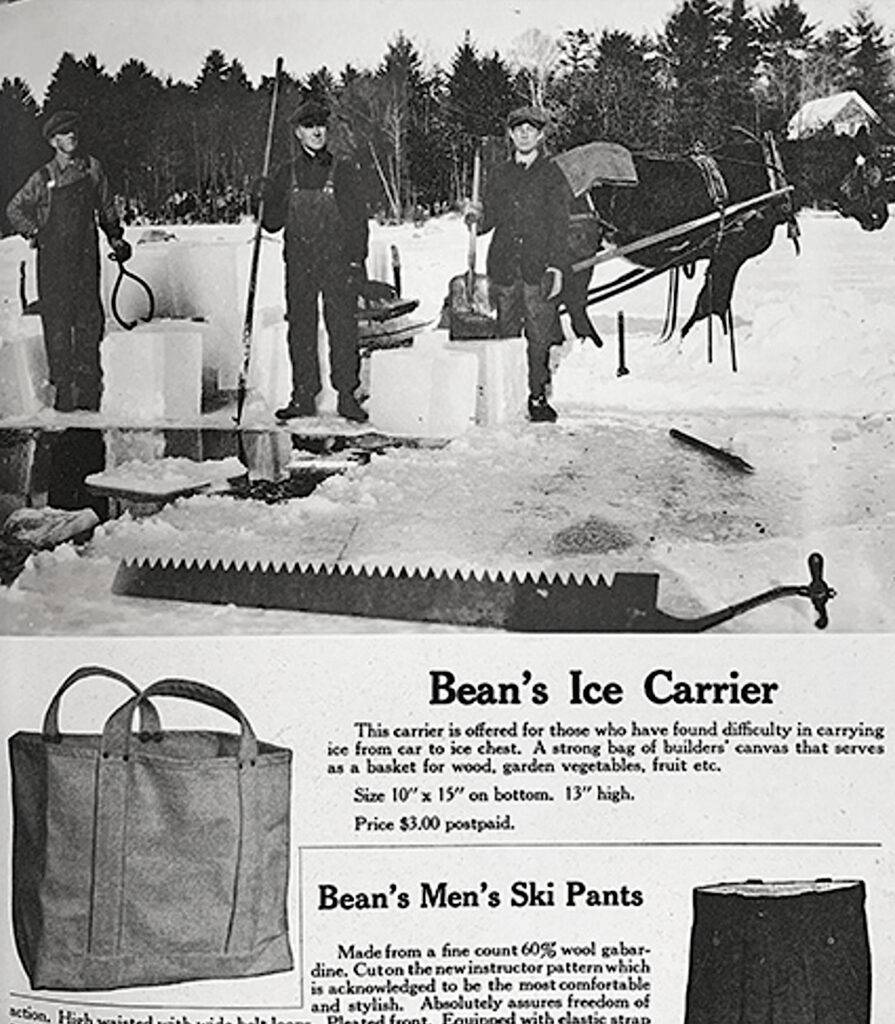
1944 L.L.Bean Ice Carrier
1950s-60s
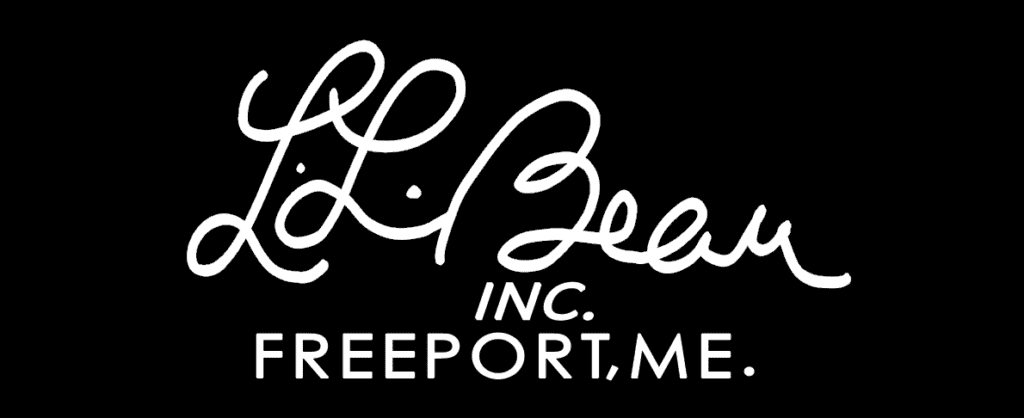
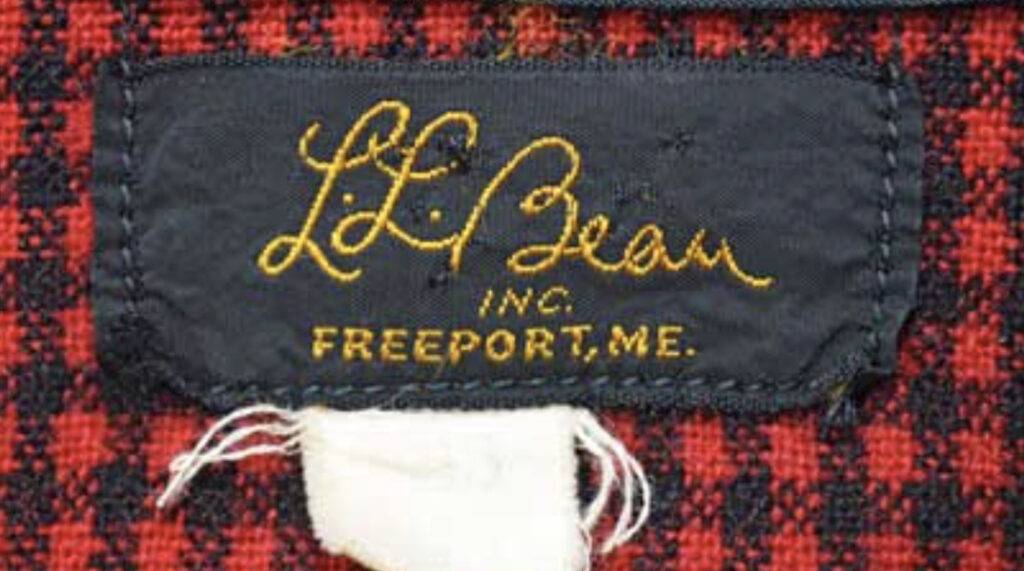
It is generally accepted that the black written “l.l.bean” signature name tag is older, but the catalogue shows that the timing of its appearance was not that different. Also, depending on the model, it seems to have been white or black (but there may be a difference of one to two years that cannot be confirmed), but it can be confirmed that this tag itself was used for a long time, especially on the ‘chamois cloth shirt’ representing L.L.BREN until 1964.
一般的には、黒地に金文字で “l.l.bean” と書かれたサイン入りネームタグの方が古いと考えられているが、カタログによると、その登場時期はそれほど変わらないようだ。またモデルによっては黒地か白地を使い分けしていたようだが(ただし、確認できない1〜2年の差がある可能性がある)このタグ自体が長期間使用されていたことは確かであり特にL.L.Beanを代表する「CHAMOIS CLOTH SHIRT」に(1955年にカタログ新ロゴタグ登場)1964年まで使用されていたことが確認できる。
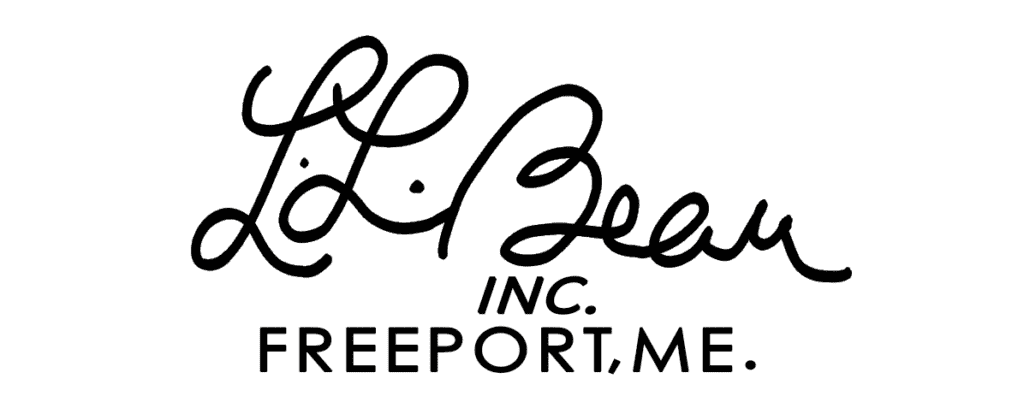
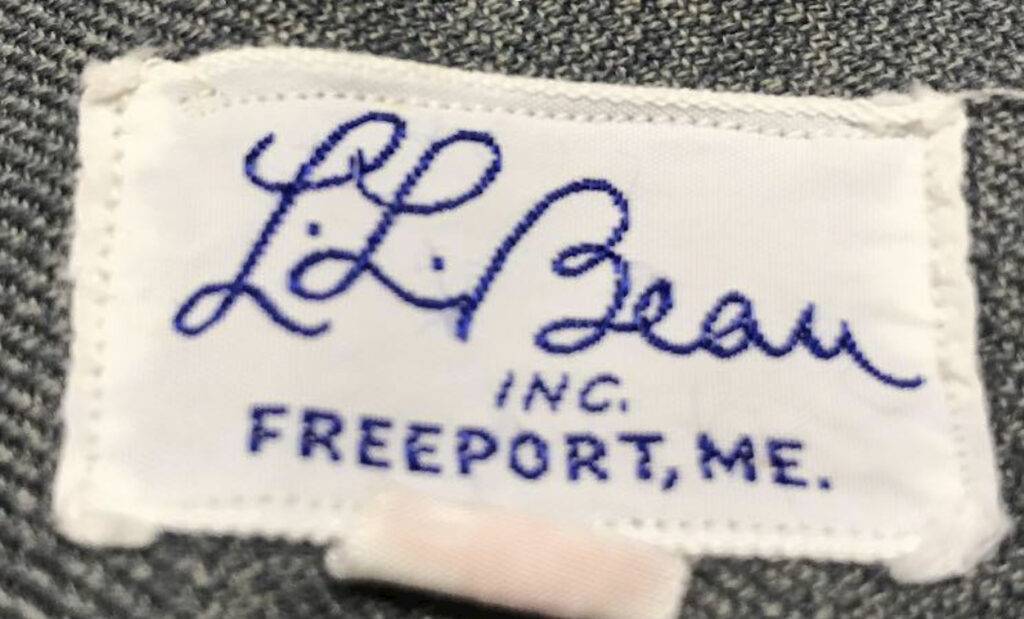
I think the written “l.l.bean” signature name tag was most likely created for the 40th anniversary in 1952. In fact, the black name tag from 1953 and the white name tag from 1956 confirm that items with this written tag are from the 1950s onwards. The black tag does not appear to be late 50s as some people believe.
私の考えでは、黒地に白文字で “l.l.bean” と書かれたサイン入りネームタグは、1952年の創業40周年を記念して作られたものと推測しています。実際、1953年には黒いネームタグが、1956年には白いサイン入りネームタグが使用されたことが確認できています。黒いタグは一部の人が言うように1950年代後半のものではないようです。
1951
In 1951 Bean, still at the helm as he approached 80, announced that the Freeport retail store would begin operating 24 hours a day, 365 days a year. Another important innovation during this decade was the introduction in 1954 of a women’s department. Yet, despite the now famous Bean name, as the company entered the 1960s its sales volume was not as high as might have been expected. Pile asserts that ‘dark clouds loomed on the horizon as [Bean] became older. … No longer did sales increase 25 percent or more each year; dollar volume actually began to flatten. Merchandise in the catalog and in the store was no longer up-to-the-minute and, even worse, orders were being slowly filled by part-time people who had little interest in doing the best possible job.’ The downhill course the company appeared to be on was steepened by the inception of other sports specialty marketers. This course was altered, however, following Bean’s death in 1967 when ownership of the company fell to the Bean heirs. Only one was interested in management: Leon A. Gorman, grandson of the founder.
1954
A women’s department opens at the Freeport retail store.By the beginning of the 1950s, the L.L. Bean store on Main Street was open twenty-four hours a day and the company employed one hundred people to service customers whenever they might need a fishing lure, waterproof boot, or hunting license. These patrons, mostly men but also a growing number of women, helped the company’s sales climb to $2 million in 1951. To address the increasing number of its women fans, L.L. Bean created a department just for them in 1954. During World War II, times would have been tough for the company had the military not allowed Bean to design their boots. Continuing to grow and add products, L.L. Bean began staying open 24-hours-a-day in 1951. The company furthered its growth by adding a women’s department store in 1954.
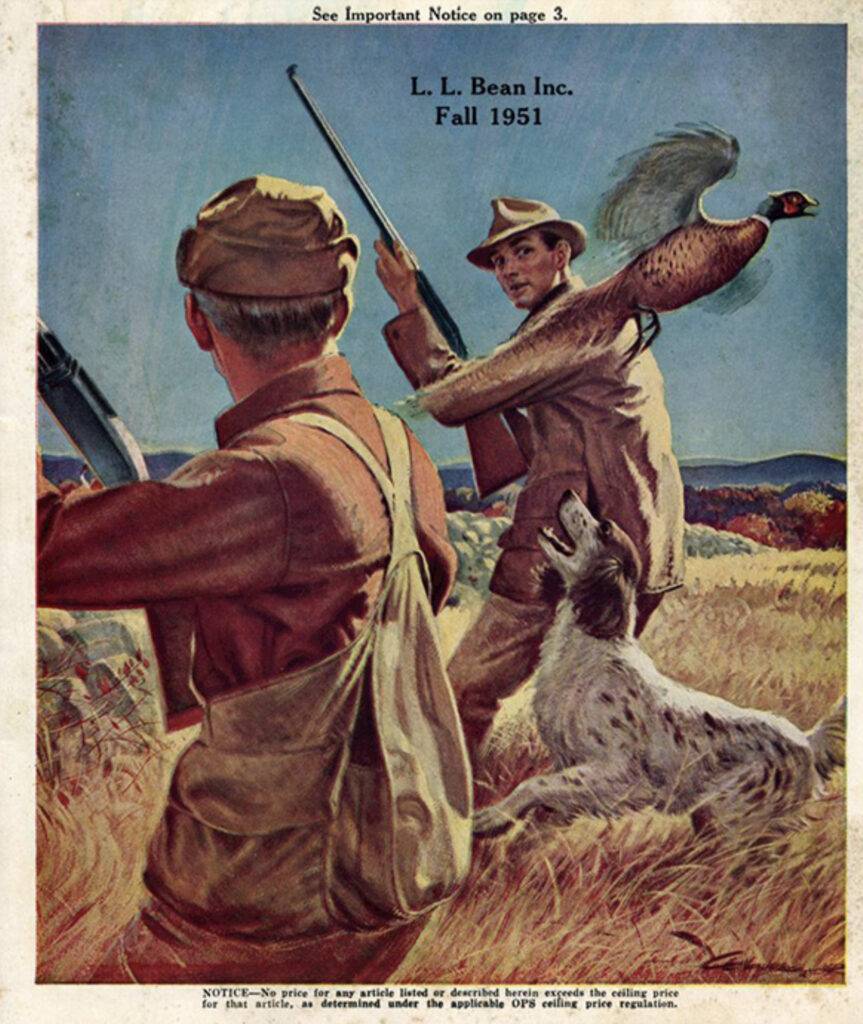
1951 FALL LL Bean

1952 FALL LL Bean

1953 SPRING LL Bean
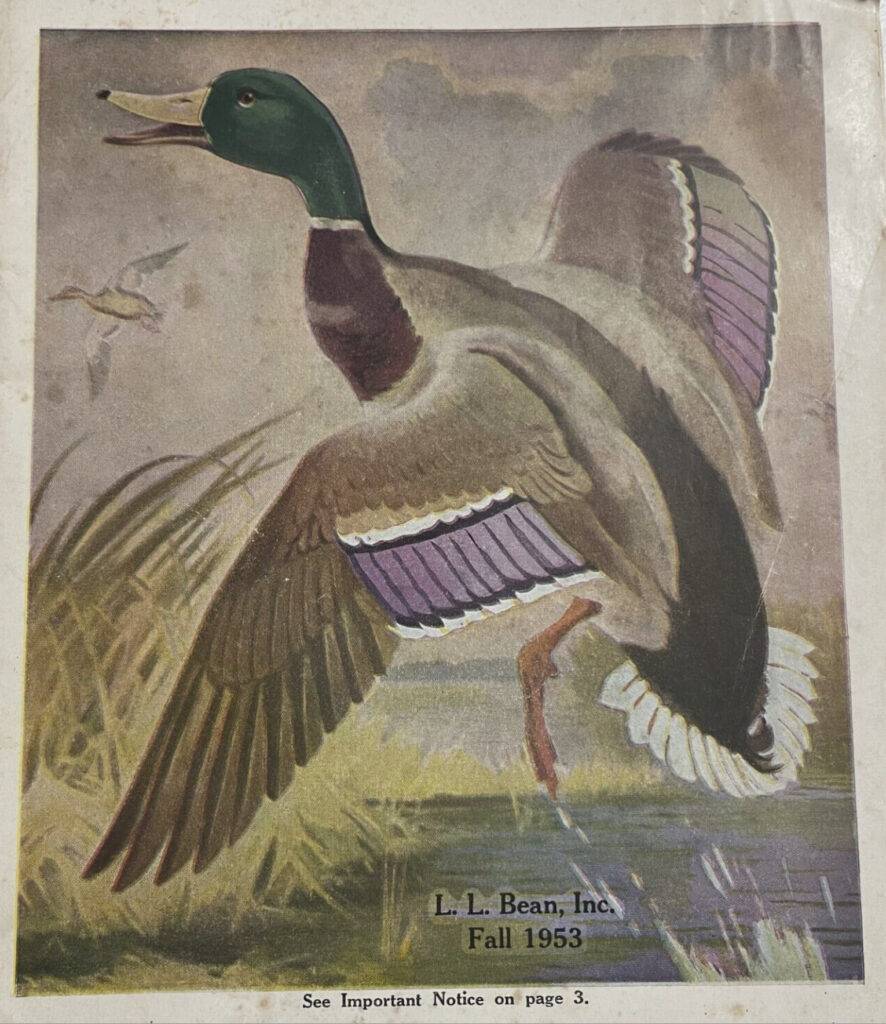
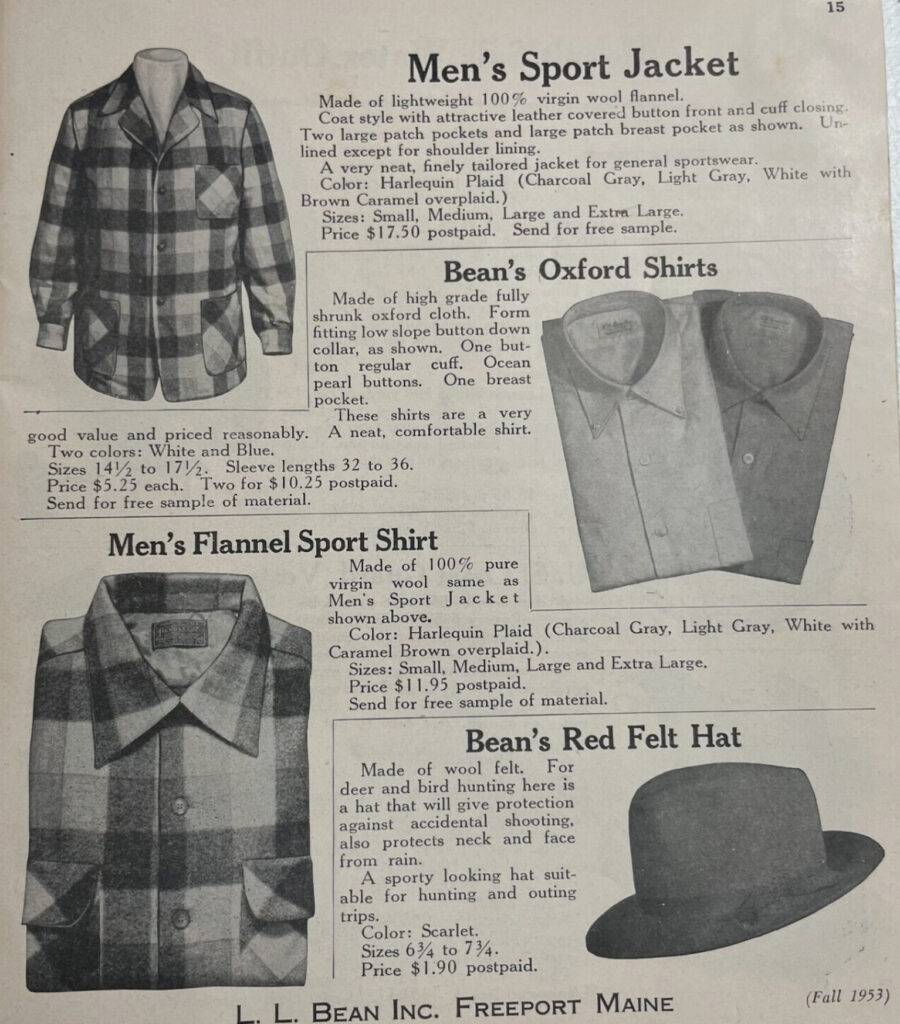
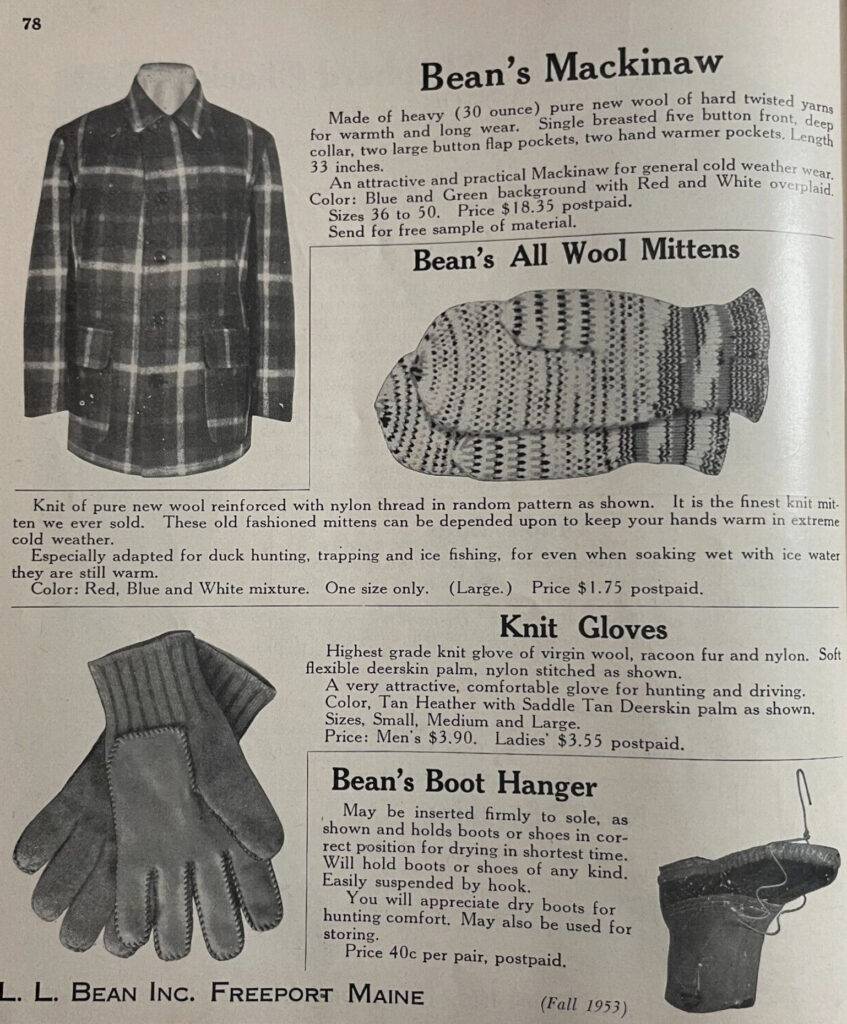

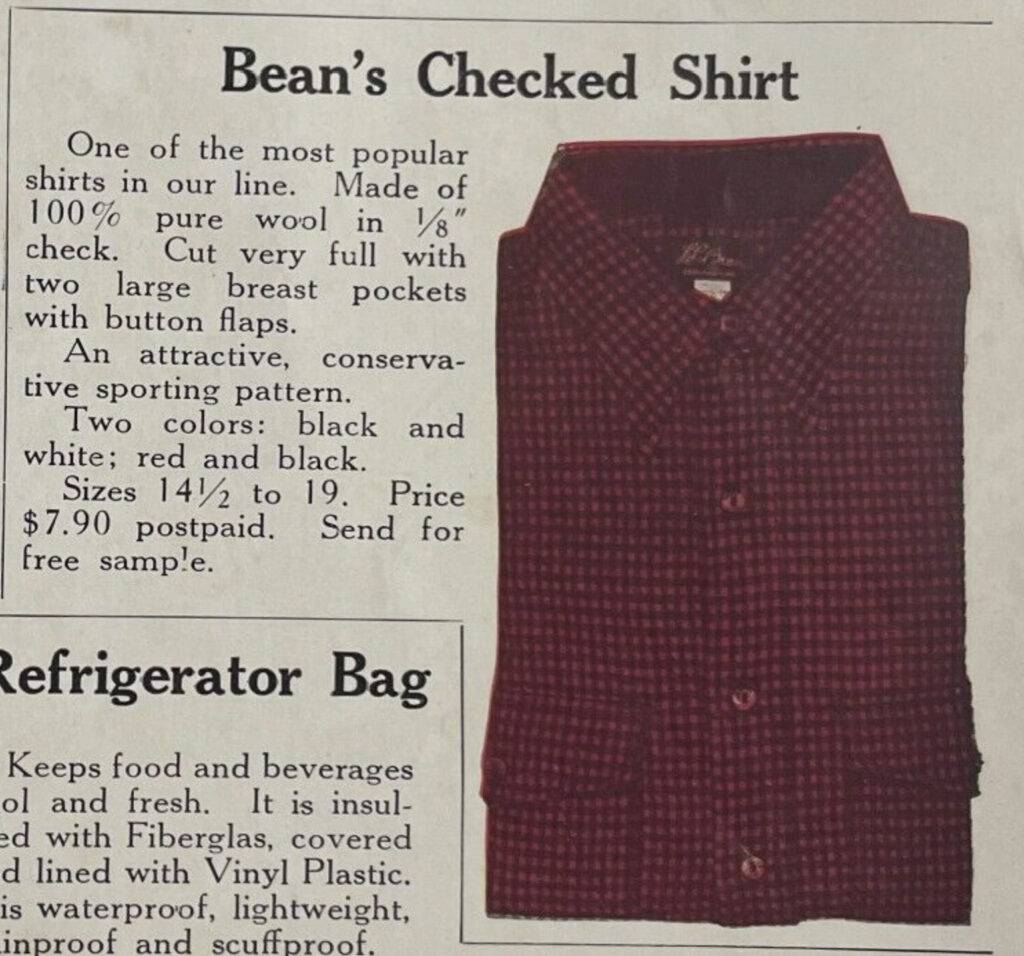
1953 FALL LL Bean
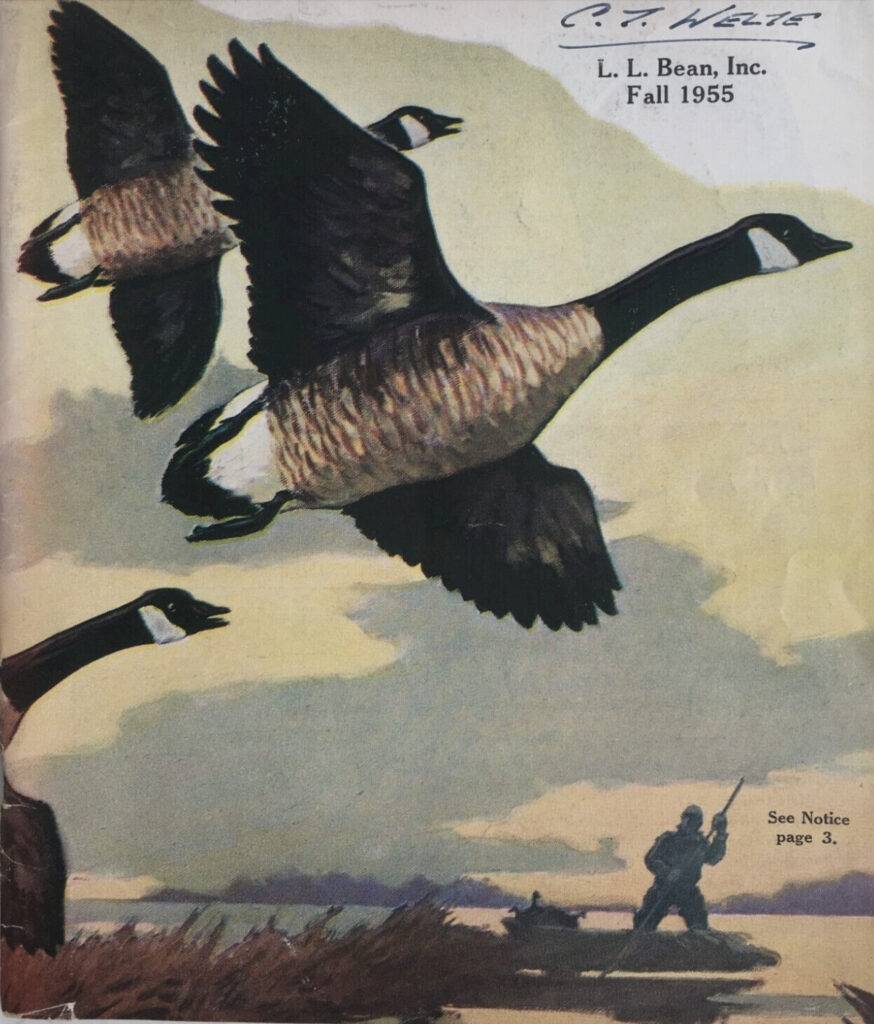
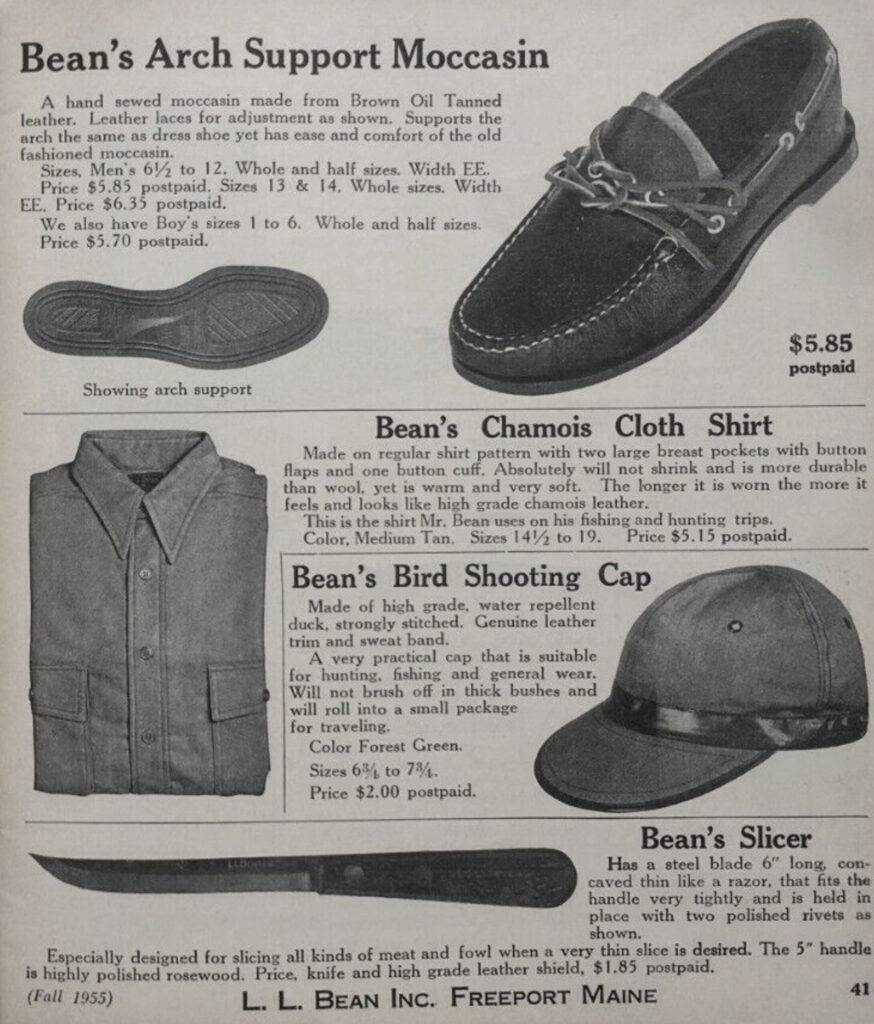
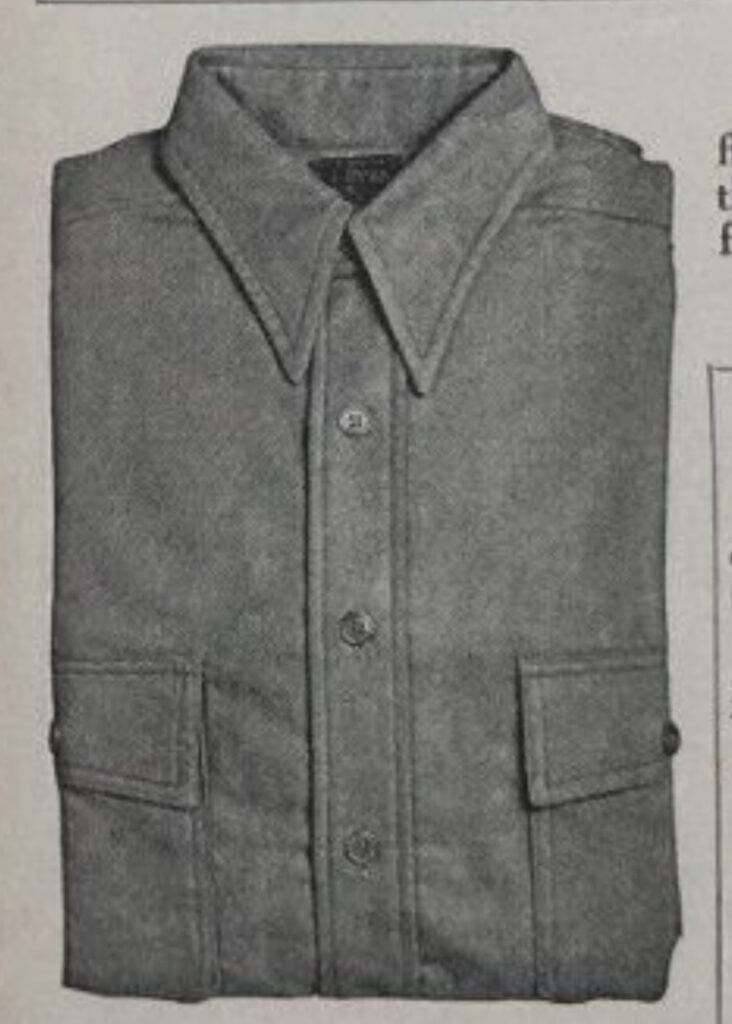

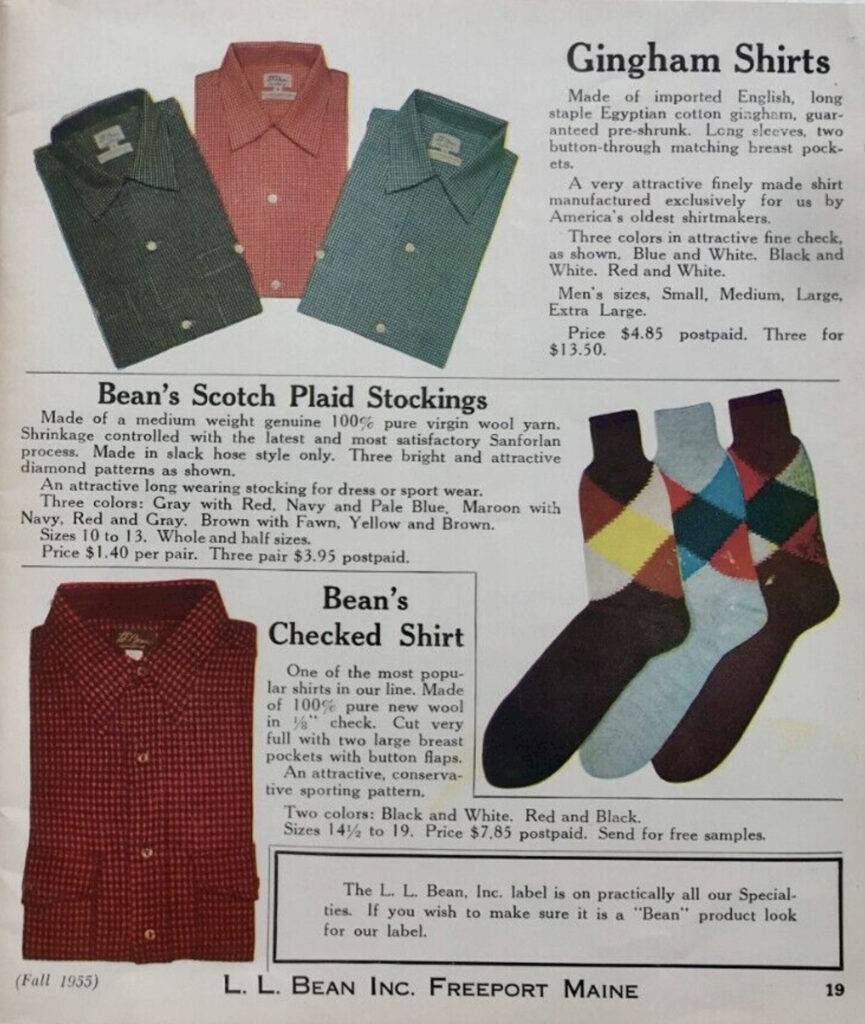
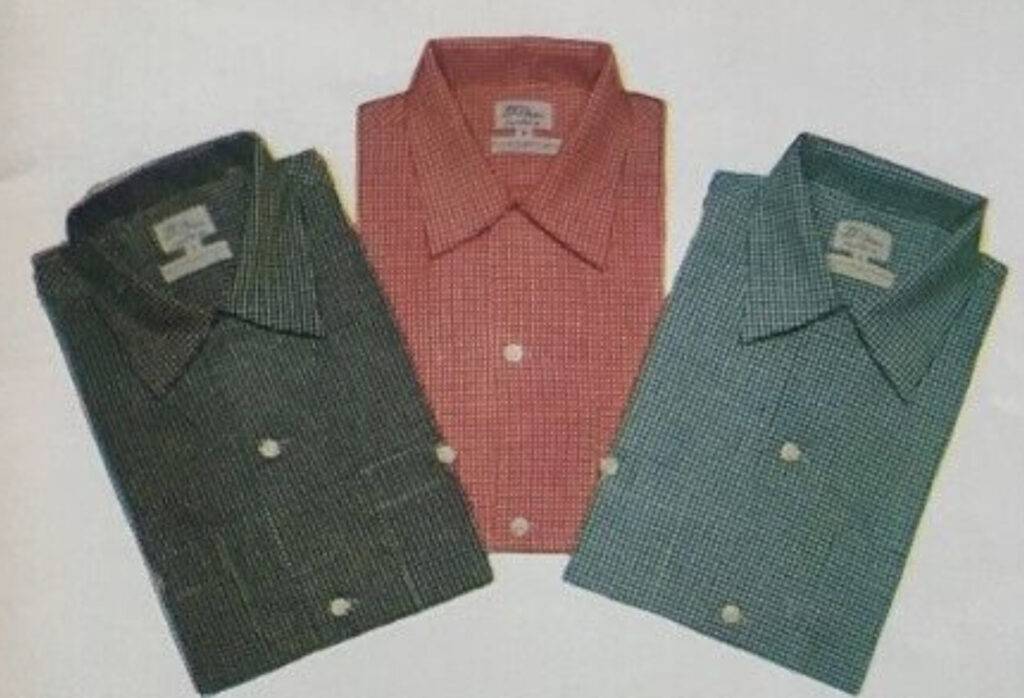
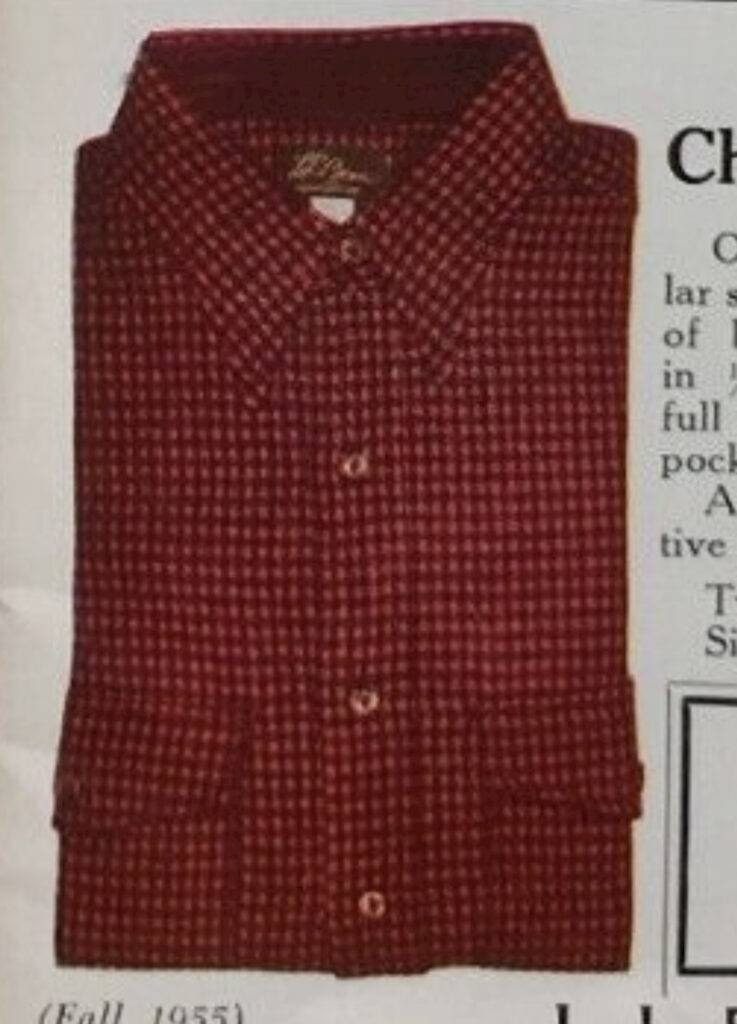
1955 FALL LL Bean
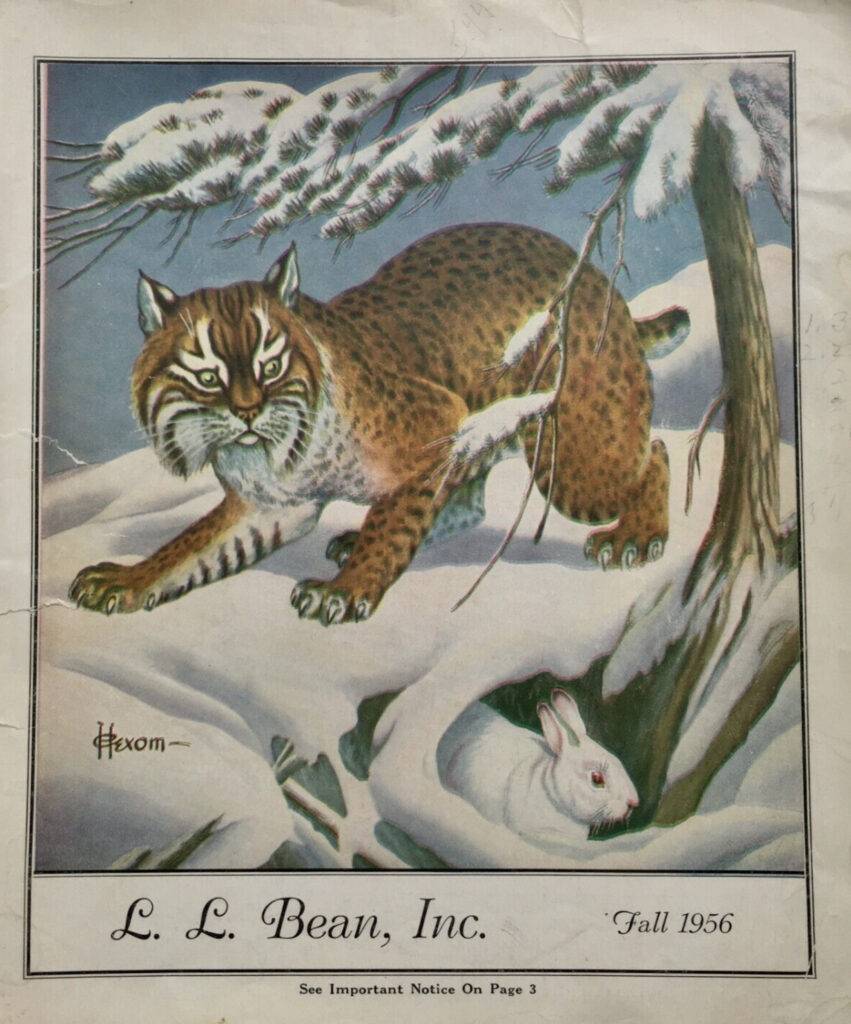
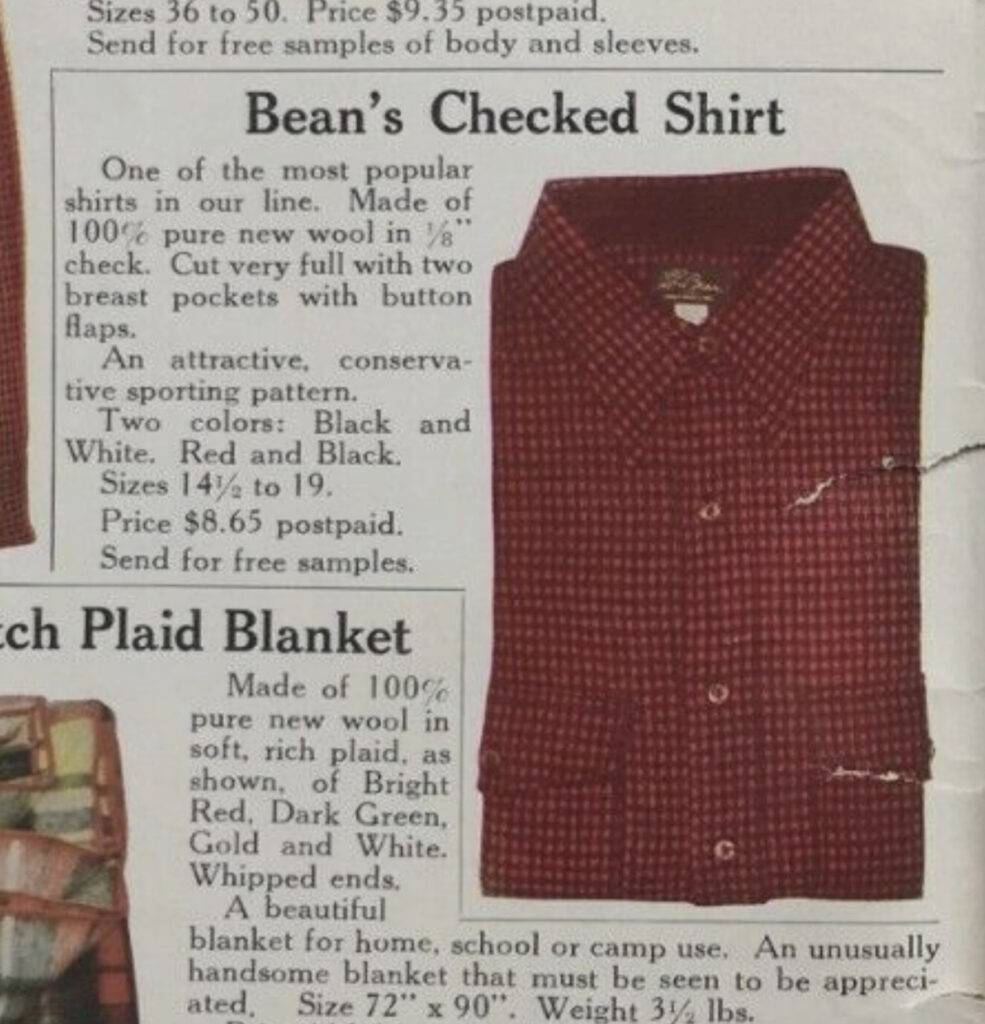
1956 FALL LL Bean
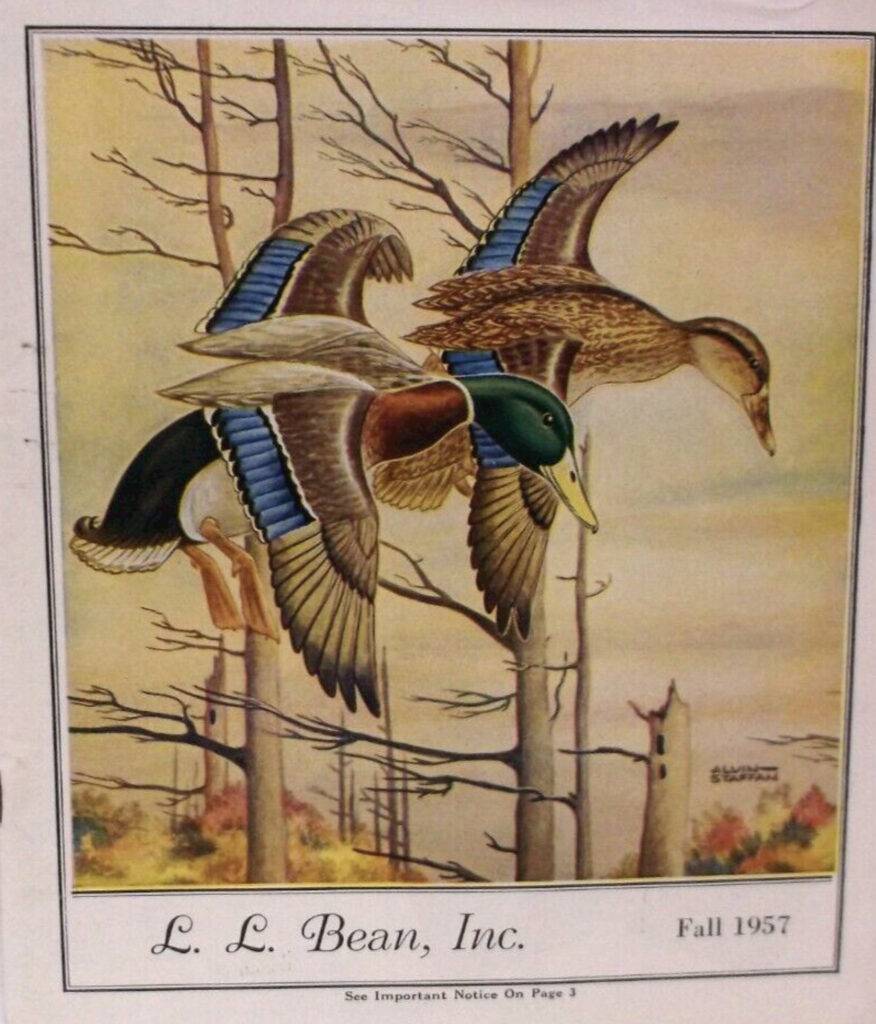
1957 FALL LL Bean

1959 SPRING LL Bean
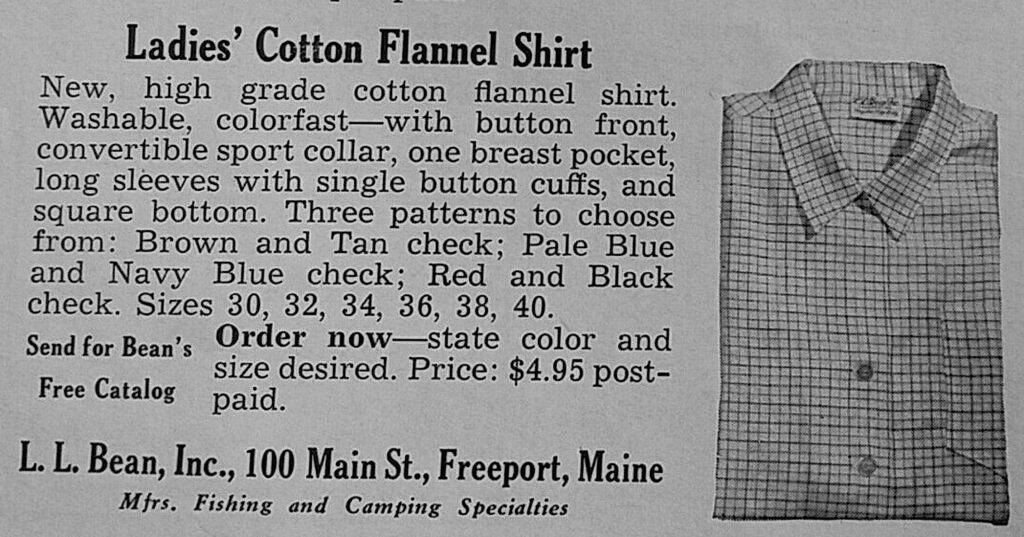
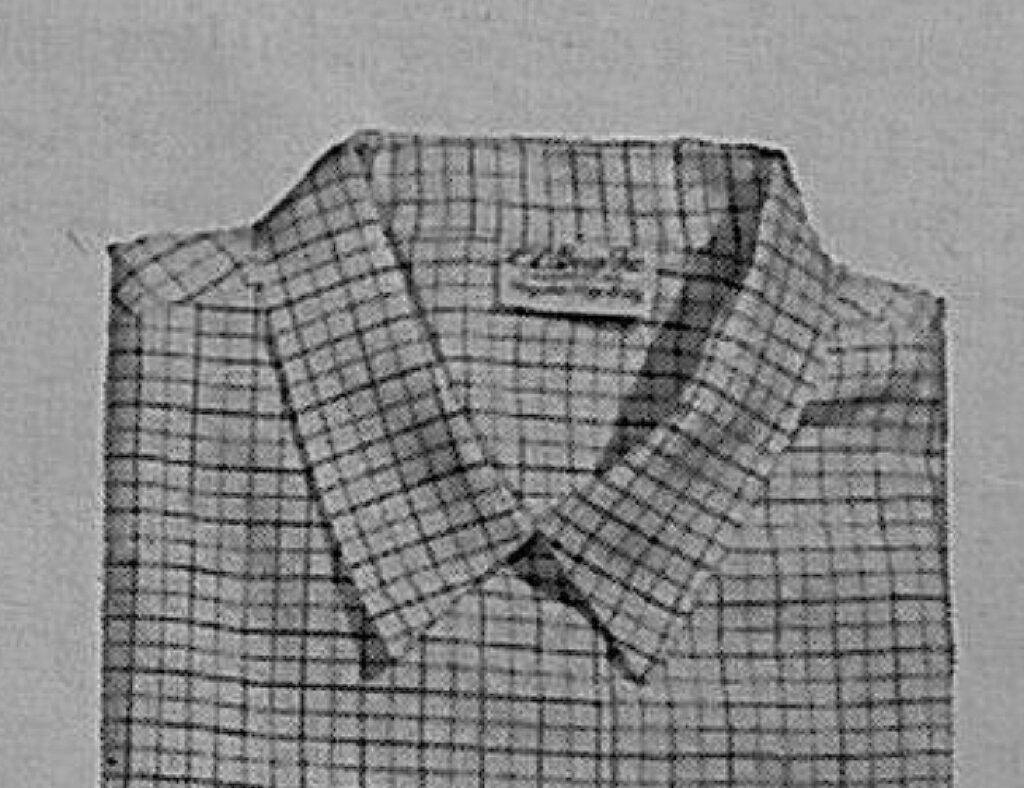
1959 LL Bean ladies cotton flannel shirt ad (TAG)
1960
Gorman was first hired by the company in 1960. In 1967 he became president of a languishing business, with $3.5 million in annual sales and $65,000 in profits. Strong leadership and redirection were required and Gorman filled the need. His first decisions included expanding the advertising budget and demographic target group and making prices more competitive. He refrained from seeking growth through more retail outlets for fear of jeopardizing the catalog business. During his first full year as president, sales rose to nearly $5 million. The company had gotten back on track just in time to enjoy a huge recreation boom that was spreading across the country. By 1975 sales had reached $30 million and the company was employing more than 400 people. During the 1970s, the computerization of many business segments and the relocation of manufacturing to a new building further speeded the company’s growth. In 1974 the company built near Freeport a 110,000-square-foot distribution center, which was expanded to 310,000 square feet in 1979.
1964
The success of Bean’s business strategy is reflected in the increase in profits between 1924 and the 1960s. In 1924, the company had been operating for 12 years, had twenty-four employees on its payroll, and posted $135,000 in sales for the year. In 1937, sales of $1 million were recorded. By 1950, the company had more than 100 employees and achieved sales of nearly $2 million. By 1964, sales reached $3 million and profits were $70,000. However, despite the considerable profits, Bean was opposed to expansion, fearing that his customers would dislike change and its implied loss of personal customer service.
1965
The later half of the 20th century offered more iconic merchandise from Bean. In 1965 L.L. Bean released its Norwegian Sweater, meant to mimic the sustained warmth in garments worn by Norwegian fishermen. In the ’80s, L.L. Bean would develop its simple, now-stapleversions of fleeces and vests which would prove massively popular. By The New York Times’ count, the company sold 170 different fleece items in its catalogues.
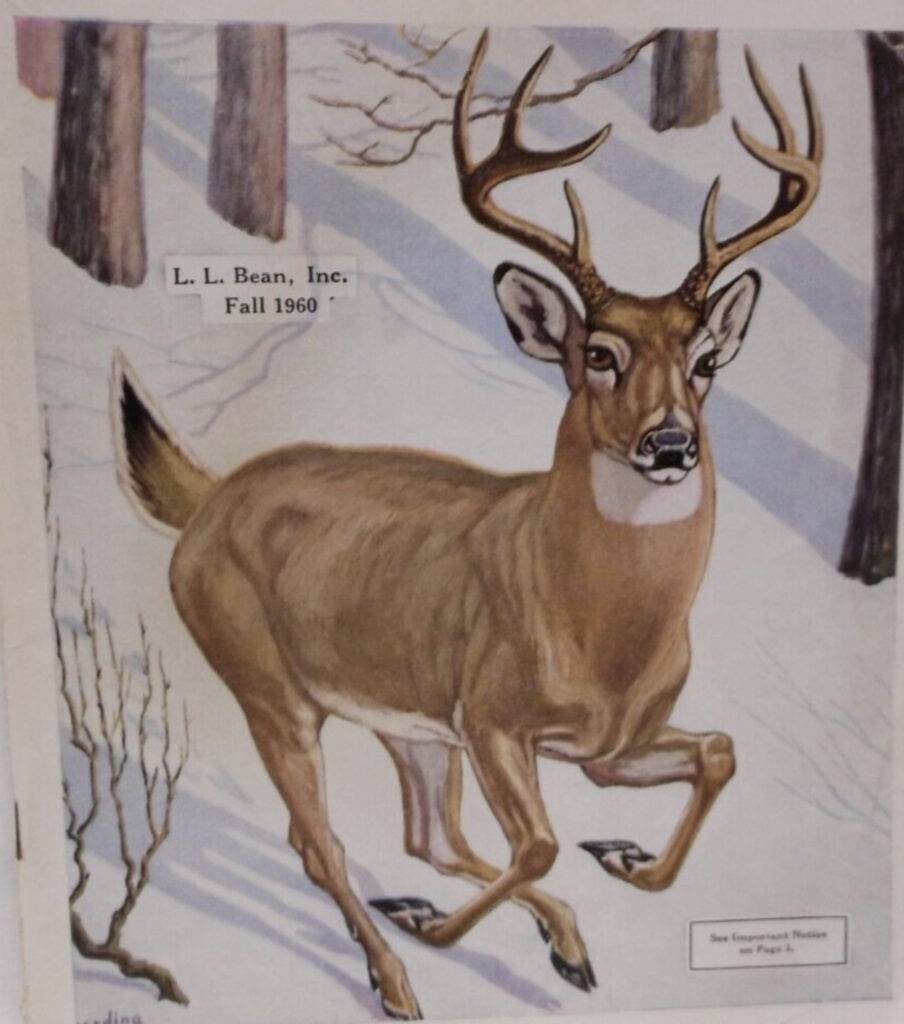
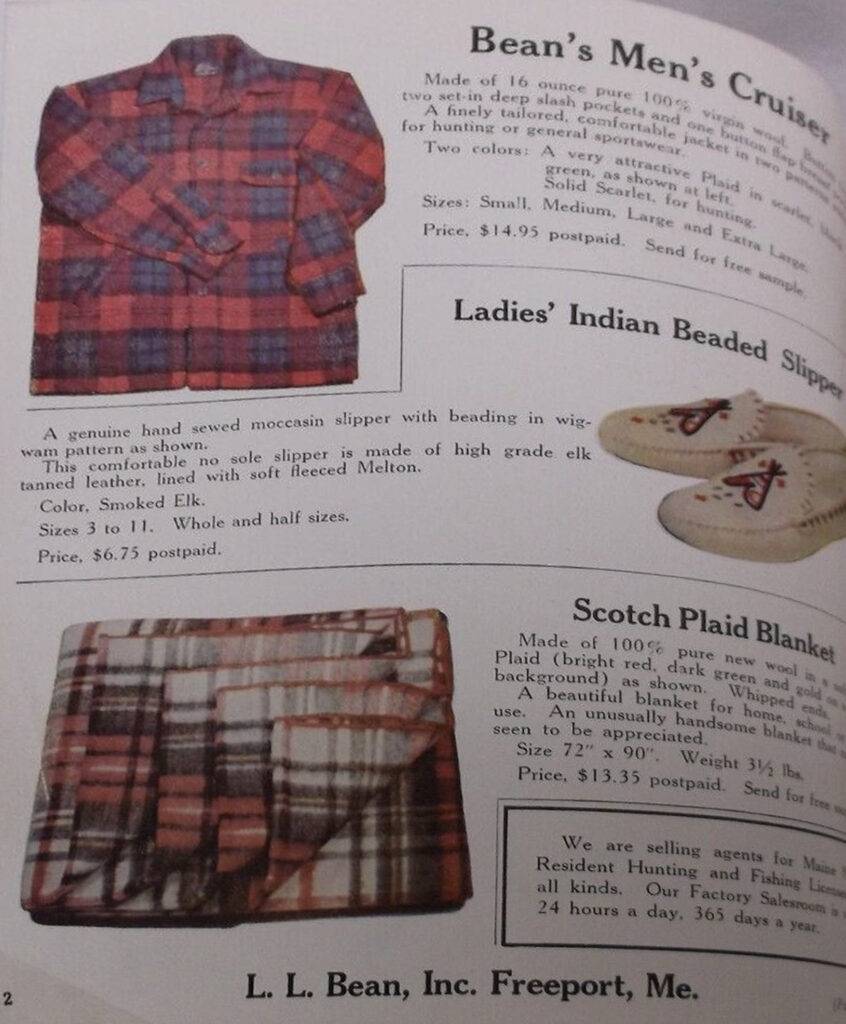
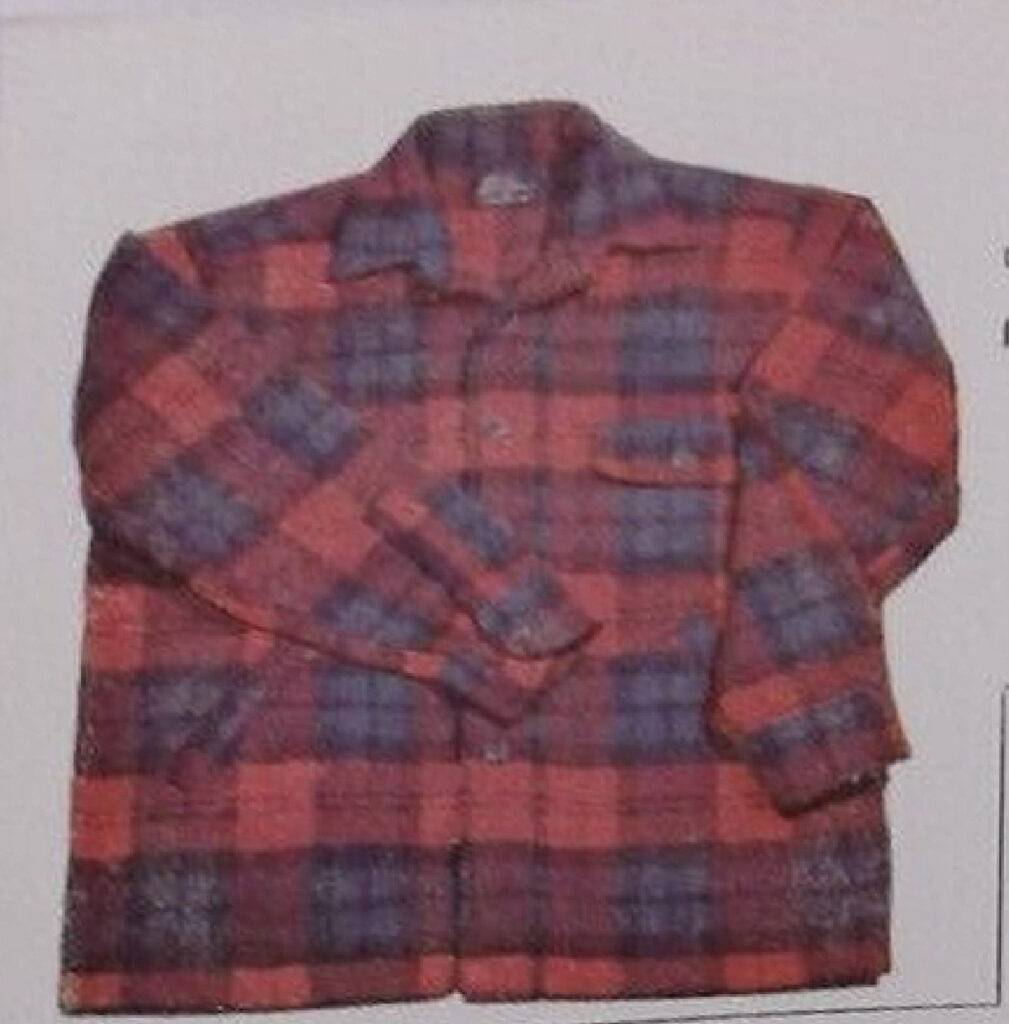
1960 FALL LL Bean

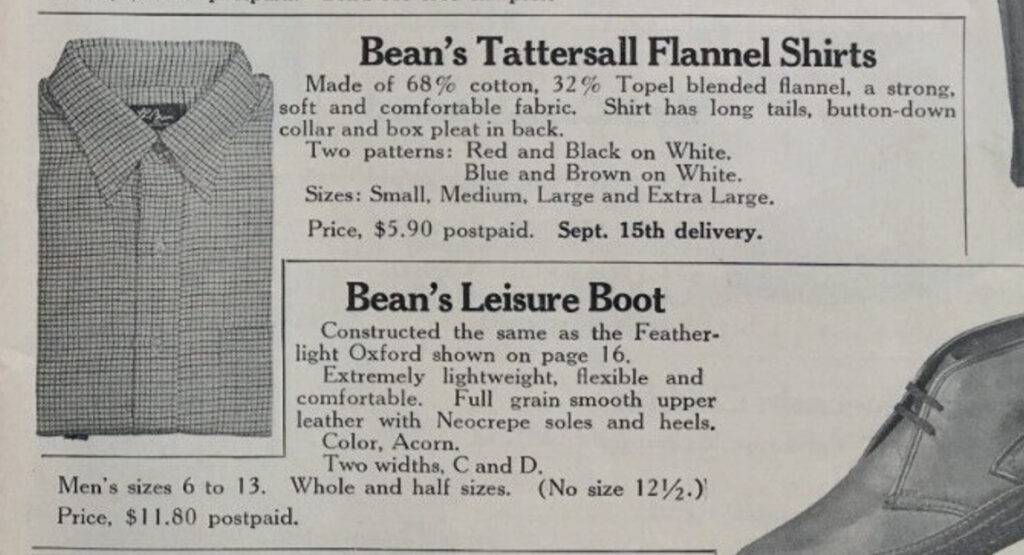
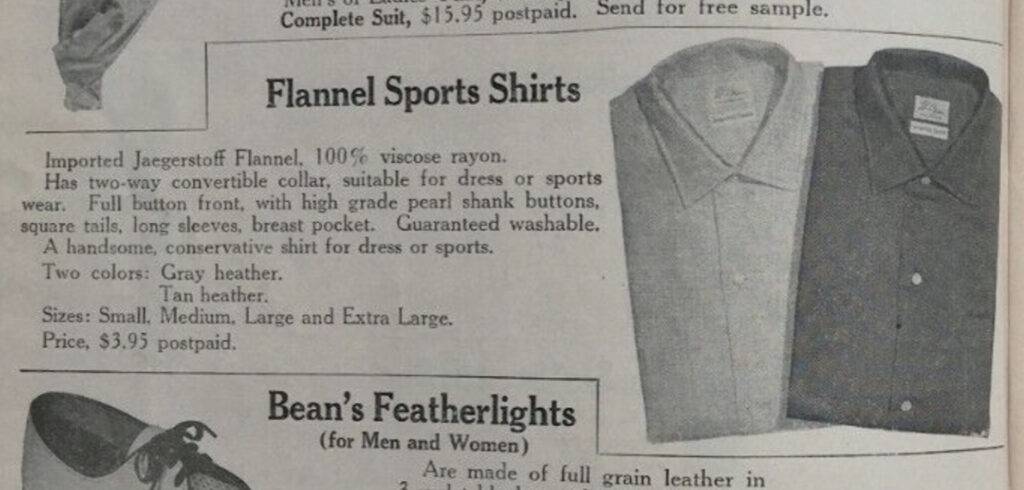
1961 FALL LL Bean

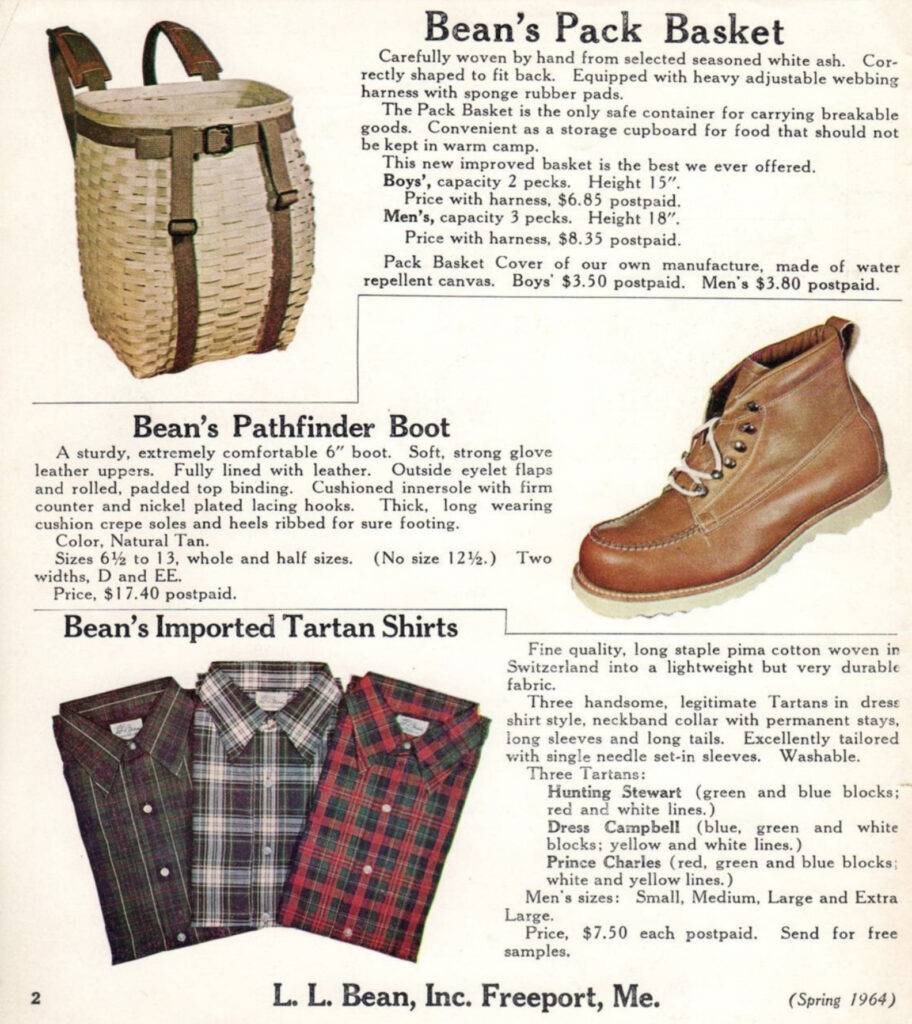
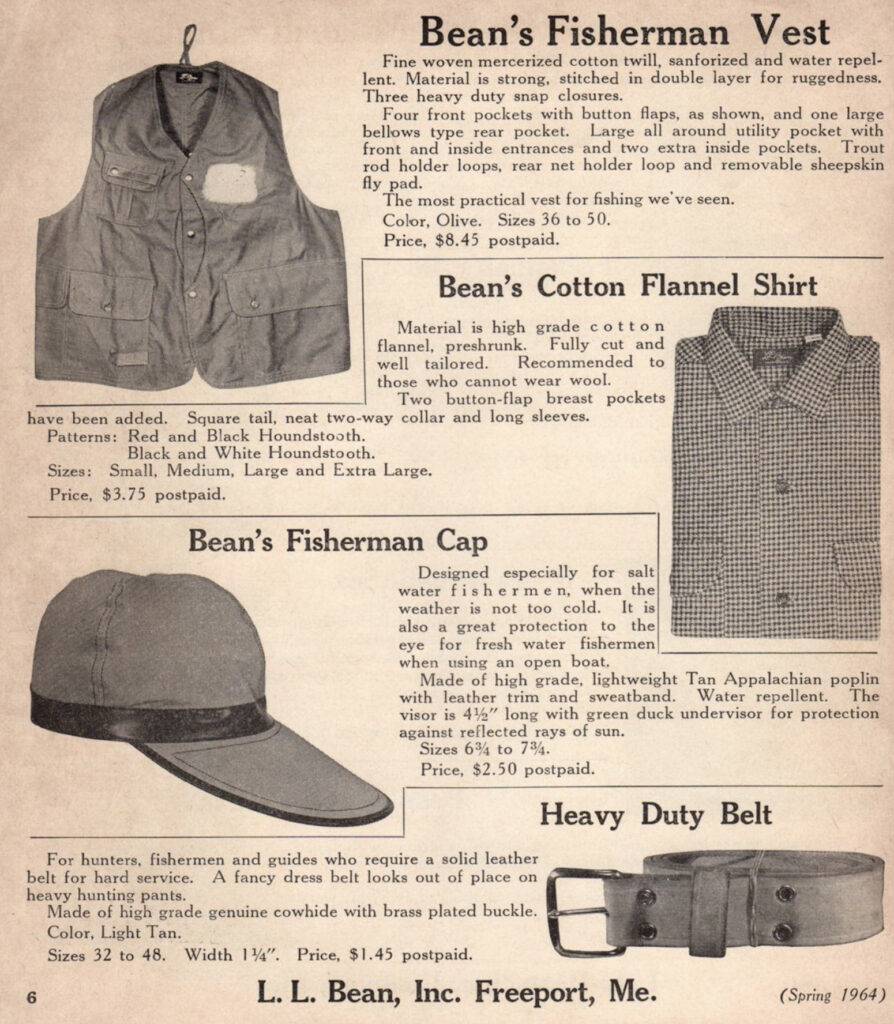
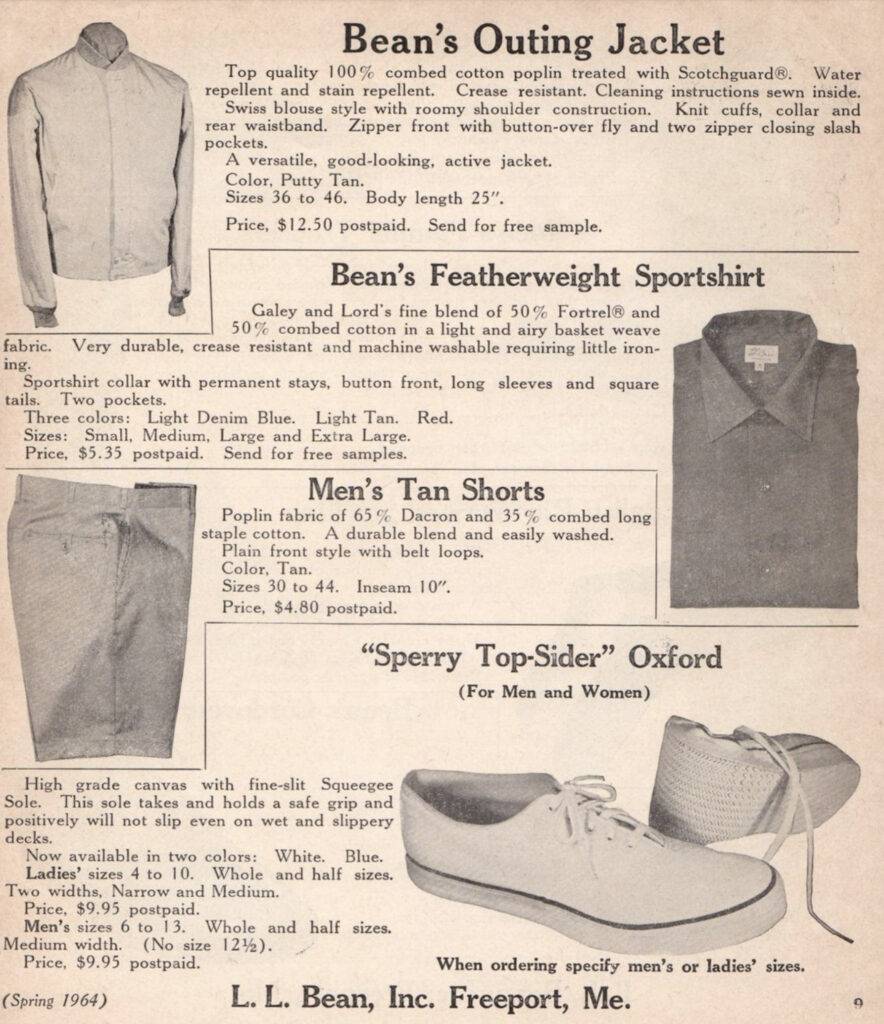
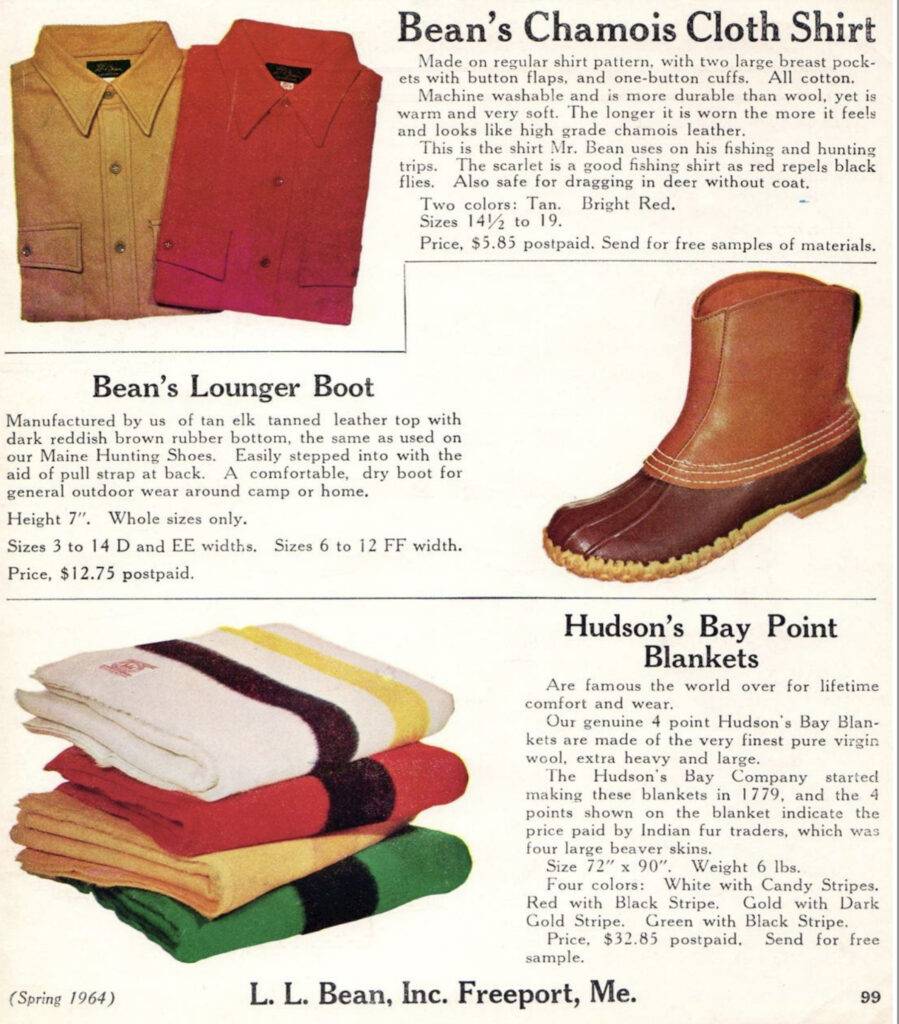
1964 SPRING LL Bean

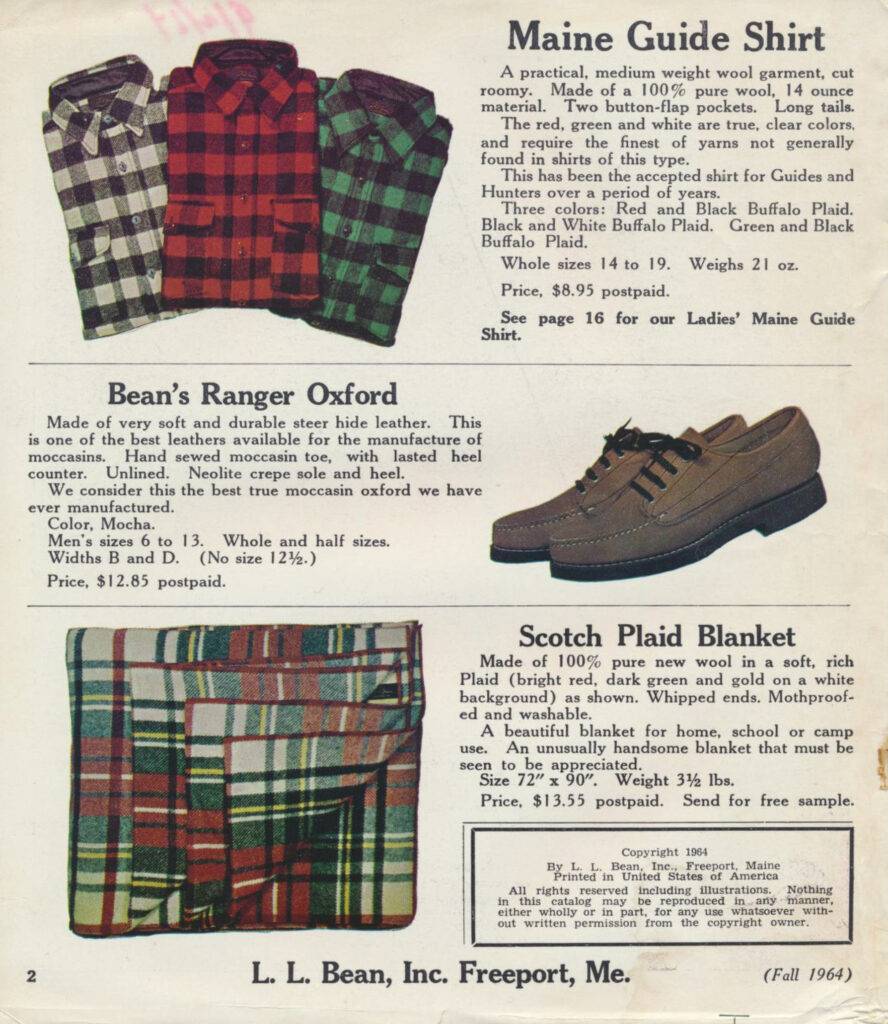
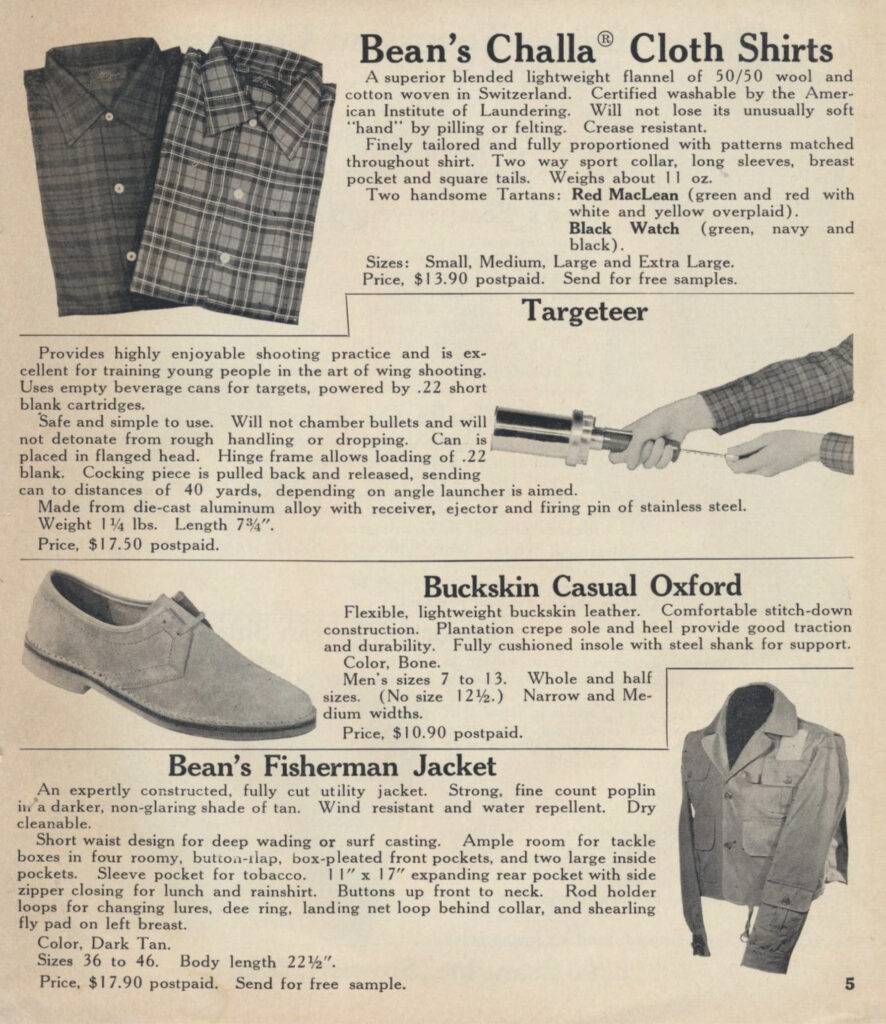
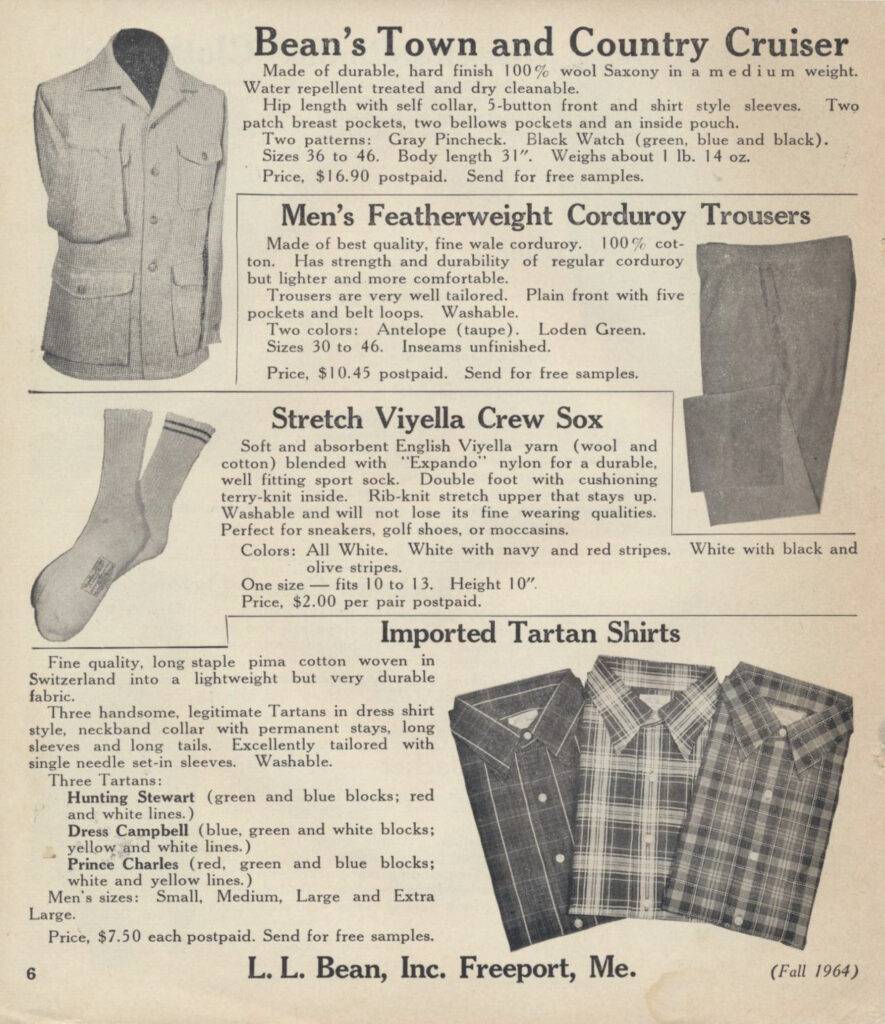
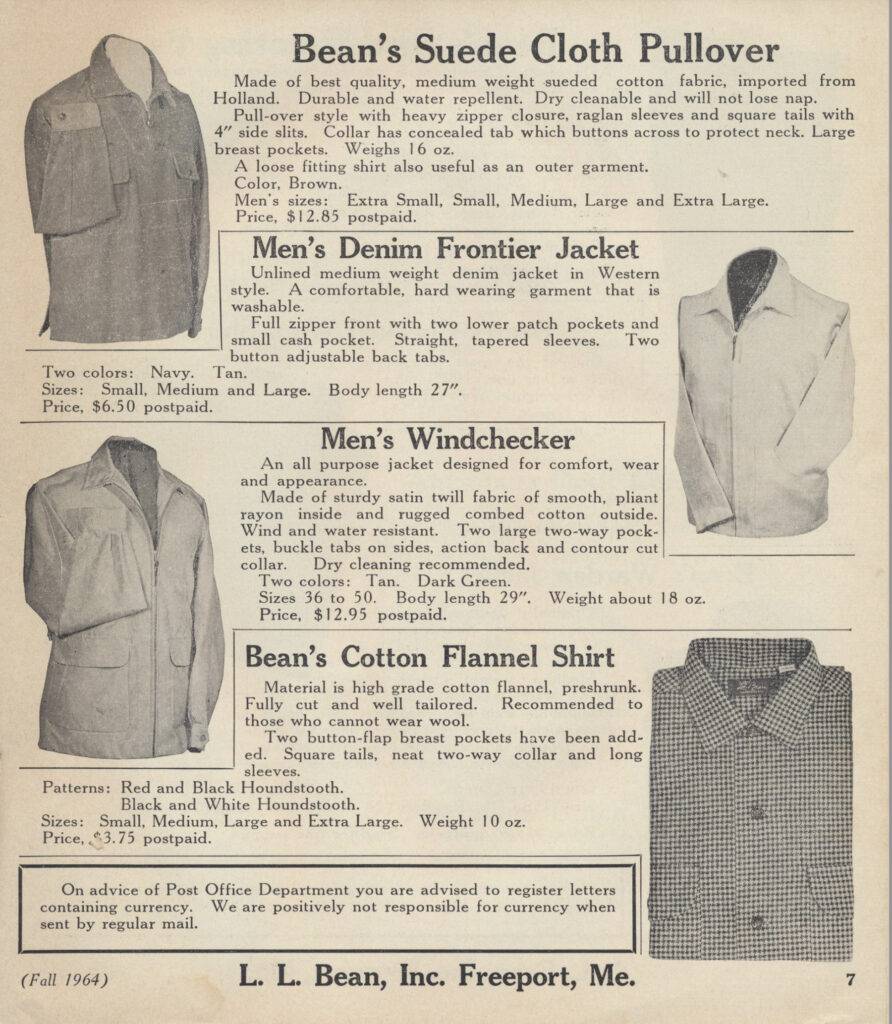

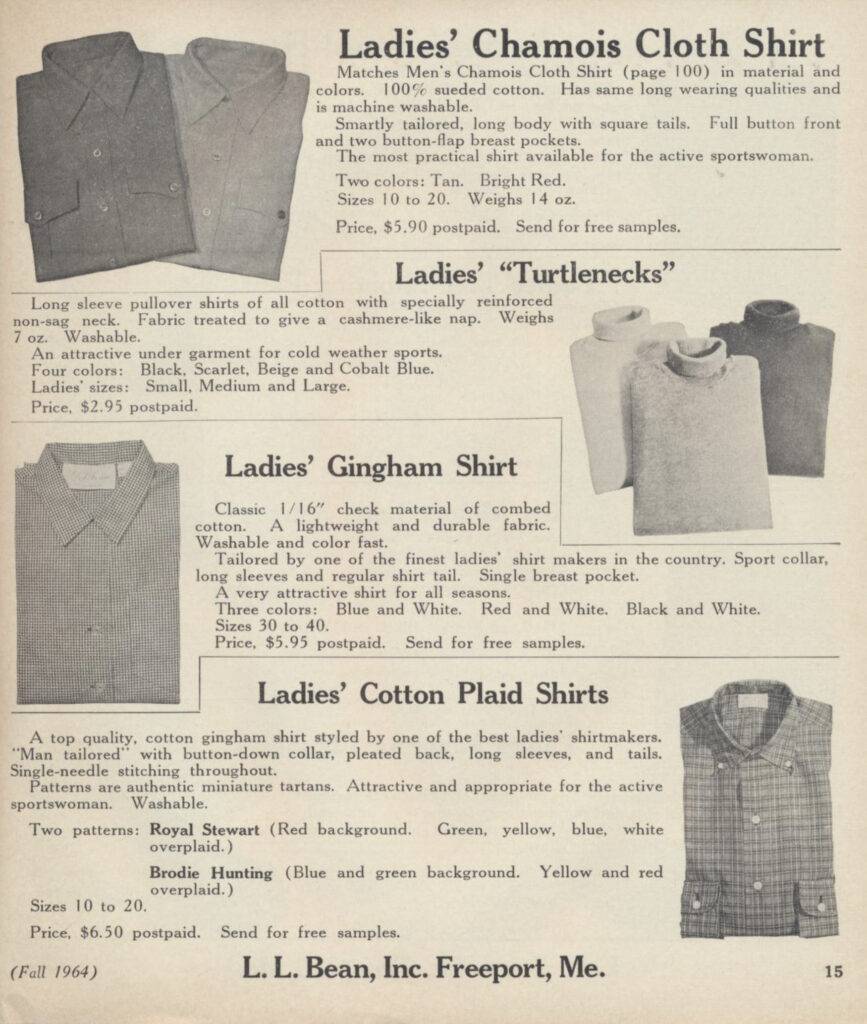
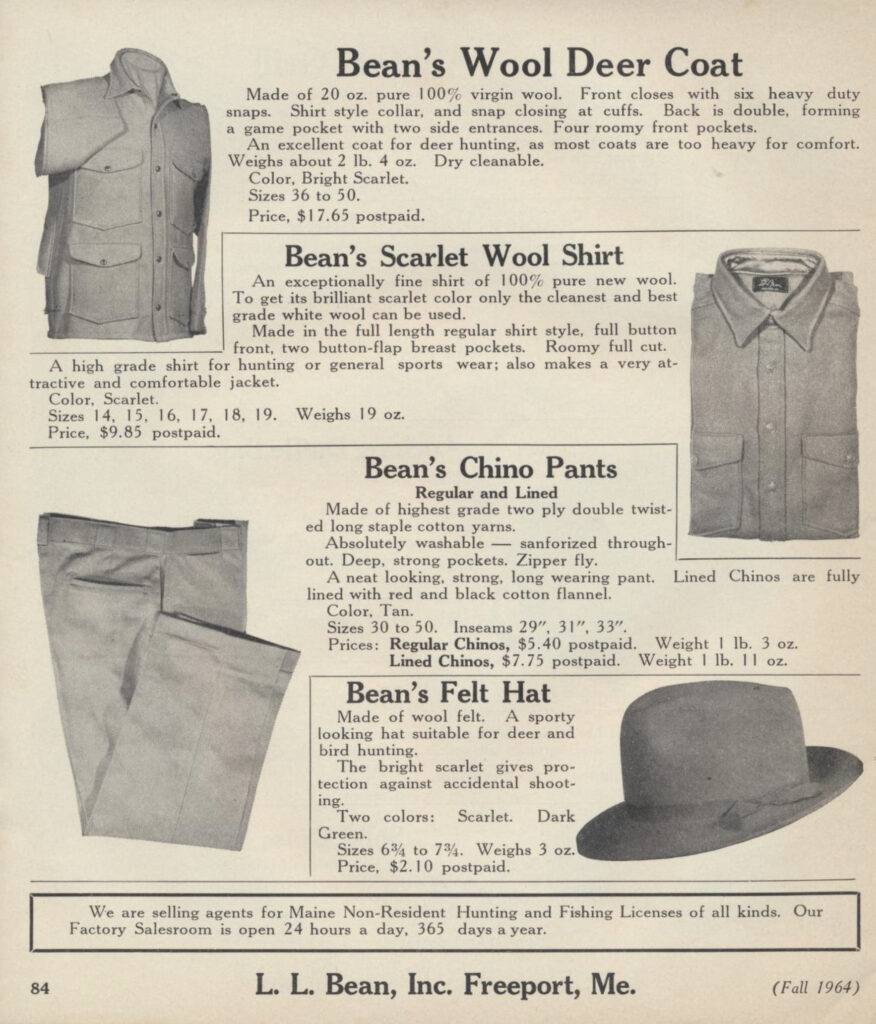
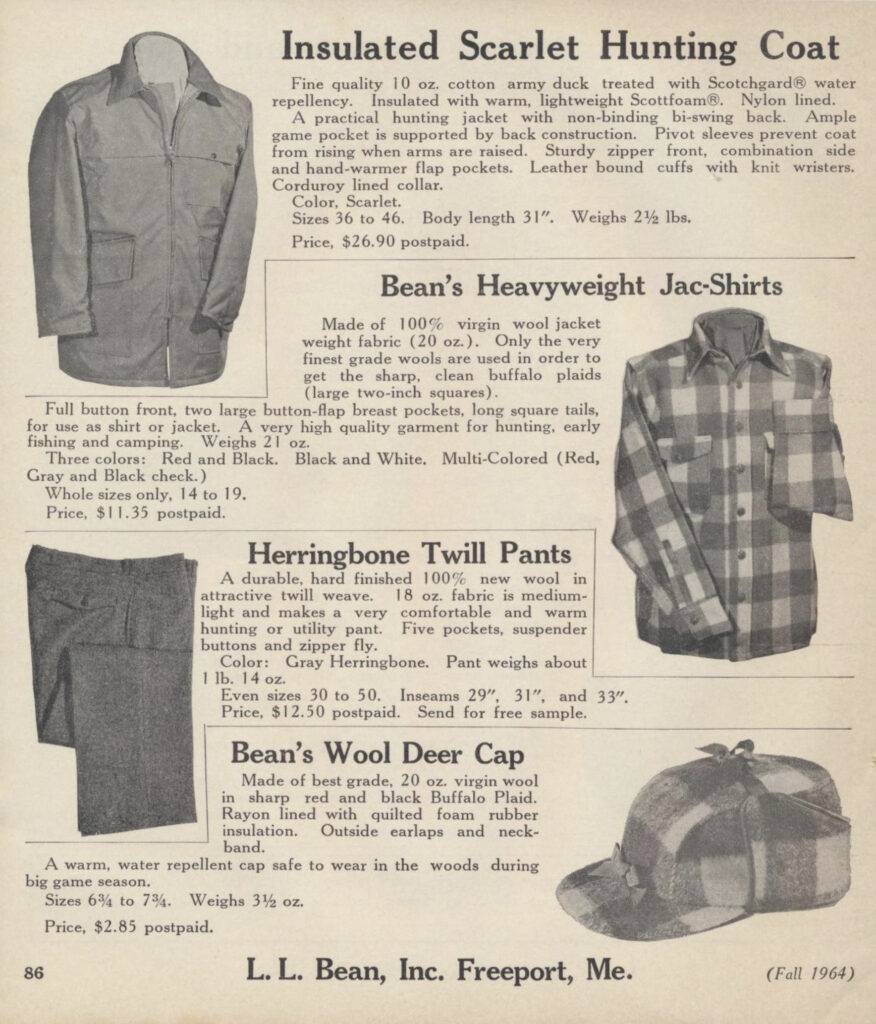

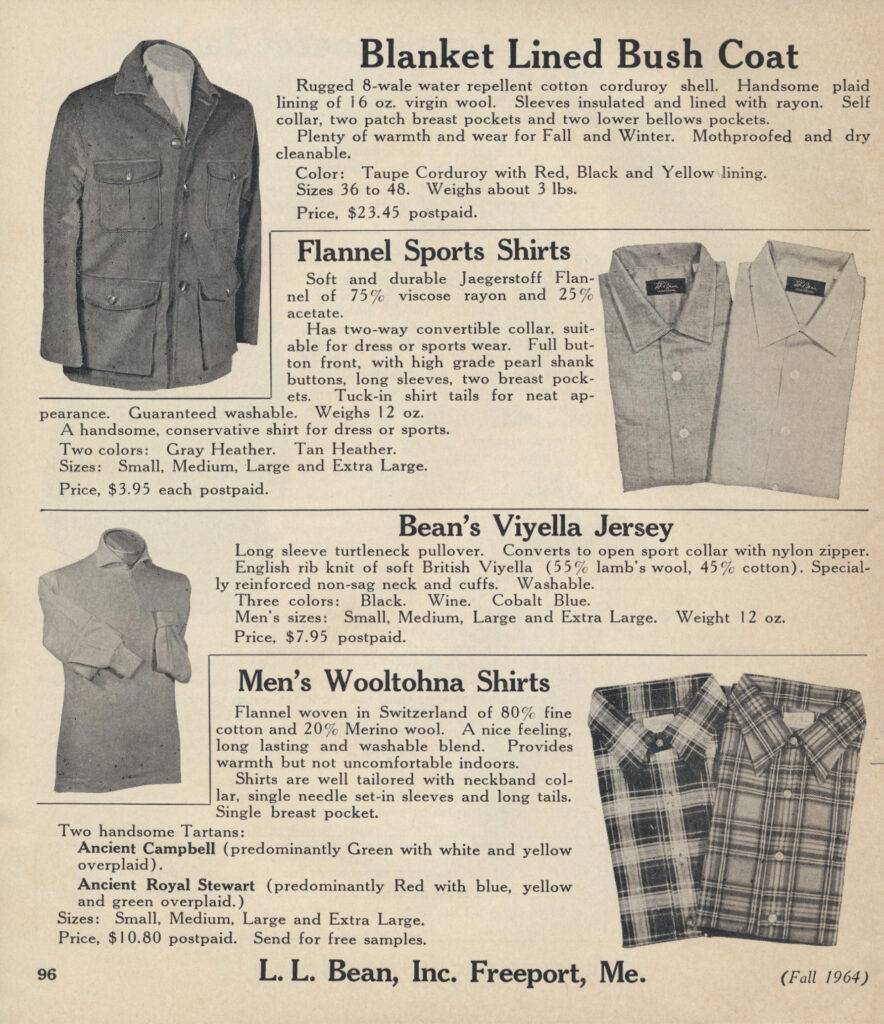

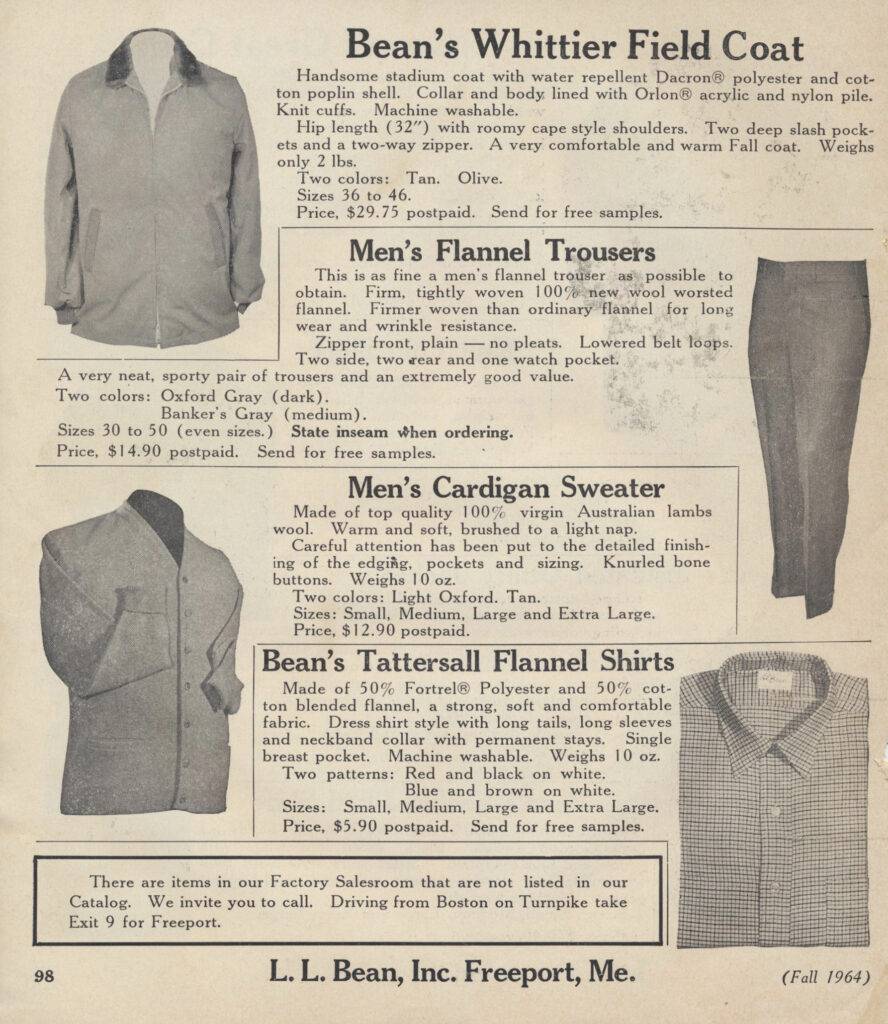
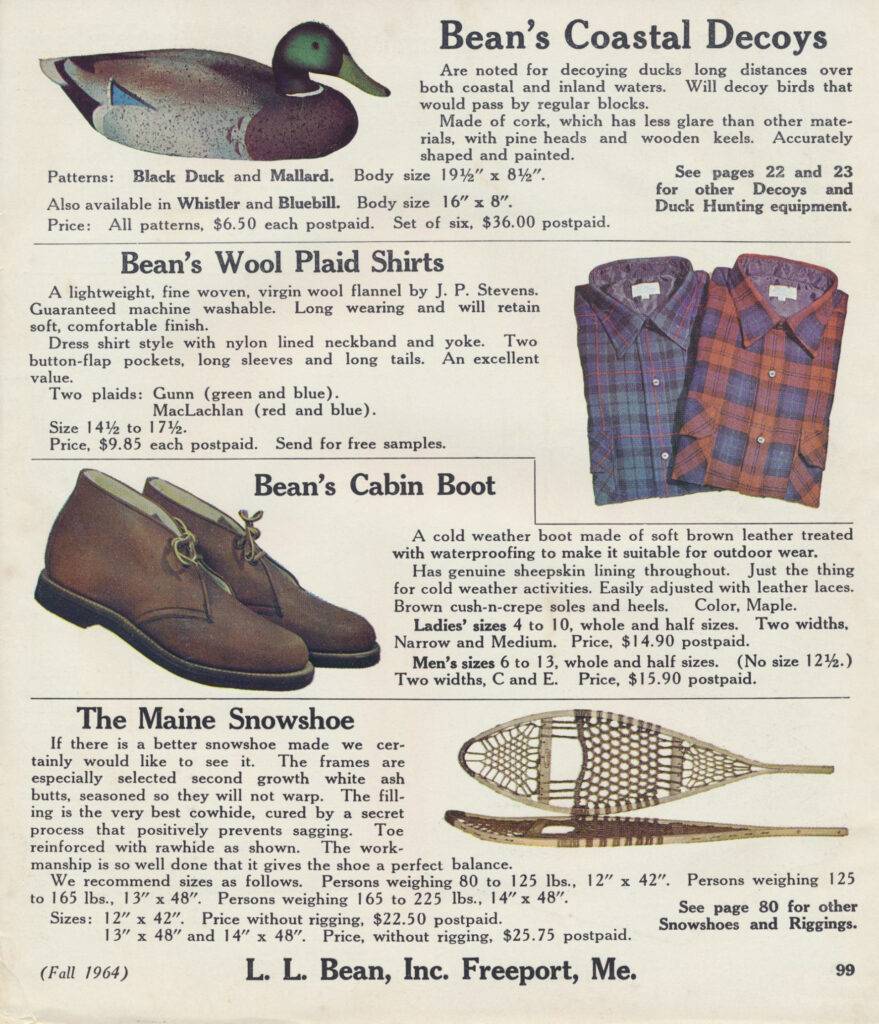

1964 FALL LL Bean

1965 FALL LL Bean
19??
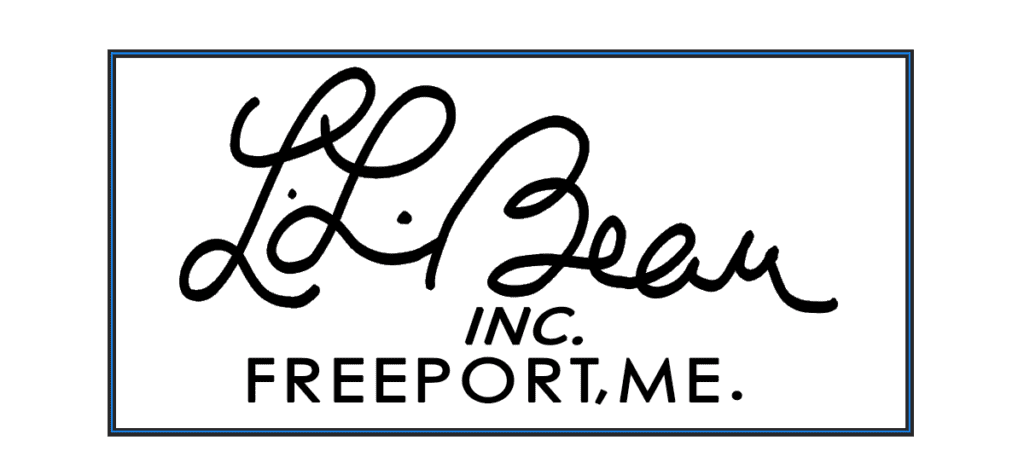
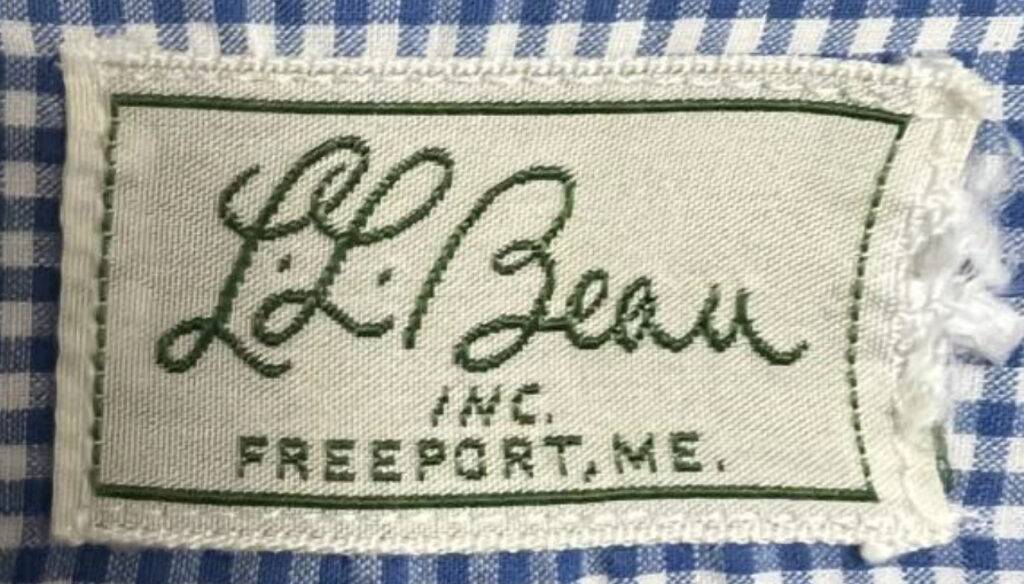
Unfortunately, it is not known when this written “l.l.bean” signature name with square frame tag was released. (If anyone knows, please let us know.) However, it definitely predates the following bold-faced written signature.
残念ながら、この四角いフレームタグの “l.l.bean” サイン入りネームタグがいつリリースされたかは不明です。もしご存知の方がいらっしゃいましたら、お知らせください。ただし、次の太字の書かれた署名よりも古いことは間違いありません。
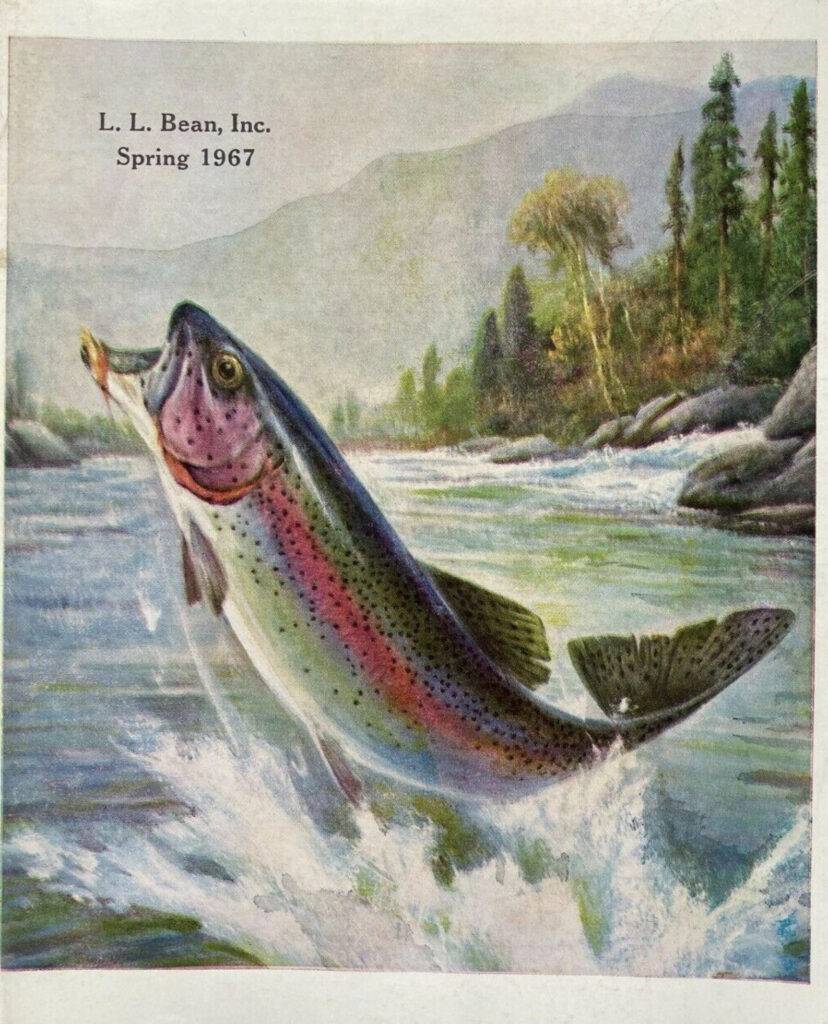
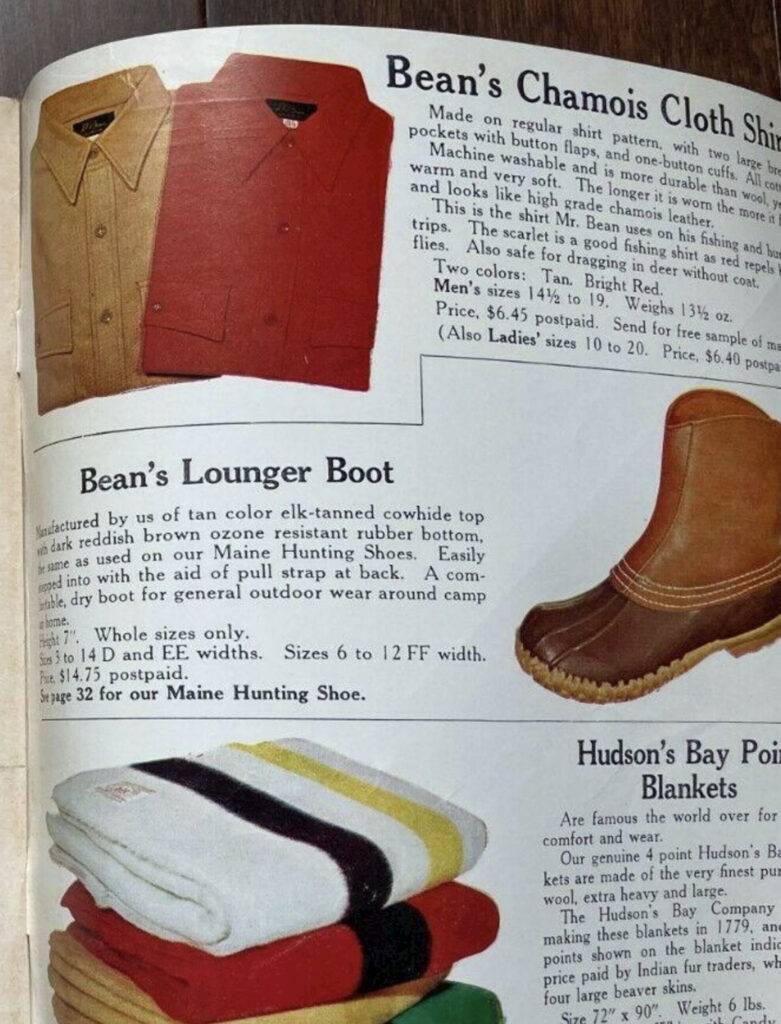
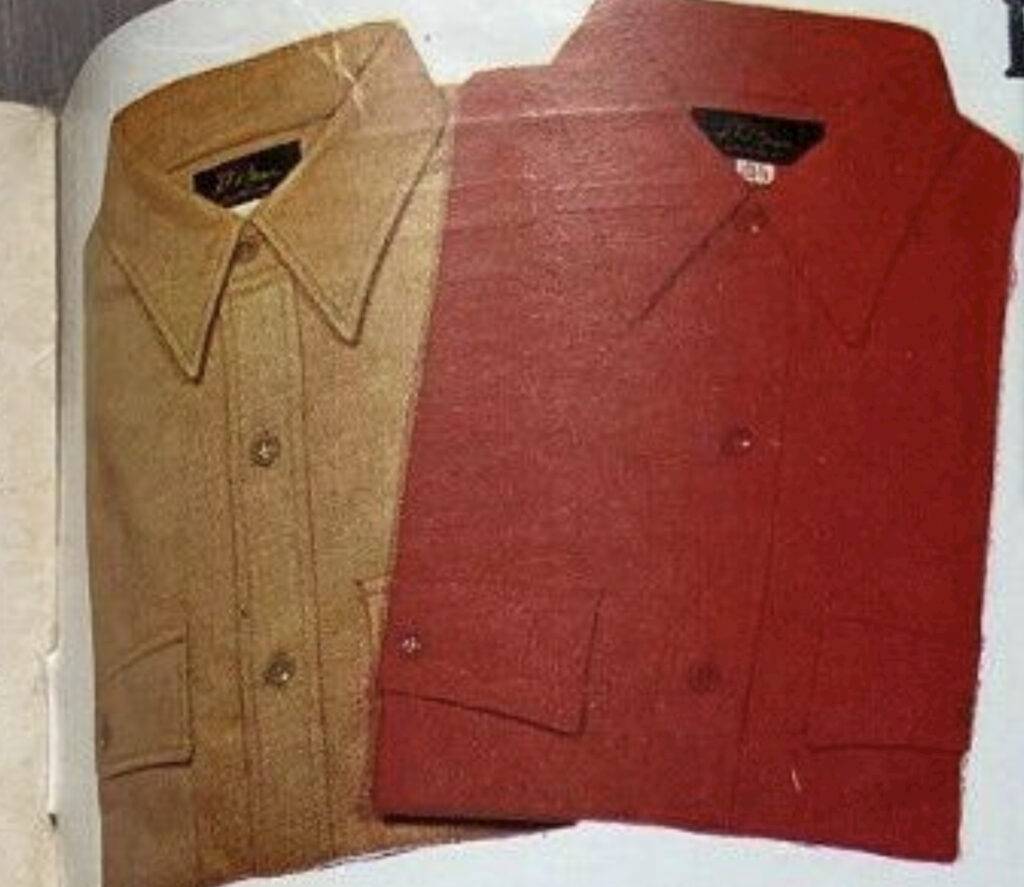
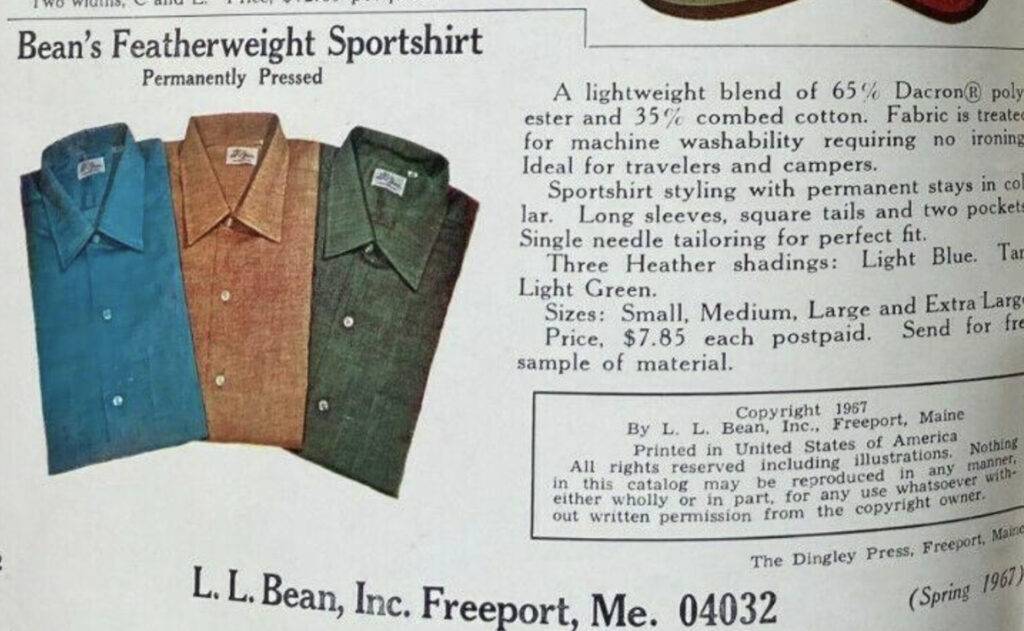
1967 SPRING LL Bean
1960s LATE (1968? or 69?)


After the death of legendary founder Leon Leon Leonwood Bean in 1967, his grandson, Leon Arthur Gorman, became president of L.L. Bean. The name tag was changed at that time, with the letters being made bolder. The change was completed in 1968 or 1969, during a time when both the old and new name tags were used. The new tag is shown in the 1969 catalogue.
伝説的創業者である Leon Leon Leonwood Bean が 1967 年に亡くなると、彼の孫である Leon Arthur Gorman が L.L.Bean の社長になりました。当時、ネームタグが変更されたと考えられています。基本的には、文字は同じままでしたが、太字になりました。移行期間を含めて、ネームタグが完全に変更されたのは 1968 年か 1969 年と推測しています(新しいネームタグは 1969 年のカタログに掲載されています)。
1967
Gorman was first hired by the company in 1960. In 1967 he became president of a languishing business, with $3.5 million in annual sales and $65,000 in profits. Strong leadership and redirection were required and Gorman filled the need. His first decisions included expanding the advertising budget and demographic target group and making prices more competitive. He refrained from seeking growth through more retail outlets for fear of jeopardizing the catalog business. During his first full year as president, sales rose to nearly $5 million. The company had gotten back on track just in time to enjoy a huge recreation boom that was spreading across the country.
1975
By 1975 sales had reached $30 million and the company was employing more than 400 people. During the 1970s, the computerization of many business segments and the relocation of manufacturing to a new building further speeded the company’s growth. In 1974 the company built near Freeport a 110,000-square-foot distribution center, which was expanded to 310,000 square feet in 1979.
In 1975 L.L. Bean was recognized as a bona fide member of the fashion world when it received the prestigious Coty award. This accolade signified an expansion of the meaning of fashion and confirmed its role as a mirror on contemporary culture. The genius of L.L. Bean had been to recognize the recreational potential in his local surroundings and to invent ways to cater, through clothing, first for the growth of outdoor sporting activities and, later, to the booming leisure market.
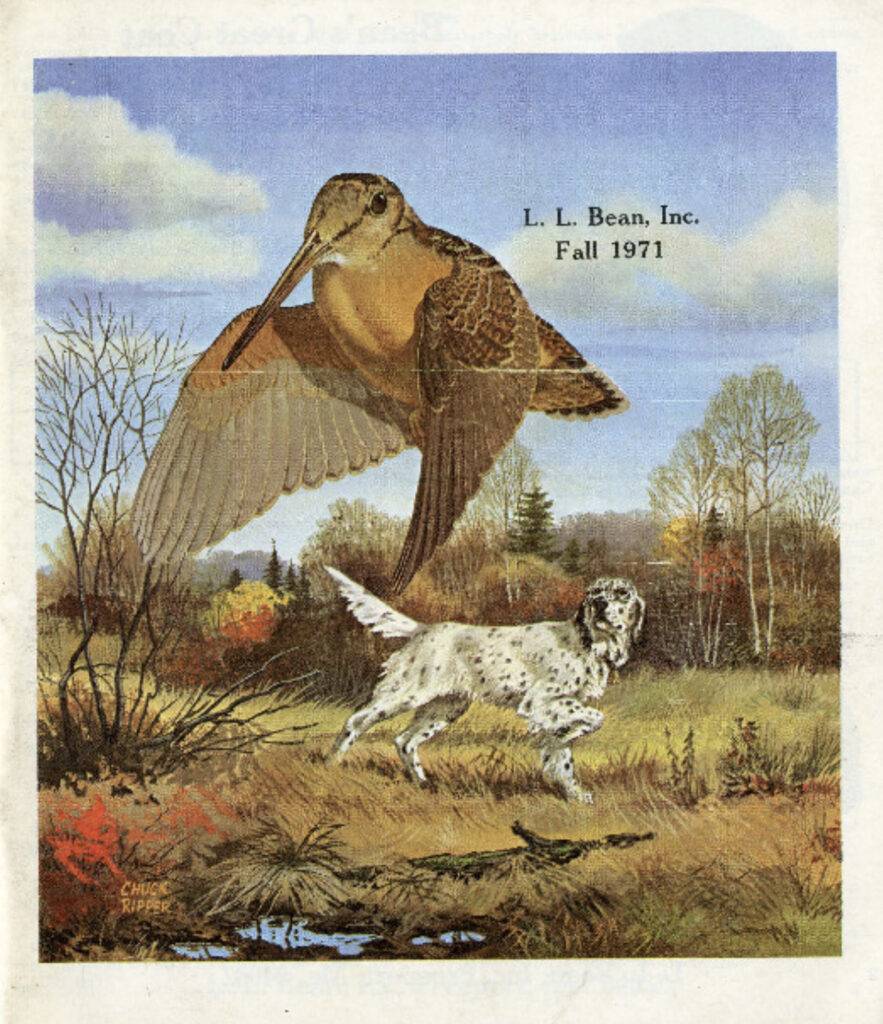
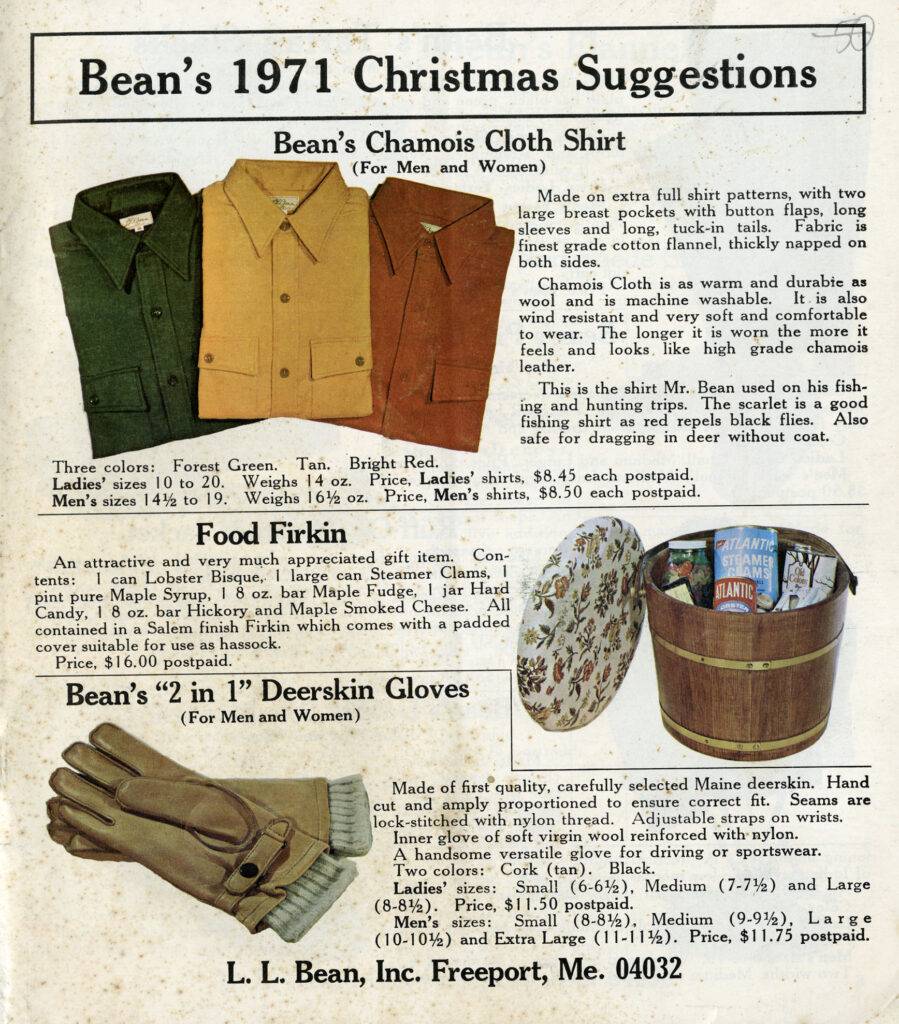
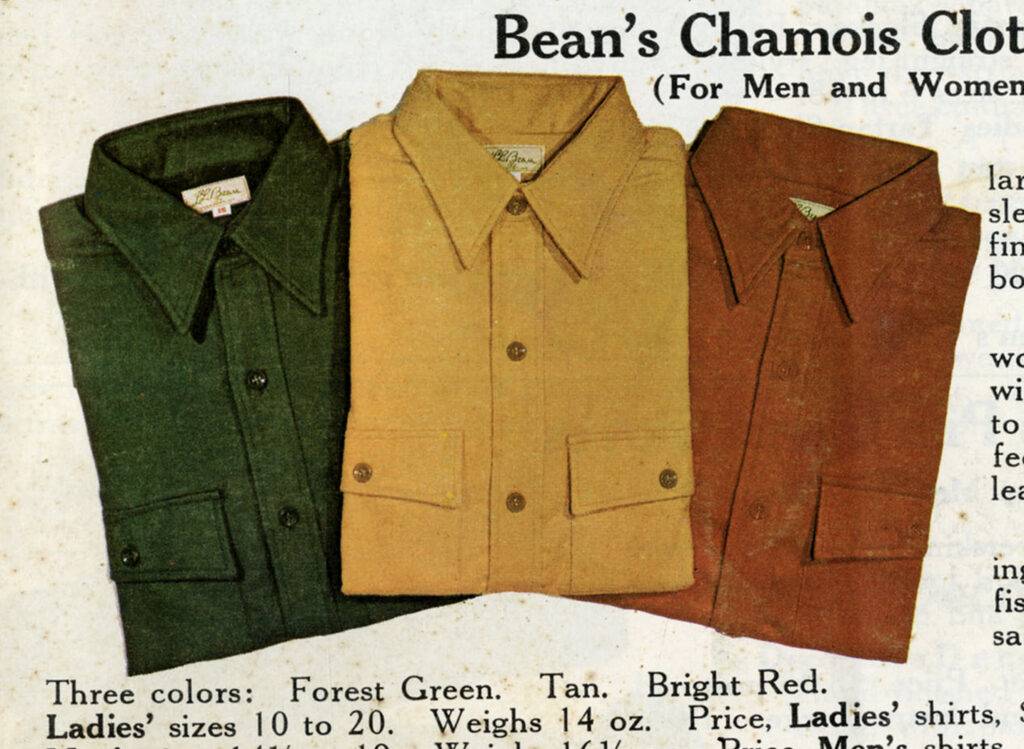
1971 SPRING LL Bean
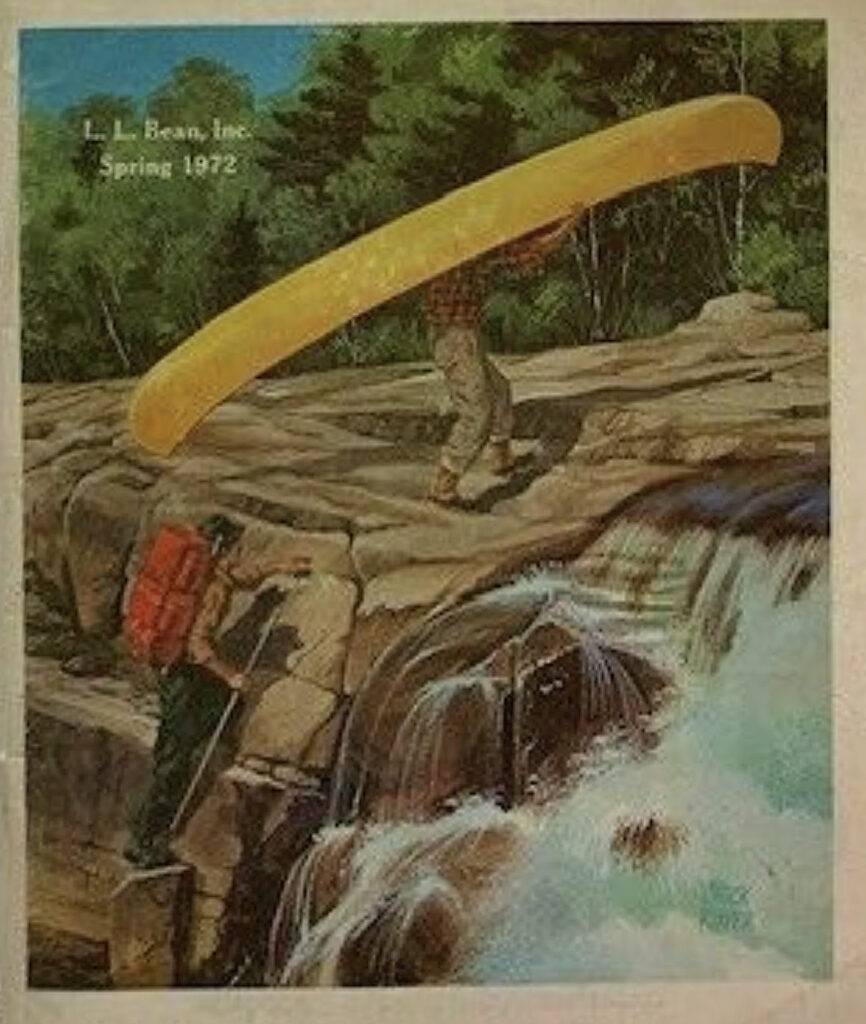
1972 SPRING LL Bean

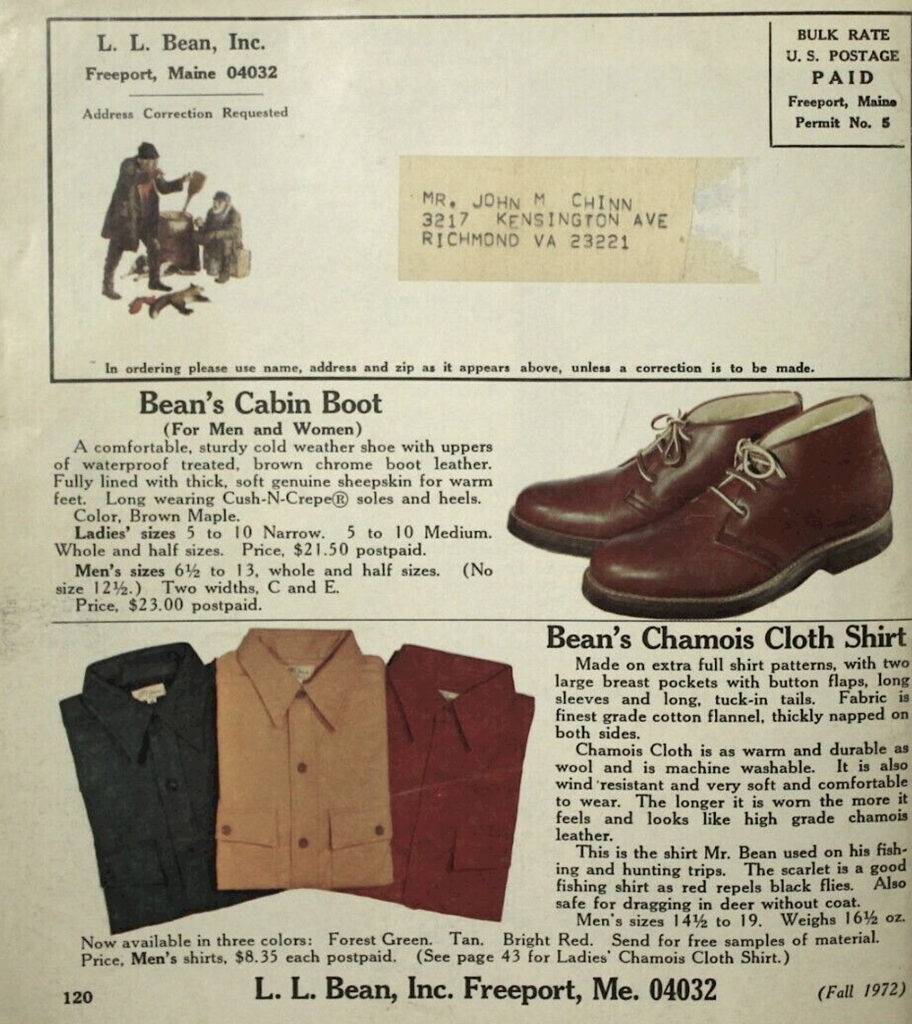
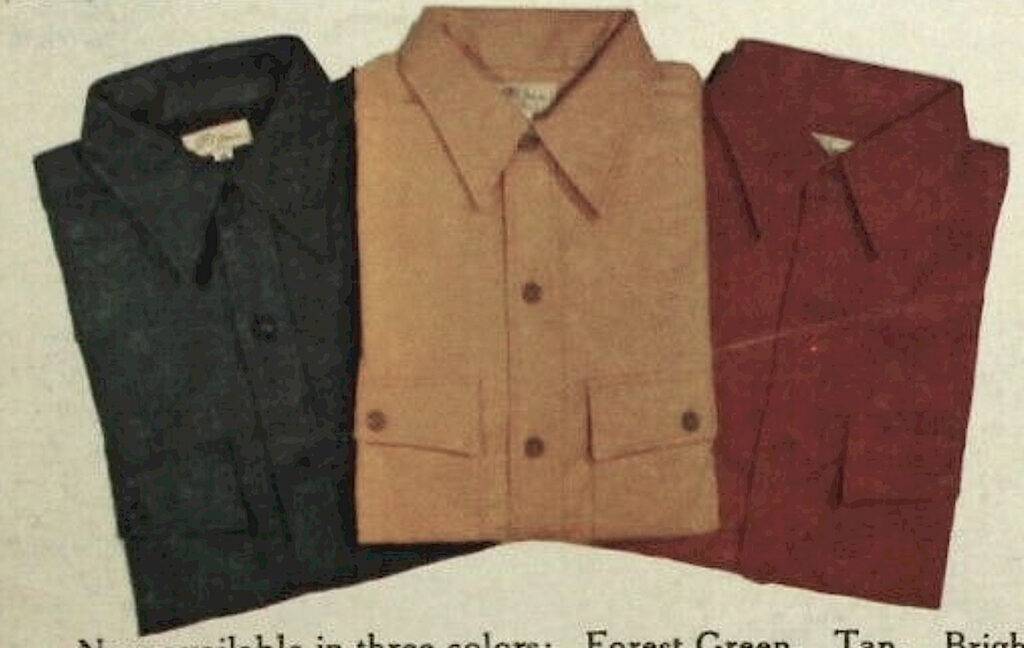
1972 FALL LL Bean

1974 FALL LL Bean
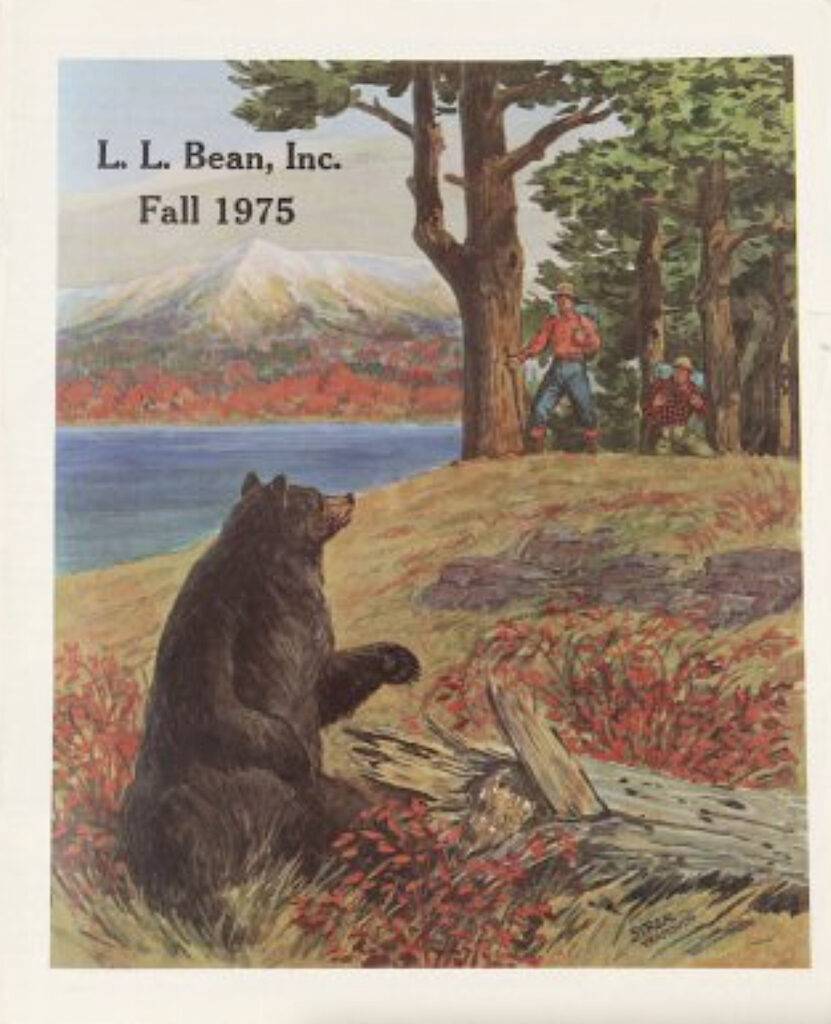

1975 FALL LL Bean
1976 – (trademark)
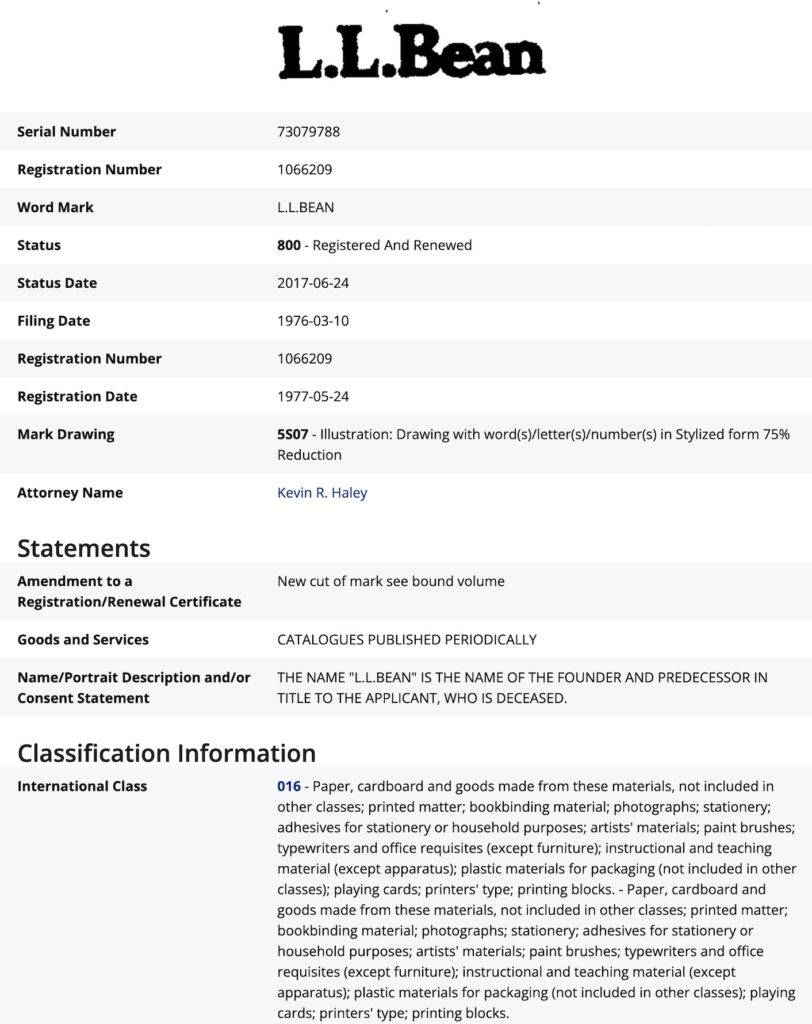

1976 SPRING LL Bean

1976 FALL LL Bean
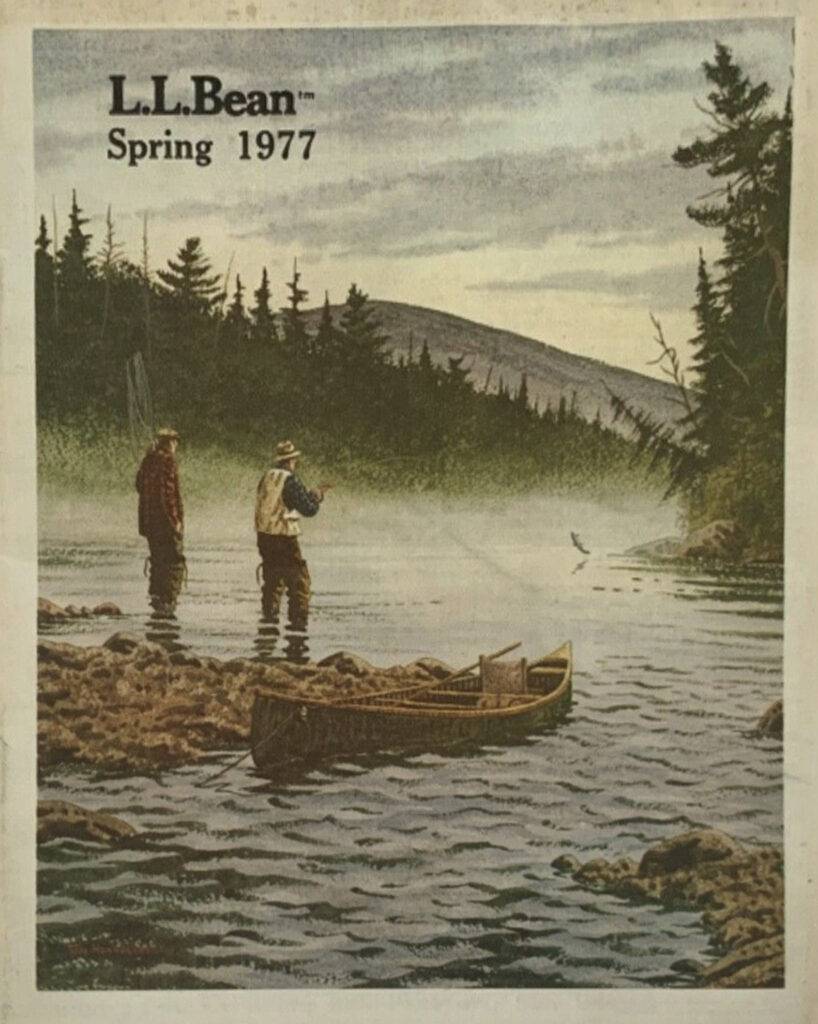
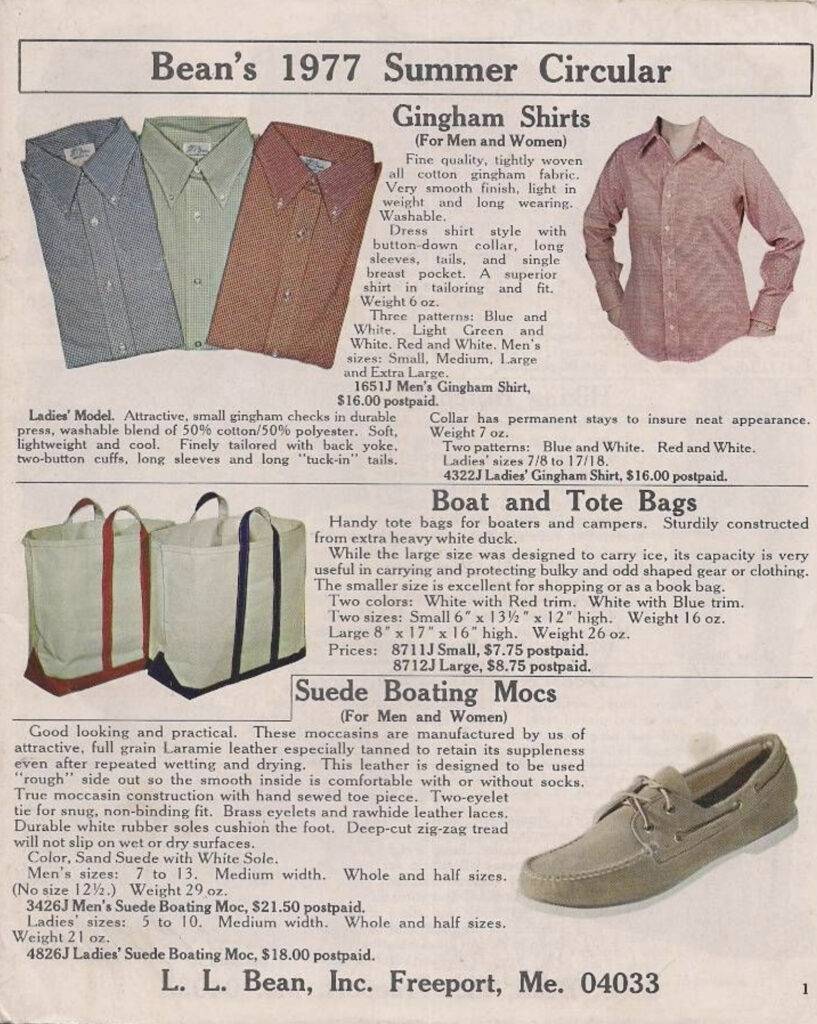
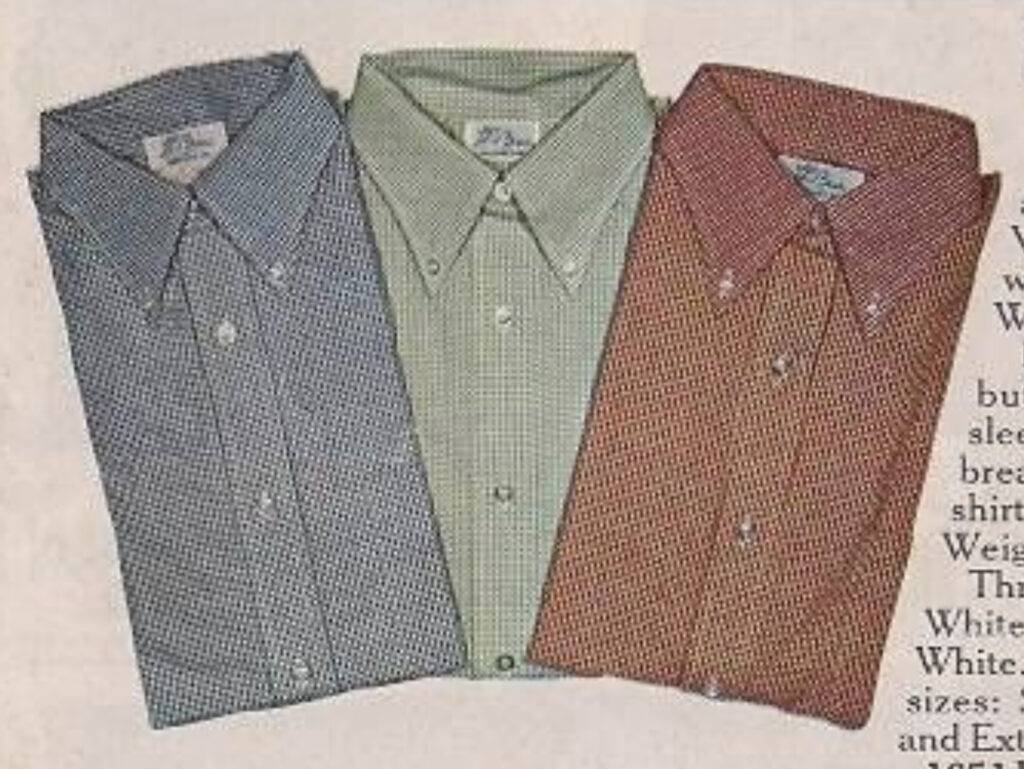
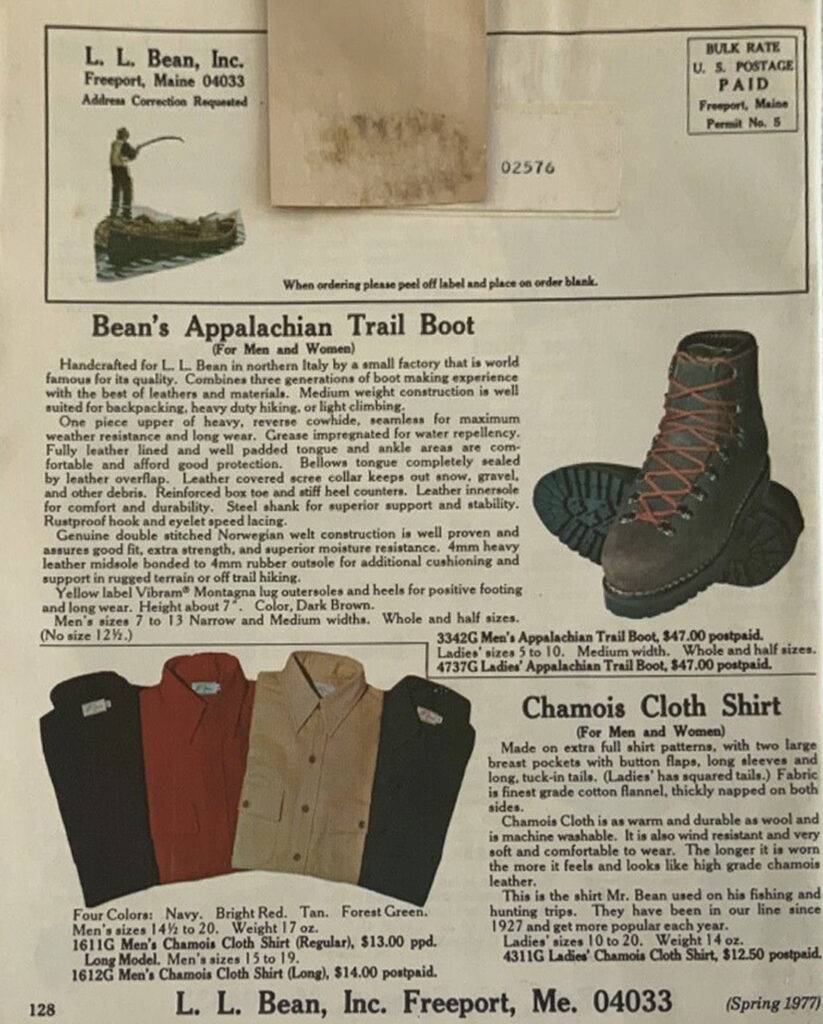
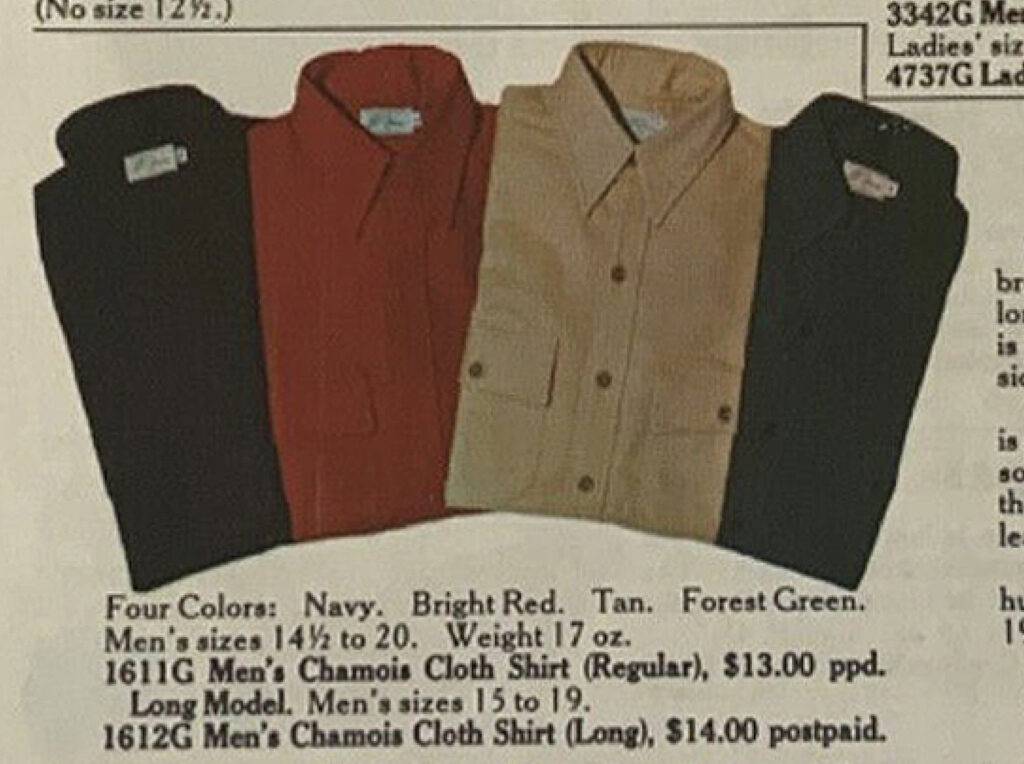
1977 SPRING LL Bean

1977 FALL LL Bean
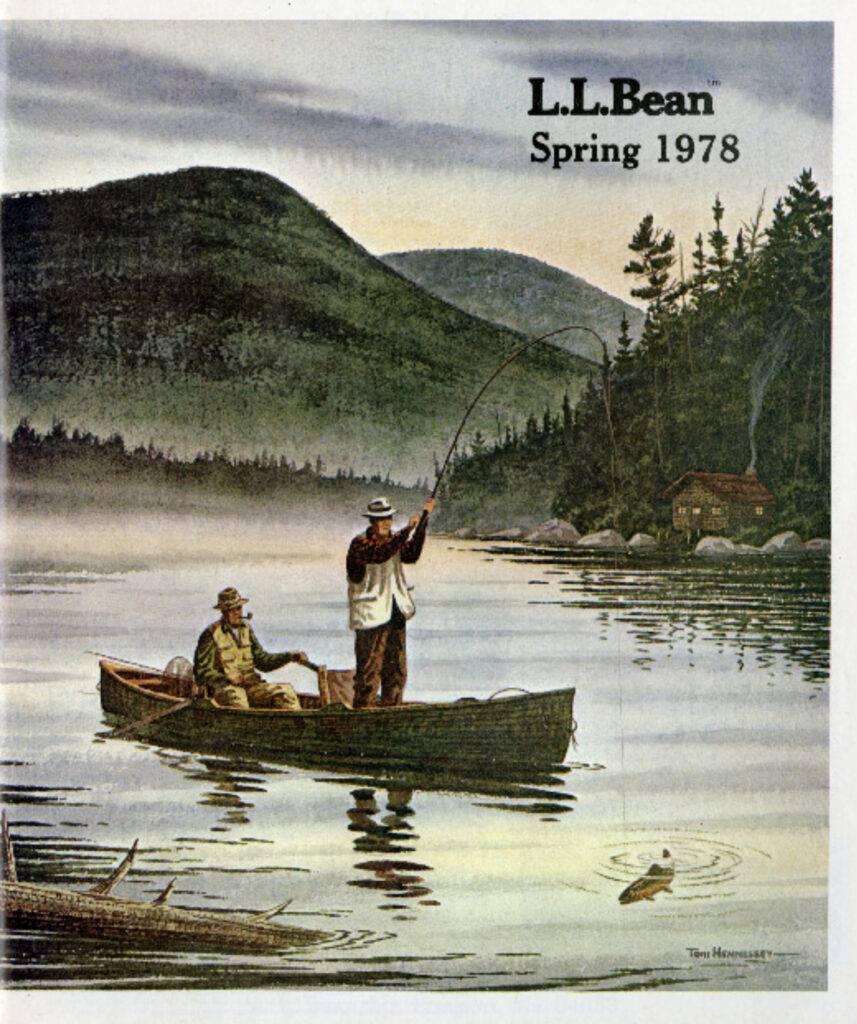
1978 SPRING LL Bean
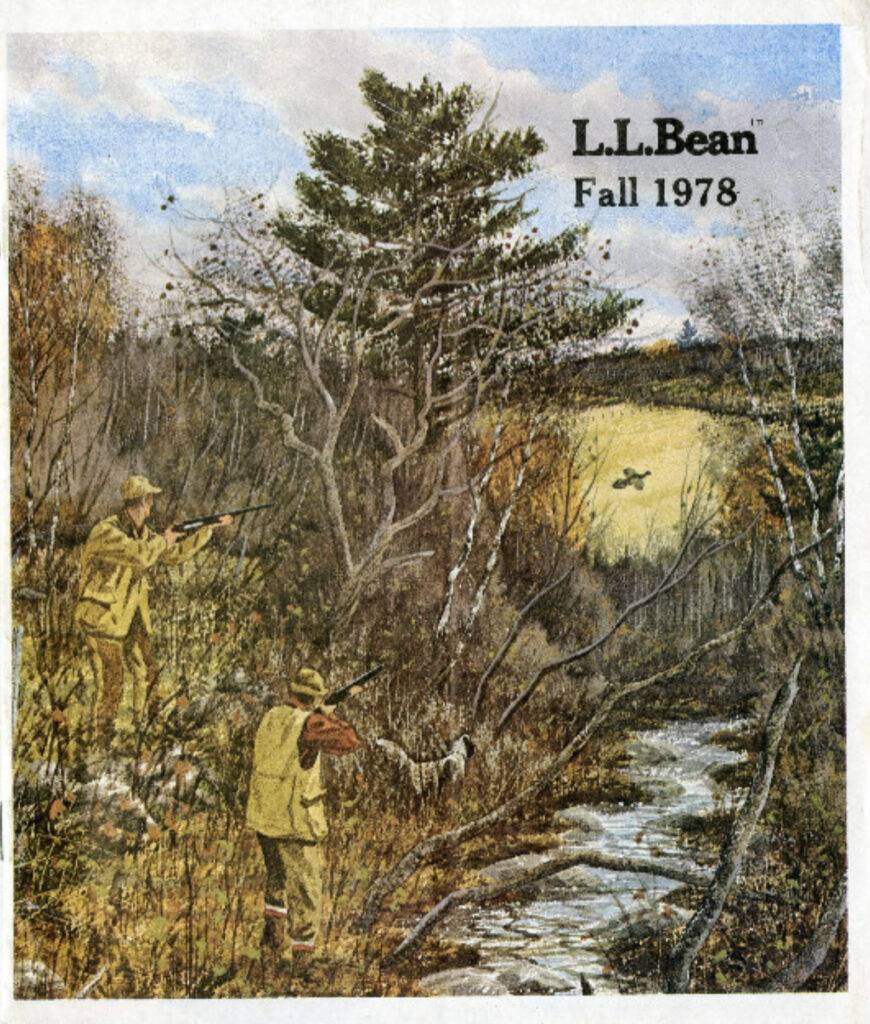
1978 FALL LL Bean
1979 – (register mark)
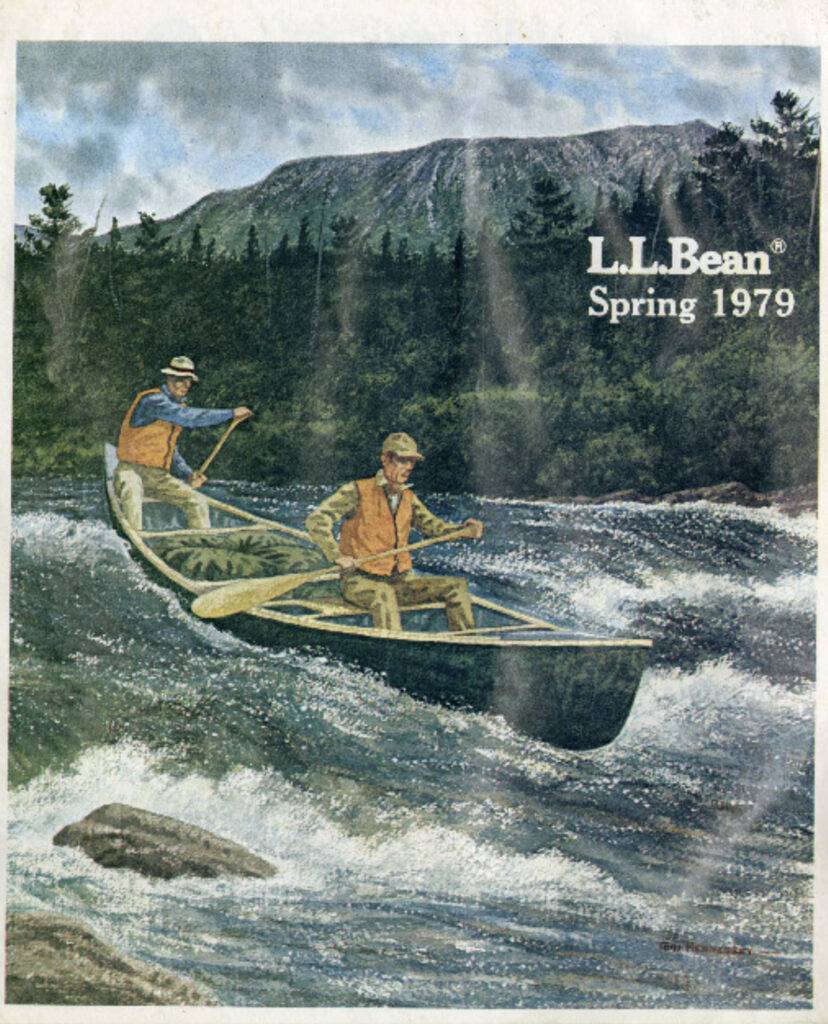
1979 SPRING L.L.BEAN
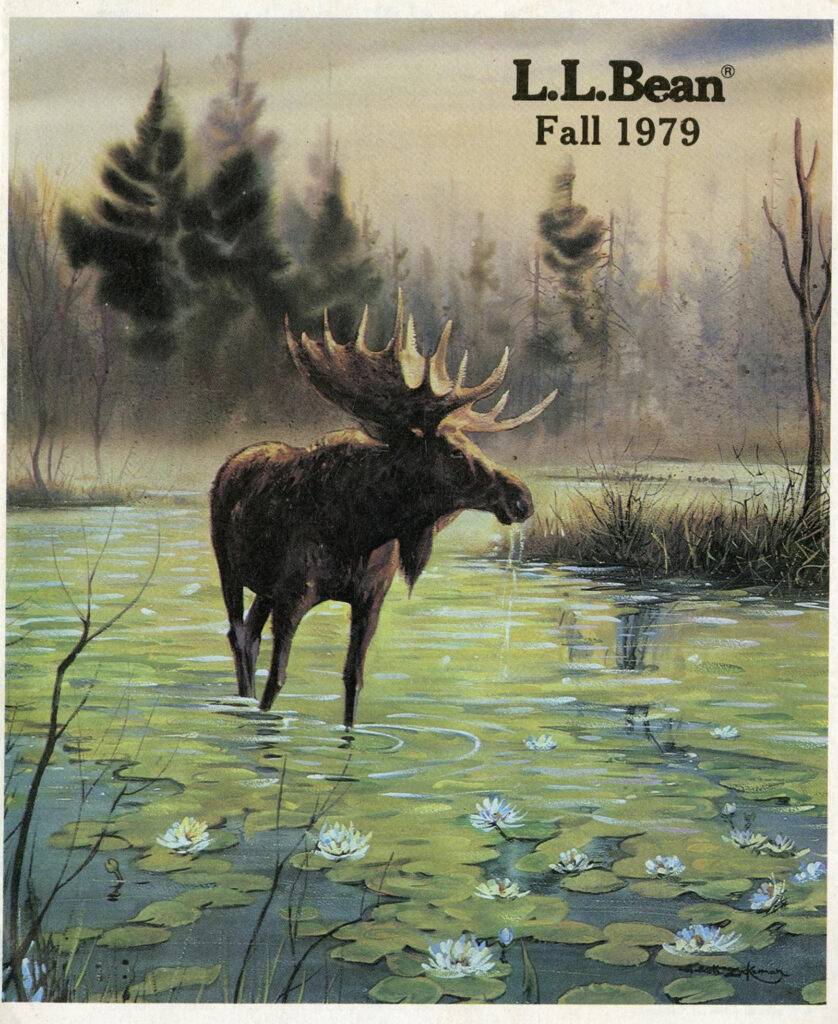
1979 FALL LL Bean
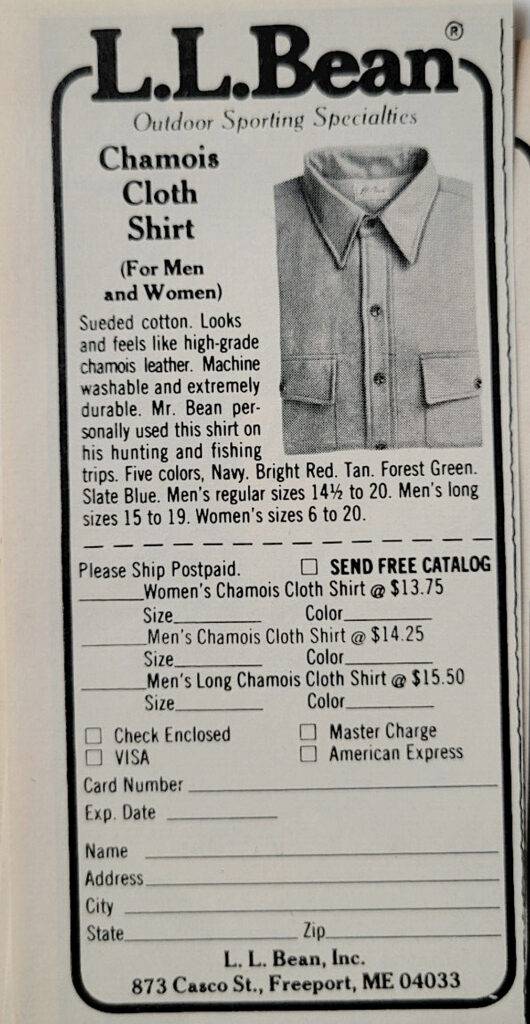

1979 New Yorker Ads ~2.5×5.5″
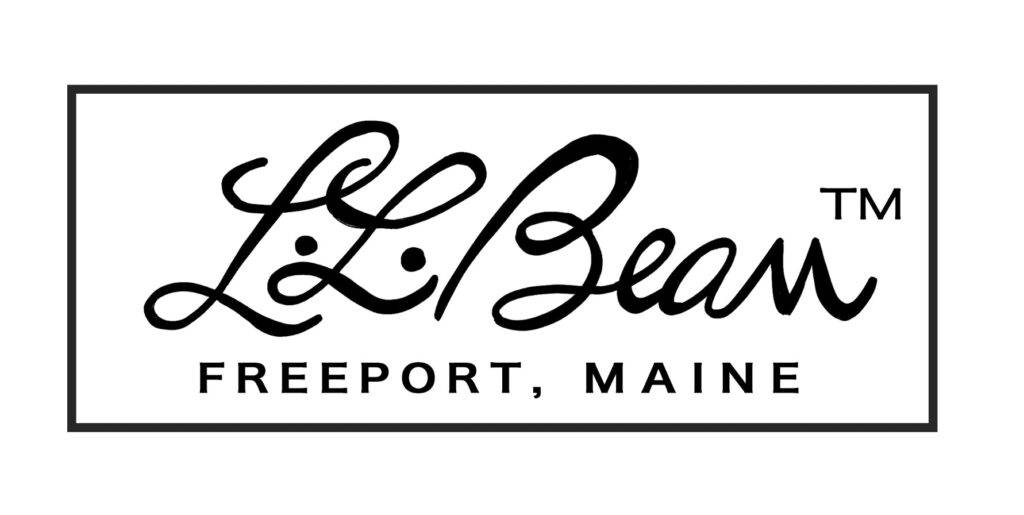
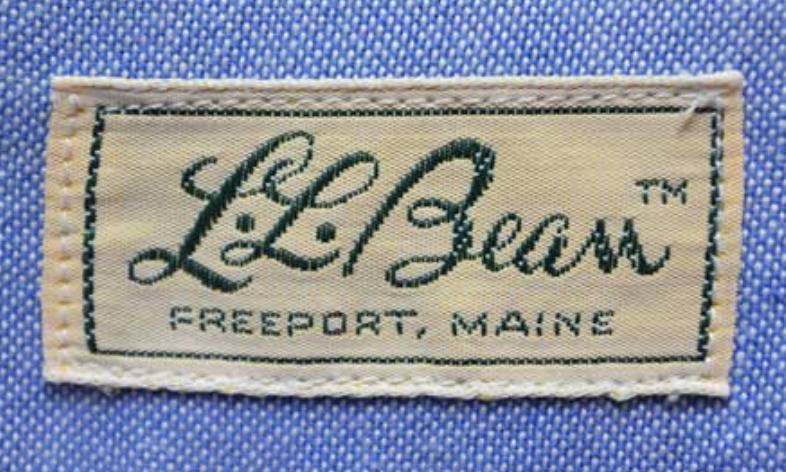
I suspect that the number of individuals is particularly small. I have never seen a combination of American-made write-type and trademark. It is assumed that the name tag was only used in the late 70s, as it was soon changed to the logo that is still used today.
このタイプのタグは個数が特に少ないのではないかと考えています。アメリカ製の文字と商標の組み合わせは見たことがありません。このネームタグは、すぐに今日でも使用されているロゴに変更されたため、1970年代後半にのみ使用されたと推定されています。
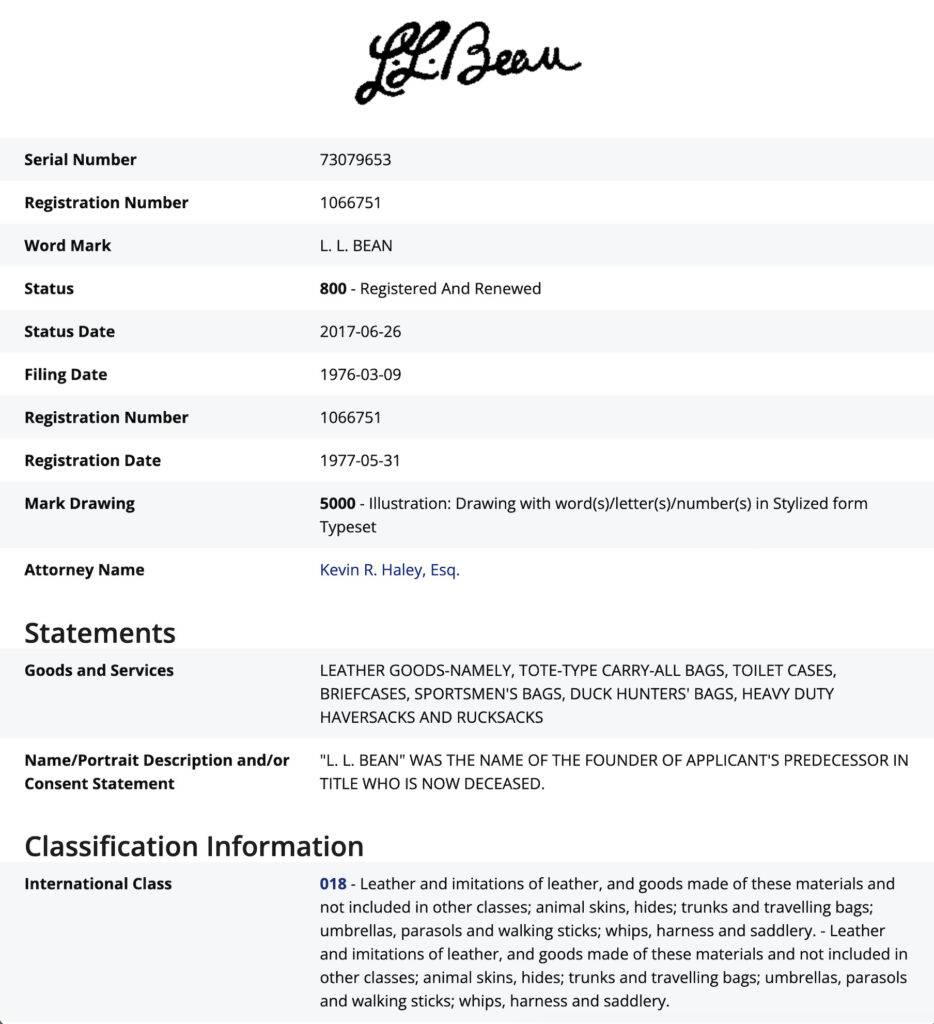
1977-1979?
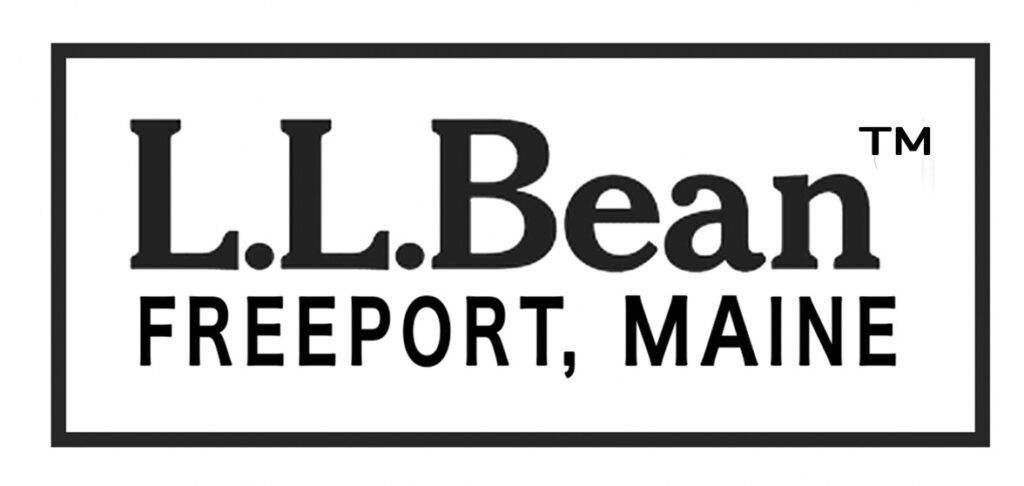

This tag is also rare. I don’t particularly intend to collect them as they are not for shirts, but I predict that in the 80s there will be fewer TM marks as they will be register marks. This one may be even less common than the written type one.
このタグも珍しいです。シャツ用ではないので、特に収集するつもりはありませんが、80年代には登録商標となるため、TMマークは少なくなると予想されます。このタグは、文字タイプのタグよりもさらに珍しいかもしれません。
1979
L.L.Bean launches its Outdoor Discovery Schools program. The program began with a winter clinic in Freeport, Maine, and has since expanded to include dozens of activities and locations across the United States.
1980s

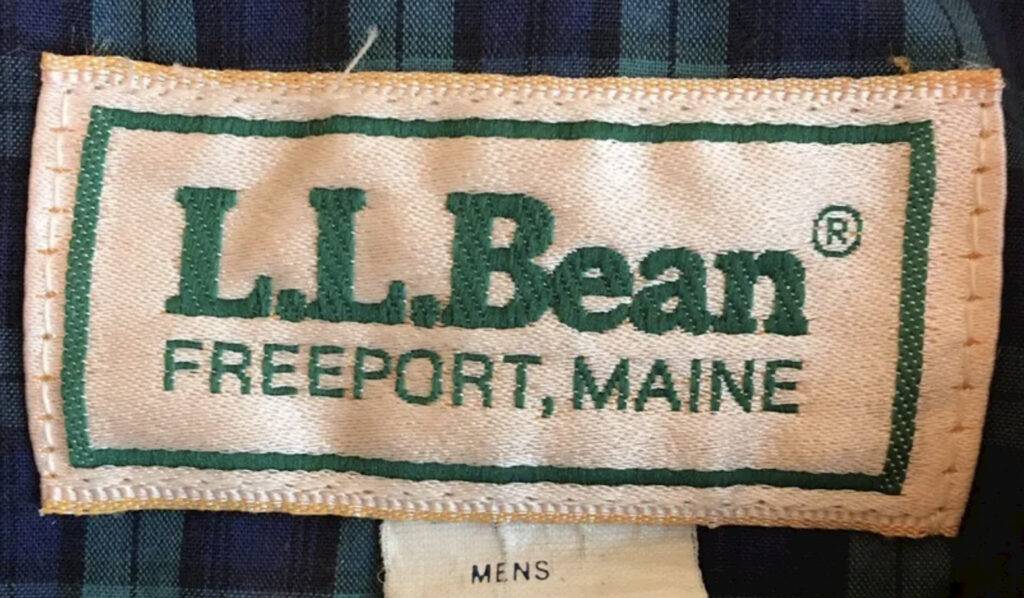
The logo had been used in the catalogue since the 1970s, but it was not until the 1980s that it was completely replaced by a product name tag. In addition, the number of products made in the USA gradually decreased, while the number of products made in Asia and South America also increased. Here, written type product tags temporarily disappeared.
このタイプのロゴは1970年代からカタログで使用されていましたが、製品名タグに完全に置き換えられたのは1980年代になってからです。さらに、米国製の製品は減少していった一方で、アジアと南米製の製品数は増加していきました。この後に筆記体の製品タグは一時的に消えてしまいました。
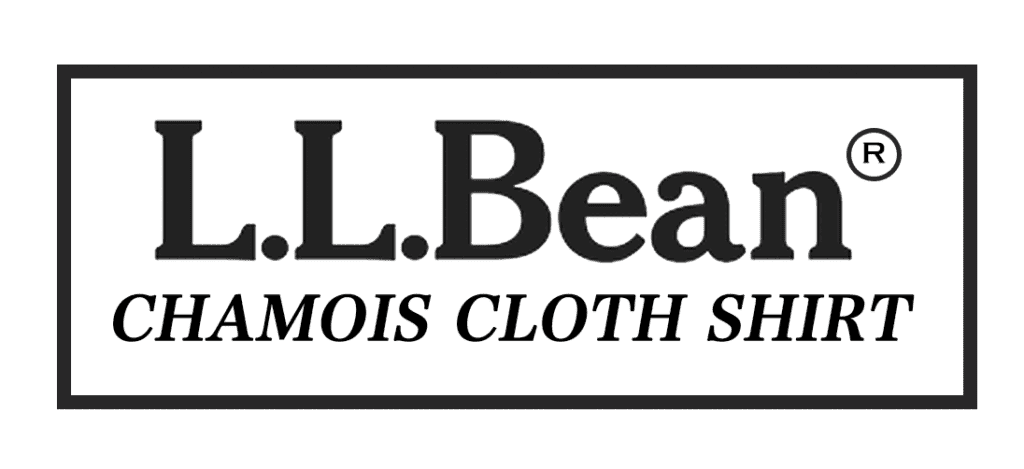
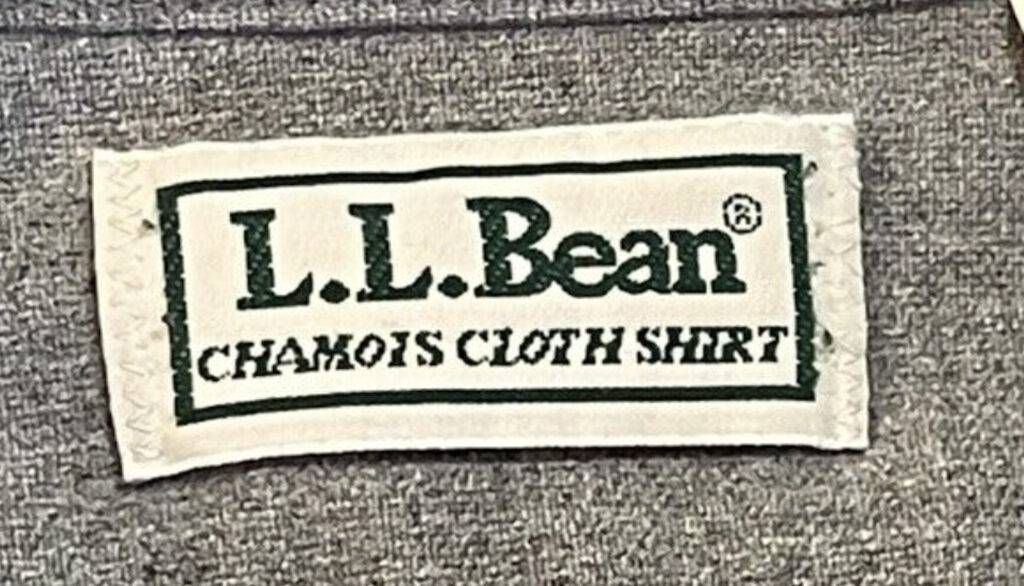
The chamois cloth is L.L.Bean’s traditional range of shirts, but it is from this period that it became a brand and entered the logo name. However, it is not in the red letter colour of later years, but in the same green colour. Many products from the same period still use fabrics made in the USA and often do not use cheap imports (fabrics from outside the country).
シャモアクロスはL.L.Beanの伝統的なシャツのシリーズですが、ブランドとなり、ロゴ名に採用されたのはこの時期からです。ただし、後年の赤い文字の色ではなく、同じ緑色です。同じ時期の多くの製品は、まだ米国製の生地を使用しており、しばしば安価な輸入品(国外製の生地)を使用していませんでした。

1980
Though L.L. Bean has enjoyed consistent success over the years, the brand has had some moments of unexpected trendiness. Once such moment came in 2011 when its trademark Duck Boots became so popular that there were shortages across the country. Some companies use these boom moments to branch into the designer world or collaborate with younger brands. L.L. Bean, however, opts to keep on keeping on. In fact, shortages of duck boots occur during periods of high demand because the company refuses to ramp up production in a way that would force production outside the United States. This is also because they’ve learned lessons over its history. The company enjoyed a similar boom in 1980, when The Official Preppy Handbook by Lisa Birnbach was published and the bestseller identified L.L. Bean as an essential component of yuppie style.
1981
Several trends contributed to Bean’s substantial growth in the 1980s. Among them was the accidental, or perhaps inevitable, affiliation of the Bean label with prep culture and clothing. According to Milton Moskowitz, Lisa Birnbach’s Official Preppy Handbook, tongue-in-cheek or not in its declaration of the Bean store as “nothing less than prep mecca,” helped fuel a 42 percent rise in 1981 sales. A new health and fitness boom contributed to Bean’s growth, as well as a surge in mail-order shopping. First-time Bean customers, nearly 70 percent of which were women, increased rapidly during the 1980s.
1982
In the ’80s,, L.L. Bean would stumble unexpectedly into the emerging student backpack market. Throughout the decade children and teenagers started wearing bookbags to school in larger numbers. In 1982, Bean started producing a simple “book pack” in three colors with the all-important initials on them. In 1992 alone, the brand sold 12 million of them. These bookbags were must-have items at middle schools and high schools across the country, introducing a new generation to the historic company. Looking at the growth through the 20th century, you start to wonder if the iconic products build the brand or the strength of the brand allowed L.L. Bean to create iconic products.
1984
By the beginning of the 1980s, L.L. Bean sales were $140 million and mushroomed to $250 million by 1984.
1980s-90s
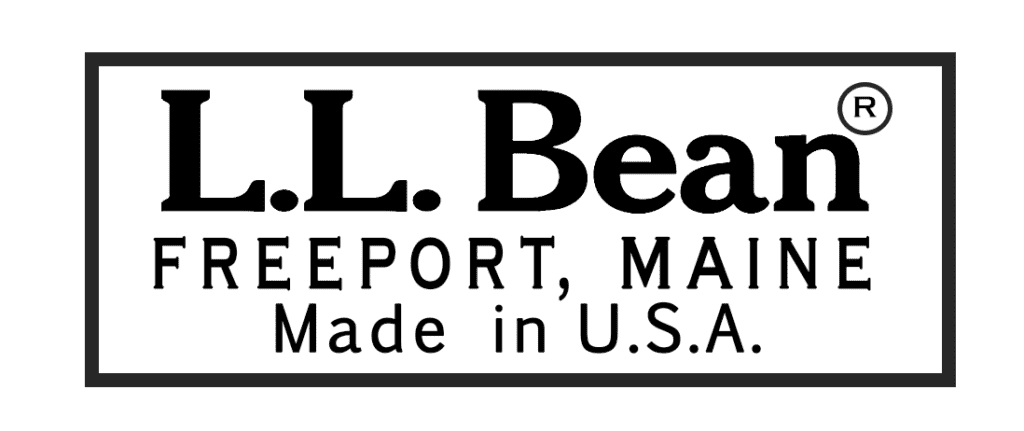

In the early 1980s, the US trade deficit related to clothing grew rapidly. The garment trade deficit rose 53% from 1983 to 1984 and 25% from 1984 to 1985, reaching USD 17 billion (USD 1.36 trillion at 80 yen to the dollar) in 1985. As a result, a coalition of 245 industry and trade unions in the USA formed Crafted with Pride in 1984 to campaign to encourage consumers to buy clothing made in the USA. in the U.S.A. Council was founded in 1984 by a coalition of 245 industry and trade unions in the United States. However, the tide of history could not be reversed and by the 1990s and early 2000s, most US-branded clothing production had moved overseas.
1980年代初頭、米国のアパレル関連の貿易赤字は急速に拡大しました。衣料品の貿易赤字は、1983年から1984年にかけて53%、1984年から1985年にかけて25%上昇し、1985年には170億ドル(1ドル80円で換算すると1.36兆ドル)に達しました。この結果、米国のアパレル業界と労働組合245団体が1984年に「Crafted with Pride in the USA」を結成し、消費者に米国製の衣料品を購入するよう呼びかけるキャンペーンを展開しました。しかし、歴史の流れは覆すことができず、1990年代から2000年代初頭にかけて、米国ブランドの衣料品生産の大半は海外に移転しました。
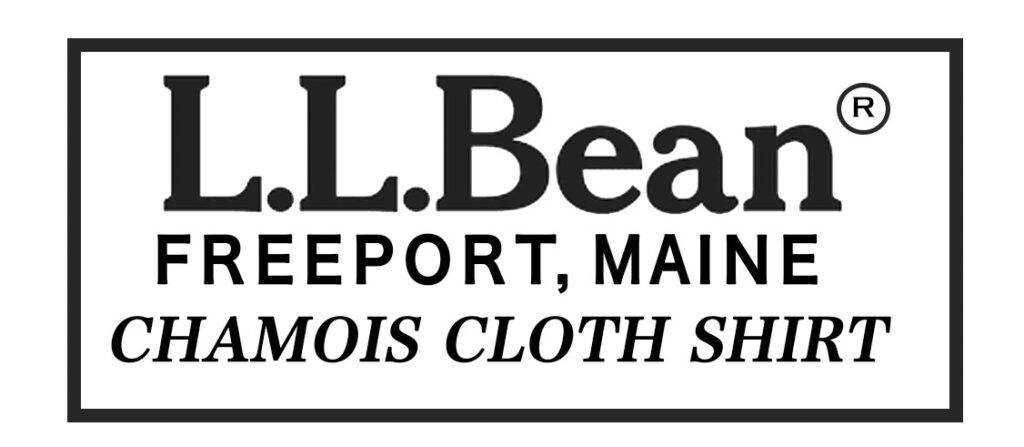
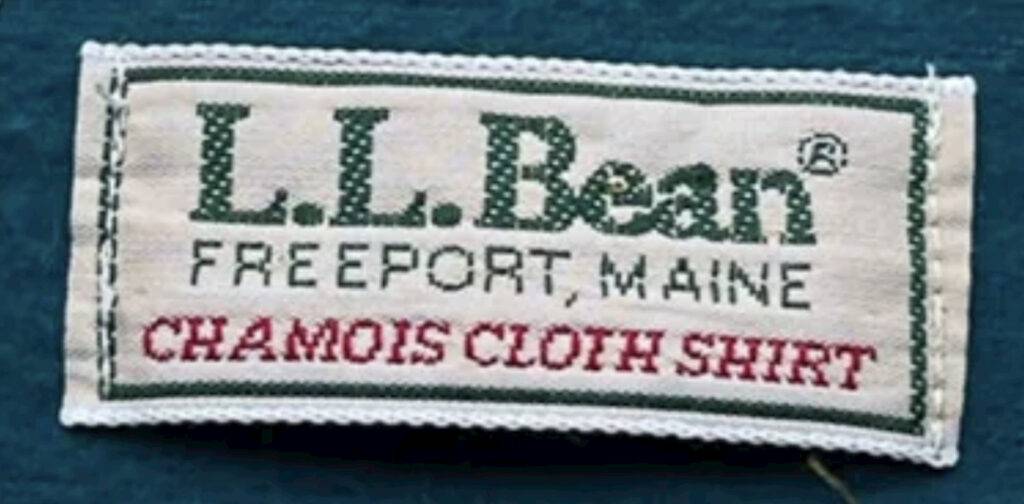
As US apparel brands move their factories overseas, L.L.BEAN also moves its factories overseas. L.L.BEAN begins to differentiate itself by focusing on the most important items of the brand (e.g. bean boots and Maine hunting jackets); the name ‘chamois cloth’ also begins to be used by other companies and is emphasised in red letters. This name tag is used until the 1990s, but is now even used for items produced in Asia, It is important to be careful when buying second-hand clothing, as this name tag is now used even for items produced in Asia.
アメリカのアパレルブランドが工場を海外に移転するにつれて、L.L.Beanも工場を海外に移転しました。L.L.Beanは、ブランドの最重要アイテム(例:Bean Boots、Maine Hunting Jackets)に焦点を当てることで差別化を図り始めます。また、「chamois cloth」という名前も他社で使用されるようになり、赤い文字で強調されるようになりました。このネームタグは1990年代まで使用されていましたが、現在ではアジアで生産されたアイテムにも使用されているため、中古の衣料品を購入する際は注意が必要です。
1987
When the firm celebrated its seventy-fifth anniversary in 1987, not only was the L.L. Bean catalog still the mainstay of the company, with over seventy-five million copies mailed to customers annually, but the Main Street store had become a true tourist destination attracting some two million visitors every year to see the six thousand products displayed from wall to wall. Sales for 1987 surpassed $360 million, with nearly two thousand workers taking orders and selling merchandise.
Advertising growth continued apace as well. It wasn’t until 1987 that the iconic “Sunrise Over Katahdin” logo was launched. Similar to Patagonia’s Fitz Roy logo, the rectangular landscape drawing of a Maine State Park has become synonymous with the L.L. Bean brand. The ’80s also represented the prime of the catalog business, as dozens of companies attempted to mimic L.L. Bean’s longstanding mail-order marketing catalogue approach. In 1985, L.L. Bean was publishing 20 different catalogs a year, including four large seasonal books running over 120 pages. At the height of its magazine business, the company was mailing 200 million catalogues a year. During this period L.L. Bean posted unheard of 20 percent growth per year for three decades. Remarkably, 60 percent of the sales were still coming from the catalogue in the year 2000.
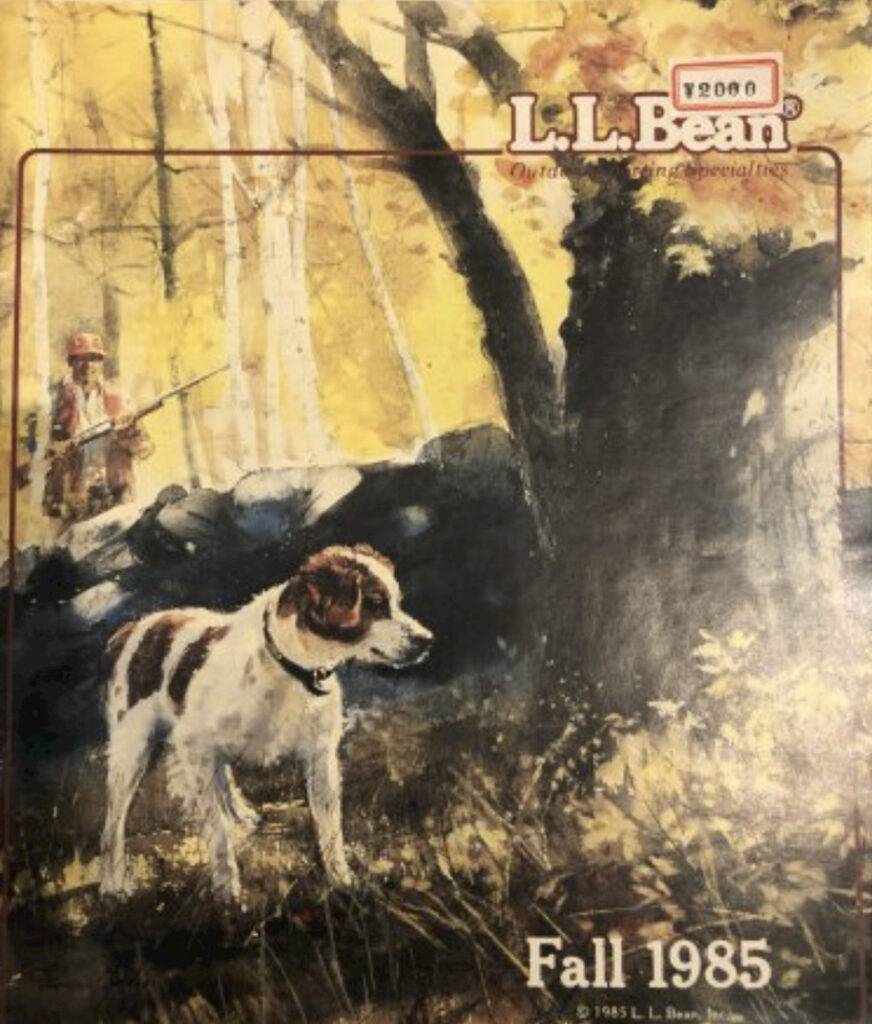
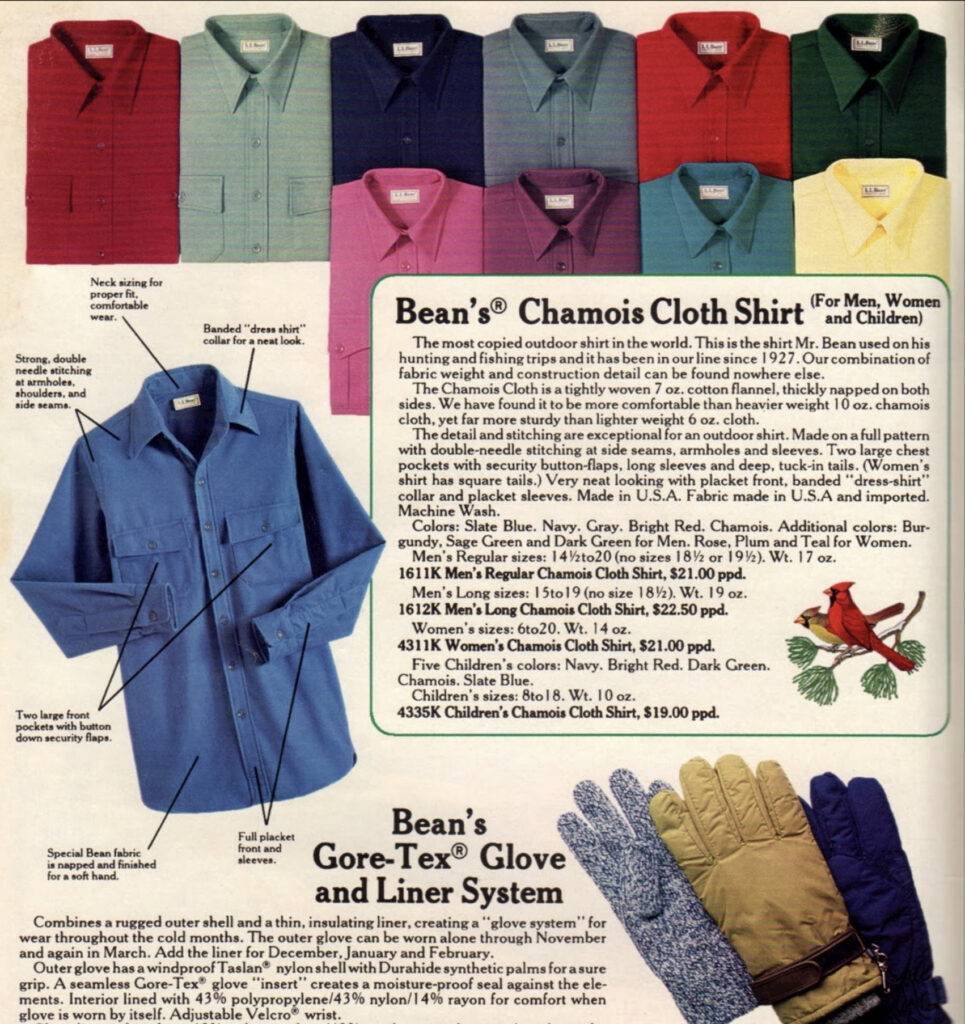
1985 Christmas L.L.BEAN
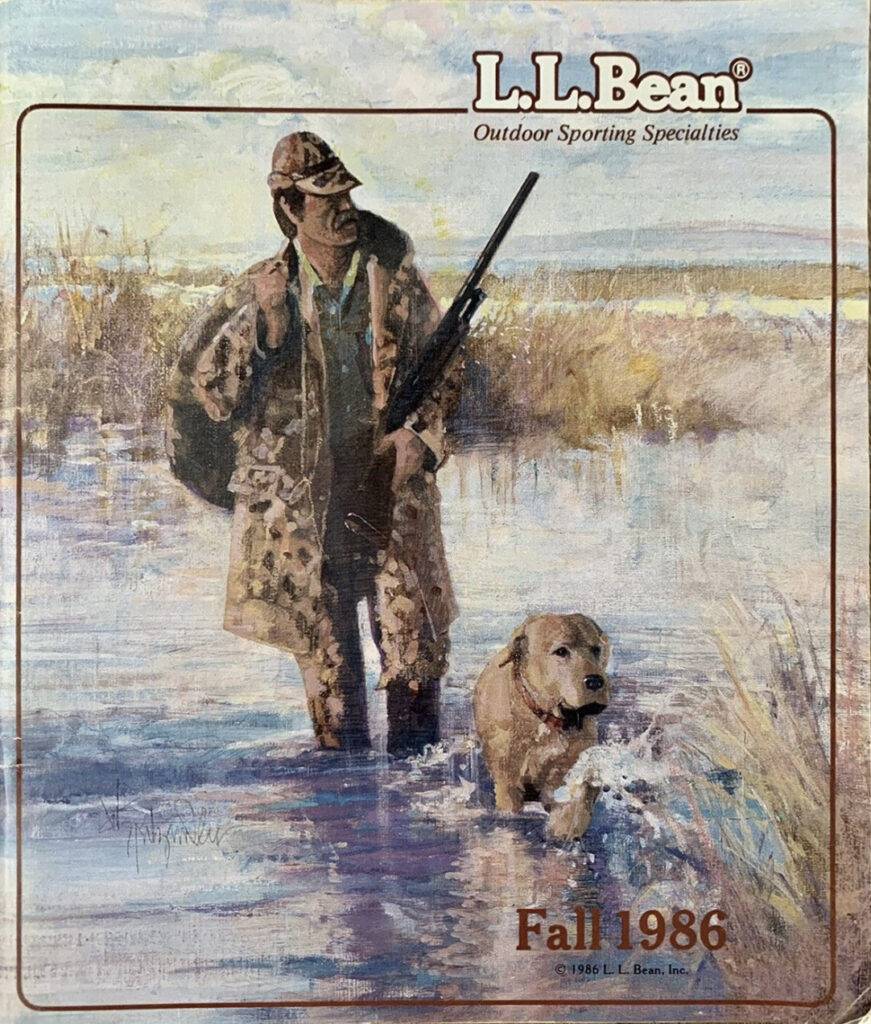

1986 SPRING L.L.BEAN
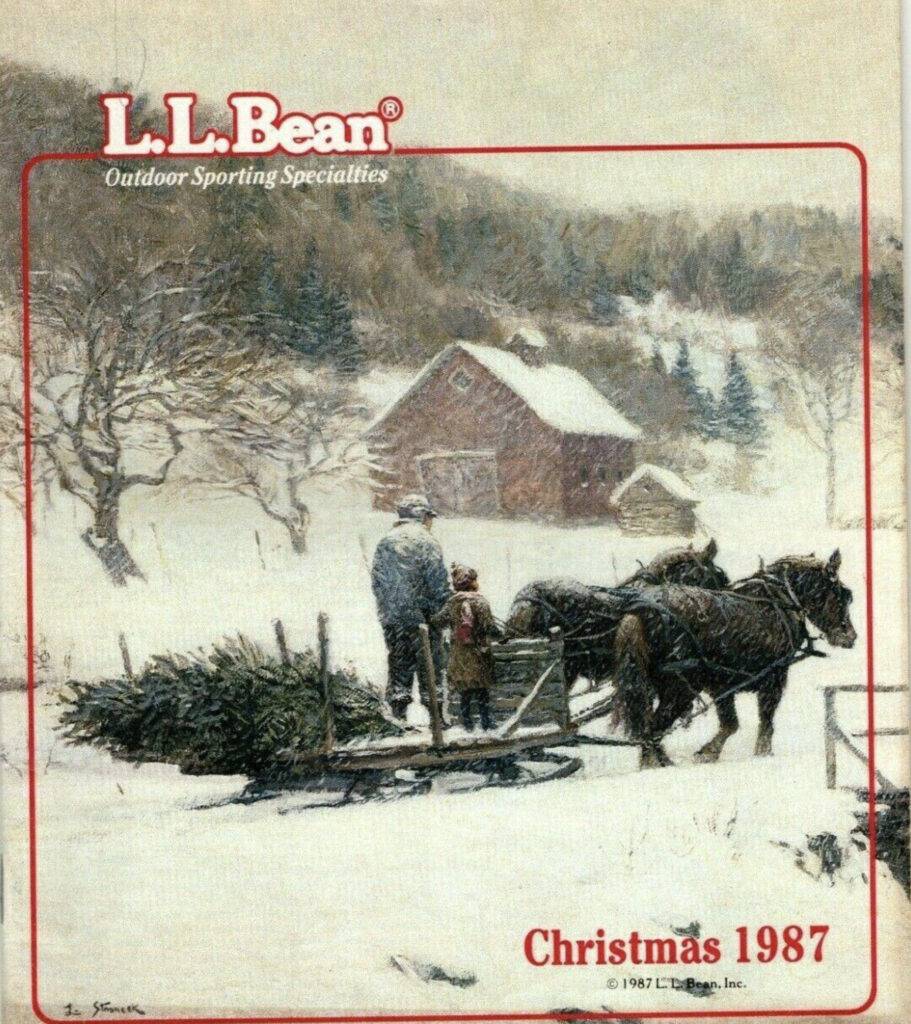

1987 FALL L.L.BEAN
1990s-

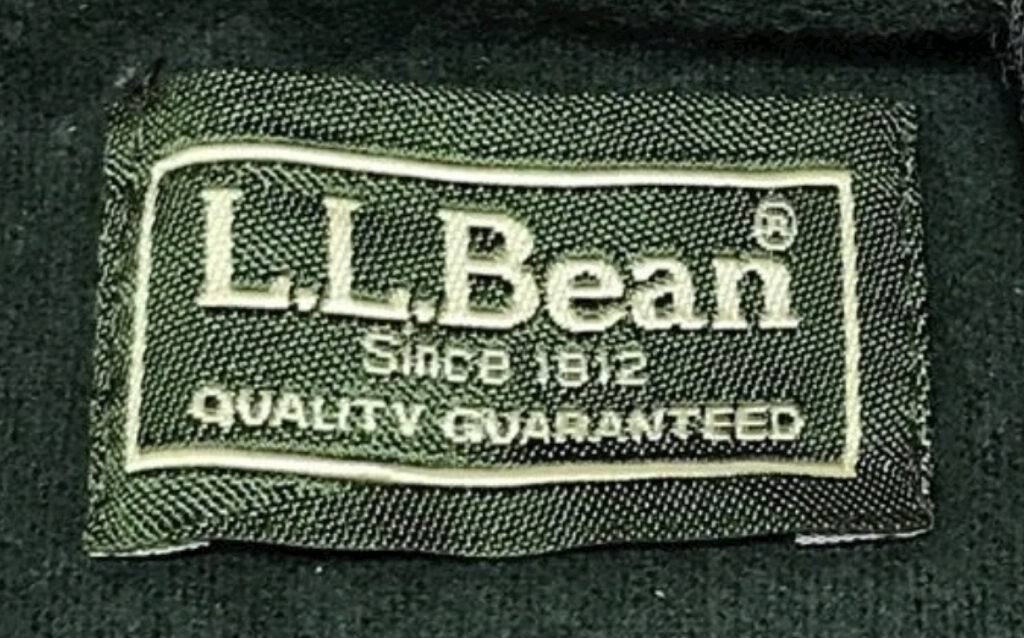
It is one of the rarest tags in existence, especially on shirts. Most of them are made in the USA (fabrics are made overseas) and Canada (there are probably some made in Asia). It may have been the last outsourced factory for shirts that were particular about many special designs. After this, it becomes a simple logo, but the quality of the fabric etc. drops, so it may be said that it is the last time you can buy a proper one made in the USA (I don’t buy many after this tag except for unusual patterns).
これは、現存する最も希少なタグの一つであり、特にシャツには珍しい。ほとんどはアメリカ製(生地は海外製)とカナダ製(おそらく一部はアジア製)である。多くの特殊なデザインにこだわったシャツの最後の外注工場だったかもしれない。その後、シンプルなロゴになるが、生地などの品質が低下するため、アメリカ製の本格的な製品が買える最後の機会と言えるかもしれない(このタグ以降、変わった柄以外はあまり買わない)。
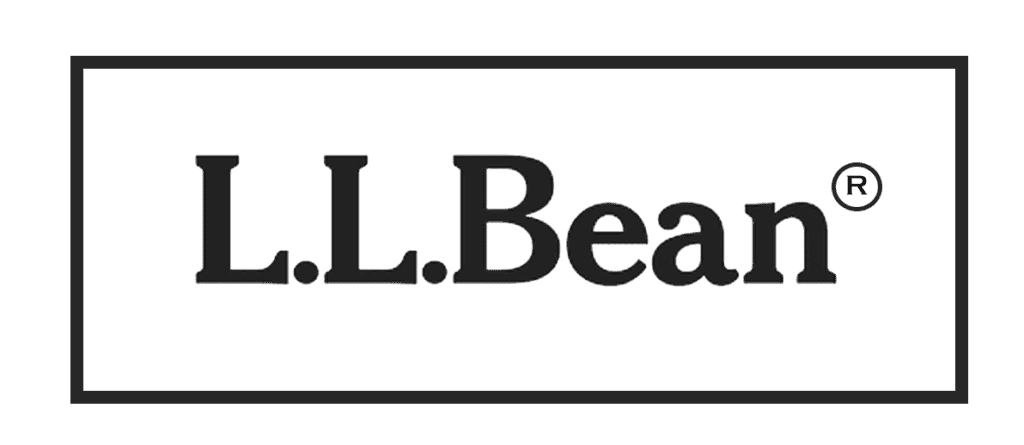

This simple tag will be the last American-made tag. However, it is also used for other products besides US-made products, some of which are rare, such as Canadian-made products, but the quality is declining as the focus shifts to mainly Asian production, such as Honduran, Hong Kong and Sri Lankan-made products. (Shirts were still of good quality until the end.)
このシンプルなタグは、最後のアメリカ製タグになります。ただし、アメリカ製以外の製品にも使用されています。その中にはカナダ製のような珍しいものもありますが、ホンジュラス、香港、スリランカ製などのアジア製に重点が移行するにつれて、品質が低下しています。ただし、シャツは最後まで高品質でした。
1991
L.L. Bean claims much of its success was a result of its reputation, effective marketing, and enlarged circulation. L.L. Bean’s sales dropped in 1989 however, forcing the company to lay off employees in 1991 and 1992. After that setback, the company began prospering rapidly and continued to expand. Increases in the postal rate in 1991 caused the company to charge a shipping and handling fee to its customers for the first time. Also in an effort to offset rising shipment costs, L.L. Bean set its sights on the Internet, creating its own web site as a means of mail-order service. The mail order business, the company’s core business, accounted for 87.7 percent of the sales in 1995.
1992
Berman, who continued by questioning Gorman’s management decisions, may have been premature in her analysis; by the end of 1992, the company’s 80th anniversary, sales had risen by 18 percent to $743 million. The same year, L. L. Bean opened its first store in Japan, a ripe market that also contributed high year-end catalog revenues. A second Japanese store was added in July 1993; both are jointly owned by Seiyu and the Matsushita Electric Industrial Co. More L. L. Bean Japan stores were scheduled to open in the mid-1990s. First international store opens in Tokyo, Japan 1992. However, as the 1990s approached, the country experienced a serious recession; sales slowed, returns rose, and a 30 percent postal increase loomed on the horizon. For a time, Bean suffered along with the other major catalog marketers and was forced to lay off ten percent of its hourly and salaried workforce over a two-year period. In a 1992 Forbes article, Phyllis Berman placed the problem in a more serious context: “What went wrong? To some extent L. L. Bean is the victim of success. A whole generation is already outfitted with L. L. Bean leisurewear and camping equipment. Its durable, high quality clothing lines have spawned many imitators. Meanwhile, similar items turn up in discount stores…. Bean carried relatively few styles and introduced new products slowly. But today’s trend-conscious and jaded consumers want variety and novelty.”
1993
Berman, who continued by questioning Gorman’s management decisions, may have been premature in her analysis; by the end of 1992, the company’s 80th anniversary, sales had risen by 18 percent to $743 million. The same year, L. L. Bean opened its first store in Japan, a ripe market that also contributed high year-end catalog revenues. A second Japanese store was added in July 1993; both are jointly owned by Seiyu and the Matsushita Electric Industrial Co. More L. L. Bean Japan stores were scheduled to open in the mid-1990s. L. L. Bean, Inc., is a leading U.S. catalog company and the largest supplier of outdoor gear in the world. The L. L. Bean catalogs, a tradition since the company’s founding, are the engine that drives company sales; in 1993 the company took in $745 million from catalog sales alone. The 1993 catalogs, 30 in all, offered approximately 6,700 different items, most tied to the pursuit of outdoor, active lifestyles. For the solitary fisherman or the fun-seeking yuppie, the name L. L. Bean stands for quality, value, and enduring style—so much so that each year more than 3.5 million visitors make pilgrimages to the company’s original retail store, in Freeport, Maine, to soak up the Bean ambiance and the Bean bargains. Retail sales for 1993 (including those for five factory outlet stores and two independently owned retail stores in Japan) reached $125 million. L. L. Bean also enjoys a high reputation, among its corporate peers as well as its customers, for order fulfillment.
1995
Sales continued to grow smartly through the 1995 fiscal year, reaching $976 million, although that figure was three percent below the company’s target. In fact, for the remainder of the decade, revenues were essentially flat, increasing only to $1.08 billion in 1996 (the first time the billion dollar mark had been breached) and standing at $1.07 billion by 1999. Once again, L.L. Bean faced criticism for not changing with the times, both fashion-wise and otherwise. Particular for women, the company’s clothes were seen as ‘too’ traditional and not fashionable enough. The company’s venerable catalogs were being lost amid the myriad catalogs now being mailed out to every American. In addition, the number of retailers offering casual outdoor clothing was on the rise, including such names as American Eagle Outfitters, the Gap, and REI. On top of all that, international sales were hurt by the sluggish Japanese economy and by the late 1990s Asian financial crisis.
1996
L.L. Bean, Inc. is a leading U.S. catalog company and the largest catalog supplier of outdoor gear in the world. The L.L. Bean catalogs, a tradition since the company’s founding, are the engine that drives company sales; in 1999 the company took in $854 million from catalog sales alone. The 1999 catalogs, 70 in all, offered approximately 16,000 different items, most tied to the pursuit of outdoor, active lifestyles. For the solitary fisherman or the busy baby-boomer, the name L.L. Bean stands for quality, value, and enduring style–so much so that each year more than three million visitors make pilgrimages to the company’s original retail store, in Freeport, Maine, to soak up the Bean ambiance and the Bean bargains. Retail sales for 1999 (including those for the L.L. Kids Store, adjacent to the flagship store; a second L.L. Bean Store in McLean, Virginia; ten factory outlet stores; and more than 20 independently owned retail stores in Japan) reached $206 million. The llbean.com e-commerce web site has been operational since 1996. L.L. Bean also enjoys a high reputation, among its corporate peers as well as its customers, for order fulfillment.
1996: Annual sales exceed $1 billion for the first time.
Sales grew by 10 percent—nearly $1 billion in 1995. In spite of these profits, the company offered buyouts and early retirements to eligible employees in 1996. The company claimed sales were $90 million below target range and it had to cut costs for the next three years in order to remain competitive. Considering the fact that from July 1994 to July 1995, 50 percent of American companies did some sort of downsizing, L.L. Bean’s cost-cutting efforts seemed ordinary.
The company also prides itself since, in 1996, it made the Trendsetter List released by the Labor Department in Washington. This list is comprised of retailers and manufacturers who make extra efforts to guarantee their products are not made in sweatshop conditions, including child labor, abusive conditions, and other compromising circumstances. In addition, it tries to support domestic manufacturing, particularly in Maine.
1997
L.L. Bean responded aggressively to its latest challenge with a number of late 1990s and early 2000s initiatives. The company joined the e-commerce bandwagon in 1996 with the launching of online ordering via the llbean.com web site. That same year, a new state-of-the-art order fulfillment center was opened in Freeport, boasting 650,000 square feet of space and the capacity to process 27 million items per year. With the new line of children’s clothing proving to be a great success, L.L. Bean opened an L.L. Kids store adjacent to the flagship retail store in Freeport, in 1997. This 17,000-square-foot store featured a number of special attractions, including a two-story waterfall, a trout pond, a hiking trail, and an electronic rock climbing wall. On the women’s clothing front, L.L. Bean launched a new brand and a new catalog called Freeport Studio in 1999. The company’s first affiliated brand, Freeport Studio featured more contemporary and fashion-forward casual clothes for baby-boomer women. Finally, in 2000 L.L. Bean began what a number of industry analysts considered a long overdue expansion of its full-price retail stores. In July of that year, a 76,000-square-foot L.L. Bean store opened in McLean, Virginia, in a fancy suburban Washington mall.
1999
L.L. Bean, Inc. is a leading U.S. catalog company and the largest catalog supplier of outdoor gear in the world. The L.L. Bean catalogs, a tradition since the company’s founding, are the engine that drives company sales; in 1999 the company took in $854 million from catalog sales alone. The 1999 catalogs, 70 in all, offered approximately 16,000 different items, most tied to the pursuit of outdoor, active lifestyles. For the solitary fisherman or the busy baby-boomer, the name L.L. Bean stands for quality, value, and enduring style–so much so that each year more than three million visitors make pilgrimages to the company’s original retail store, in Freeport, Maine, to soak up the Bean ambiance and the Bean bargains. Retail sales for 1999 (including those for the L.L. Kids Store, adjacent to the flagship store; a second L.L. Bean Store in McLean, Virginia; ten factory outlet stores; and more than 20 independently owned retail stores in Japan) reached $206 million. The llbean.com e-commerce web site has been operational since 1996. L.L. Bean also enjoys a high reputation, among its corporate peers as well as its customers, for order fulfillment.
2000
Meanwhile, Bean added new products and product categories that tied in with its brand image. In 2000 it introduced skin care products to its women’s catalogue, focusing on items that protect the skin in the midst of an outdoor lifestyle. One of Bean’s more unusual product extensions is a sport utility vehicle, the Subaru Outback Limited Special L.L. Bean Edition, also introduced in 2000. Bean also began expanding its distribution. In 2000, Bean opened its second full-line store (after its Freeport flagship). The launch marked the first step in a conservative retail strategy encompassing three to five new stores in the Northeast U.S. over three or four years. L.L. Bean also operates 10 outlet stores in the U.S. and 20 retail shops in Japan. Its stores feature both soft and hard goods, including the L.L. Bean Home collection. The company was an early entrant into e-commerce and has seen success with its Internet program, being rated among the top sites for sales and customer satisfaction.
the summary
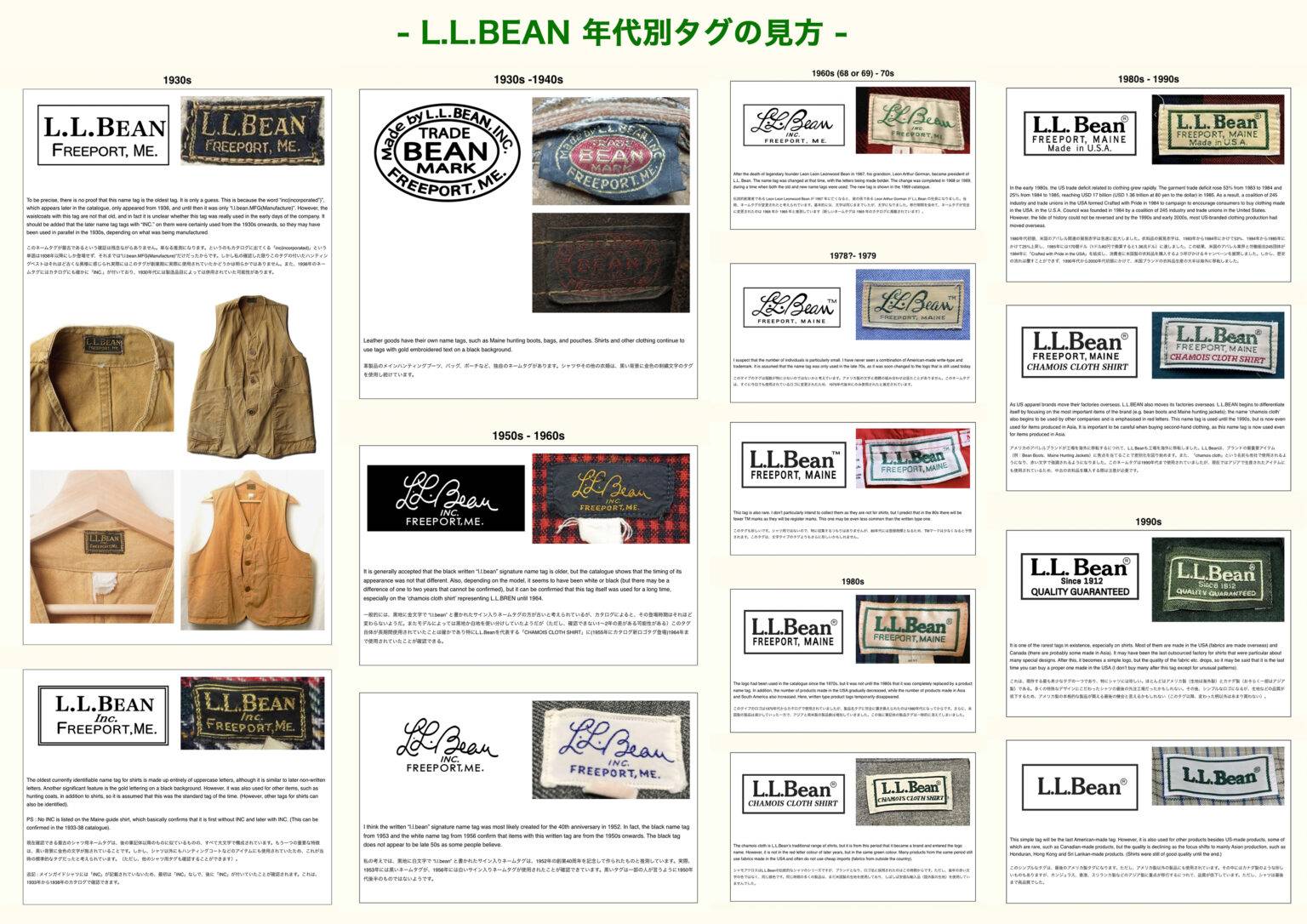
– recommendation –

THE LOST PENDLETON WOOLEN MILLS / VINTAGE TAGS
JULY – 2023 20 MINS READ
You will no longer be able to get your hands on a Pendleton shirt. Some would argue that this is not true. To be precise, Pendleton shirts and trousers will still be in the shops every winter. T-shirts with the logo may even be on sale. However, they are licensed products produced in Asia. Whether that is genuine or fake depends on the person. But I feel that only shirts made in the USA on American-made Pendleton fabric and sewn in the USA have any meaning.
もうあなたはペンドルトンを手にいれることはできません。と言うとそんなことはないと反論する人はいるでしょう。正確にはこれからもペンドルトンはお店には毎年のように並ぶでしょう。あなたはその商品を買うこともできます。ただしそれはアジア生産のライセンス生産品です。それを本物とするか偽物とするかは人によると思います。ただ私個人はアメリカ製で織られて縫われたペンドルトンにしか意味はないと感じています。今回はペンドルトンの歴史と彼らが残したモノを研究しましょう。

